Mitigating Strategies within Operations Transformation: A Case Study of Royal Mail UK
VerifiedAdded on 2023/06/15
|74
|18737
|464
AI Summary
This research highlights the critical research on the risk mitigating strategies within operations transformation in case of Royal Mail UK. It is evident that in order to maintain the need of the market and obtain customer demands, a business needs to improvise their business function. This research thus, aims to highlight the mitigation strategy that the organization, Royal Mail has taken when their approach to transforming the business operation failed.
Contribute Materials
Your contribution can guide someone’s learning journey. Share your
documents today.
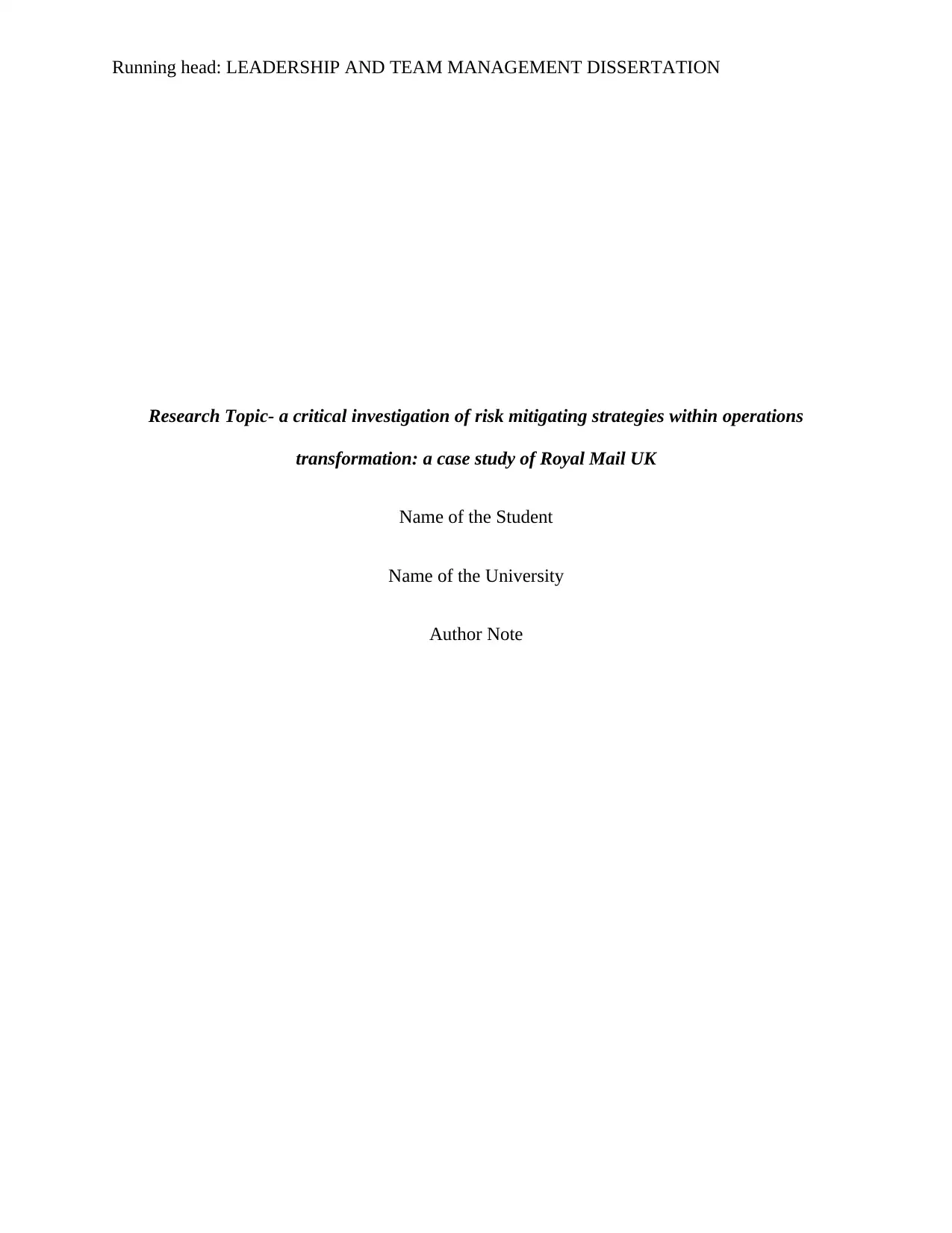
Running head: LEADERSHIP AND TEAM MANAGEMENT DISSERTATION
Research Topic- a critical investigation of risk mitigating strategies within operations
transformation: a case study of Royal Mail UK
Name of the Student
Name of the University
Author Note
Research Topic- a critical investigation of risk mitigating strategies within operations
transformation: a case study of Royal Mail UK
Name of the Student
Name of the University
Author Note
Secure Best Marks with AI Grader
Need help grading? Try our AI Grader for instant feedback on your assignments.
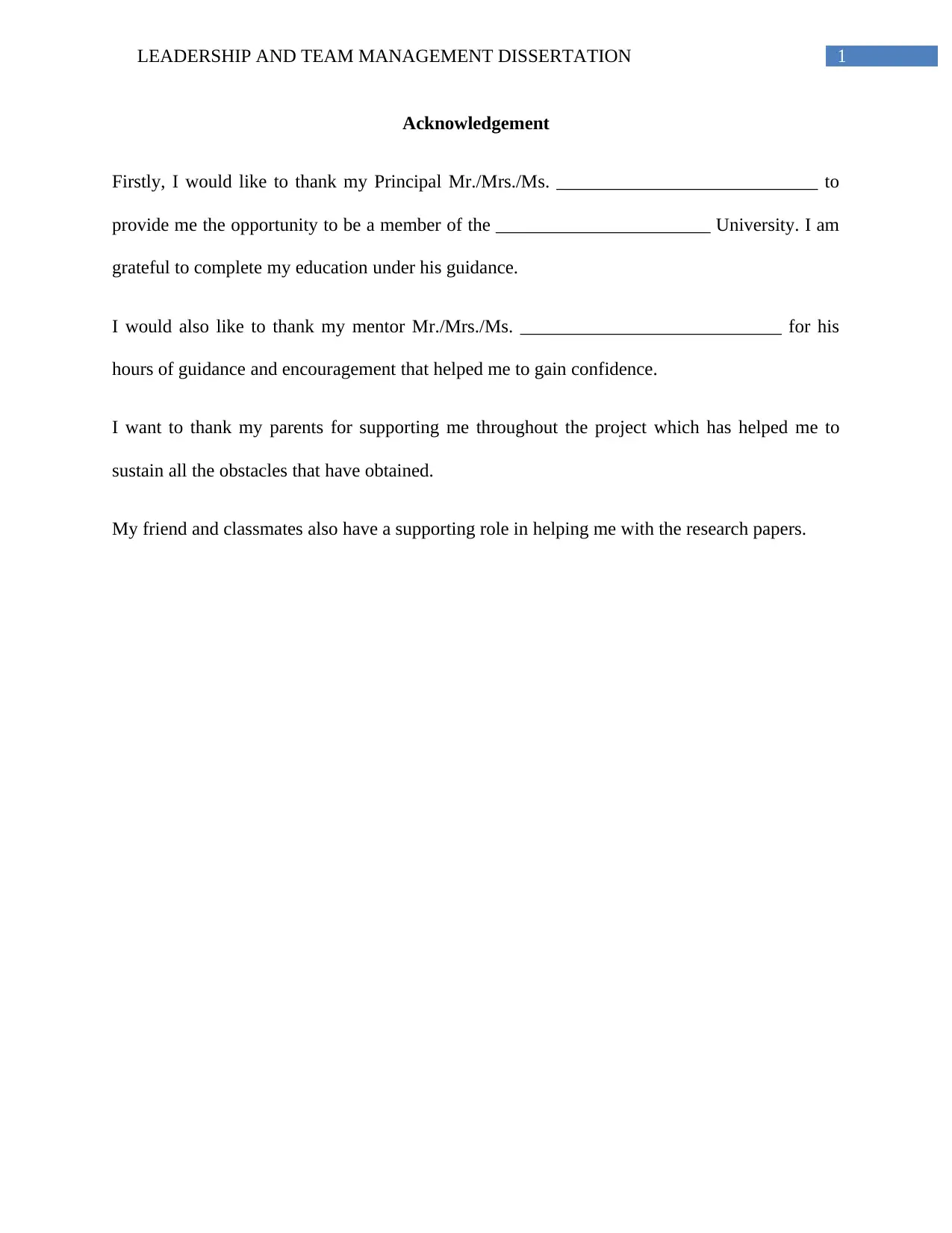
1LEADERSHIP AND TEAM MANAGEMENT DISSERTATION
Acknowledgement
Firstly, I would like to thank my Principal Mr./Mrs./Ms. ____________________________ to
provide me the opportunity to be a member of the _______________________ University. I am
grateful to complete my education under his guidance.
I would also like to thank my mentor Mr./Mrs./Ms. ____________________________ for his
hours of guidance and encouragement that helped me to gain confidence.
I want to thank my parents for supporting me throughout the project which has helped me to
sustain all the obstacles that have obtained.
My friend and classmates also have a supporting role in helping me with the research papers.
Acknowledgement
Firstly, I would like to thank my Principal Mr./Mrs./Ms. ____________________________ to
provide me the opportunity to be a member of the _______________________ University. I am
grateful to complete my education under his guidance.
I would also like to thank my mentor Mr./Mrs./Ms. ____________________________ for his
hours of guidance and encouragement that helped me to gain confidence.
I want to thank my parents for supporting me throughout the project which has helped me to
sustain all the obstacles that have obtained.
My friend and classmates also have a supporting role in helping me with the research papers.
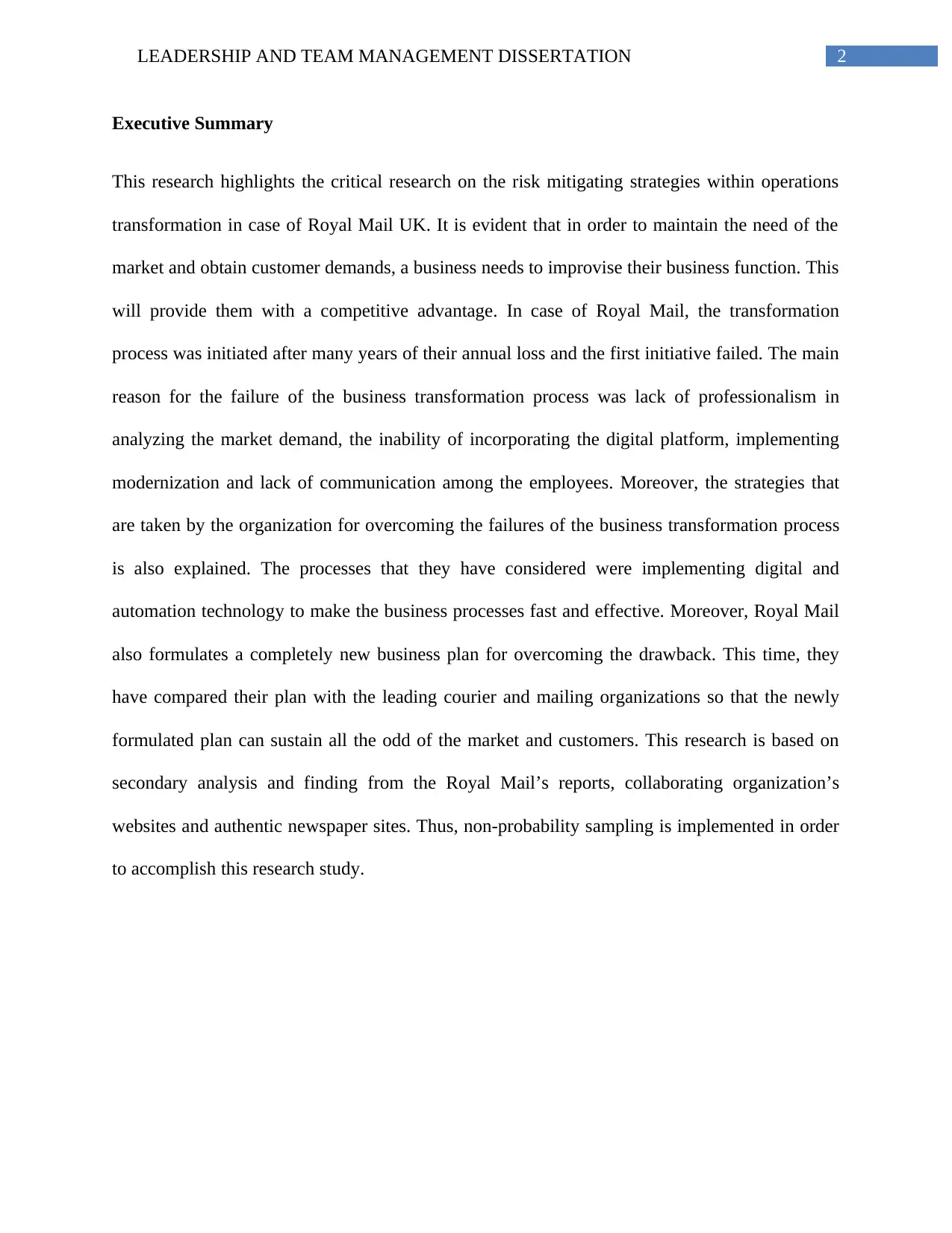
2LEADERSHIP AND TEAM MANAGEMENT DISSERTATION
Executive Summary
This research highlights the critical research on the risk mitigating strategies within operations
transformation in case of Royal Mail UK. It is evident that in order to maintain the need of the
market and obtain customer demands, a business needs to improvise their business function. This
will provide them with a competitive advantage. In case of Royal Mail, the transformation
process was initiated after many years of their annual loss and the first initiative failed. The main
reason for the failure of the business transformation process was lack of professionalism in
analyzing the market demand, the inability of incorporating the digital platform, implementing
modernization and lack of communication among the employees. Moreover, the strategies that
are taken by the organization for overcoming the failures of the business transformation process
is also explained. The processes that they have considered were implementing digital and
automation technology to make the business processes fast and effective. Moreover, Royal Mail
also formulates a completely new business plan for overcoming the drawback. This time, they
have compared their plan with the leading courier and mailing organizations so that the newly
formulated plan can sustain all the odd of the market and customers. This research is based on
secondary analysis and finding from the Royal Mail’s reports, collaborating organization’s
websites and authentic newspaper sites. Thus, non-probability sampling is implemented in order
to accomplish this research study.
Executive Summary
This research highlights the critical research on the risk mitigating strategies within operations
transformation in case of Royal Mail UK. It is evident that in order to maintain the need of the
market and obtain customer demands, a business needs to improvise their business function. This
will provide them with a competitive advantage. In case of Royal Mail, the transformation
process was initiated after many years of their annual loss and the first initiative failed. The main
reason for the failure of the business transformation process was lack of professionalism in
analyzing the market demand, the inability of incorporating the digital platform, implementing
modernization and lack of communication among the employees. Moreover, the strategies that
are taken by the organization for overcoming the failures of the business transformation process
is also explained. The processes that they have considered were implementing digital and
automation technology to make the business processes fast and effective. Moreover, Royal Mail
also formulates a completely new business plan for overcoming the drawback. This time, they
have compared their plan with the leading courier and mailing organizations so that the newly
formulated plan can sustain all the odd of the market and customers. This research is based on
secondary analysis and finding from the Royal Mail’s reports, collaborating organization’s
websites and authentic newspaper sites. Thus, non-probability sampling is implemented in order
to accomplish this research study.
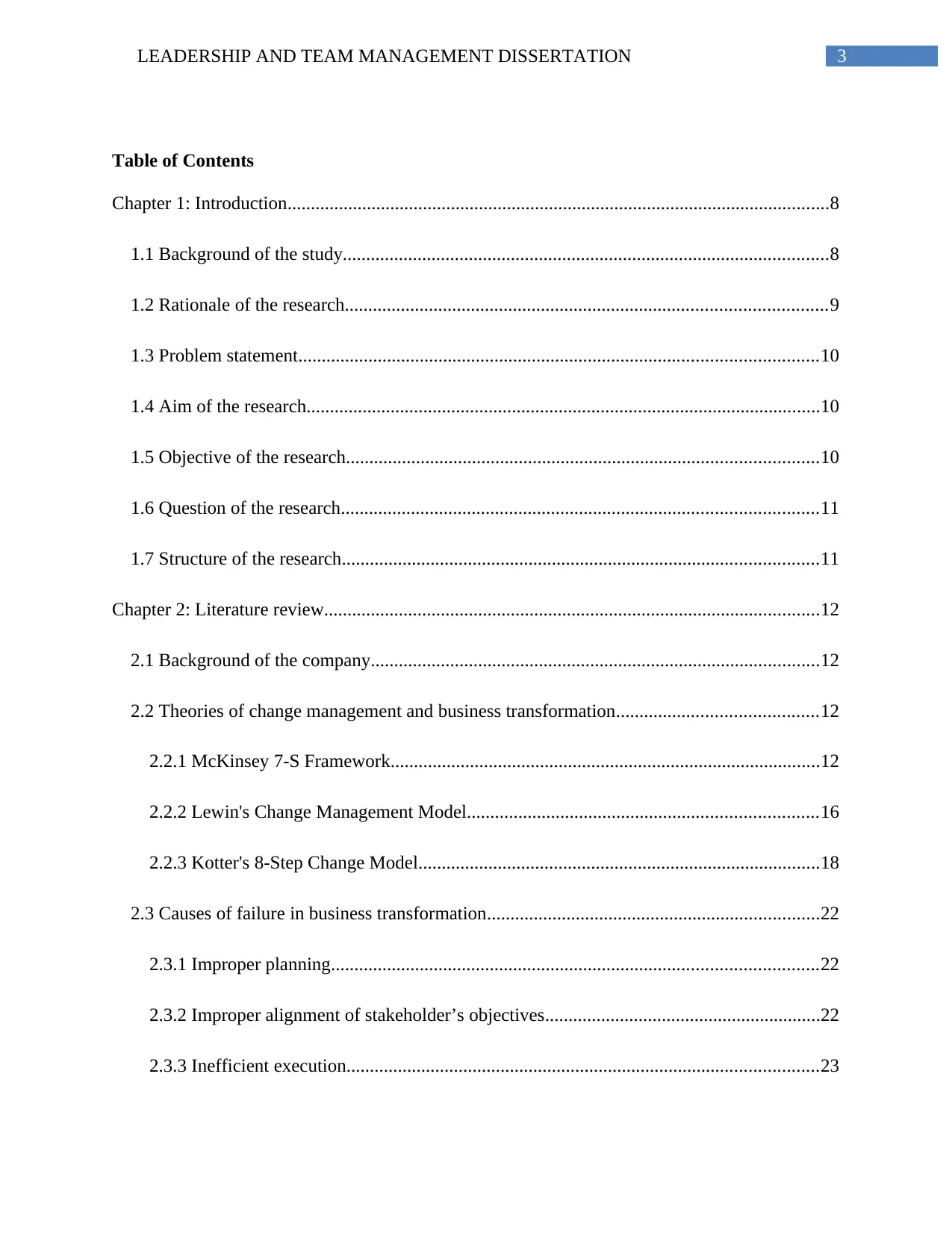
3LEADERSHIP AND TEAM MANAGEMENT DISSERTATION
Table of Contents
Chapter 1: Introduction....................................................................................................................8
1.1 Background of the study........................................................................................................8
1.2 Rationale of the research.......................................................................................................9
1.3 Problem statement...............................................................................................................10
1.4 Aim of the research..............................................................................................................10
1.5 Objective of the research.....................................................................................................10
1.6 Question of the research......................................................................................................11
1.7 Structure of the research......................................................................................................11
Chapter 2: Literature review..........................................................................................................12
2.1 Background of the company................................................................................................12
2.2 Theories of change management and business transformation...........................................12
2.2.1 McKinsey 7-S Framework............................................................................................12
2.2.2 Lewin's Change Management Model...........................................................................16
2.2.3 Kotter's 8-Step Change Model......................................................................................18
2.3 Causes of failure in business transformation.......................................................................22
2.3.1 Improper planning........................................................................................................22
2.3.2 Improper alignment of stakeholder’s objectives...........................................................22
2.3.3 Inefficient execution.....................................................................................................23
Table of Contents
Chapter 1: Introduction....................................................................................................................8
1.1 Background of the study........................................................................................................8
1.2 Rationale of the research.......................................................................................................9
1.3 Problem statement...............................................................................................................10
1.4 Aim of the research..............................................................................................................10
1.5 Objective of the research.....................................................................................................10
1.6 Question of the research......................................................................................................11
1.7 Structure of the research......................................................................................................11
Chapter 2: Literature review..........................................................................................................12
2.1 Background of the company................................................................................................12
2.2 Theories of change management and business transformation...........................................12
2.2.1 McKinsey 7-S Framework............................................................................................12
2.2.2 Lewin's Change Management Model...........................................................................16
2.2.3 Kotter's 8-Step Change Model......................................................................................18
2.3 Causes of failure in business transformation.......................................................................22
2.3.1 Improper planning........................................................................................................22
2.3.2 Improper alignment of stakeholder’s objectives...........................................................22
2.3.3 Inefficient execution.....................................................................................................23
Secure Best Marks with AI Grader
Need help grading? Try our AI Grader for instant feedback on your assignments.
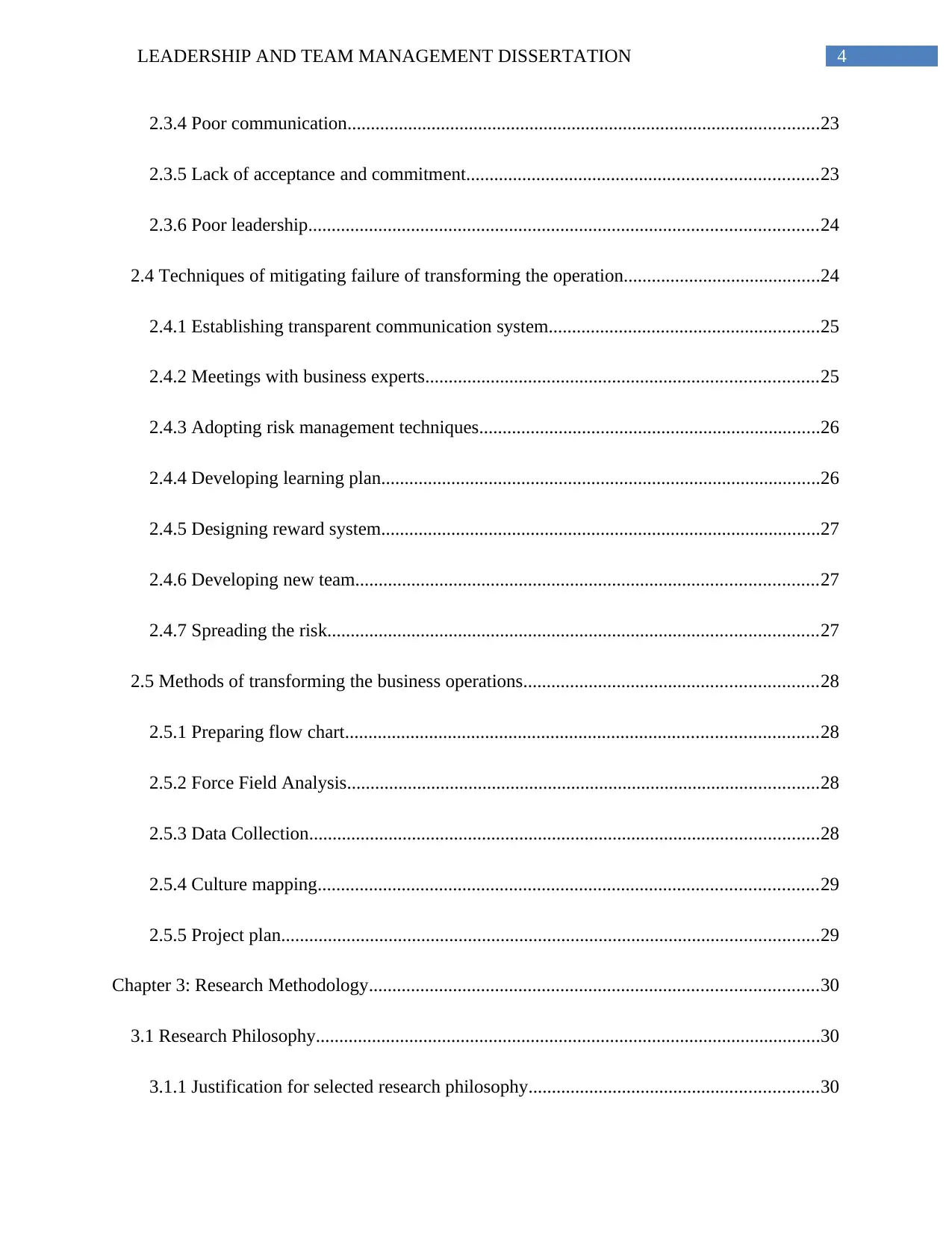
4LEADERSHIP AND TEAM MANAGEMENT DISSERTATION
2.3.4 Poor communication.....................................................................................................23
2.3.5 Lack of acceptance and commitment...........................................................................23
2.3.6 Poor leadership.............................................................................................................24
2.4 Techniques of mitigating failure of transforming the operation..........................................24
2.4.1 Establishing transparent communication system..........................................................25
2.4.2 Meetings with business experts....................................................................................25
2.4.3 Adopting risk management techniques.........................................................................26
2.4.4 Developing learning plan..............................................................................................26
2.4.5 Designing reward system..............................................................................................27
2.4.6 Developing new team...................................................................................................27
2.4.7 Spreading the risk.........................................................................................................27
2.5 Methods of transforming the business operations...............................................................28
2.5.1 Preparing flow chart.....................................................................................................28
2.5.2 Force Field Analysis.....................................................................................................28
2.5.3 Data Collection.............................................................................................................28
2.5.4 Culture mapping...........................................................................................................29
2.5.5 Project plan...................................................................................................................29
Chapter 3: Research Methodology................................................................................................30
3.1 Research Philosophy............................................................................................................30
3.1.1 Justification for selected research philosophy..............................................................30
2.3.4 Poor communication.....................................................................................................23
2.3.5 Lack of acceptance and commitment...........................................................................23
2.3.6 Poor leadership.............................................................................................................24
2.4 Techniques of mitigating failure of transforming the operation..........................................24
2.4.1 Establishing transparent communication system..........................................................25
2.4.2 Meetings with business experts....................................................................................25
2.4.3 Adopting risk management techniques.........................................................................26
2.4.4 Developing learning plan..............................................................................................26
2.4.5 Designing reward system..............................................................................................27
2.4.6 Developing new team...................................................................................................27
2.4.7 Spreading the risk.........................................................................................................27
2.5 Methods of transforming the business operations...............................................................28
2.5.1 Preparing flow chart.....................................................................................................28
2.5.2 Force Field Analysis.....................................................................................................28
2.5.3 Data Collection.............................................................................................................28
2.5.4 Culture mapping...........................................................................................................29
2.5.5 Project plan...................................................................................................................29
Chapter 3: Research Methodology................................................................................................30
3.1 Research Philosophy............................................................................................................30
3.1.1 Justification for selected research philosophy..............................................................30
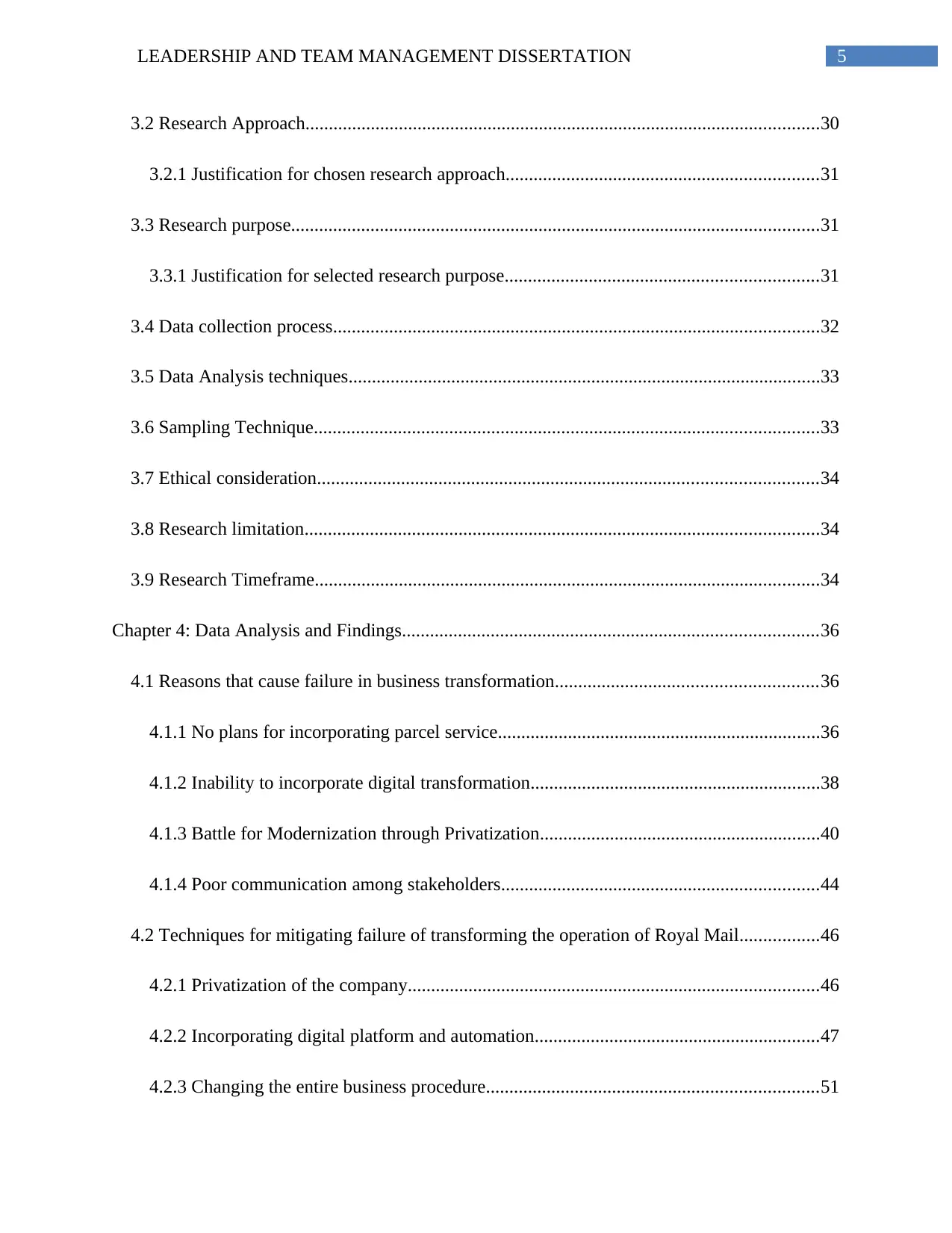
5LEADERSHIP AND TEAM MANAGEMENT DISSERTATION
3.2 Research Approach..............................................................................................................30
3.2.1 Justification for chosen research approach...................................................................31
3.3 Research purpose.................................................................................................................31
3.3.1 Justification for selected research purpose...................................................................31
3.4 Data collection process........................................................................................................32
3.5 Data Analysis techniques.....................................................................................................33
3.6 Sampling Technique............................................................................................................33
3.7 Ethical consideration...........................................................................................................34
3.8 Research limitation..............................................................................................................34
3.9 Research Timeframe............................................................................................................34
Chapter 4: Data Analysis and Findings.........................................................................................36
4.1 Reasons that cause failure in business transformation........................................................36
4.1.1 No plans for incorporating parcel service.....................................................................36
4.1.2 Inability to incorporate digital transformation..............................................................38
4.1.3 Battle for Modernization through Privatization............................................................40
4.1.4 Poor communication among stakeholders....................................................................44
4.2 Techniques for mitigating failure of transforming the operation of Royal Mail.................46
4.2.1 Privatization of the company........................................................................................46
4.2.2 Incorporating digital platform and automation.............................................................47
4.2.3 Changing the entire business procedure.......................................................................51
3.2 Research Approach..............................................................................................................30
3.2.1 Justification for chosen research approach...................................................................31
3.3 Research purpose.................................................................................................................31
3.3.1 Justification for selected research purpose...................................................................31
3.4 Data collection process........................................................................................................32
3.5 Data Analysis techniques.....................................................................................................33
3.6 Sampling Technique............................................................................................................33
3.7 Ethical consideration...........................................................................................................34
3.8 Research limitation..............................................................................................................34
3.9 Research Timeframe............................................................................................................34
Chapter 4: Data Analysis and Findings.........................................................................................36
4.1 Reasons that cause failure in business transformation........................................................36
4.1.1 No plans for incorporating parcel service.....................................................................36
4.1.2 Inability to incorporate digital transformation..............................................................38
4.1.3 Battle for Modernization through Privatization............................................................40
4.1.4 Poor communication among stakeholders....................................................................44
4.2 Techniques for mitigating failure of transforming the operation of Royal Mail.................46
4.2.1 Privatization of the company........................................................................................46
4.2.2 Incorporating digital platform and automation.............................................................47
4.2.3 Changing the entire business procedure.......................................................................51
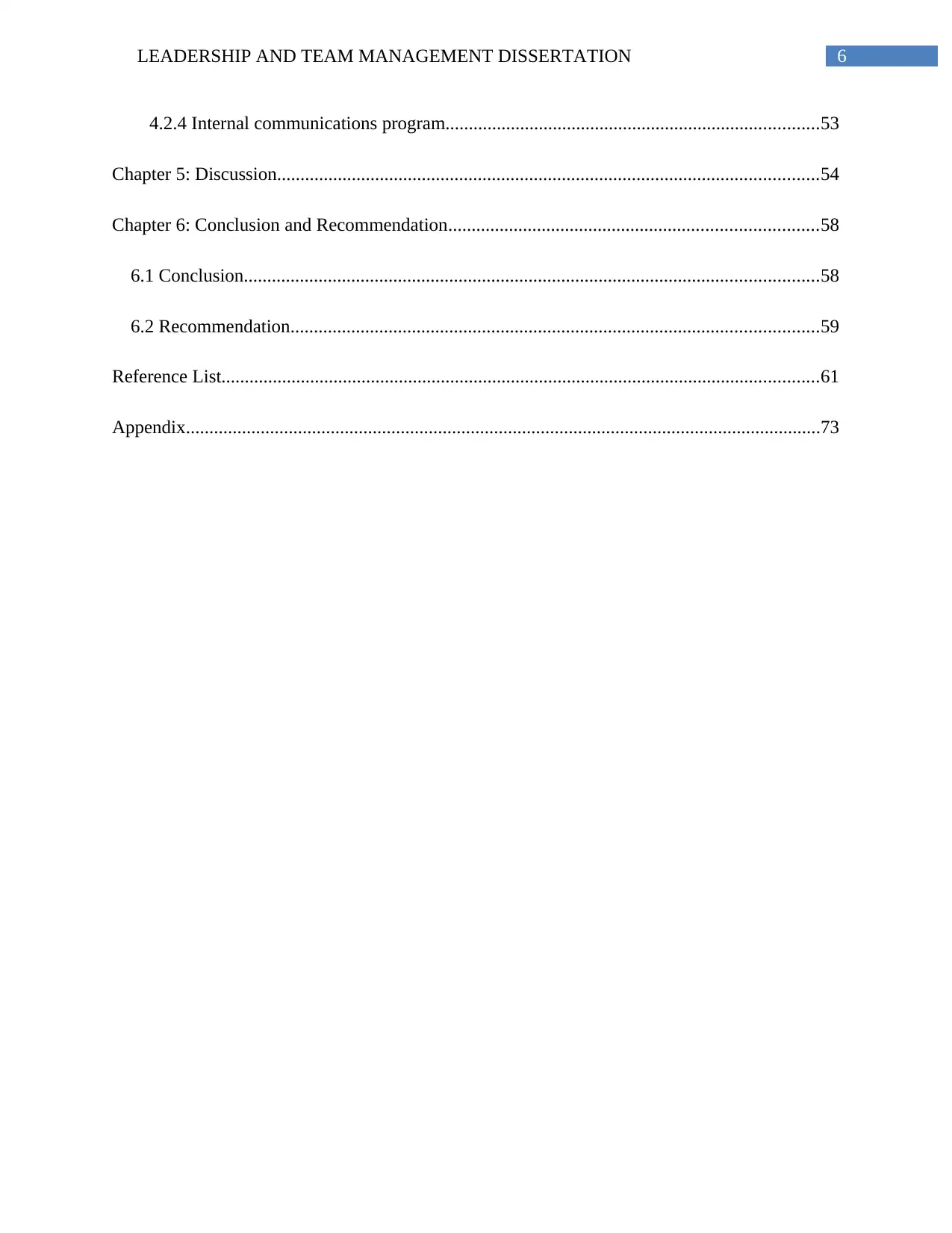
6LEADERSHIP AND TEAM MANAGEMENT DISSERTATION
4.2.4 Internal communications program................................................................................53
Chapter 5: Discussion....................................................................................................................54
Chapter 6: Conclusion and Recommendation...............................................................................58
6.1 Conclusion...........................................................................................................................58
6.2 Recommendation.................................................................................................................59
Reference List................................................................................................................................61
Appendix........................................................................................................................................73
4.2.4 Internal communications program................................................................................53
Chapter 5: Discussion....................................................................................................................54
Chapter 6: Conclusion and Recommendation...............................................................................58
6.1 Conclusion...........................................................................................................................58
6.2 Recommendation.................................................................................................................59
Reference List................................................................................................................................61
Appendix........................................................................................................................................73
Paraphrase This Document
Need a fresh take? Get an instant paraphrase of this document with our AI Paraphraser
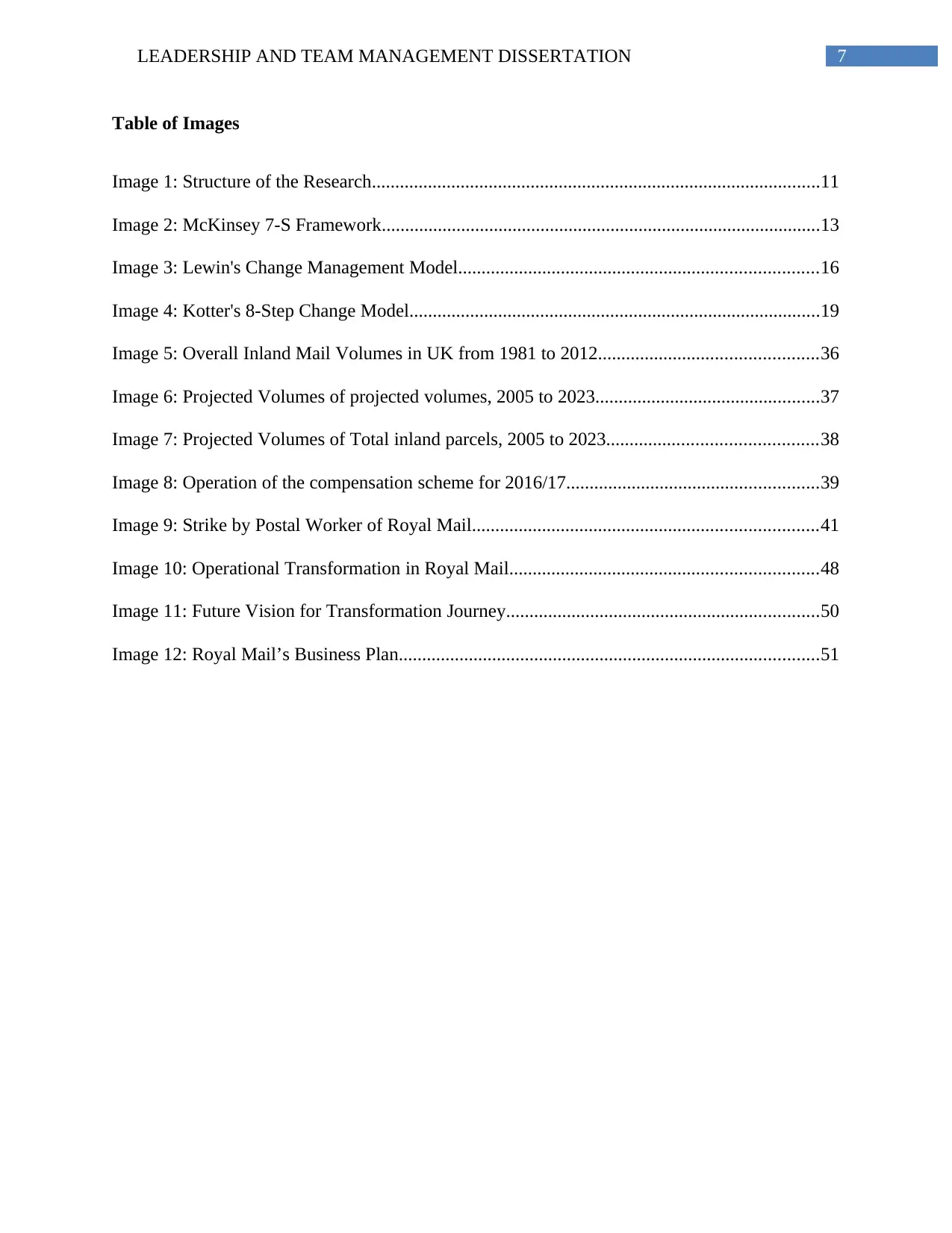
7LEADERSHIP AND TEAM MANAGEMENT DISSERTATION
Table of Images
Image 1: Structure of the Research................................................................................................11
Image 2: McKinsey 7-S Framework..............................................................................................13
Image 3: Lewin's Change Management Model.............................................................................16
Image 4: Kotter's 8-Step Change Model........................................................................................19
Image 5: Overall Inland Mail Volumes in UK from 1981 to 2012...............................................36
Image 6: Projected Volumes of projected volumes, 2005 to 2023................................................37
Image 7: Projected Volumes of Total inland parcels, 2005 to 2023.............................................38
Image 8: Operation of the compensation scheme for 2016/17......................................................39
Image 9: Strike by Postal Worker of Royal Mail..........................................................................41
Image 10: Operational Transformation in Royal Mail..................................................................48
Image 11: Future Vision for Transformation Journey...................................................................50
Image 12: Royal Mail’s Business Plan..........................................................................................51
Table of Images
Image 1: Structure of the Research................................................................................................11
Image 2: McKinsey 7-S Framework..............................................................................................13
Image 3: Lewin's Change Management Model.............................................................................16
Image 4: Kotter's 8-Step Change Model........................................................................................19
Image 5: Overall Inland Mail Volumes in UK from 1981 to 2012...............................................36
Image 6: Projected Volumes of projected volumes, 2005 to 2023................................................37
Image 7: Projected Volumes of Total inland parcels, 2005 to 2023.............................................38
Image 8: Operation of the compensation scheme for 2016/17......................................................39
Image 9: Strike by Postal Worker of Royal Mail..........................................................................41
Image 10: Operational Transformation in Royal Mail..................................................................48
Image 11: Future Vision for Transformation Journey...................................................................50
Image 12: Royal Mail’s Business Plan..........................................................................................51
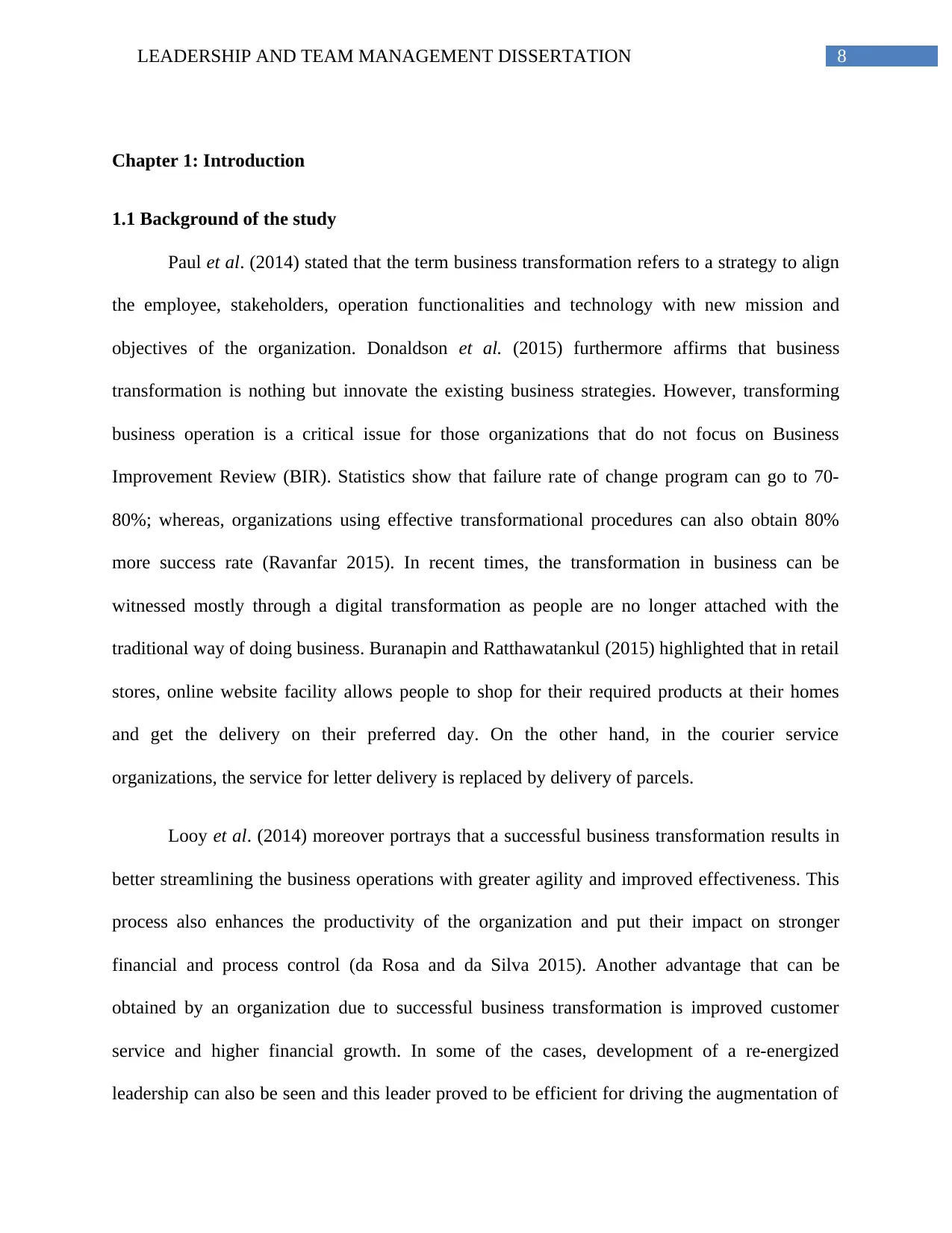
8LEADERSHIP AND TEAM MANAGEMENT DISSERTATION
Chapter 1: Introduction
1.1 Background of the study
Paul et al. (2014) stated that the term business transformation refers to a strategy to align
the employee, stakeholders, operation functionalities and technology with new mission and
objectives of the organization. Donaldson et al. (2015) furthermore affirms that business
transformation is nothing but innovate the existing business strategies. However, transforming
business operation is a critical issue for those organizations that do not focus on Business
Improvement Review (BIR). Statistics show that failure rate of change program can go to 70-
80%; whereas, organizations using effective transformational procedures can also obtain 80%
more success rate (Ravanfar 2015). In recent times, the transformation in business can be
witnessed mostly through a digital transformation as people are no longer attached with the
traditional way of doing business. Buranapin and Ratthawatankul (2015) highlighted that in retail
stores, online website facility allows people to shop for their required products at their homes
and get the delivery on their preferred day. On the other hand, in the courier service
organizations, the service for letter delivery is replaced by delivery of parcels.
Looy et al. (2014) moreover portrays that a successful business transformation results in
better streamlining the business operations with greater agility and improved effectiveness. This
process also enhances the productivity of the organization and put their impact on stronger
financial and process control (da Rosa and da Silva 2015). Another advantage that can be
obtained by an organization due to successful business transformation is improved customer
service and higher financial growth. In some of the cases, development of a re-energized
leadership can also be seen and this leader proved to be efficient for driving the augmentation of
Chapter 1: Introduction
1.1 Background of the study
Paul et al. (2014) stated that the term business transformation refers to a strategy to align
the employee, stakeholders, operation functionalities and technology with new mission and
objectives of the organization. Donaldson et al. (2015) furthermore affirms that business
transformation is nothing but innovate the existing business strategies. However, transforming
business operation is a critical issue for those organizations that do not focus on Business
Improvement Review (BIR). Statistics show that failure rate of change program can go to 70-
80%; whereas, organizations using effective transformational procedures can also obtain 80%
more success rate (Ravanfar 2015). In recent times, the transformation in business can be
witnessed mostly through a digital transformation as people are no longer attached with the
traditional way of doing business. Buranapin and Ratthawatankul (2015) highlighted that in retail
stores, online website facility allows people to shop for their required products at their homes
and get the delivery on their preferred day. On the other hand, in the courier service
organizations, the service for letter delivery is replaced by delivery of parcels.
Looy et al. (2014) moreover portrays that a successful business transformation results in
better streamlining the business operations with greater agility and improved effectiveness. This
process also enhances the productivity of the organization and put their impact on stronger
financial and process control (da Rosa and da Silva 2015). Another advantage that can be
obtained by an organization due to successful business transformation is improved customer
service and higher financial growth. In some of the cases, development of a re-energized
leadership can also be seen and this leader proved to be efficient for driving the augmentation of
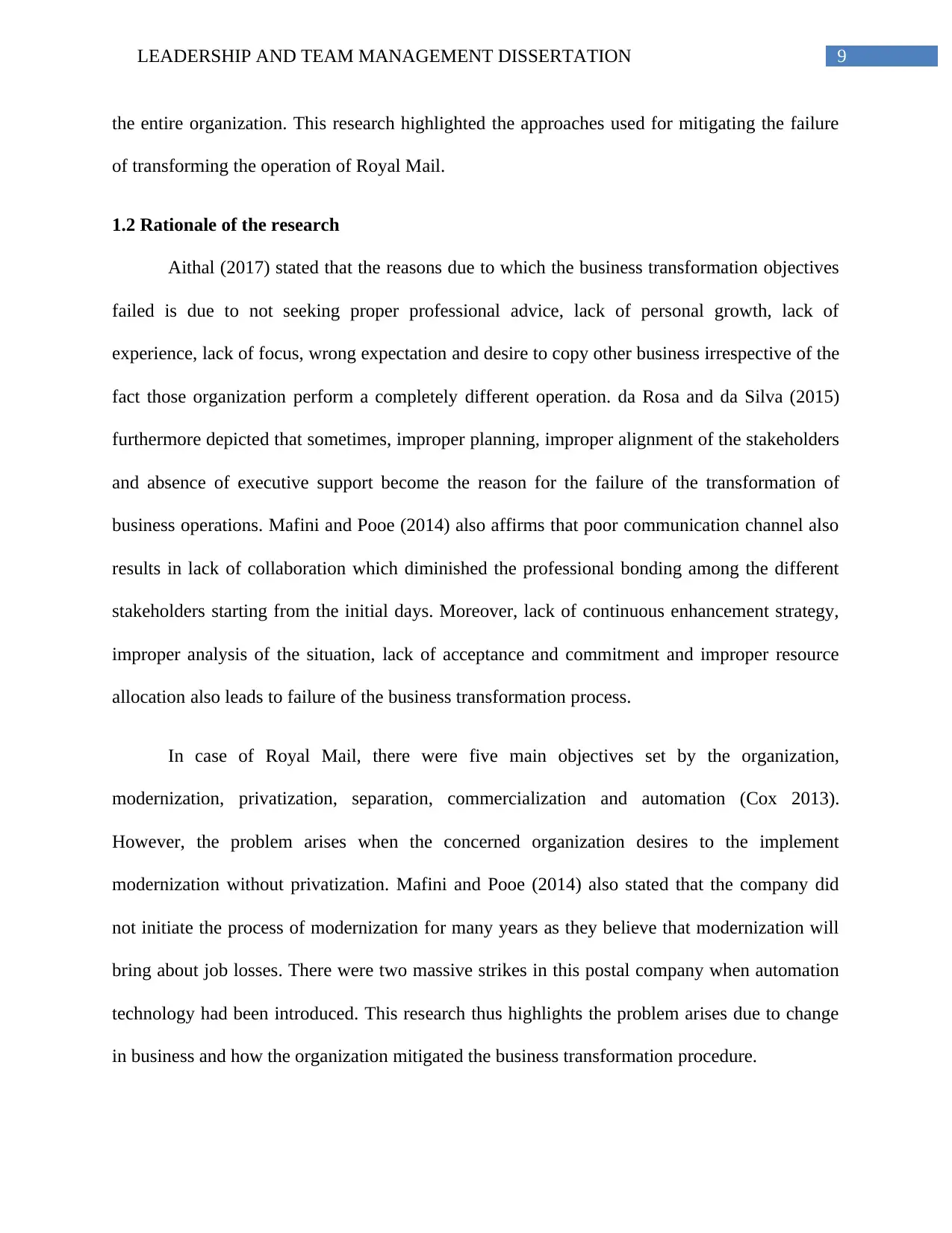
9LEADERSHIP AND TEAM MANAGEMENT DISSERTATION
the entire organization. This research highlighted the approaches used for mitigating the failure
of transforming the operation of Royal Mail.
1.2 Rationale of the research
Aithal (2017) stated that the reasons due to which the business transformation objectives
failed is due to not seeking proper professional advice, lack of personal growth, lack of
experience, lack of focus, wrong expectation and desire to copy other business irrespective of the
fact those organization perform a completely different operation. da Rosa and da Silva (2015)
furthermore depicted that sometimes, improper planning, improper alignment of the stakeholders
and absence of executive support become the reason for the failure of the transformation of
business operations. Mafini and Pooe (2014) also affirms that poor communication channel also
results in lack of collaboration which diminished the professional bonding among the different
stakeholders starting from the initial days. Moreover, lack of continuous enhancement strategy,
improper analysis of the situation, lack of acceptance and commitment and improper resource
allocation also leads to failure of the business transformation process.
In case of Royal Mail, there were five main objectives set by the organization,
modernization, privatization, separation, commercialization and automation (Cox 2013).
However, the problem arises when the concerned organization desires to the implement
modernization without privatization. Mafini and Pooe (2014) also stated that the company did
not initiate the process of modernization for many years as they believe that modernization will
bring about job losses. There were two massive strikes in this postal company when automation
technology had been introduced. This research thus highlights the problem arises due to change
in business and how the organization mitigated the business transformation procedure.
the entire organization. This research highlighted the approaches used for mitigating the failure
of transforming the operation of Royal Mail.
1.2 Rationale of the research
Aithal (2017) stated that the reasons due to which the business transformation objectives
failed is due to not seeking proper professional advice, lack of personal growth, lack of
experience, lack of focus, wrong expectation and desire to copy other business irrespective of the
fact those organization perform a completely different operation. da Rosa and da Silva (2015)
furthermore depicted that sometimes, improper planning, improper alignment of the stakeholders
and absence of executive support become the reason for the failure of the transformation of
business operations. Mafini and Pooe (2014) also affirms that poor communication channel also
results in lack of collaboration which diminished the professional bonding among the different
stakeholders starting from the initial days. Moreover, lack of continuous enhancement strategy,
improper analysis of the situation, lack of acceptance and commitment and improper resource
allocation also leads to failure of the business transformation process.
In case of Royal Mail, there were five main objectives set by the organization,
modernization, privatization, separation, commercialization and automation (Cox 2013).
However, the problem arises when the concerned organization desires to the implement
modernization without privatization. Mafini and Pooe (2014) also stated that the company did
not initiate the process of modernization for many years as they believe that modernization will
bring about job losses. There were two massive strikes in this postal company when automation
technology had been introduced. This research thus highlights the problem arises due to change
in business and how the organization mitigated the business transformation procedure.
Secure Best Marks with AI Grader
Need help grading? Try our AI Grader for instant feedback on your assignments.
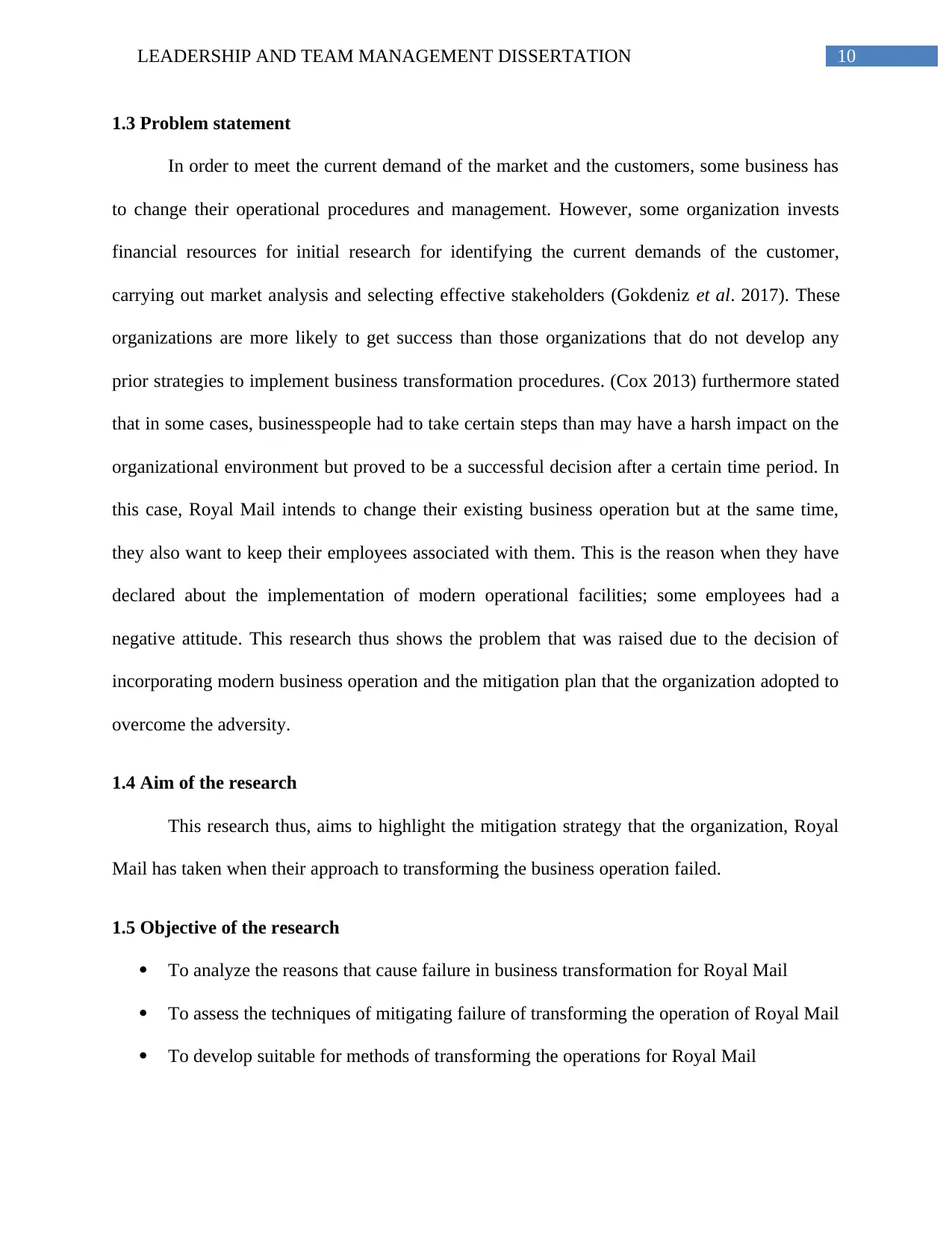
10LEADERSHIP AND TEAM MANAGEMENT DISSERTATION
1.3 Problem statement
In order to meet the current demand of the market and the customers, some business has
to change their operational procedures and management. However, some organization invests
financial resources for initial research for identifying the current demands of the customer,
carrying out market analysis and selecting effective stakeholders (Gokdeniz et al. 2017). These
organizations are more likely to get success than those organizations that do not develop any
prior strategies to implement business transformation procedures. (Cox 2013) furthermore stated
that in some cases, businesspeople had to take certain steps than may have a harsh impact on the
organizational environment but proved to be a successful decision after a certain time period. In
this case, Royal Mail intends to change their existing business operation but at the same time,
they also want to keep their employees associated with them. This is the reason when they have
declared about the implementation of modern operational facilities; some employees had a
negative attitude. This research thus shows the problem that was raised due to the decision of
incorporating modern business operation and the mitigation plan that the organization adopted to
overcome the adversity.
1.4 Aim of the research
This research thus, aims to highlight the mitigation strategy that the organization, Royal
Mail has taken when their approach to transforming the business operation failed.
1.5 Objective of the research
To analyze the reasons that cause failure in business transformation for Royal Mail
To assess the techniques of mitigating failure of transforming the operation of Royal Mail
To develop suitable for methods of transforming the operations for Royal Mail
1.3 Problem statement
In order to meet the current demand of the market and the customers, some business has
to change their operational procedures and management. However, some organization invests
financial resources for initial research for identifying the current demands of the customer,
carrying out market analysis and selecting effective stakeholders (Gokdeniz et al. 2017). These
organizations are more likely to get success than those organizations that do not develop any
prior strategies to implement business transformation procedures. (Cox 2013) furthermore stated
that in some cases, businesspeople had to take certain steps than may have a harsh impact on the
organizational environment but proved to be a successful decision after a certain time period. In
this case, Royal Mail intends to change their existing business operation but at the same time,
they also want to keep their employees associated with them. This is the reason when they have
declared about the implementation of modern operational facilities; some employees had a
negative attitude. This research thus shows the problem that was raised due to the decision of
incorporating modern business operation and the mitigation plan that the organization adopted to
overcome the adversity.
1.4 Aim of the research
This research thus, aims to highlight the mitigation strategy that the organization, Royal
Mail has taken when their approach to transforming the business operation failed.
1.5 Objective of the research
To analyze the reasons that cause failure in business transformation for Royal Mail
To assess the techniques of mitigating failure of transforming the operation of Royal Mail
To develop suitable for methods of transforming the operations for Royal Mail
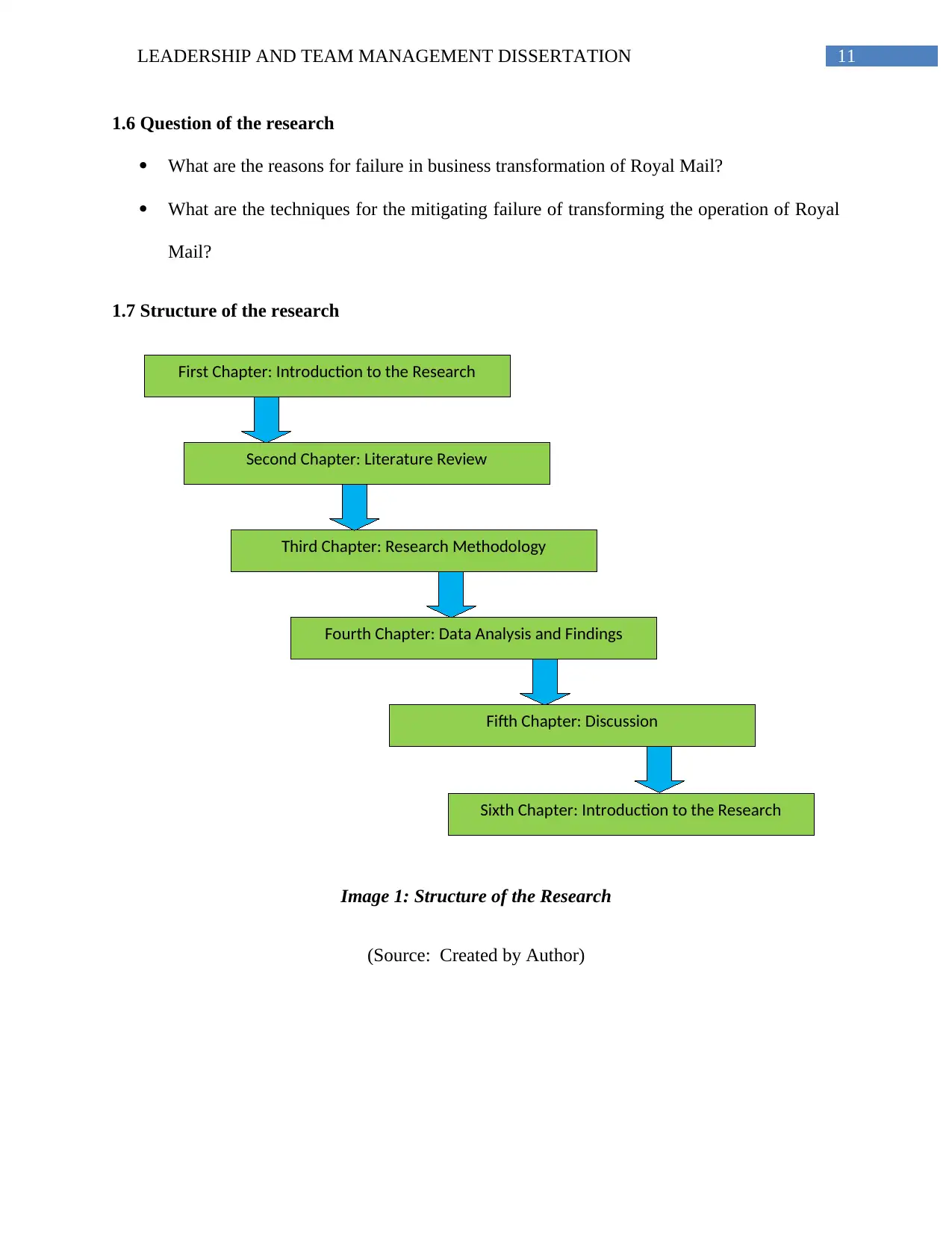
11LEADERSHIP AND TEAM MANAGEMENT DISSERTATION
First Chapter: Introduction to the Research
Fifth Chapter: Discussion
Second Chapter: Literature Review
Fourth Chapter: Data Analysis and Findings
Sixth Chapter: Introduction to the Research
Third Chapter: Research Methodology
1.6 Question of the research
What are the reasons for failure in business transformation of Royal Mail?
What are the techniques for the mitigating failure of transforming the operation of Royal
Mail?
1.7 Structure of the research
Image 1: Structure of the Research
(Source: Created by Author)
First Chapter: Introduction to the Research
Fifth Chapter: Discussion
Second Chapter: Literature Review
Fourth Chapter: Data Analysis and Findings
Sixth Chapter: Introduction to the Research
Third Chapter: Research Methodology
1.6 Question of the research
What are the reasons for failure in business transformation of Royal Mail?
What are the techniques for the mitigating failure of transforming the operation of Royal
Mail?
1.7 Structure of the research
Image 1: Structure of the Research
(Source: Created by Author)
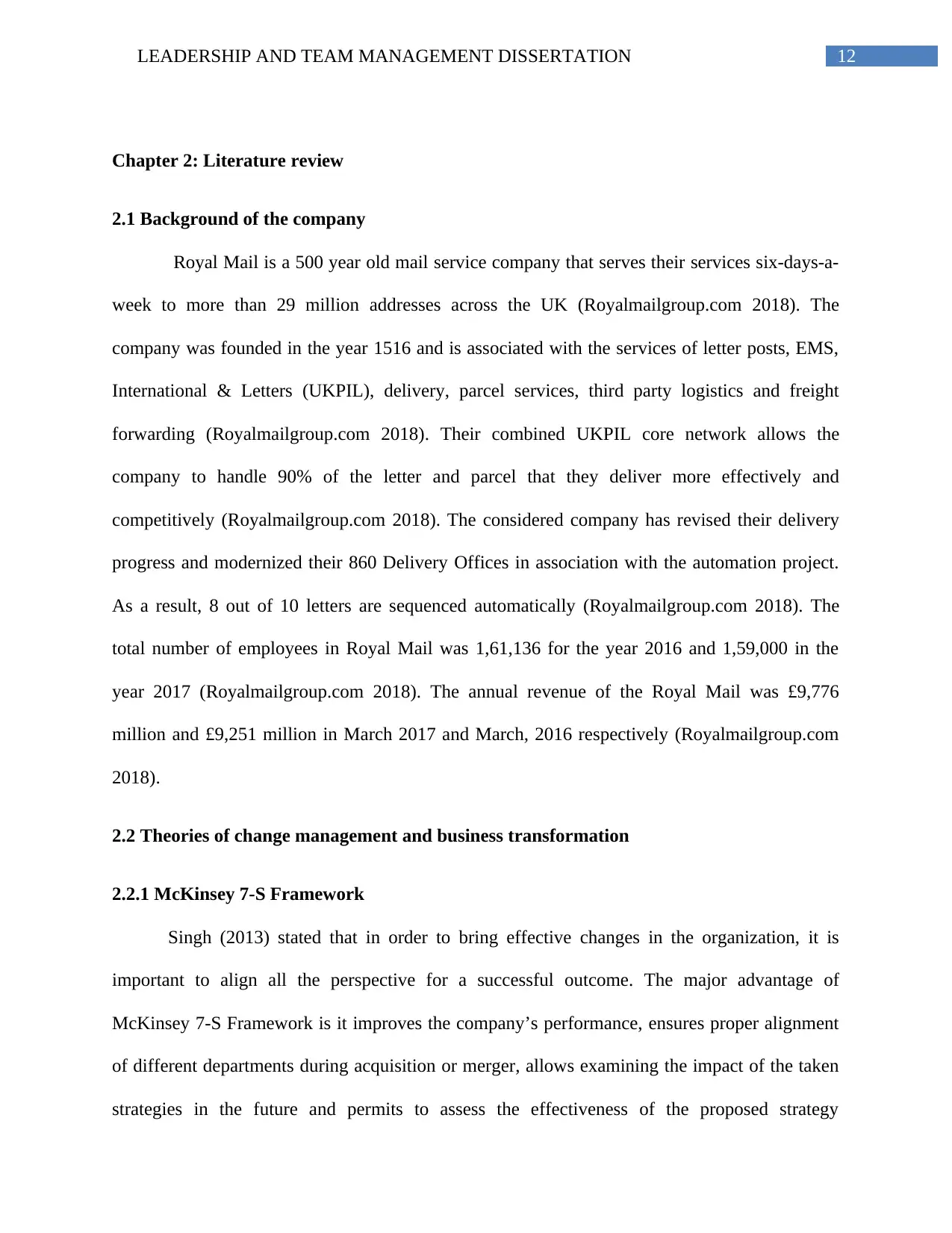
12LEADERSHIP AND TEAM MANAGEMENT DISSERTATION
Chapter 2: Literature review
2.1 Background of the company
Royal Mail is a 500 year old mail service company that serves their services six-days-a-
week to more than 29 million addresses across the UK (Royalmailgroup.com 2018). The
company was founded in the year 1516 and is associated with the services of letter posts, EMS,
International & Letters (UKPIL), delivery, parcel services, third party logistics and freight
forwarding (Royalmailgroup.com 2018). Their combined UKPIL core network allows the
company to handle 90% of the letter and parcel that they deliver more effectively and
competitively (Royalmailgroup.com 2018). The considered company has revised their delivery
progress and modernized their 860 Delivery Offices in association with the automation project.
As a result, 8 out of 10 letters are sequenced automatically (Royalmailgroup.com 2018). The
total number of employees in Royal Mail was 1,61,136 for the year 2016 and 1,59,000 in the
year 2017 (Royalmailgroup.com 2018). The annual revenue of the Royal Mail was £9,776
million and £9,251 million in March 2017 and March, 2016 respectively (Royalmailgroup.com
2018).
2.2 Theories of change management and business transformation
2.2.1 McKinsey 7-S Framework
Singh (2013) stated that in order to bring effective changes in the organization, it is
important to align all the perspective for a successful outcome. The major advantage of
McKinsey 7-S Framework is it improves the company’s performance, ensures proper alignment
of different departments during acquisition or merger, allows examining the impact of the taken
strategies in the future and permits to assess the effectiveness of the proposed strategy
Chapter 2: Literature review
2.1 Background of the company
Royal Mail is a 500 year old mail service company that serves their services six-days-a-
week to more than 29 million addresses across the UK (Royalmailgroup.com 2018). The
company was founded in the year 1516 and is associated with the services of letter posts, EMS,
International & Letters (UKPIL), delivery, parcel services, third party logistics and freight
forwarding (Royalmailgroup.com 2018). Their combined UKPIL core network allows the
company to handle 90% of the letter and parcel that they deliver more effectively and
competitively (Royalmailgroup.com 2018). The considered company has revised their delivery
progress and modernized their 860 Delivery Offices in association with the automation project.
As a result, 8 out of 10 letters are sequenced automatically (Royalmailgroup.com 2018). The
total number of employees in Royal Mail was 1,61,136 for the year 2016 and 1,59,000 in the
year 2017 (Royalmailgroup.com 2018). The annual revenue of the Royal Mail was £9,776
million and £9,251 million in March 2017 and March, 2016 respectively (Royalmailgroup.com
2018).
2.2 Theories of change management and business transformation
2.2.1 McKinsey 7-S Framework
Singh (2013) stated that in order to bring effective changes in the organization, it is
important to align all the perspective for a successful outcome. The major advantage of
McKinsey 7-S Framework is it improves the company’s performance, ensures proper alignment
of different departments during acquisition or merger, allows examining the impact of the taken
strategies in the future and permits to assess the effectiveness of the proposed strategy
Paraphrase This Document
Need a fresh take? Get an instant paraphrase of this document with our AI Paraphraser
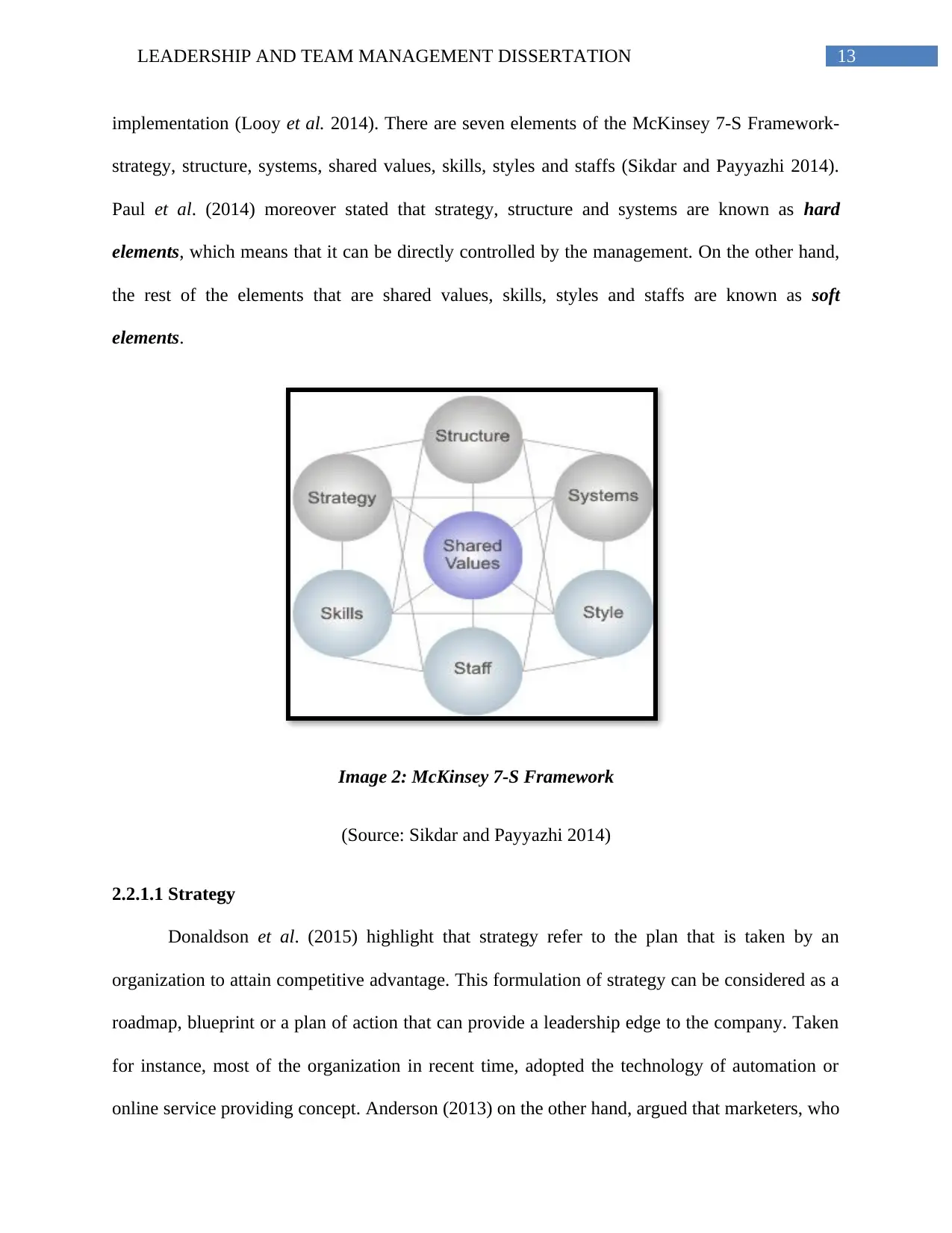
13LEADERSHIP AND TEAM MANAGEMENT DISSERTATION
implementation (Looy et al. 2014). There are seven elements of the McKinsey 7-S Framework-
strategy, structure, systems, shared values, skills, styles and staffs (Sikdar and Payyazhi 2014).
Paul et al. (2014) moreover stated that strategy, structure and systems are known as hard
elements, which means that it can be directly controlled by the management. On the other hand,
the rest of the elements that are shared values, skills, styles and staffs are known as soft
elements.
Image 2: McKinsey 7-S Framework
(Source: Sikdar and Payyazhi 2014)
2.2.1.1 Strategy
Donaldson et al. (2015) highlight that strategy refer to the plan that is taken by an
organization to attain competitive advantage. This formulation of strategy can be considered as a
roadmap, blueprint or a plan of action that can provide a leadership edge to the company. Taken
for instance, most of the organization in recent time, adopted the technology of automation or
online service providing concept. Anderson (2013) on the other hand, argued that marketers, who
implementation (Looy et al. 2014). There are seven elements of the McKinsey 7-S Framework-
strategy, structure, systems, shared values, skills, styles and staffs (Sikdar and Payyazhi 2014).
Paul et al. (2014) moreover stated that strategy, structure and systems are known as hard
elements, which means that it can be directly controlled by the management. On the other hand,
the rest of the elements that are shared values, skills, styles and staffs are known as soft
elements.
Image 2: McKinsey 7-S Framework
(Source: Sikdar and Payyazhi 2014)
2.2.1.1 Strategy
Donaldson et al. (2015) highlight that strategy refer to the plan that is taken by an
organization to attain competitive advantage. This formulation of strategy can be considered as a
roadmap, blueprint or a plan of action that can provide a leadership edge to the company. Taken
for instance, most of the organization in recent time, adopted the technology of automation or
online service providing concept. Anderson (2013) on the other hand, argued that marketers, who
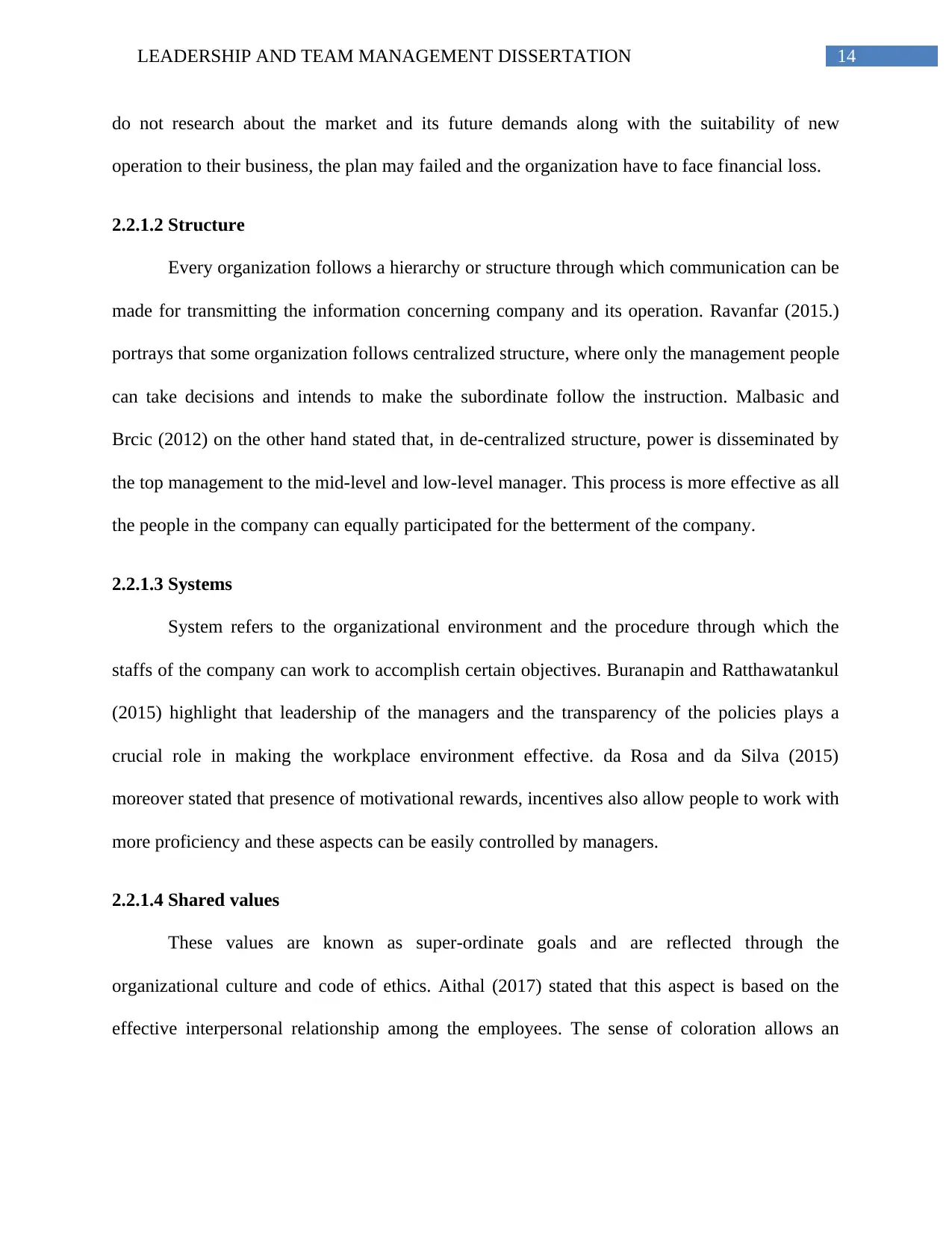
14LEADERSHIP AND TEAM MANAGEMENT DISSERTATION
do not research about the market and its future demands along with the suitability of new
operation to their business, the plan may failed and the organization have to face financial loss.
2.2.1.2 Structure
Every organization follows a hierarchy or structure through which communication can be
made for transmitting the information concerning company and its operation. Ravanfar (2015.)
portrays that some organization follows centralized structure, where only the management people
can take decisions and intends to make the subordinate follow the instruction. Malbasic and
Brcic (2012) on the other hand stated that, in de-centralized structure, power is disseminated by
the top management to the mid-level and low-level manager. This process is more effective as all
the people in the company can equally participated for the betterment of the company.
2.2.1.3 Systems
System refers to the organizational environment and the procedure through which the
staffs of the company can work to accomplish certain objectives. Buranapin and Ratthawatankul
(2015) highlight that leadership of the managers and the transparency of the policies plays a
crucial role in making the workplace environment effective. da Rosa and da Silva (2015)
moreover stated that presence of motivational rewards, incentives also allow people to work with
more proficiency and these aspects can be easily controlled by managers.
2.2.1.4 Shared values
These values are known as super-ordinate goals and are reflected through the
organizational culture and code of ethics. Aithal (2017) stated that this aspect is based on the
effective interpersonal relationship among the employees. The sense of coloration allows an
do not research about the market and its future demands along with the suitability of new
operation to their business, the plan may failed and the organization have to face financial loss.
2.2.1.2 Structure
Every organization follows a hierarchy or structure through which communication can be
made for transmitting the information concerning company and its operation. Ravanfar (2015.)
portrays that some organization follows centralized structure, where only the management people
can take decisions and intends to make the subordinate follow the instruction. Malbasic and
Brcic (2012) on the other hand stated that, in de-centralized structure, power is disseminated by
the top management to the mid-level and low-level manager. This process is more effective as all
the people in the company can equally participated for the betterment of the company.
2.2.1.3 Systems
System refers to the organizational environment and the procedure through which the
staffs of the company can work to accomplish certain objectives. Buranapin and Ratthawatankul
(2015) highlight that leadership of the managers and the transparency of the policies plays a
crucial role in making the workplace environment effective. da Rosa and da Silva (2015)
moreover stated that presence of motivational rewards, incentives also allow people to work with
more proficiency and these aspects can be easily controlled by managers.
2.2.1.4 Shared values
These values are known as super-ordinate goals and are reflected through the
organizational culture and code of ethics. Aithal (2017) stated that this aspect is based on the
effective interpersonal relationship among the employees. The sense of coloration allows an
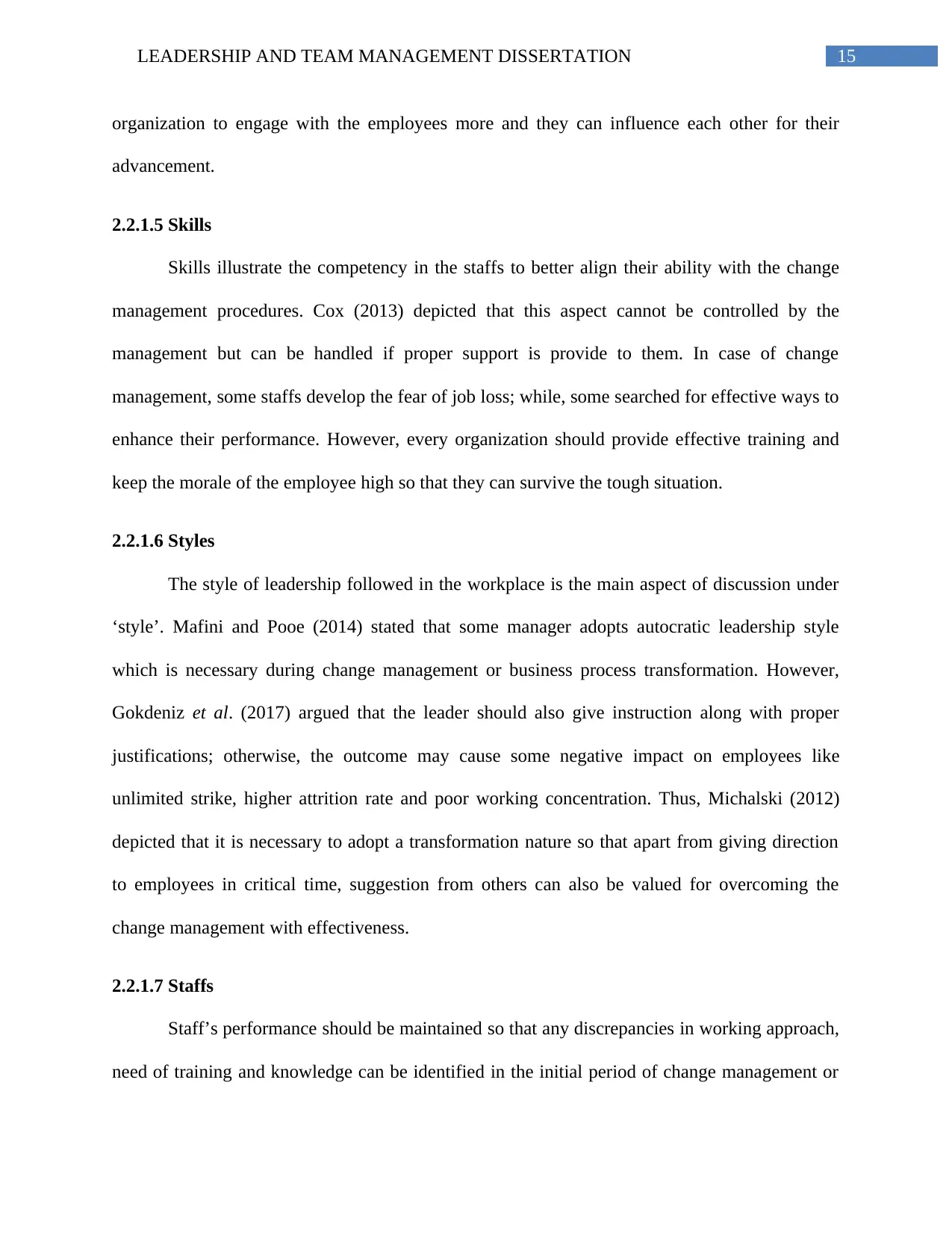
15LEADERSHIP AND TEAM MANAGEMENT DISSERTATION
organization to engage with the employees more and they can influence each other for their
advancement.
2.2.1.5 Skills
Skills illustrate the competency in the staffs to better align their ability with the change
management procedures. Cox (2013) depicted that this aspect cannot be controlled by the
management but can be handled if proper support is provide to them. In case of change
management, some staffs develop the fear of job loss; while, some searched for effective ways to
enhance their performance. However, every organization should provide effective training and
keep the morale of the employee high so that they can survive the tough situation.
2.2.1.6 Styles
The style of leadership followed in the workplace is the main aspect of discussion under
‘style’. Mafini and Pooe (2014) stated that some manager adopts autocratic leadership style
which is necessary during change management or business process transformation. However,
Gokdeniz et al. (2017) argued that the leader should also give instruction along with proper
justifications; otherwise, the outcome may cause some negative impact on employees like
unlimited strike, higher attrition rate and poor working concentration. Thus, Michalski (2012)
depicted that it is necessary to adopt a transformation nature so that apart from giving direction
to employees in critical time, suggestion from others can also be valued for overcoming the
change management with effectiveness.
2.2.1.7 Staffs
Staff’s performance should be maintained so that any discrepancies in working approach,
need of training and knowledge can be identified in the initial period of change management or
organization to engage with the employees more and they can influence each other for their
advancement.
2.2.1.5 Skills
Skills illustrate the competency in the staffs to better align their ability with the change
management procedures. Cox (2013) depicted that this aspect cannot be controlled by the
management but can be handled if proper support is provide to them. In case of change
management, some staffs develop the fear of job loss; while, some searched for effective ways to
enhance their performance. However, every organization should provide effective training and
keep the morale of the employee high so that they can survive the tough situation.
2.2.1.6 Styles
The style of leadership followed in the workplace is the main aspect of discussion under
‘style’. Mafini and Pooe (2014) stated that some manager adopts autocratic leadership style
which is necessary during change management or business process transformation. However,
Gokdeniz et al. (2017) argued that the leader should also give instruction along with proper
justifications; otherwise, the outcome may cause some negative impact on employees like
unlimited strike, higher attrition rate and poor working concentration. Thus, Michalski (2012)
depicted that it is necessary to adopt a transformation nature so that apart from giving direction
to employees in critical time, suggestion from others can also be valued for overcoming the
change management with effectiveness.
2.2.1.7 Staffs
Staff’s performance should be maintained so that any discrepancies in working approach,
need of training and knowledge can be identified in the initial period of change management or
Secure Best Marks with AI Grader
Need help grading? Try our AI Grader for instant feedback on your assignments.
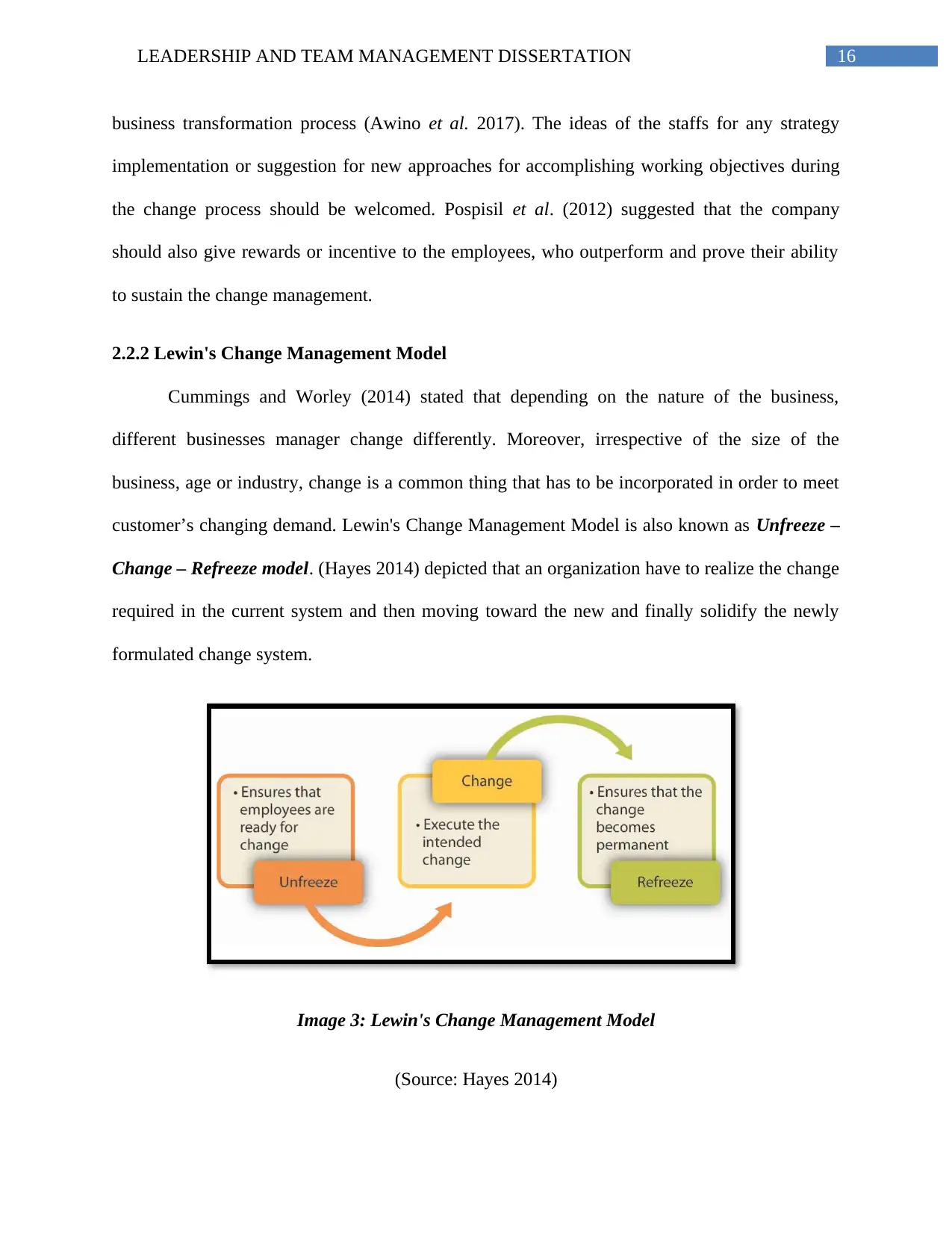
16LEADERSHIP AND TEAM MANAGEMENT DISSERTATION
business transformation process (Awino et al. 2017). The ideas of the staffs for any strategy
implementation or suggestion for new approaches for accomplishing working objectives during
the change process should be welcomed. Pospisil et al. (2012) suggested that the company
should also give rewards or incentive to the employees, who outperform and prove their ability
to sustain the change management.
2.2.2 Lewin's Change Management Model
Cummings and Worley (2014) stated that depending on the nature of the business,
different businesses manager change differently. Moreover, irrespective of the size of the
business, age or industry, change is a common thing that has to be incorporated in order to meet
customer’s changing demand. Lewin's Change Management Model is also known as Unfreeze –
Change – Refreeze model. (Hayes 2014) depicted that an organization have to realize the change
required in the current system and then moving toward the new and finally solidify the newly
formulated change system.
Image 3: Lewin's Change Management Model
(Source: Hayes 2014)
business transformation process (Awino et al. 2017). The ideas of the staffs for any strategy
implementation or suggestion for new approaches for accomplishing working objectives during
the change process should be welcomed. Pospisil et al. (2012) suggested that the company
should also give rewards or incentive to the employees, who outperform and prove their ability
to sustain the change management.
2.2.2 Lewin's Change Management Model
Cummings and Worley (2014) stated that depending on the nature of the business,
different businesses manager change differently. Moreover, irrespective of the size of the
business, age or industry, change is a common thing that has to be incorporated in order to meet
customer’s changing demand. Lewin's Change Management Model is also known as Unfreeze –
Change – Refreeze model. (Hayes 2014) depicted that an organization have to realize the change
required in the current system and then moving toward the new and finally solidify the newly
formulated change system.
Image 3: Lewin's Change Management Model
(Source: Hayes 2014)
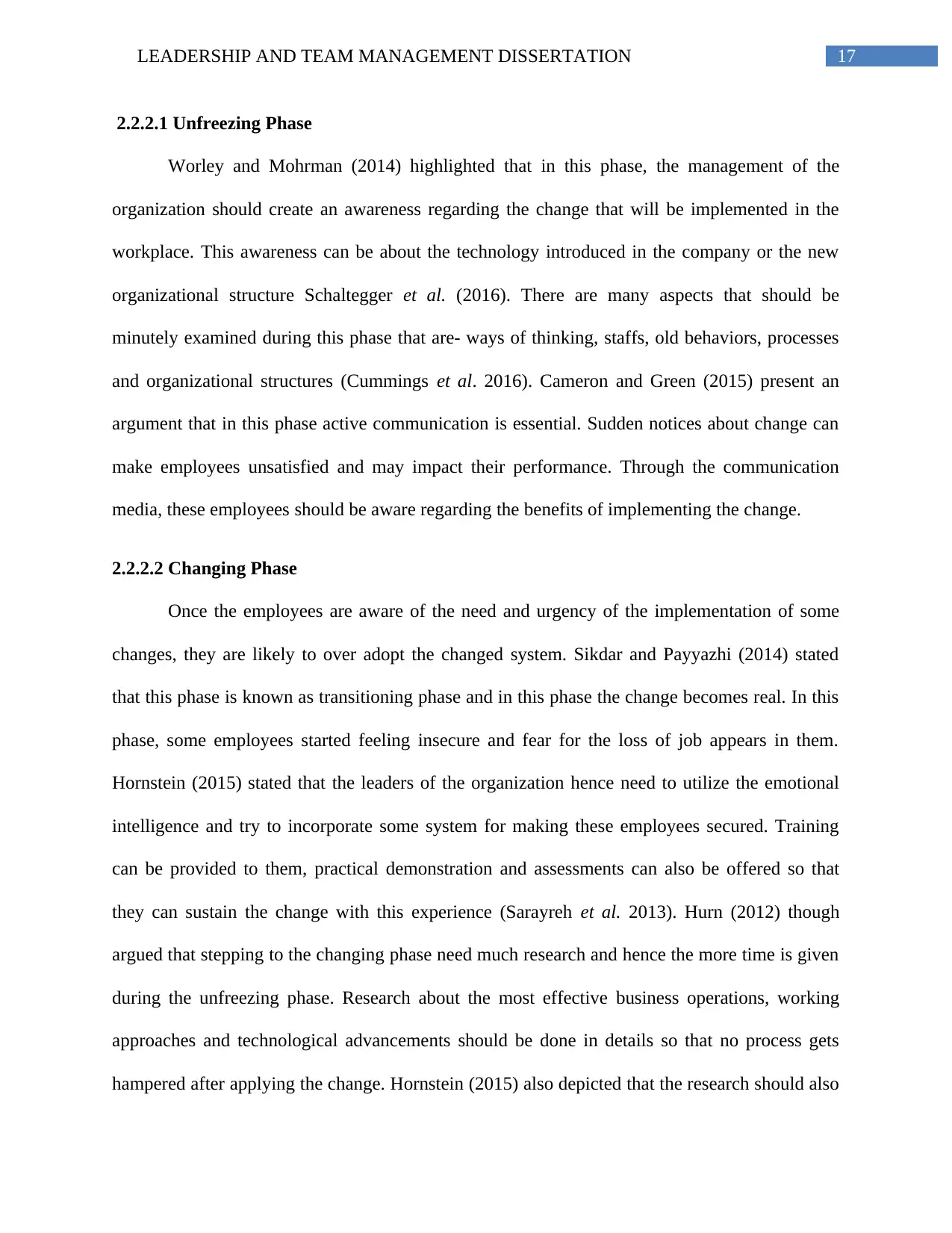
17LEADERSHIP AND TEAM MANAGEMENT DISSERTATION
2.2.2.1 Unfreezing Phase
Worley and Mohrman (2014) highlighted that in this phase, the management of the
organization should create an awareness regarding the change that will be implemented in the
workplace. This awareness can be about the technology introduced in the company or the new
organizational structure Schaltegger et al. (2016). There are many aspects that should be
minutely examined during this phase that are- ways of thinking, staffs, old behaviors, processes
and organizational structures (Cummings et al. 2016). Cameron and Green (2015) present an
argument that in this phase active communication is essential. Sudden notices about change can
make employees unsatisfied and may impact their performance. Through the communication
media, these employees should be aware regarding the benefits of implementing the change.
2.2.2.2 Changing Phase
Once the employees are aware of the need and urgency of the implementation of some
changes, they are likely to over adopt the changed system. Sikdar and Payyazhi (2014) stated
that this phase is known as transitioning phase and in this phase the change becomes real. In this
phase, some employees started feeling insecure and fear for the loss of job appears in them.
Hornstein (2015) stated that the leaders of the organization hence need to utilize the emotional
intelligence and try to incorporate some system for making these employees secured. Training
can be provided to them, practical demonstration and assessments can also be offered so that
they can sustain the change with this experience (Sarayreh et al. 2013). Hurn (2012) though
argued that stepping to the changing phase need much research and hence the more time is given
during the unfreezing phase. Research about the most effective business operations, working
approaches and technological advancements should be done in details so that no process gets
hampered after applying the change. Hornstein (2015) also depicted that the research should also
2.2.2.1 Unfreezing Phase
Worley and Mohrman (2014) highlighted that in this phase, the management of the
organization should create an awareness regarding the change that will be implemented in the
workplace. This awareness can be about the technology introduced in the company or the new
organizational structure Schaltegger et al. (2016). There are many aspects that should be
minutely examined during this phase that are- ways of thinking, staffs, old behaviors, processes
and organizational structures (Cummings et al. 2016). Cameron and Green (2015) present an
argument that in this phase active communication is essential. Sudden notices about change can
make employees unsatisfied and may impact their performance. Through the communication
media, these employees should be aware regarding the benefits of implementing the change.
2.2.2.2 Changing Phase
Once the employees are aware of the need and urgency of the implementation of some
changes, they are likely to over adopt the changed system. Sikdar and Payyazhi (2014) stated
that this phase is known as transitioning phase and in this phase the change becomes real. In this
phase, some employees started feeling insecure and fear for the loss of job appears in them.
Hornstein (2015) stated that the leaders of the organization hence need to utilize the emotional
intelligence and try to incorporate some system for making these employees secured. Training
can be provided to them, practical demonstration and assessments can also be offered so that
they can sustain the change with this experience (Sarayreh et al. 2013). Hurn (2012) though
argued that stepping to the changing phase need much research and hence the more time is given
during the unfreezing phase. Research about the most effective business operations, working
approaches and technological advancements should be done in details so that no process gets
hampered after applying the change. Hornstein (2015) also depicted that the research should also
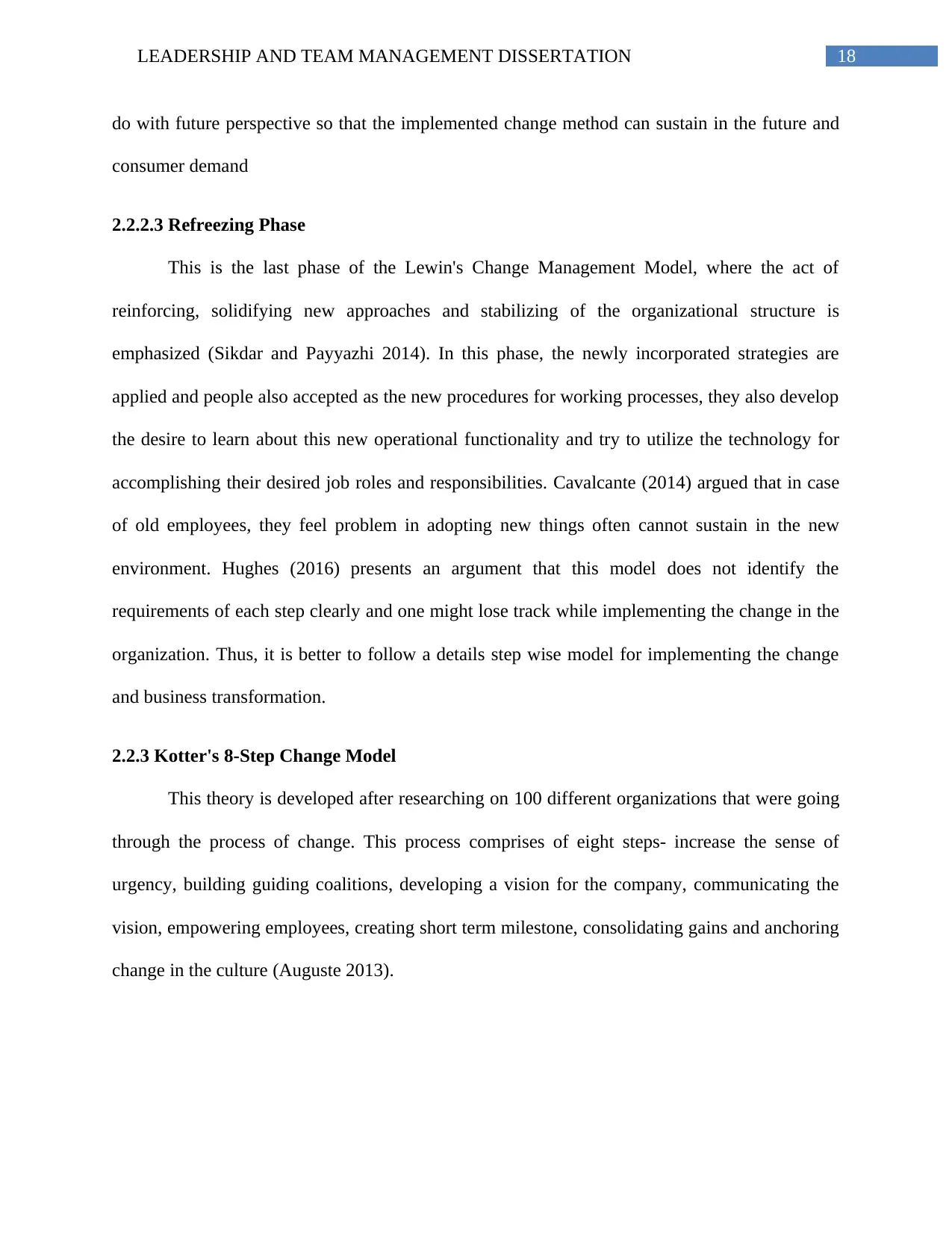
18LEADERSHIP AND TEAM MANAGEMENT DISSERTATION
do with future perspective so that the implemented change method can sustain in the future and
consumer demand
2.2.2.3 Refreezing Phase
This is the last phase of the Lewin's Change Management Model, where the act of
reinforcing, solidifying new approaches and stabilizing of the organizational structure is
emphasized (Sikdar and Payyazhi 2014). In this phase, the newly incorporated strategies are
applied and people also accepted as the new procedures for working processes, they also develop
the desire to learn about this new operational functionality and try to utilize the technology for
accomplishing their desired job roles and responsibilities. Cavalcante (2014) argued that in case
of old employees, they feel problem in adopting new things often cannot sustain in the new
environment. Hughes (2016) presents an argument that this model does not identify the
requirements of each step clearly and one might lose track while implementing the change in the
organization. Thus, it is better to follow a details step wise model for implementing the change
and business transformation.
2.2.3 Kotter's 8-Step Change Model
This theory is developed after researching on 100 different organizations that were going
through the process of change. This process comprises of eight steps- increase the sense of
urgency, building guiding coalitions, developing a vision for the company, communicating the
vision, empowering employees, creating short term milestone, consolidating gains and anchoring
change in the culture (Auguste 2013).
do with future perspective so that the implemented change method can sustain in the future and
consumer demand
2.2.2.3 Refreezing Phase
This is the last phase of the Lewin's Change Management Model, where the act of
reinforcing, solidifying new approaches and stabilizing of the organizational structure is
emphasized (Sikdar and Payyazhi 2014). In this phase, the newly incorporated strategies are
applied and people also accepted as the new procedures for working processes, they also develop
the desire to learn about this new operational functionality and try to utilize the technology for
accomplishing their desired job roles and responsibilities. Cavalcante (2014) argued that in case
of old employees, they feel problem in adopting new things often cannot sustain in the new
environment. Hughes (2016) presents an argument that this model does not identify the
requirements of each step clearly and one might lose track while implementing the change in the
organization. Thus, it is better to follow a details step wise model for implementing the change
and business transformation.
2.2.3 Kotter's 8-Step Change Model
This theory is developed after researching on 100 different organizations that were going
through the process of change. This process comprises of eight steps- increase the sense of
urgency, building guiding coalitions, developing a vision for the company, communicating the
vision, empowering employees, creating short term milestone, consolidating gains and anchoring
change in the culture (Auguste 2013).
Paraphrase This Document
Need a fresh take? Get an instant paraphrase of this document with our AI Paraphraser
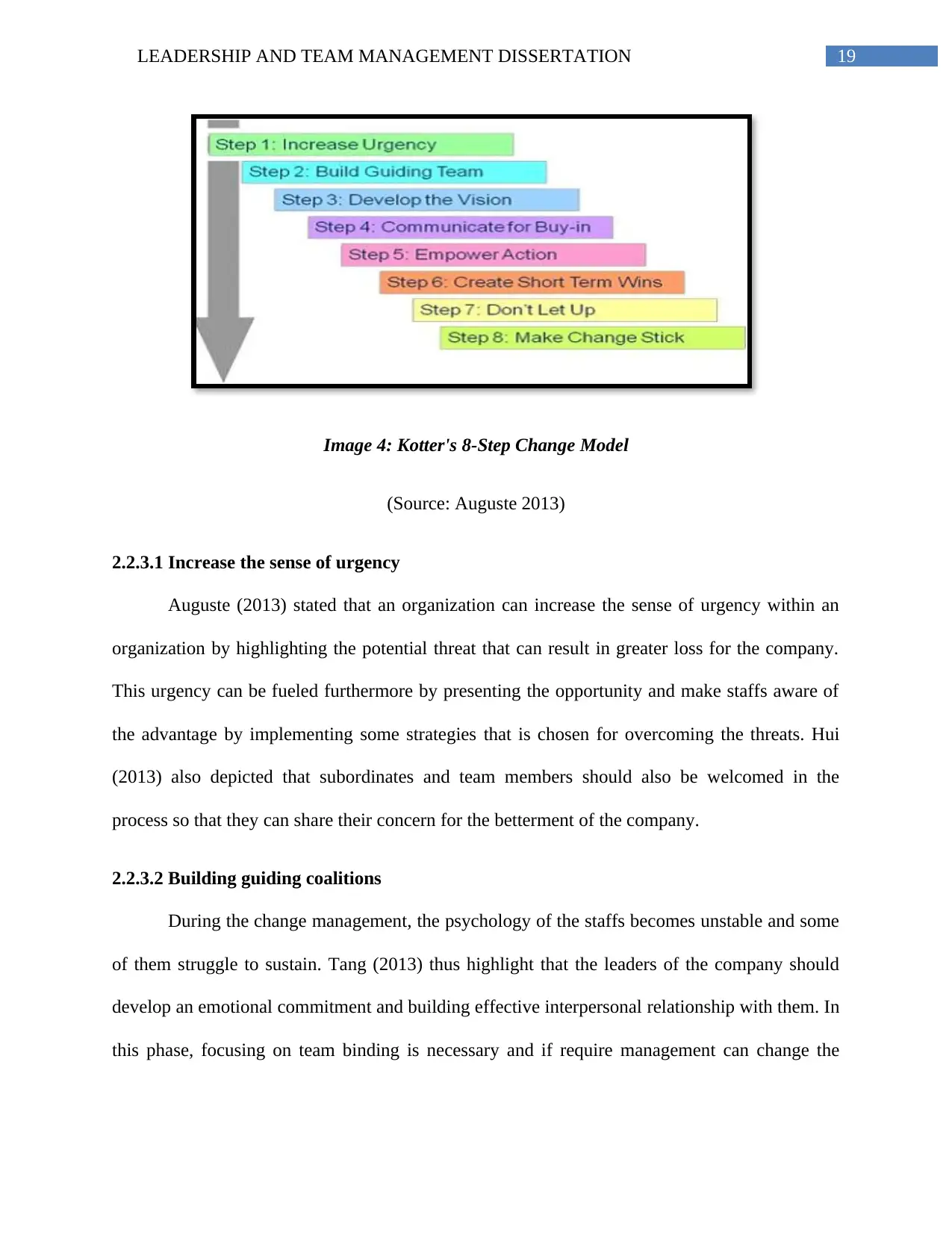
19LEADERSHIP AND TEAM MANAGEMENT DISSERTATION
Image 4: Kotter's 8-Step Change Model
(Source: Auguste 2013)
2.2.3.1 Increase the sense of urgency
Auguste (2013) stated that an organization can increase the sense of urgency within an
organization by highlighting the potential threat that can result in greater loss for the company.
This urgency can be fueled furthermore by presenting the opportunity and make staffs aware of
the advantage by implementing some strategies that is chosen for overcoming the threats. Hui
(2013) also depicted that subordinates and team members should also be welcomed in the
process so that they can share their concern for the betterment of the company.
2.2.3.2 Building guiding coalitions
During the change management, the psychology of the staffs becomes unstable and some
of them struggle to sustain. Tang (2013) thus highlight that the leaders of the company should
develop an emotional commitment and building effective interpersonal relationship with them. In
this phase, focusing on team binding is necessary and if require management can change the
Image 4: Kotter's 8-Step Change Model
(Source: Auguste 2013)
2.2.3.1 Increase the sense of urgency
Auguste (2013) stated that an organization can increase the sense of urgency within an
organization by highlighting the potential threat that can result in greater loss for the company.
This urgency can be fueled furthermore by presenting the opportunity and make staffs aware of
the advantage by implementing some strategies that is chosen for overcoming the threats. Hui
(2013) also depicted that subordinates and team members should also be welcomed in the
process so that they can share their concern for the betterment of the company.
2.2.3.2 Building guiding coalitions
During the change management, the psychology of the staffs becomes unstable and some
of them struggle to sustain. Tang (2013) thus highlight that the leaders of the company should
develop an emotional commitment and building effective interpersonal relationship with them. In
this phase, focusing on team binding is necessary and if require management can change the
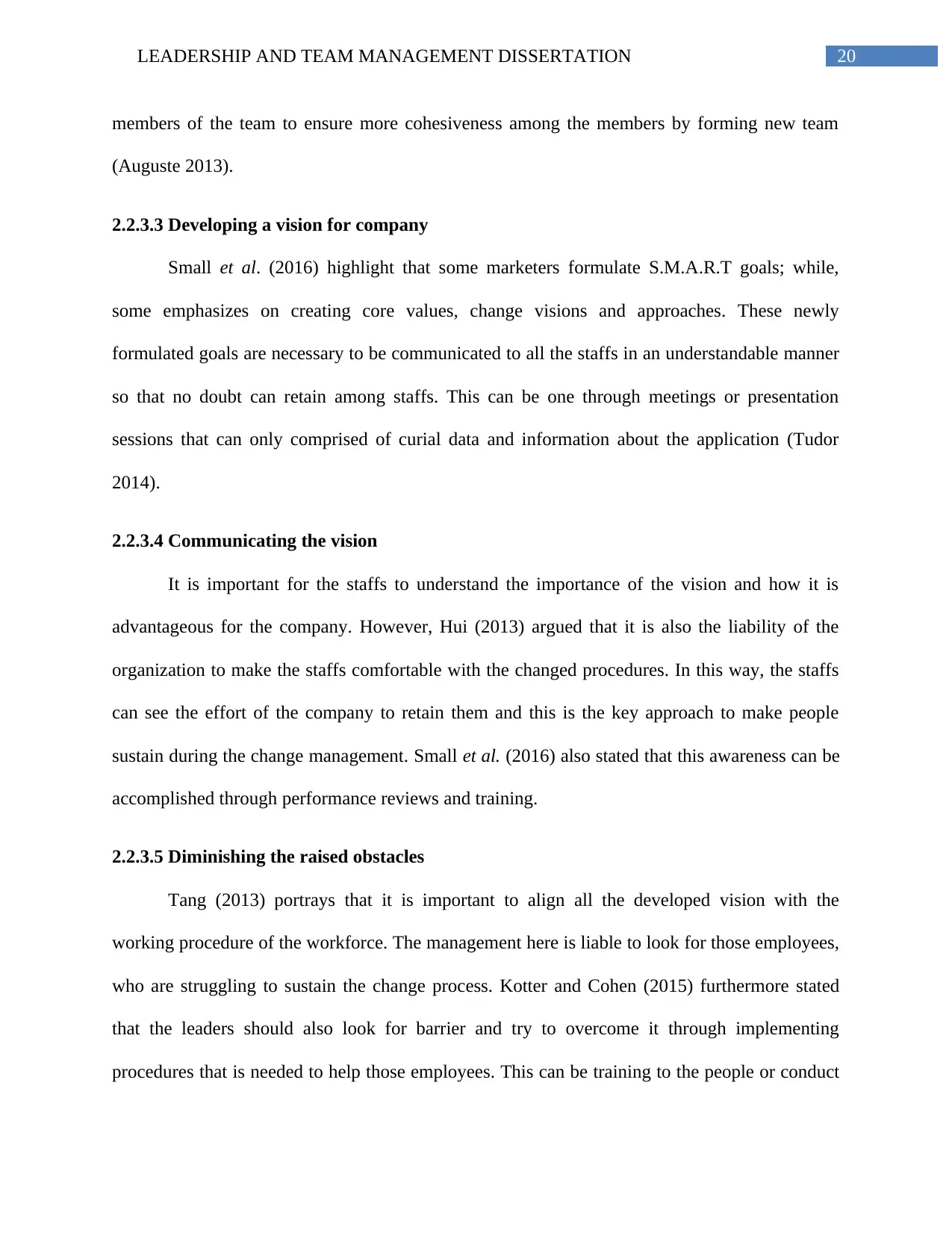
20LEADERSHIP AND TEAM MANAGEMENT DISSERTATION
members of the team to ensure more cohesiveness among the members by forming new team
(Auguste 2013).
2.2.3.3 Developing a vision for company
Small et al. (2016) highlight that some marketers formulate S.M.A.R.T goals; while,
some emphasizes on creating core values, change visions and approaches. These newly
formulated goals are necessary to be communicated to all the staffs in an understandable manner
so that no doubt can retain among staffs. This can be one through meetings or presentation
sessions that can only comprised of curial data and information about the application (Tudor
2014).
2.2.3.4 Communicating the vision
It is important for the staffs to understand the importance of the vision and how it is
advantageous for the company. However, Hui (2013) argued that it is also the liability of the
organization to make the staffs comfortable with the changed procedures. In this way, the staffs
can see the effort of the company to retain them and this is the key approach to make people
sustain during the change management. Small et al. (2016) also stated that this awareness can be
accomplished through performance reviews and training.
2.2.3.5 Diminishing the raised obstacles
Tang (2013) portrays that it is important to align all the developed vision with the
working procedure of the workforce. The management here is liable to look for those employees,
who are struggling to sustain the change process. Kotter and Cohen (2015) furthermore stated
that the leaders should also look for barrier and try to overcome it through implementing
procedures that is needed to help those employees. This can be training to the people or conduct
members of the team to ensure more cohesiveness among the members by forming new team
(Auguste 2013).
2.2.3.3 Developing a vision for company
Small et al. (2016) highlight that some marketers formulate S.M.A.R.T goals; while,
some emphasizes on creating core values, change visions and approaches. These newly
formulated goals are necessary to be communicated to all the staffs in an understandable manner
so that no doubt can retain among staffs. This can be one through meetings or presentation
sessions that can only comprised of curial data and information about the application (Tudor
2014).
2.2.3.4 Communicating the vision
It is important for the staffs to understand the importance of the vision and how it is
advantageous for the company. However, Hui (2013) argued that it is also the liability of the
organization to make the staffs comfortable with the changed procedures. In this way, the staffs
can see the effort of the company to retain them and this is the key approach to make people
sustain during the change management. Small et al. (2016) also stated that this awareness can be
accomplished through performance reviews and training.
2.2.3.5 Diminishing the raised obstacles
Tang (2013) portrays that it is important to align all the developed vision with the
working procedure of the workforce. The management here is liable to look for those employees,
who are struggling to sustain the change process. Kotter and Cohen (2015) furthermore stated
that the leaders should also look for barrier and try to overcome it through implementing
procedures that is needed to help those employees. This can be training to the people or conduct
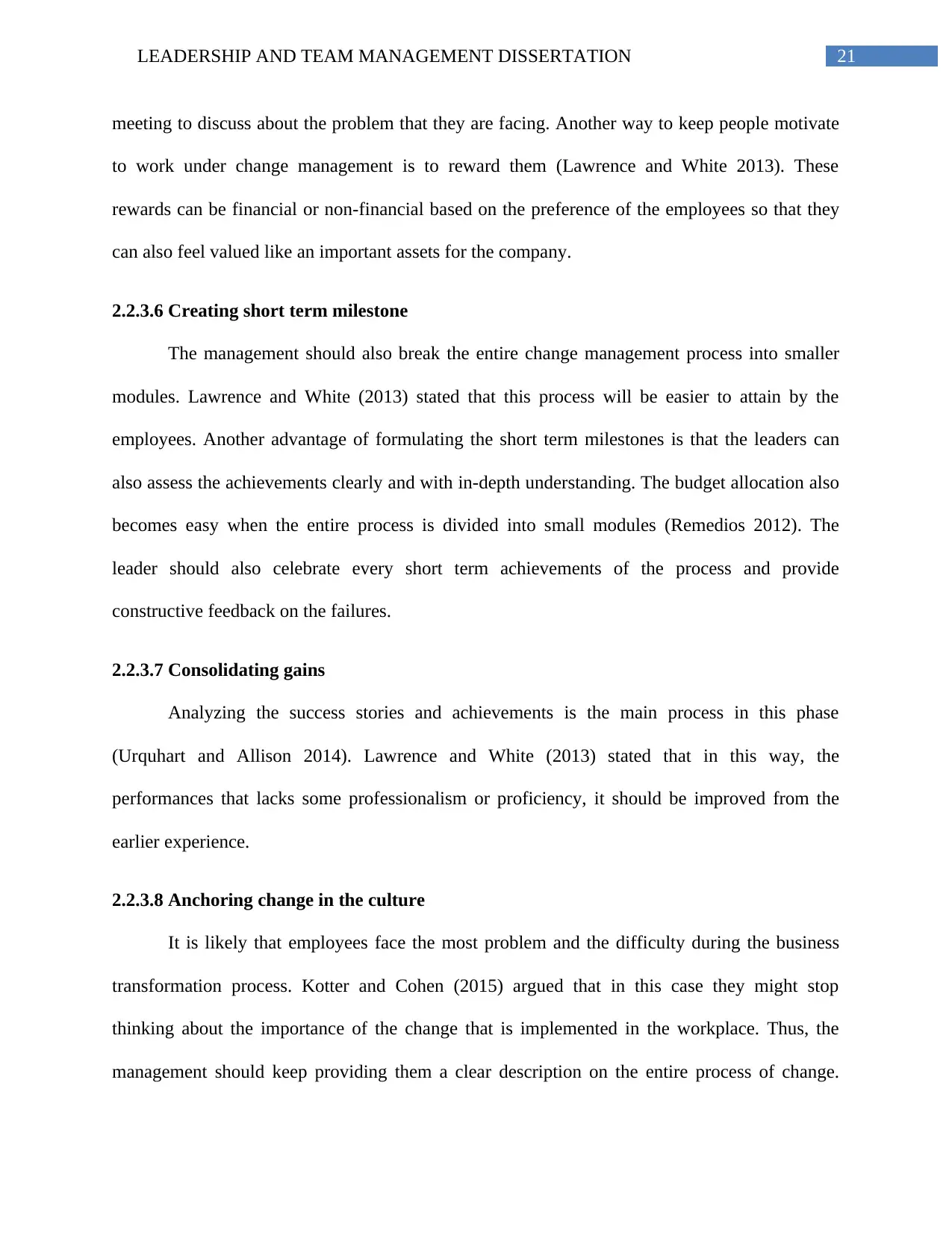
21LEADERSHIP AND TEAM MANAGEMENT DISSERTATION
meeting to discuss about the problem that they are facing. Another way to keep people motivate
to work under change management is to reward them (Lawrence and White 2013). These
rewards can be financial or non-financial based on the preference of the employees so that they
can also feel valued like an important assets for the company.
2.2.3.6 Creating short term milestone
The management should also break the entire change management process into smaller
modules. Lawrence and White (2013) stated that this process will be easier to attain by the
employees. Another advantage of formulating the short term milestones is that the leaders can
also assess the achievements clearly and with in-depth understanding. The budget allocation also
becomes easy when the entire process is divided into small modules (Remedios 2012). The
leader should also celebrate every short term achievements of the process and provide
constructive feedback on the failures.
2.2.3.7 Consolidating gains
Analyzing the success stories and achievements is the main process in this phase
(Urquhart and Allison 2014). Lawrence and White (2013) stated that in this way, the
performances that lacks some professionalism or proficiency, it should be improved from the
earlier experience.
2.2.3.8 Anchoring change in the culture
It is likely that employees face the most problem and the difficulty during the business
transformation process. Kotter and Cohen (2015) argued that in this case they might stop
thinking about the importance of the change that is implemented in the workplace. Thus, the
management should keep providing them a clear description on the entire process of change.
meeting to discuss about the problem that they are facing. Another way to keep people motivate
to work under change management is to reward them (Lawrence and White 2013). These
rewards can be financial or non-financial based on the preference of the employees so that they
can also feel valued like an important assets for the company.
2.2.3.6 Creating short term milestone
The management should also break the entire change management process into smaller
modules. Lawrence and White (2013) stated that this process will be easier to attain by the
employees. Another advantage of formulating the short term milestones is that the leaders can
also assess the achievements clearly and with in-depth understanding. The budget allocation also
becomes easy when the entire process is divided into small modules (Remedios 2012). The
leader should also celebrate every short term achievements of the process and provide
constructive feedback on the failures.
2.2.3.7 Consolidating gains
Analyzing the success stories and achievements is the main process in this phase
(Urquhart and Allison 2014). Lawrence and White (2013) stated that in this way, the
performances that lacks some professionalism or proficiency, it should be improved from the
earlier experience.
2.2.3.8 Anchoring change in the culture
It is likely that employees face the most problem and the difficulty during the business
transformation process. Kotter and Cohen (2015) argued that in this case they might stop
thinking about the importance of the change that is implemented in the workplace. Thus, the
management should keep providing them a clear description on the entire process of change.
Secure Best Marks with AI Grader
Need help grading? Try our AI Grader for instant feedback on your assignments.
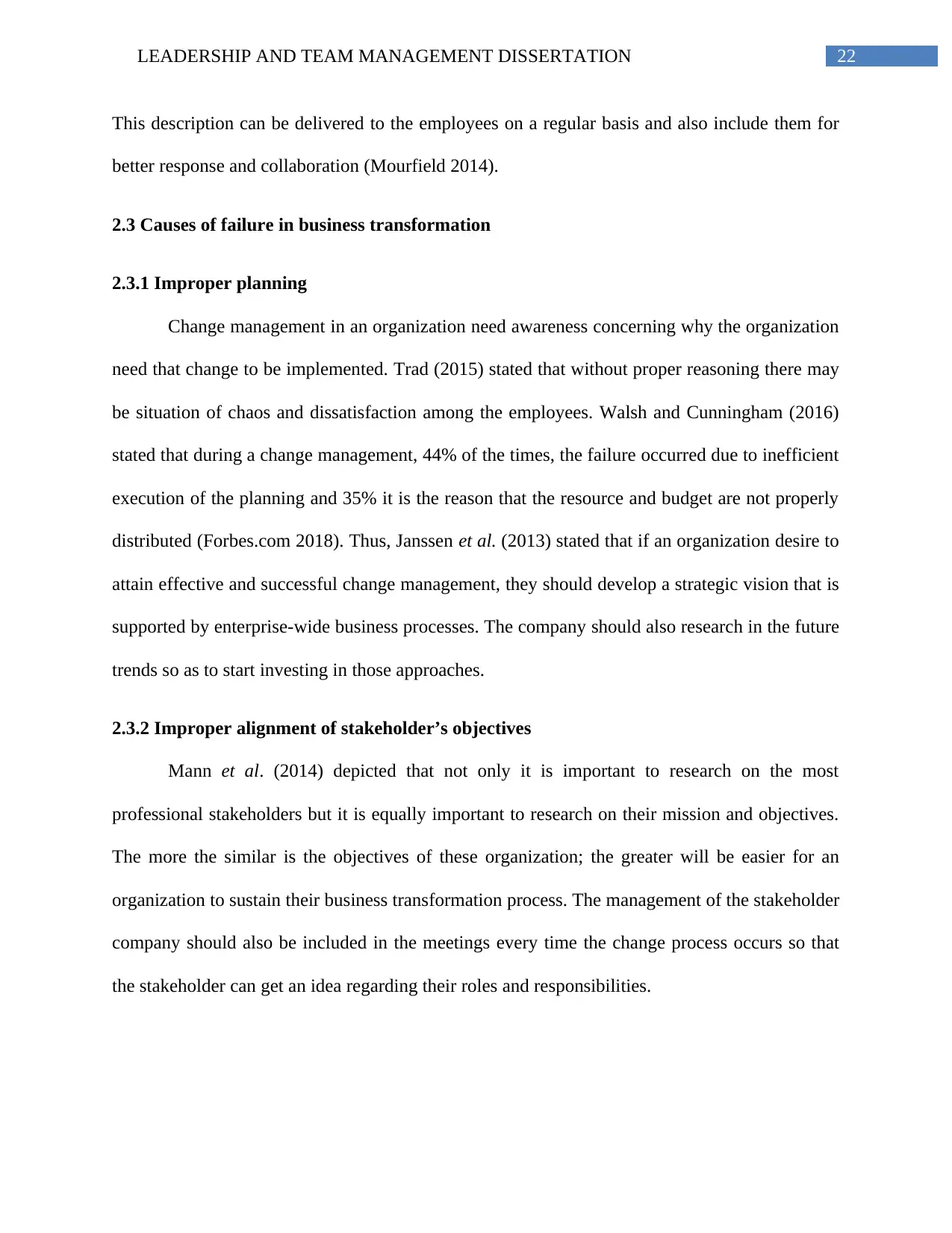
22LEADERSHIP AND TEAM MANAGEMENT DISSERTATION
This description can be delivered to the employees on a regular basis and also include them for
better response and collaboration (Mourfield 2014).
2.3 Causes of failure in business transformation
2.3.1 Improper planning
Change management in an organization need awareness concerning why the organization
need that change to be implemented. Trad (2015) stated that without proper reasoning there may
be situation of chaos and dissatisfaction among the employees. Walsh and Cunningham (2016)
stated that during a change management, 44% of the times, the failure occurred due to inefficient
execution of the planning and 35% it is the reason that the resource and budget are not properly
distributed (Forbes.com 2018). Thus, Janssen et al. (2013) stated that if an organization desire to
attain effective and successful change management, they should develop a strategic vision that is
supported by enterprise-wide business processes. The company should also research in the future
trends so as to start investing in those approaches.
2.3.2 Improper alignment of stakeholder’s objectives
Mann et al. (2014) depicted that not only it is important to research on the most
professional stakeholders but it is equally important to research on their mission and objectives.
The more the similar is the objectives of these organization; the greater will be easier for an
organization to sustain their business transformation process. The management of the stakeholder
company should also be included in the meetings every time the change process occurs so that
the stakeholder can get an idea regarding their roles and responsibilities.
This description can be delivered to the employees on a regular basis and also include them for
better response and collaboration (Mourfield 2014).
2.3 Causes of failure in business transformation
2.3.1 Improper planning
Change management in an organization need awareness concerning why the organization
need that change to be implemented. Trad (2015) stated that without proper reasoning there may
be situation of chaos and dissatisfaction among the employees. Walsh and Cunningham (2016)
stated that during a change management, 44% of the times, the failure occurred due to inefficient
execution of the planning and 35% it is the reason that the resource and budget are not properly
distributed (Forbes.com 2018). Thus, Janssen et al. (2013) stated that if an organization desire to
attain effective and successful change management, they should develop a strategic vision that is
supported by enterprise-wide business processes. The company should also research in the future
trends so as to start investing in those approaches.
2.3.2 Improper alignment of stakeholder’s objectives
Mann et al. (2014) depicted that not only it is important to research on the most
professional stakeholders but it is equally important to research on their mission and objectives.
The more the similar is the objectives of these organization; the greater will be easier for an
organization to sustain their business transformation process. The management of the stakeholder
company should also be included in the meetings every time the change process occurs so that
the stakeholder can get an idea regarding their roles and responsibilities.
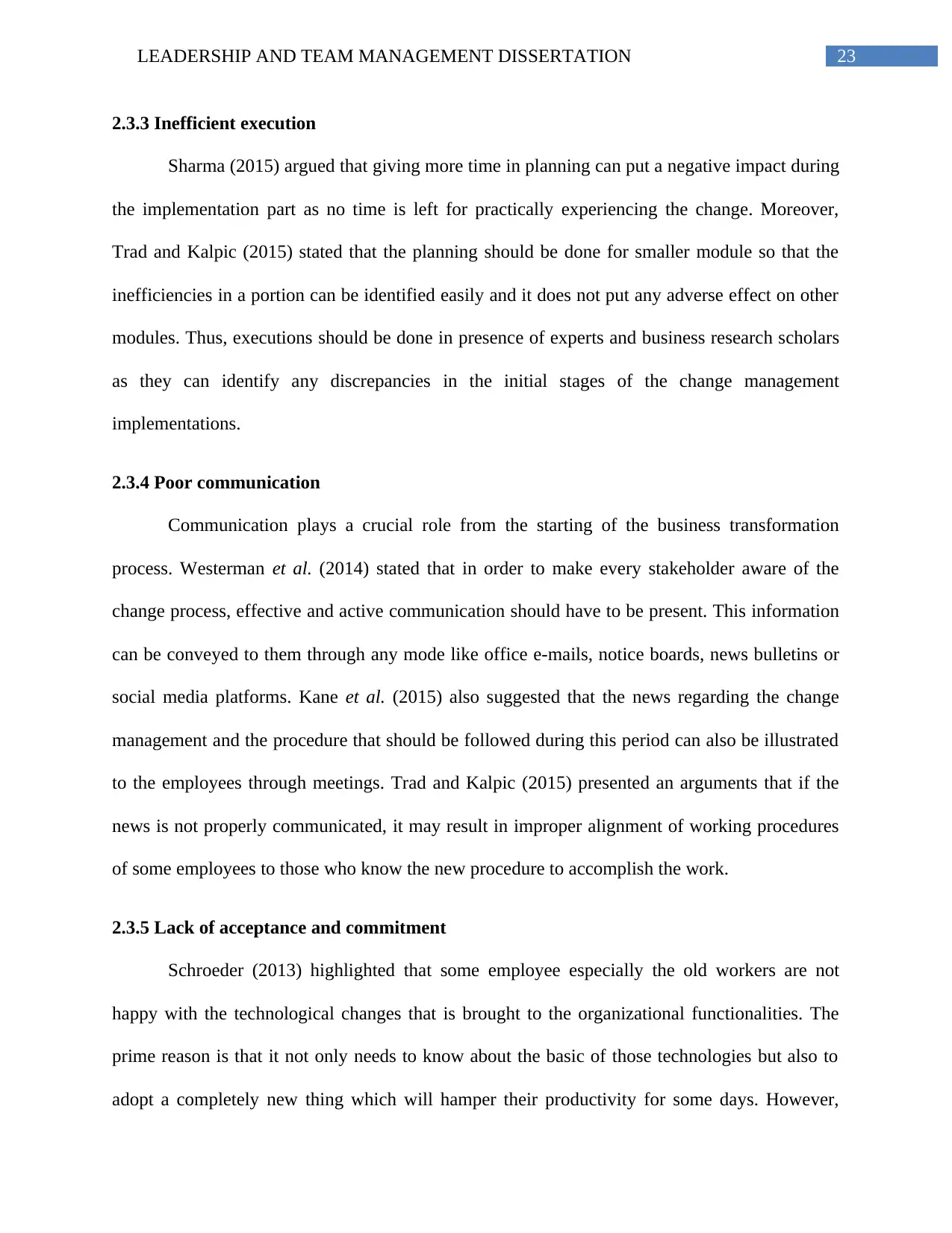
23LEADERSHIP AND TEAM MANAGEMENT DISSERTATION
2.3.3 Inefficient execution
Sharma (2015) argued that giving more time in planning can put a negative impact during
the implementation part as no time is left for practically experiencing the change. Moreover,
Trad and Kalpic (2015) stated that the planning should be done for smaller module so that the
inefficiencies in a portion can be identified easily and it does not put any adverse effect on other
modules. Thus, executions should be done in presence of experts and business research scholars
as they can identify any discrepancies in the initial stages of the change management
implementations.
2.3.4 Poor communication
Communication plays a crucial role from the starting of the business transformation
process. Westerman et al. (2014) stated that in order to make every stakeholder aware of the
change process, effective and active communication should have to be present. This information
can be conveyed to them through any mode like office e-mails, notice boards, news bulletins or
social media platforms. Kane et al. (2015) also suggested that the news regarding the change
management and the procedure that should be followed during this period can also be illustrated
to the employees through meetings. Trad and Kalpic (2015) presented an arguments that if the
news is not properly communicated, it may result in improper alignment of working procedures
of some employees to those who know the new procedure to accomplish the work.
2.3.5 Lack of acceptance and commitment
Schroeder (2013) highlighted that some employee especially the old workers are not
happy with the technological changes that is brought to the organizational functionalities. The
prime reason is that it not only needs to know about the basic of those technologies but also to
adopt a completely new thing which will hamper their productivity for some days. However,
2.3.3 Inefficient execution
Sharma (2015) argued that giving more time in planning can put a negative impact during
the implementation part as no time is left for practically experiencing the change. Moreover,
Trad and Kalpic (2015) stated that the planning should be done for smaller module so that the
inefficiencies in a portion can be identified easily and it does not put any adverse effect on other
modules. Thus, executions should be done in presence of experts and business research scholars
as they can identify any discrepancies in the initial stages of the change management
implementations.
2.3.4 Poor communication
Communication plays a crucial role from the starting of the business transformation
process. Westerman et al. (2014) stated that in order to make every stakeholder aware of the
change process, effective and active communication should have to be present. This information
can be conveyed to them through any mode like office e-mails, notice boards, news bulletins or
social media platforms. Kane et al. (2015) also suggested that the news regarding the change
management and the procedure that should be followed during this period can also be illustrated
to the employees through meetings. Trad and Kalpic (2015) presented an arguments that if the
news is not properly communicated, it may result in improper alignment of working procedures
of some employees to those who know the new procedure to accomplish the work.
2.3.5 Lack of acceptance and commitment
Schroeder (2013) highlighted that some employee especially the old workers are not
happy with the technological changes that is brought to the organizational functionalities. The
prime reason is that it not only needs to know about the basic of those technologies but also to
adopt a completely new thing which will hamper their productivity for some days. However,
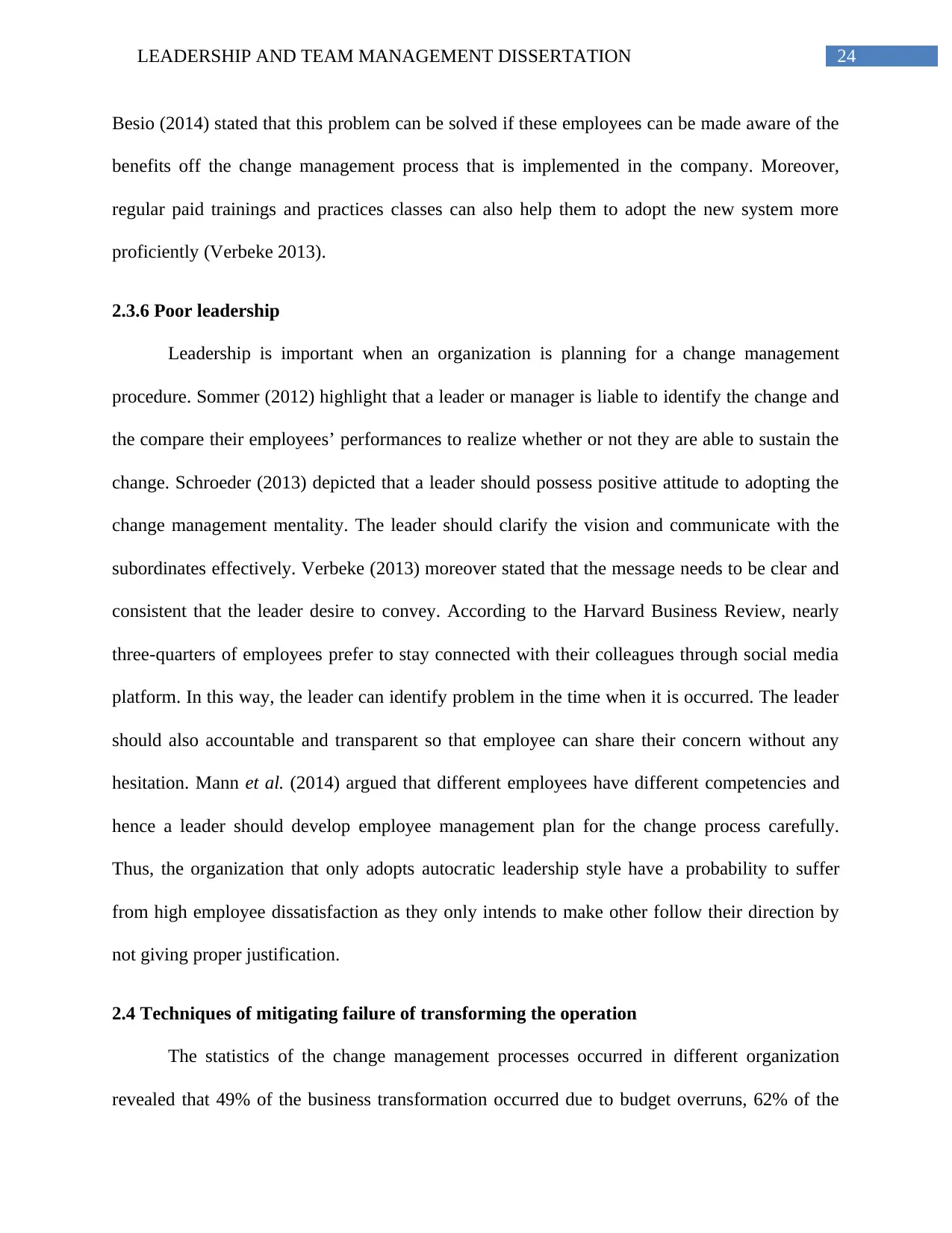
24LEADERSHIP AND TEAM MANAGEMENT DISSERTATION
Besio (2014) stated that this problem can be solved if these employees can be made aware of the
benefits off the change management process that is implemented in the company. Moreover,
regular paid trainings and practices classes can also help them to adopt the new system more
proficiently (Verbeke 2013).
2.3.6 Poor leadership
Leadership is important when an organization is planning for a change management
procedure. Sommer (2012) highlight that a leader or manager is liable to identify the change and
the compare their employees’ performances to realize whether or not they are able to sustain the
change. Schroeder (2013) depicted that a leader should possess positive attitude to adopting the
change management mentality. The leader should clarify the vision and communicate with the
subordinates effectively. Verbeke (2013) moreover stated that the message needs to be clear and
consistent that the leader desire to convey. According to the Harvard Business Review, nearly
three-quarters of employees prefer to stay connected with their colleagues through social media
platform. In this way, the leader can identify problem in the time when it is occurred. The leader
should also accountable and transparent so that employee can share their concern without any
hesitation. Mann et al. (2014) argued that different employees have different competencies and
hence a leader should develop employee management plan for the change process carefully.
Thus, the organization that only adopts autocratic leadership style have a probability to suffer
from high employee dissatisfaction as they only intends to make other follow their direction by
not giving proper justification.
2.4 Techniques of mitigating failure of transforming the operation
The statistics of the change management processes occurred in different organization
revealed that 49% of the business transformation occurred due to budget overruns, 62% of the
Besio (2014) stated that this problem can be solved if these employees can be made aware of the
benefits off the change management process that is implemented in the company. Moreover,
regular paid trainings and practices classes can also help them to adopt the new system more
proficiently (Verbeke 2013).
2.3.6 Poor leadership
Leadership is important when an organization is planning for a change management
procedure. Sommer (2012) highlight that a leader or manager is liable to identify the change and
the compare their employees’ performances to realize whether or not they are able to sustain the
change. Schroeder (2013) depicted that a leader should possess positive attitude to adopting the
change management mentality. The leader should clarify the vision and communicate with the
subordinates effectively. Verbeke (2013) moreover stated that the message needs to be clear and
consistent that the leader desire to convey. According to the Harvard Business Review, nearly
three-quarters of employees prefer to stay connected with their colleagues through social media
platform. In this way, the leader can identify problem in the time when it is occurred. The leader
should also accountable and transparent so that employee can share their concern without any
hesitation. Mann et al. (2014) argued that different employees have different competencies and
hence a leader should develop employee management plan for the change process carefully.
Thus, the organization that only adopts autocratic leadership style have a probability to suffer
from high employee dissatisfaction as they only intends to make other follow their direction by
not giving proper justification.
2.4 Techniques of mitigating failure of transforming the operation
The statistics of the change management processes occurred in different organization
revealed that 49% of the business transformation occurred due to budget overruns, 62% of the
Paraphrase This Document
Need a fresh take? Get an instant paraphrase of this document with our AI Paraphraser
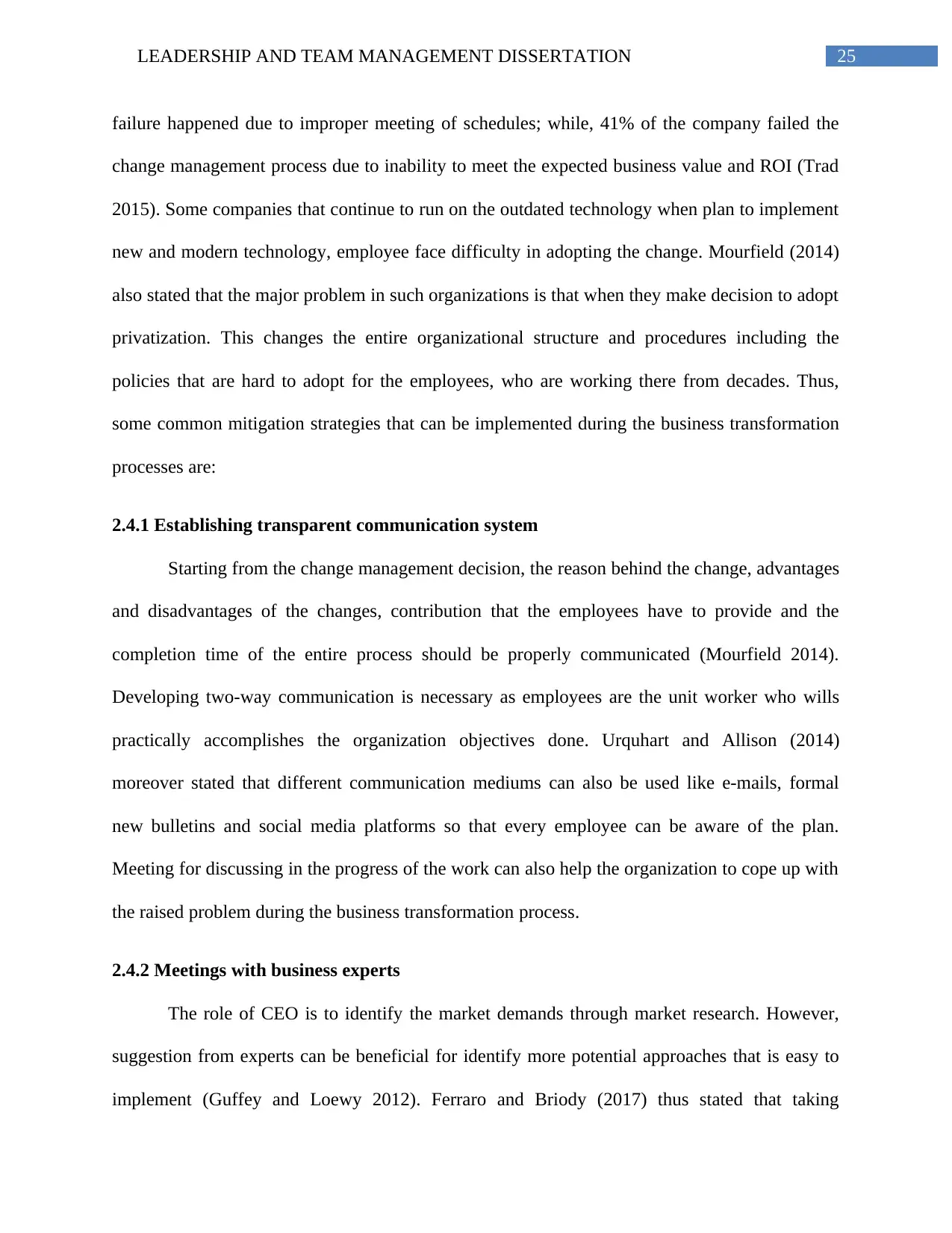
25LEADERSHIP AND TEAM MANAGEMENT DISSERTATION
failure happened due to improper meeting of schedules; while, 41% of the company failed the
change management process due to inability to meet the expected business value and ROI (Trad
2015). Some companies that continue to run on the outdated technology when plan to implement
new and modern technology, employee face difficulty in adopting the change. Mourfield (2014)
also stated that the major problem in such organizations is that when they make decision to adopt
privatization. This changes the entire organizational structure and procedures including the
policies that are hard to adopt for the employees, who are working there from decades. Thus,
some common mitigation strategies that can be implemented during the business transformation
processes are:
2.4.1 Establishing transparent communication system
Starting from the change management decision, the reason behind the change, advantages
and disadvantages of the changes, contribution that the employees have to provide and the
completion time of the entire process should be properly communicated (Mourfield 2014).
Developing two-way communication is necessary as employees are the unit worker who wills
practically accomplishes the organization objectives done. Urquhart and Allison (2014)
moreover stated that different communication mediums can also be used like e-mails, formal
new bulletins and social media platforms so that every employee can be aware of the plan.
Meeting for discussing in the progress of the work can also help the organization to cope up with
the raised problem during the business transformation process.
2.4.2 Meetings with business experts
The role of CEO is to identify the market demands through market research. However,
suggestion from experts can be beneficial for identify more potential approaches that is easy to
implement (Guffey and Loewy 2012). Ferraro and Briody (2017) thus stated that taking
failure happened due to improper meeting of schedules; while, 41% of the company failed the
change management process due to inability to meet the expected business value and ROI (Trad
2015). Some companies that continue to run on the outdated technology when plan to implement
new and modern technology, employee face difficulty in adopting the change. Mourfield (2014)
also stated that the major problem in such organizations is that when they make decision to adopt
privatization. This changes the entire organizational structure and procedures including the
policies that are hard to adopt for the employees, who are working there from decades. Thus,
some common mitigation strategies that can be implemented during the business transformation
processes are:
2.4.1 Establishing transparent communication system
Starting from the change management decision, the reason behind the change, advantages
and disadvantages of the changes, contribution that the employees have to provide and the
completion time of the entire process should be properly communicated (Mourfield 2014).
Developing two-way communication is necessary as employees are the unit worker who wills
practically accomplishes the organization objectives done. Urquhart and Allison (2014)
moreover stated that different communication mediums can also be used like e-mails, formal
new bulletins and social media platforms so that every employee can be aware of the plan.
Meeting for discussing in the progress of the work can also help the organization to cope up with
the raised problem during the business transformation process.
2.4.2 Meetings with business experts
The role of CEO is to identify the market demands through market research. However,
suggestion from experts can be beneficial for identify more potential approaches that is easy to
implement (Guffey and Loewy 2012). Ferraro and Briody (2017) thus stated that taking
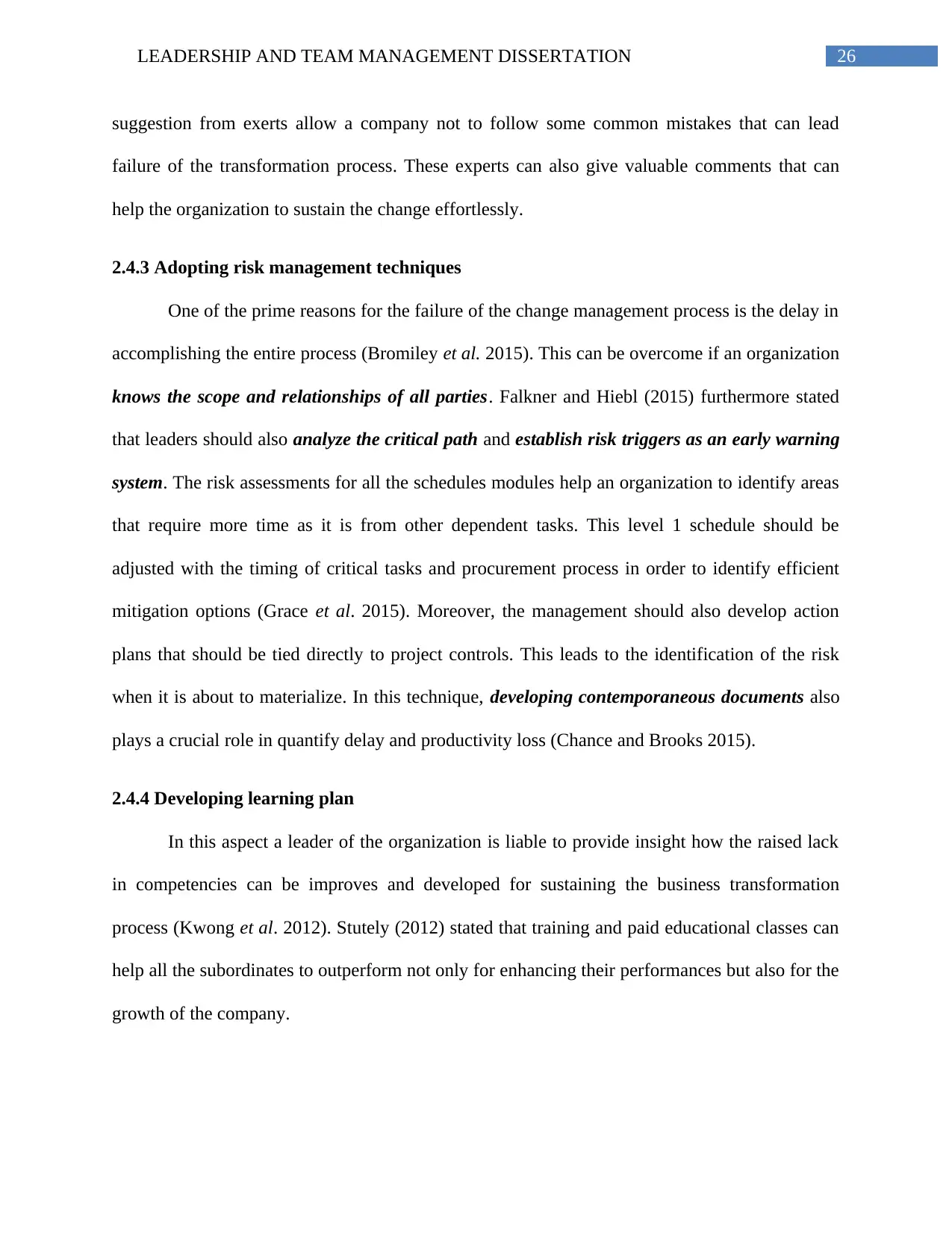
26LEADERSHIP AND TEAM MANAGEMENT DISSERTATION
suggestion from exerts allow a company not to follow some common mistakes that can lead
failure of the transformation process. These experts can also give valuable comments that can
help the organization to sustain the change effortlessly.
2.4.3 Adopting risk management techniques
One of the prime reasons for the failure of the change management process is the delay in
accomplishing the entire process (Bromiley et al. 2015). This can be overcome if an organization
knows the scope and relationships of all parties. Falkner and Hiebl (2015) furthermore stated
that leaders should also analyze the critical path and establish risk triggers as an early warning
system. The risk assessments for all the schedules modules help an organization to identify areas
that require more time as it is from other dependent tasks. This level 1 schedule should be
adjusted with the timing of critical tasks and procurement process in order to identify efficient
mitigation options (Grace et al. 2015). Moreover, the management should also develop action
plans that should be tied directly to project controls. This leads to the identification of the risk
when it is about to materialize. In this technique, developing contemporaneous documents also
plays a crucial role in quantify delay and productivity loss (Chance and Brooks 2015).
2.4.4 Developing learning plan
In this aspect a leader of the organization is liable to provide insight how the raised lack
in competencies can be improves and developed for sustaining the business transformation
process (Kwong et al. 2012). Stutely (2012) stated that training and paid educational classes can
help all the subordinates to outperform not only for enhancing their performances but also for the
growth of the company.
suggestion from exerts allow a company not to follow some common mistakes that can lead
failure of the transformation process. These experts can also give valuable comments that can
help the organization to sustain the change effortlessly.
2.4.3 Adopting risk management techniques
One of the prime reasons for the failure of the change management process is the delay in
accomplishing the entire process (Bromiley et al. 2015). This can be overcome if an organization
knows the scope and relationships of all parties. Falkner and Hiebl (2015) furthermore stated
that leaders should also analyze the critical path and establish risk triggers as an early warning
system. The risk assessments for all the schedules modules help an organization to identify areas
that require more time as it is from other dependent tasks. This level 1 schedule should be
adjusted with the timing of critical tasks and procurement process in order to identify efficient
mitigation options (Grace et al. 2015). Moreover, the management should also develop action
plans that should be tied directly to project controls. This leads to the identification of the risk
when it is about to materialize. In this technique, developing contemporaneous documents also
plays a crucial role in quantify delay and productivity loss (Chance and Brooks 2015).
2.4.4 Developing learning plan
In this aspect a leader of the organization is liable to provide insight how the raised lack
in competencies can be improves and developed for sustaining the business transformation
process (Kwong et al. 2012). Stutely (2012) stated that training and paid educational classes can
help all the subordinates to outperform not only for enhancing their performances but also for the
growth of the company.
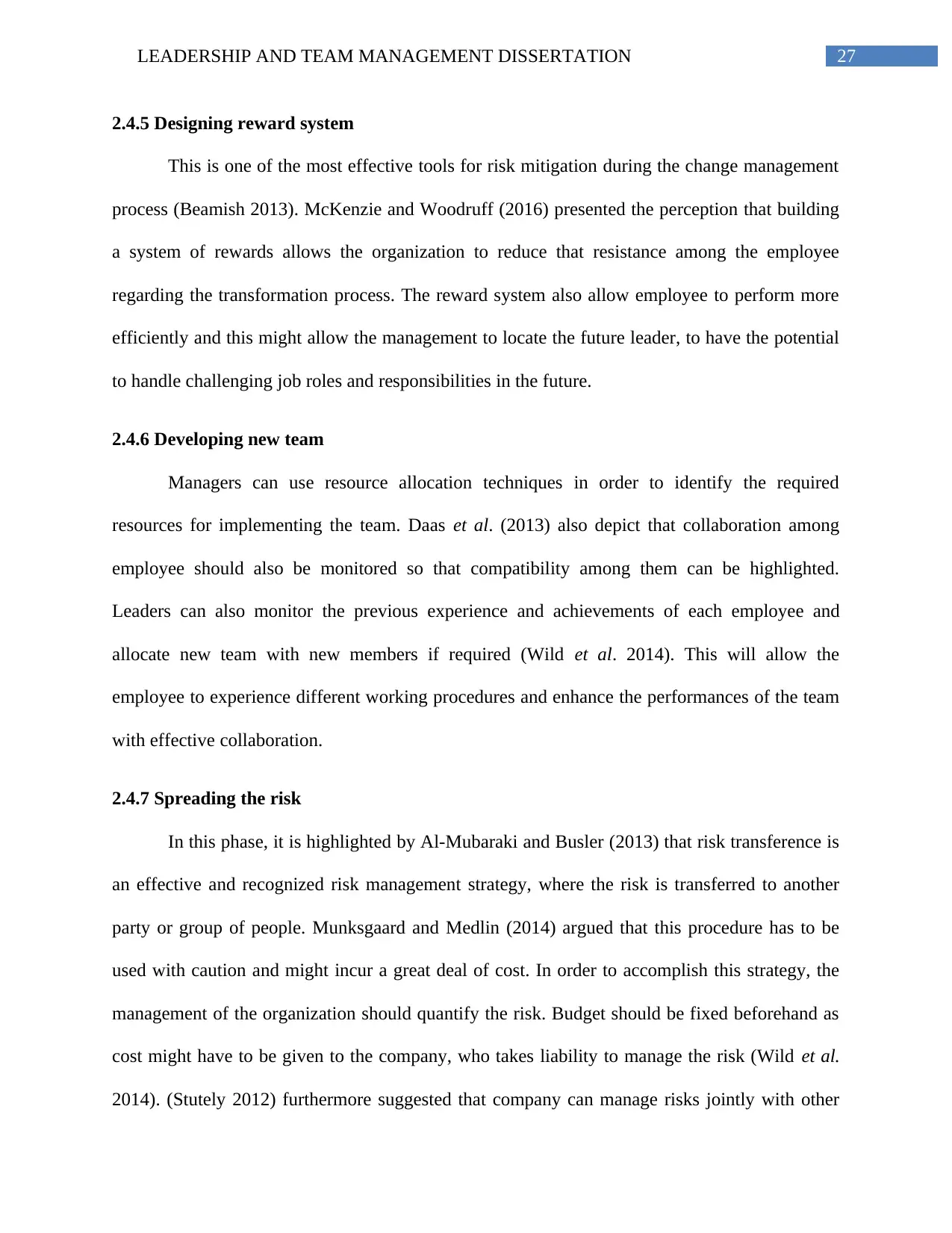
27LEADERSHIP AND TEAM MANAGEMENT DISSERTATION
2.4.5 Designing reward system
This is one of the most effective tools for risk mitigation during the change management
process (Beamish 2013). McKenzie and Woodruff (2016) presented the perception that building
a system of rewards allows the organization to reduce that resistance among the employee
regarding the transformation process. The reward system also allow employee to perform more
efficiently and this might allow the management to locate the future leader, to have the potential
to handle challenging job roles and responsibilities in the future.
2.4.6 Developing new team
Managers can use resource allocation techniques in order to identify the required
resources for implementing the team. Daas et al. (2013) also depict that collaboration among
employee should also be monitored so that compatibility among them can be highlighted.
Leaders can also monitor the previous experience and achievements of each employee and
allocate new team with new members if required (Wild et al. 2014). This will allow the
employee to experience different working procedures and enhance the performances of the team
with effective collaboration.
2.4.7 Spreading the risk
In this phase, it is highlighted by Al-Mubaraki and Busler (2013) that risk transference is
an effective and recognized risk management strategy, where the risk is transferred to another
party or group of people. Munksgaard and Medlin (2014) argued that this procedure has to be
used with caution and might incur a great deal of cost. In order to accomplish this strategy, the
management of the organization should quantify the risk. Budget should be fixed beforehand as
cost might have to be given to the company, who takes liability to manage the risk (Wild et al.
2014). (Stutely 2012) furthermore suggested that company can manage risks jointly with other
2.4.5 Designing reward system
This is one of the most effective tools for risk mitigation during the change management
process (Beamish 2013). McKenzie and Woodruff (2016) presented the perception that building
a system of rewards allows the organization to reduce that resistance among the employee
regarding the transformation process. The reward system also allow employee to perform more
efficiently and this might allow the management to locate the future leader, to have the potential
to handle challenging job roles and responsibilities in the future.
2.4.6 Developing new team
Managers can use resource allocation techniques in order to identify the required
resources for implementing the team. Daas et al. (2013) also depict that collaboration among
employee should also be monitored so that compatibility among them can be highlighted.
Leaders can also monitor the previous experience and achievements of each employee and
allocate new team with new members if required (Wild et al. 2014). This will allow the
employee to experience different working procedures and enhance the performances of the team
with effective collaboration.
2.4.7 Spreading the risk
In this phase, it is highlighted by Al-Mubaraki and Busler (2013) that risk transference is
an effective and recognized risk management strategy, where the risk is transferred to another
party or group of people. Munksgaard and Medlin (2014) argued that this procedure has to be
used with caution and might incur a great deal of cost. In order to accomplish this strategy, the
management of the organization should quantify the risk. Budget should be fixed beforehand as
cost might have to be given to the company, who takes liability to manage the risk (Wild et al.
2014). (Stutely 2012) furthermore suggested that company can manage risks jointly with other
Secure Best Marks with AI Grader
Need help grading? Try our AI Grader for instant feedback on your assignments.
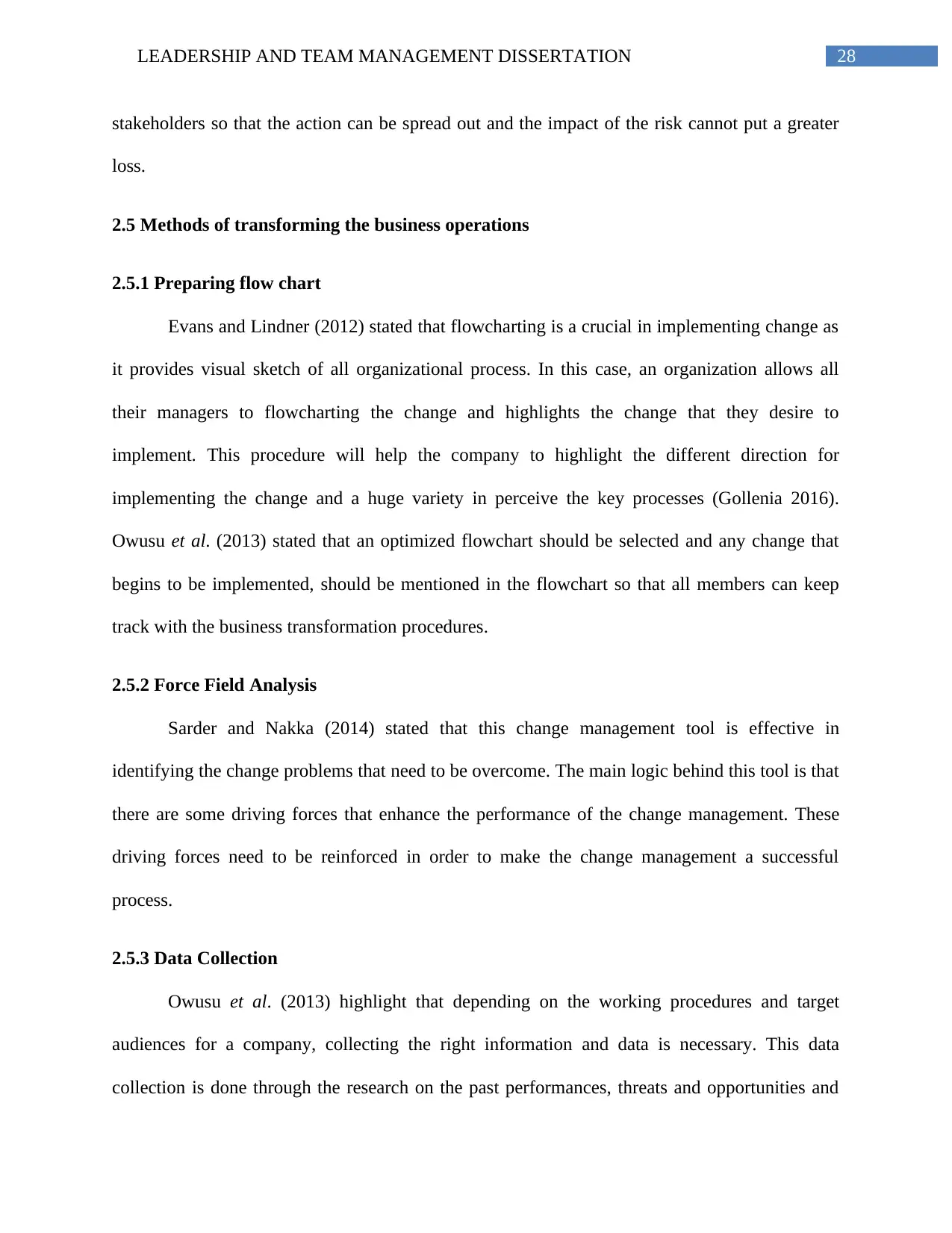
28LEADERSHIP AND TEAM MANAGEMENT DISSERTATION
stakeholders so that the action can be spread out and the impact of the risk cannot put a greater
loss.
2.5 Methods of transforming the business operations
2.5.1 Preparing flow chart
Evans and Lindner (2012) stated that flowcharting is a crucial in implementing change as
it provides visual sketch of all organizational process. In this case, an organization allows all
their managers to flowcharting the change and highlights the change that they desire to
implement. This procedure will help the company to highlight the different direction for
implementing the change and a huge variety in perceive the key processes (Gollenia 2016).
Owusu et al. (2013) stated that an optimized flowchart should be selected and any change that
begins to be implemented, should be mentioned in the flowchart so that all members can keep
track with the business transformation procedures.
2.5.2 Force Field Analysis
Sarder and Nakka (2014) stated that this change management tool is effective in
identifying the change problems that need to be overcome. The main logic behind this tool is that
there are some driving forces that enhance the performance of the change management. These
driving forces need to be reinforced in order to make the change management a successful
process.
2.5.3 Data Collection
Owusu et al. (2013) highlight that depending on the working procedures and target
audiences for a company, collecting the right information and data is necessary. This data
collection is done through the research on the past performances, threats and opportunities and
stakeholders so that the action can be spread out and the impact of the risk cannot put a greater
loss.
2.5 Methods of transforming the business operations
2.5.1 Preparing flow chart
Evans and Lindner (2012) stated that flowcharting is a crucial in implementing change as
it provides visual sketch of all organizational process. In this case, an organization allows all
their managers to flowcharting the change and highlights the change that they desire to
implement. This procedure will help the company to highlight the different direction for
implementing the change and a huge variety in perceive the key processes (Gollenia 2016).
Owusu et al. (2013) stated that an optimized flowchart should be selected and any change that
begins to be implemented, should be mentioned in the flowchart so that all members can keep
track with the business transformation procedures.
2.5.2 Force Field Analysis
Sarder and Nakka (2014) stated that this change management tool is effective in
identifying the change problems that need to be overcome. The main logic behind this tool is that
there are some driving forces that enhance the performance of the change management. These
driving forces need to be reinforced in order to make the change management a successful
process.
2.5.3 Data Collection
Owusu et al. (2013) highlight that depending on the working procedures and target
audiences for a company, collecting the right information and data is necessary. This data
collection is done through the research on the past performances, threats and opportunities and
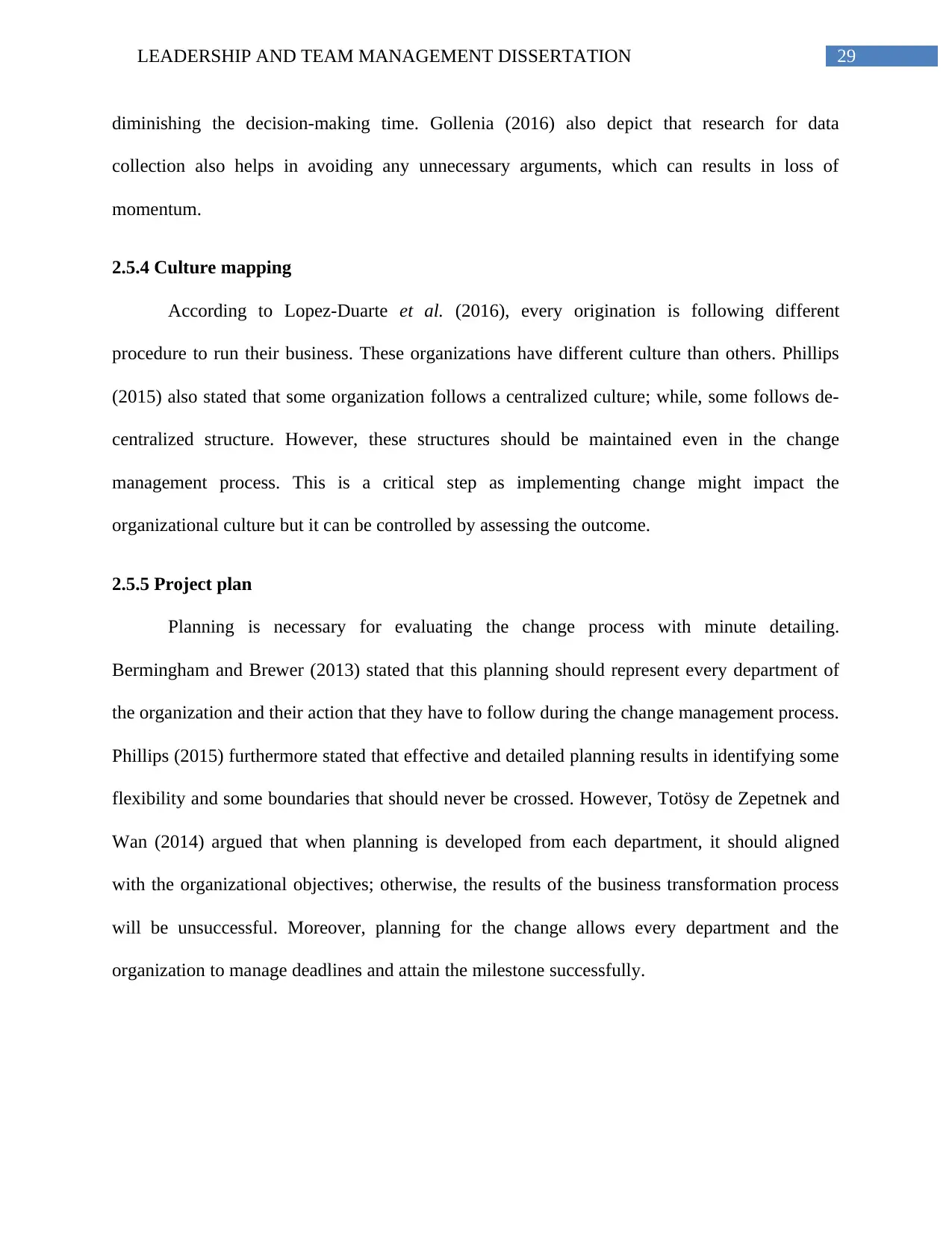
29LEADERSHIP AND TEAM MANAGEMENT DISSERTATION
diminishing the decision-making time. Gollenia (2016) also depict that research for data
collection also helps in avoiding any unnecessary arguments, which can results in loss of
momentum.
2.5.4 Culture mapping
According to Lopez-Duarte et al. (2016), every origination is following different
procedure to run their business. These organizations have different culture than others. Phillips
(2015) also stated that some organization follows a centralized culture; while, some follows de-
centralized structure. However, these structures should be maintained even in the change
management process. This is a critical step as implementing change might impact the
organizational culture but it can be controlled by assessing the outcome.
2.5.5 Project plan
Planning is necessary for evaluating the change process with minute detailing.
Bermingham and Brewer (2013) stated that this planning should represent every department of
the organization and their action that they have to follow during the change management process.
Phillips (2015) furthermore stated that effective and detailed planning results in identifying some
flexibility and some boundaries that should never be crossed. However, Totösy de Zepetnek and
Wan (2014) argued that when planning is developed from each department, it should aligned
with the organizational objectives; otherwise, the results of the business transformation process
will be unsuccessful. Moreover, planning for the change allows every department and the
organization to manage deadlines and attain the milestone successfully.
diminishing the decision-making time. Gollenia (2016) also depict that research for data
collection also helps in avoiding any unnecessary arguments, which can results in loss of
momentum.
2.5.4 Culture mapping
According to Lopez-Duarte et al. (2016), every origination is following different
procedure to run their business. These organizations have different culture than others. Phillips
(2015) also stated that some organization follows a centralized culture; while, some follows de-
centralized structure. However, these structures should be maintained even in the change
management process. This is a critical step as implementing change might impact the
organizational culture but it can be controlled by assessing the outcome.
2.5.5 Project plan
Planning is necessary for evaluating the change process with minute detailing.
Bermingham and Brewer (2013) stated that this planning should represent every department of
the organization and their action that they have to follow during the change management process.
Phillips (2015) furthermore stated that effective and detailed planning results in identifying some
flexibility and some boundaries that should never be crossed. However, Totösy de Zepetnek and
Wan (2014) argued that when planning is developed from each department, it should aligned
with the organizational objectives; otherwise, the results of the business transformation process
will be unsuccessful. Moreover, planning for the change allows every department and the
organization to manage deadlines and attain the milestone successfully.
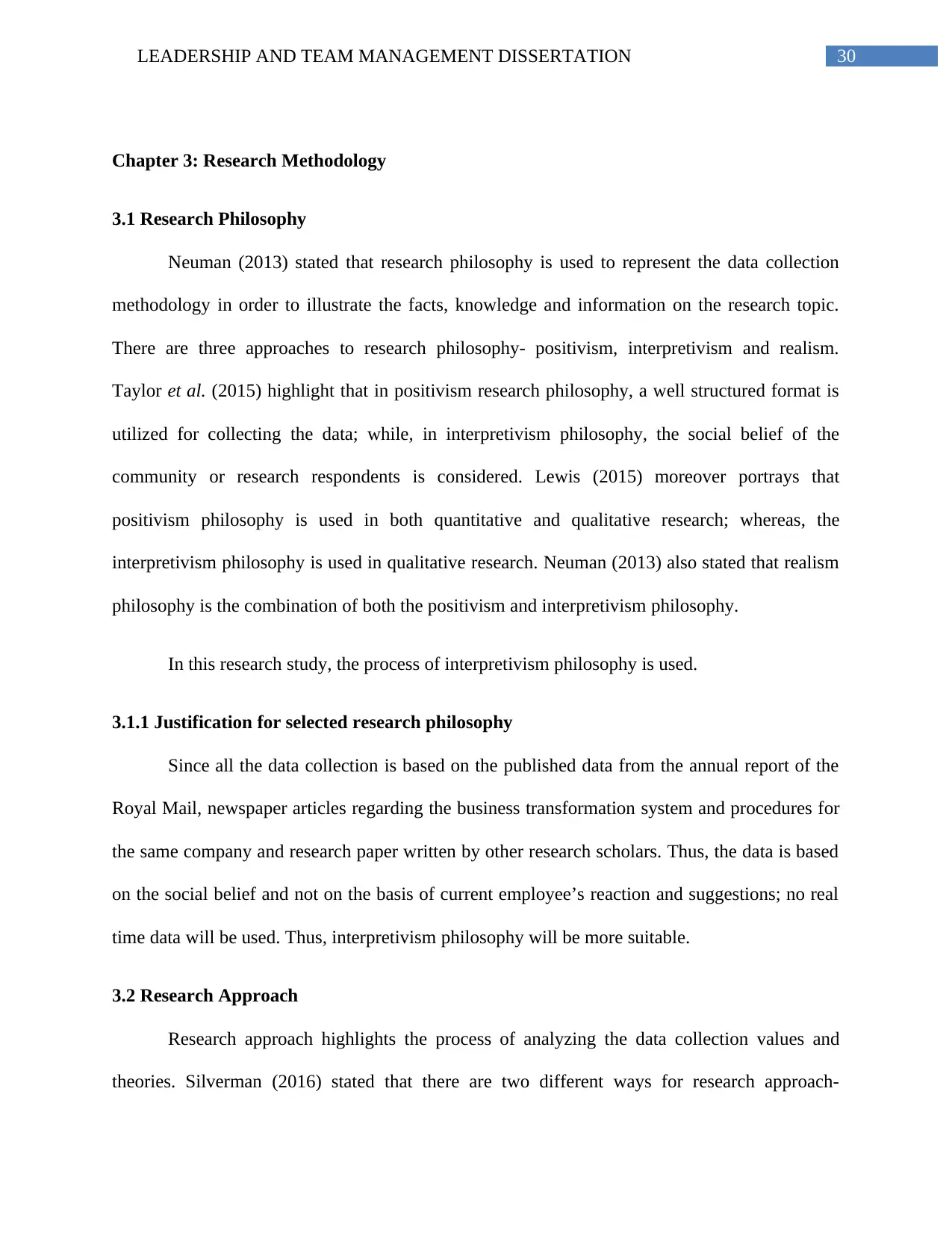
30LEADERSHIP AND TEAM MANAGEMENT DISSERTATION
Chapter 3: Research Methodology
3.1 Research Philosophy
Neuman (2013) stated that research philosophy is used to represent the data collection
methodology in order to illustrate the facts, knowledge and information on the research topic.
There are three approaches to research philosophy- positivism, interpretivism and realism.
Taylor et al. (2015) highlight that in positivism research philosophy, a well structured format is
utilized for collecting the data; while, in interpretivism philosophy, the social belief of the
community or research respondents is considered. Lewis (2015) moreover portrays that
positivism philosophy is used in both quantitative and qualitative research; whereas, the
interpretivism philosophy is used in qualitative research. Neuman (2013) also stated that realism
philosophy is the combination of both the positivism and interpretivism philosophy.
In this research study, the process of interpretivism philosophy is used.
3.1.1 Justification for selected research philosophy
Since all the data collection is based on the published data from the annual report of the
Royal Mail, newspaper articles regarding the business transformation system and procedures for
the same company and research paper written by other research scholars. Thus, the data is based
on the social belief and not on the basis of current employee’s reaction and suggestions; no real
time data will be used. Thus, interpretivism philosophy will be more suitable.
3.2 Research Approach
Research approach highlights the process of analyzing the data collection values and
theories. Silverman (2016) stated that there are two different ways for research approach-
Chapter 3: Research Methodology
3.1 Research Philosophy
Neuman (2013) stated that research philosophy is used to represent the data collection
methodology in order to illustrate the facts, knowledge and information on the research topic.
There are three approaches to research philosophy- positivism, interpretivism and realism.
Taylor et al. (2015) highlight that in positivism research philosophy, a well structured format is
utilized for collecting the data; while, in interpretivism philosophy, the social belief of the
community or research respondents is considered. Lewis (2015) moreover portrays that
positivism philosophy is used in both quantitative and qualitative research; whereas, the
interpretivism philosophy is used in qualitative research. Neuman (2013) also stated that realism
philosophy is the combination of both the positivism and interpretivism philosophy.
In this research study, the process of interpretivism philosophy is used.
3.1.1 Justification for selected research philosophy
Since all the data collection is based on the published data from the annual report of the
Royal Mail, newspaper articles regarding the business transformation system and procedures for
the same company and research paper written by other research scholars. Thus, the data is based
on the social belief and not on the basis of current employee’s reaction and suggestions; no real
time data will be used. Thus, interpretivism philosophy will be more suitable.
3.2 Research Approach
Research approach highlights the process of analyzing the data collection values and
theories. Silverman (2016) stated that there are two different ways for research approach-
Paraphrase This Document
Need a fresh take? Get an instant paraphrase of this document with our AI Paraphraser
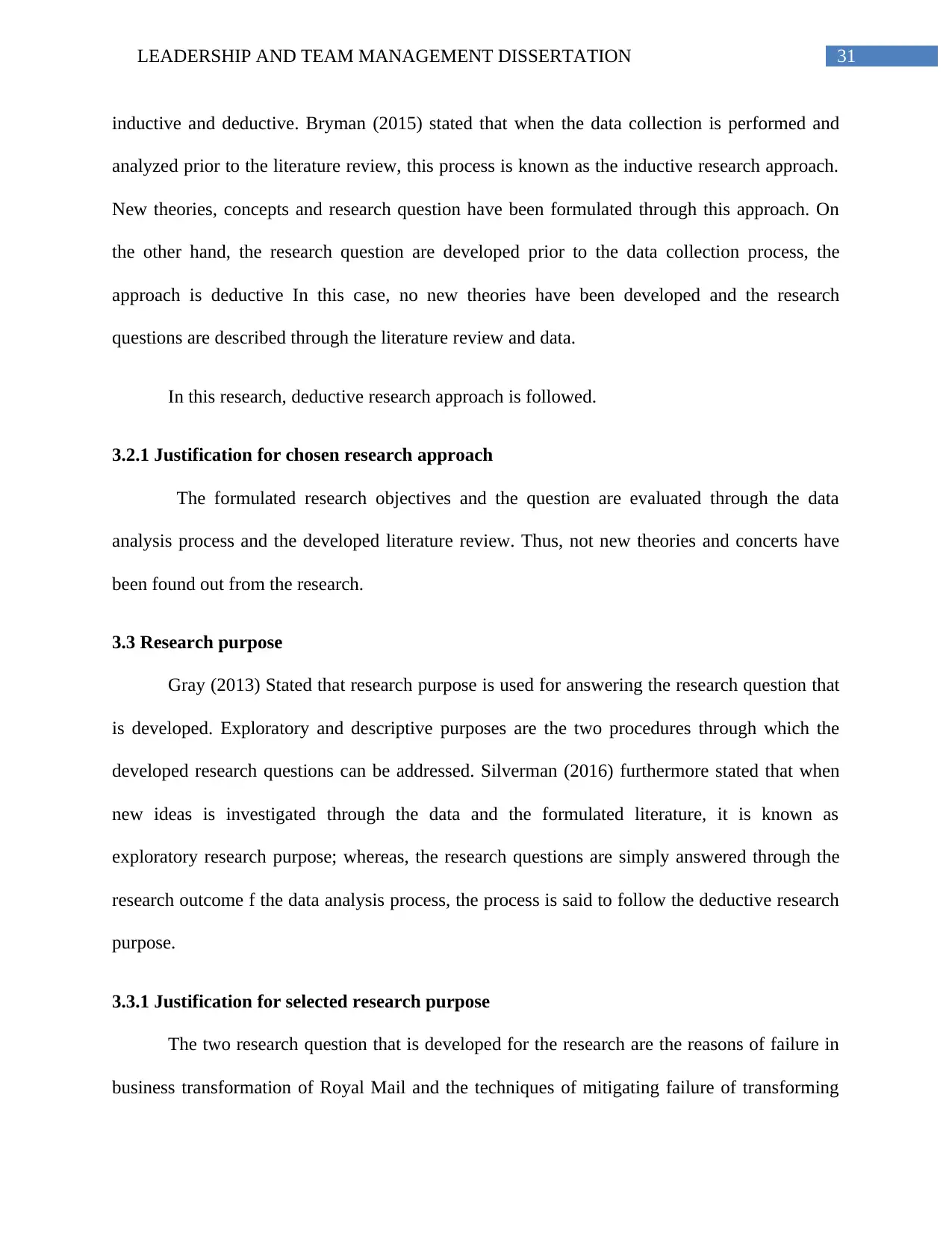
31LEADERSHIP AND TEAM MANAGEMENT DISSERTATION
inductive and deductive. Bryman (2015) stated that when the data collection is performed and
analyzed prior to the literature review, this process is known as the inductive research approach.
New theories, concepts and research question have been formulated through this approach. On
the other hand, the research question are developed prior to the data collection process, the
approach is deductive In this case, no new theories have been developed and the research
questions are described through the literature review and data.
In this research, deductive research approach is followed.
3.2.1 Justification for chosen research approach
The formulated research objectives and the question are evaluated through the data
analysis process and the developed literature review. Thus, not new theories and concerts have
been found out from the research.
3.3 Research purpose
Gray (2013) Stated that research purpose is used for answering the research question that
is developed. Exploratory and descriptive purposes are the two procedures through which the
developed research questions can be addressed. Silverman (2016) furthermore stated that when
new ideas is investigated through the data and the formulated literature, it is known as
exploratory research purpose; whereas, the research questions are simply answered through the
research outcome f the data analysis process, the process is said to follow the deductive research
purpose.
3.3.1 Justification for selected research purpose
The two research question that is developed for the research are the reasons of failure in
business transformation of Royal Mail and the techniques of mitigating failure of transforming
inductive and deductive. Bryman (2015) stated that when the data collection is performed and
analyzed prior to the literature review, this process is known as the inductive research approach.
New theories, concepts and research question have been formulated through this approach. On
the other hand, the research question are developed prior to the data collection process, the
approach is deductive In this case, no new theories have been developed and the research
questions are described through the literature review and data.
In this research, deductive research approach is followed.
3.2.1 Justification for chosen research approach
The formulated research objectives and the question are evaluated through the data
analysis process and the developed literature review. Thus, not new theories and concerts have
been found out from the research.
3.3 Research purpose
Gray (2013) Stated that research purpose is used for answering the research question that
is developed. Exploratory and descriptive purposes are the two procedures through which the
developed research questions can be addressed. Silverman (2016) furthermore stated that when
new ideas is investigated through the data and the formulated literature, it is known as
exploratory research purpose; whereas, the research questions are simply answered through the
research outcome f the data analysis process, the process is said to follow the deductive research
purpose.
3.3.1 Justification for selected research purpose
The two research question that is developed for the research are the reasons of failure in
business transformation of Royal Mail and the techniques of mitigating failure of transforming
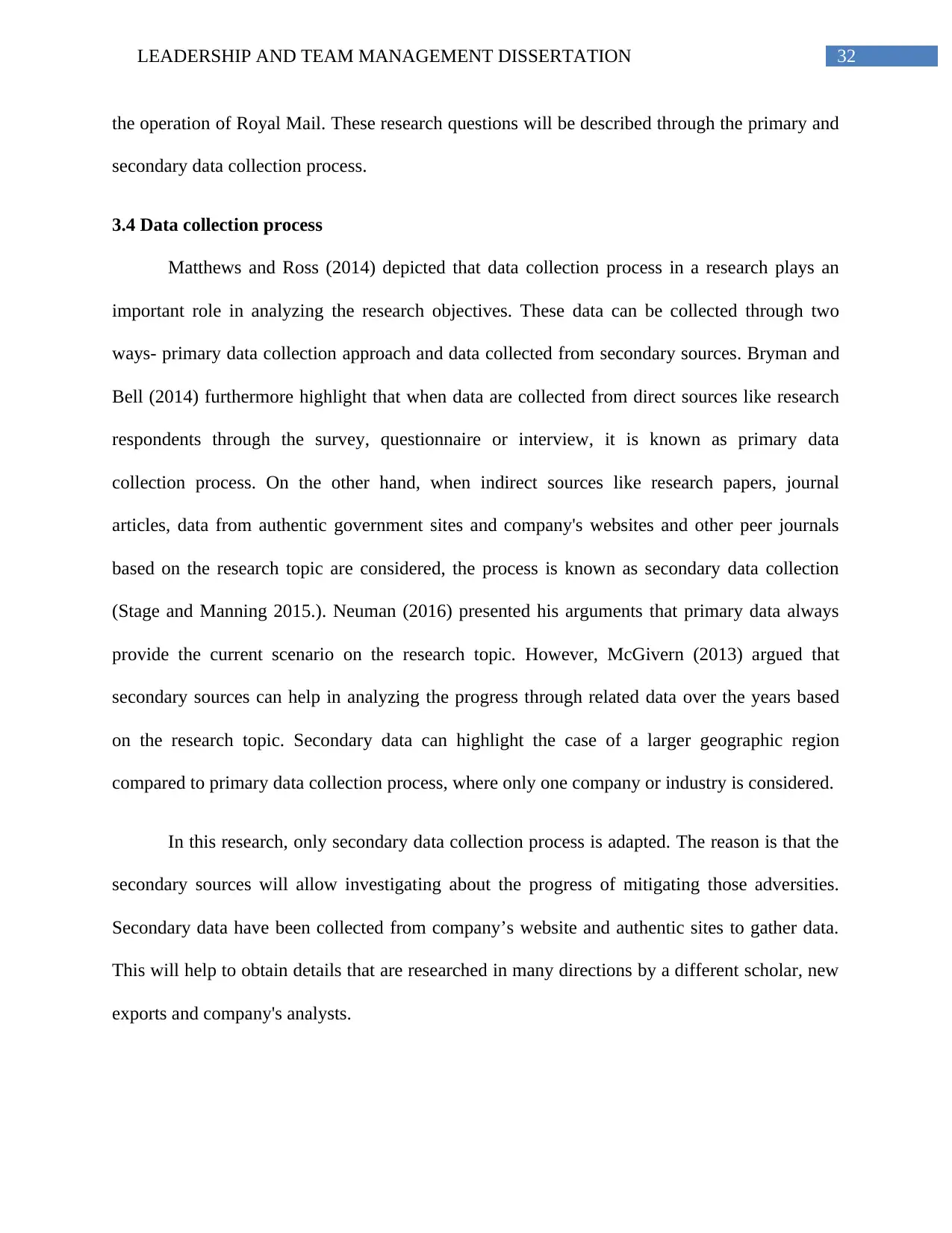
32LEADERSHIP AND TEAM MANAGEMENT DISSERTATION
the operation of Royal Mail. These research questions will be described through the primary and
secondary data collection process.
3.4 Data collection process
Matthews and Ross (2014) depicted that data collection process in a research plays an
important role in analyzing the research objectives. These data can be collected through two
ways- primary data collection approach and data collected from secondary sources. Bryman and
Bell (2014) furthermore highlight that when data are collected from direct sources like research
respondents through the survey, questionnaire or interview, it is known as primary data
collection process. On the other hand, when indirect sources like research papers, journal
articles, data from authentic government sites and company's websites and other peer journals
based on the research topic are considered, the process is known as secondary data collection
(Stage and Manning 2015.). Neuman (2016) presented his arguments that primary data always
provide the current scenario on the research topic. However, McGivern (2013) argued that
secondary sources can help in analyzing the progress through related data over the years based
on the research topic. Secondary data can highlight the case of a larger geographic region
compared to primary data collection process, where only one company or industry is considered.
In this research, only secondary data collection process is adapted. The reason is that the
secondary sources will allow investigating about the progress of mitigating those adversities.
Secondary data have been collected from company’s website and authentic sites to gather data.
This will help to obtain details that are researched in many directions by a different scholar, new
exports and company's analysts.
the operation of Royal Mail. These research questions will be described through the primary and
secondary data collection process.
3.4 Data collection process
Matthews and Ross (2014) depicted that data collection process in a research plays an
important role in analyzing the research objectives. These data can be collected through two
ways- primary data collection approach and data collected from secondary sources. Bryman and
Bell (2014) furthermore highlight that when data are collected from direct sources like research
respondents through the survey, questionnaire or interview, it is known as primary data
collection process. On the other hand, when indirect sources like research papers, journal
articles, data from authentic government sites and company's websites and other peer journals
based on the research topic are considered, the process is known as secondary data collection
(Stage and Manning 2015.). Neuman (2016) presented his arguments that primary data always
provide the current scenario on the research topic. However, McGivern (2013) argued that
secondary sources can help in analyzing the progress through related data over the years based
on the research topic. Secondary data can highlight the case of a larger geographic region
compared to primary data collection process, where only one company or industry is considered.
In this research, only secondary data collection process is adapted. The reason is that the
secondary sources will allow investigating about the progress of mitigating those adversities.
Secondary data have been collected from company’s website and authentic sites to gather data.
This will help to obtain details that are researched in many directions by a different scholar, new
exports and company's analysts.
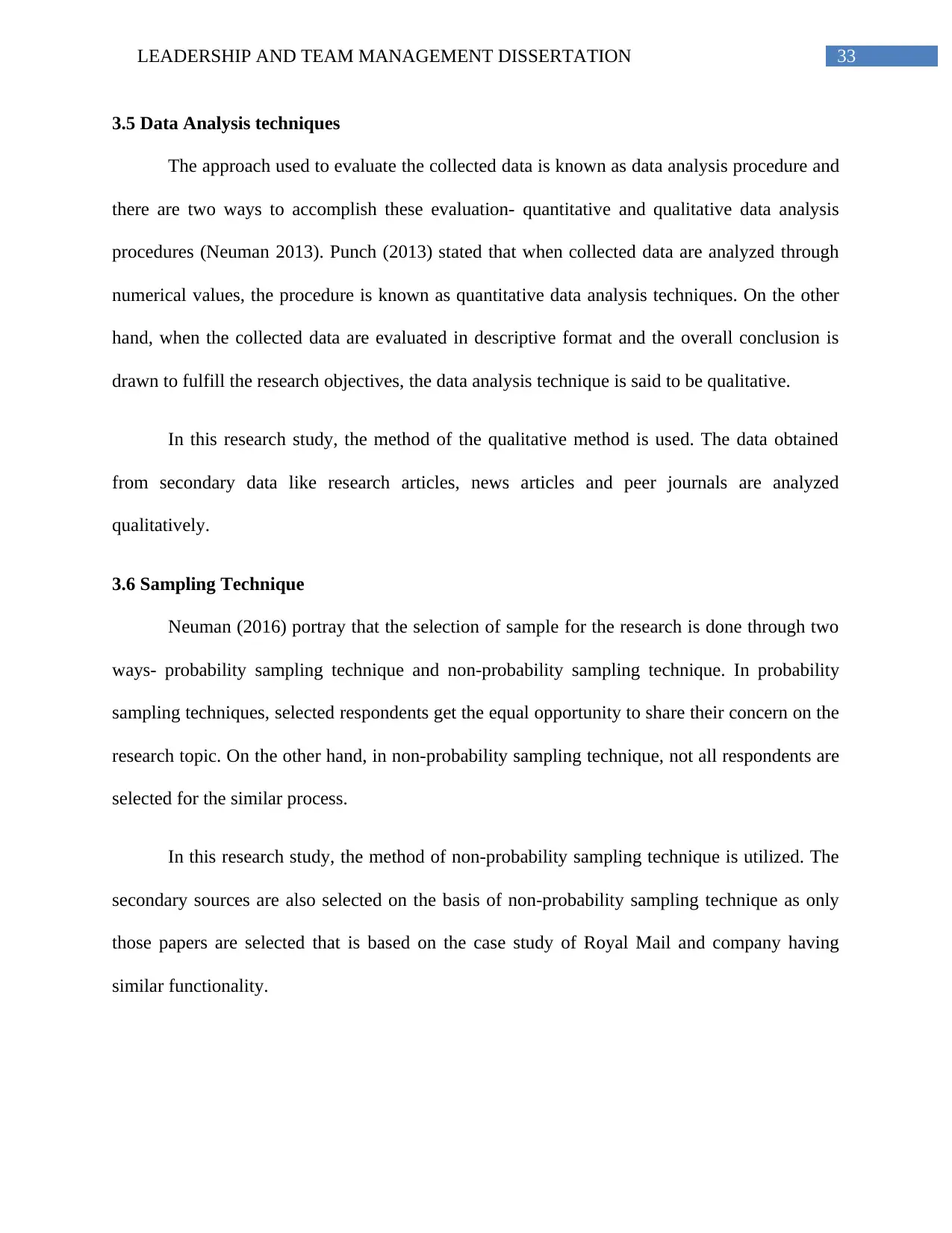
33LEADERSHIP AND TEAM MANAGEMENT DISSERTATION
3.5 Data Analysis techniques
The approach used to evaluate the collected data is known as data analysis procedure and
there are two ways to accomplish these evaluation- quantitative and qualitative data analysis
procedures (Neuman 2013). Punch (2013) stated that when collected data are analyzed through
numerical values, the procedure is known as quantitative data analysis techniques. On the other
hand, when the collected data are evaluated in descriptive format and the overall conclusion is
drawn to fulfill the research objectives, the data analysis technique is said to be qualitative.
In this research study, the method of the qualitative method is used. The data obtained
from secondary data like research articles, news articles and peer journals are analyzed
qualitatively.
3.6 Sampling Technique
Neuman (2016) portray that the selection of sample for the research is done through two
ways- probability sampling technique and non-probability sampling technique. In probability
sampling techniques, selected respondents get the equal opportunity to share their concern on the
research topic. On the other hand, in non-probability sampling technique, not all respondents are
selected for the similar process.
In this research study, the method of non-probability sampling technique is utilized. The
secondary sources are also selected on the basis of non-probability sampling technique as only
those papers are selected that is based on the case study of Royal Mail and company having
similar functionality.
3.5 Data Analysis techniques
The approach used to evaluate the collected data is known as data analysis procedure and
there are two ways to accomplish these evaluation- quantitative and qualitative data analysis
procedures (Neuman 2013). Punch (2013) stated that when collected data are analyzed through
numerical values, the procedure is known as quantitative data analysis techniques. On the other
hand, when the collected data are evaluated in descriptive format and the overall conclusion is
drawn to fulfill the research objectives, the data analysis technique is said to be qualitative.
In this research study, the method of the qualitative method is used. The data obtained
from secondary data like research articles, news articles and peer journals are analyzed
qualitatively.
3.6 Sampling Technique
Neuman (2016) portray that the selection of sample for the research is done through two
ways- probability sampling technique and non-probability sampling technique. In probability
sampling techniques, selected respondents get the equal opportunity to share their concern on the
research topic. On the other hand, in non-probability sampling technique, not all respondents are
selected for the similar process.
In this research study, the method of non-probability sampling technique is utilized. The
secondary sources are also selected on the basis of non-probability sampling technique as only
those papers are selected that is based on the case study of Royal Mail and company having
similar functionality.
Secure Best Marks with AI Grader
Need help grading? Try our AI Grader for instant feedback on your assignments.
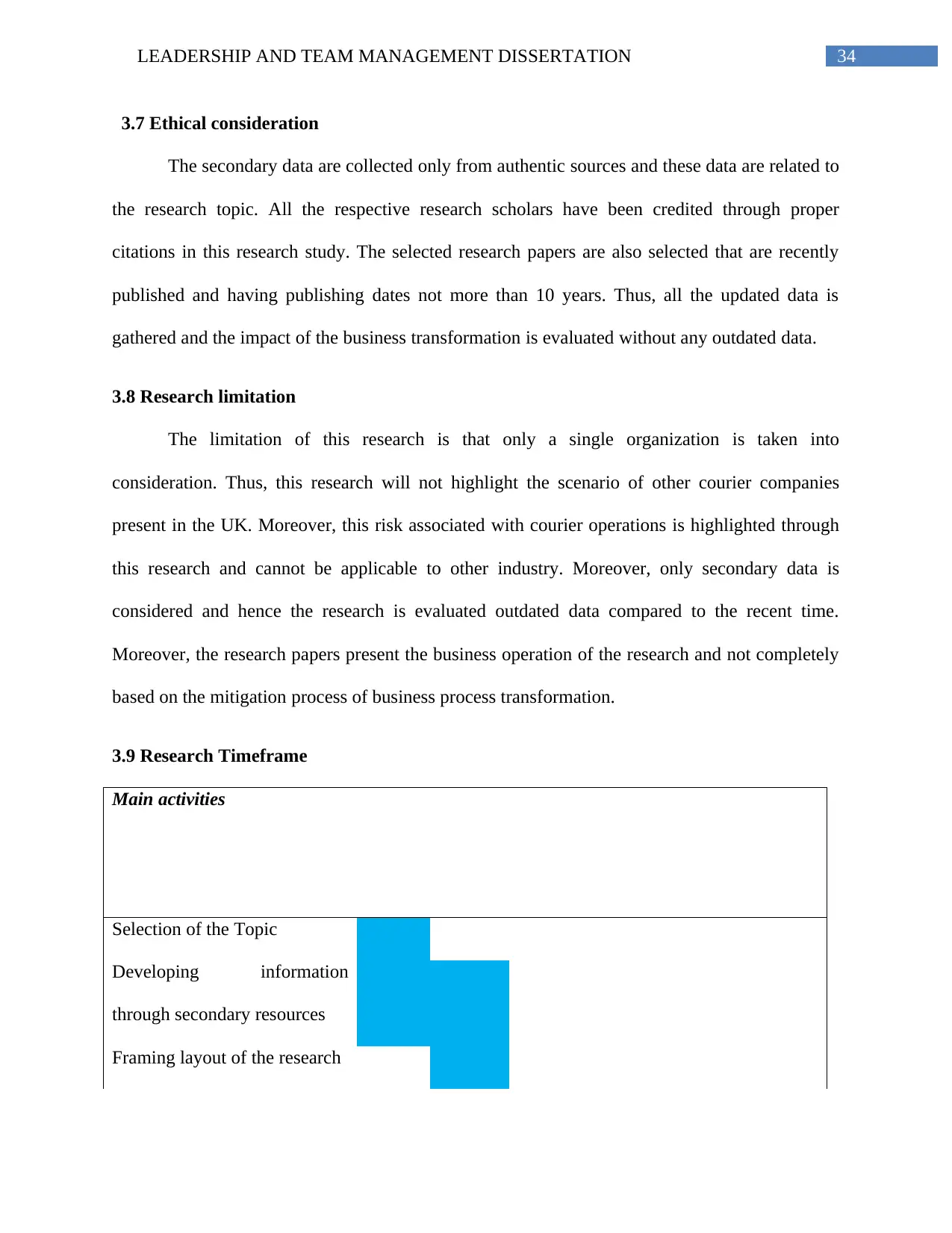
34LEADERSHIP AND TEAM MANAGEMENT DISSERTATION
3.7 Ethical consideration
The secondary data are collected only from authentic sources and these data are related to
the research topic. All the respective research scholars have been credited through proper
citations in this research study. The selected research papers are also selected that are recently
published and having publishing dates not more than 10 years. Thus, all the updated data is
gathered and the impact of the business transformation is evaluated without any outdated data.
3.8 Research limitation
The limitation of this research is that only a single organization is taken into
consideration. Thus, this research will not highlight the scenario of other courier companies
present in the UK. Moreover, this risk associated with courier operations is highlighted through
this research and cannot be applicable to other industry. Moreover, only secondary data is
considered and hence the research is evaluated outdated data compared to the recent time.
Moreover, the research papers present the business operation of the research and not completely
based on the mitigation process of business process transformation.
3.9 Research Timeframe
Main activities Week
1st and
2nd
Week
3rd and
4th
Week
5th and
6th
Week
7th and
8th
Week
9th and
10th
Week
11th and
12th
Selection of the Topic
Developing information
through secondary resources
Framing layout of the research
3.7 Ethical consideration
The secondary data are collected only from authentic sources and these data are related to
the research topic. All the respective research scholars have been credited through proper
citations in this research study. The selected research papers are also selected that are recently
published and having publishing dates not more than 10 years. Thus, all the updated data is
gathered and the impact of the business transformation is evaluated without any outdated data.
3.8 Research limitation
The limitation of this research is that only a single organization is taken into
consideration. Thus, this research will not highlight the scenario of other courier companies
present in the UK. Moreover, this risk associated with courier operations is highlighted through
this research and cannot be applicable to other industry. Moreover, only secondary data is
considered and hence the research is evaluated outdated data compared to the recent time.
Moreover, the research papers present the business operation of the research and not completely
based on the mitigation process of business process transformation.
3.9 Research Timeframe
Main activities Week
1st and
2nd
Week
3rd and
4th
Week
5th and
6th
Week
7th and
8th
Week
9th and
10th
Week
11th and
12th
Selection of the Topic
Developing information
through secondary resources
Framing layout of the research
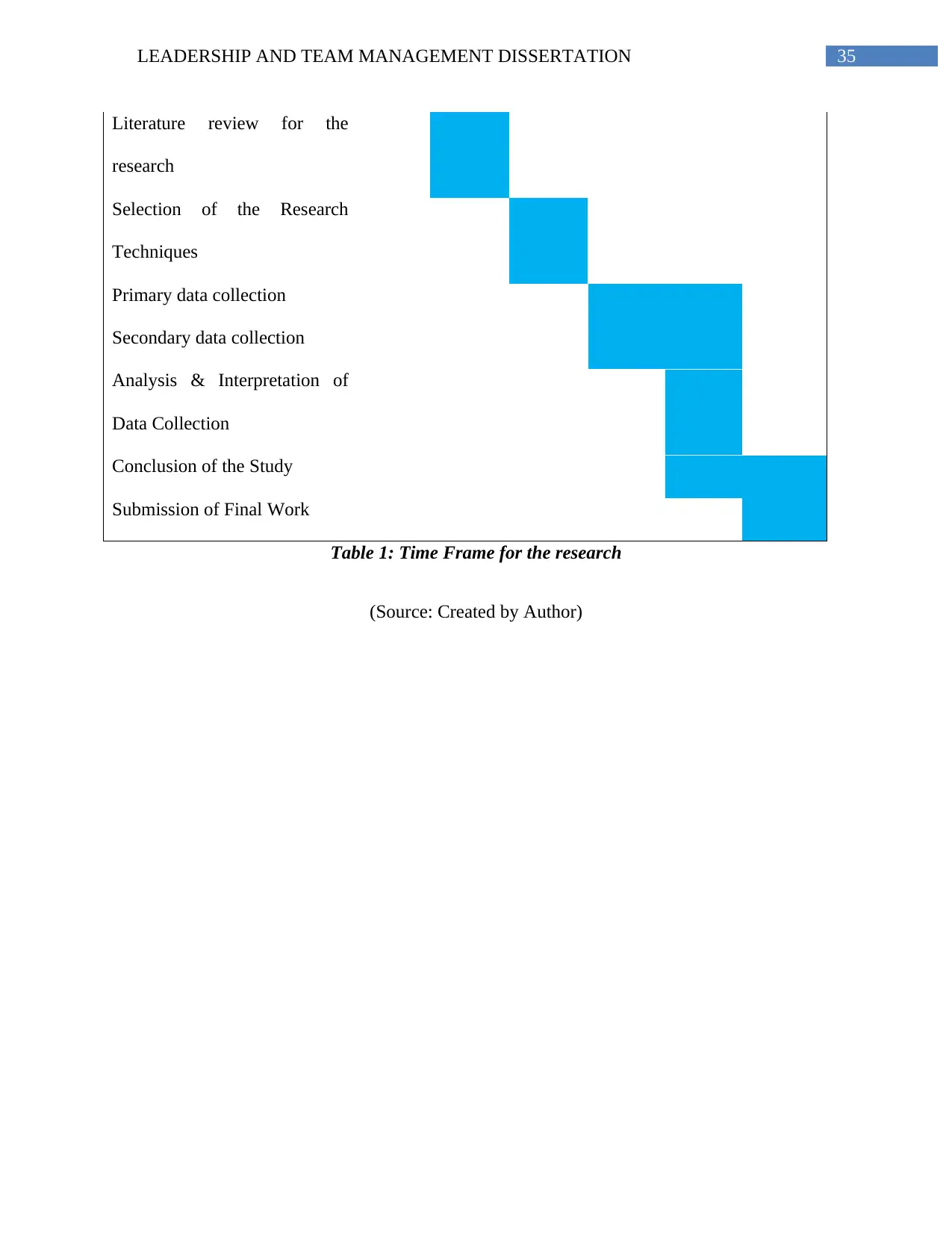
35LEADERSHIP AND TEAM MANAGEMENT DISSERTATION
Literature review for the
research
Selection of the Research
Techniques
Primary data collection
Secondary data collection
Analysis & Interpretation of
Data Collection
Conclusion of the Study
Submission of Final Work
Table 1: Time Frame for the research
(Source: Created by Author)
Literature review for the
research
Selection of the Research
Techniques
Primary data collection
Secondary data collection
Analysis & Interpretation of
Data Collection
Conclusion of the Study
Submission of Final Work
Table 1: Time Frame for the research
(Source: Created by Author)
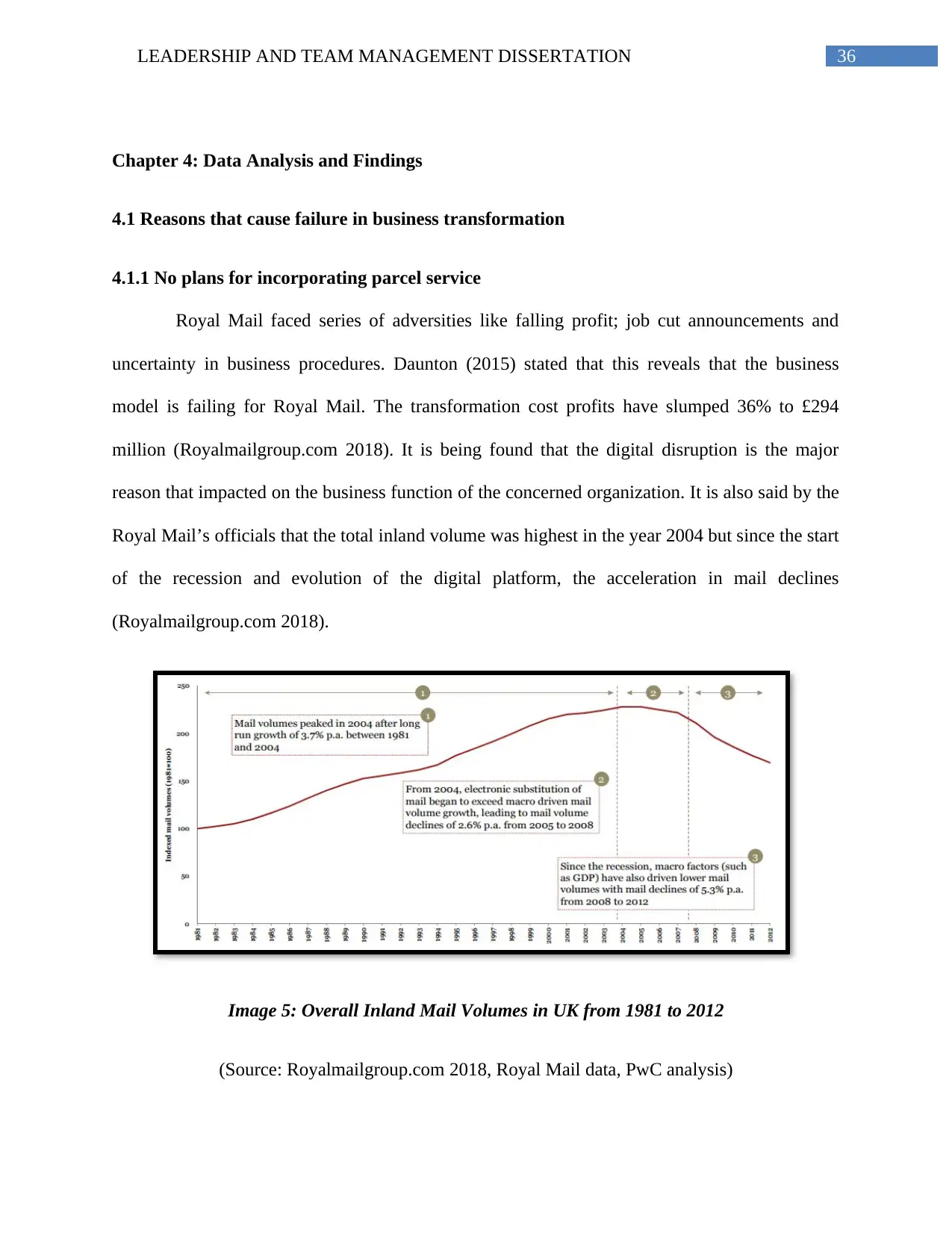
36LEADERSHIP AND TEAM MANAGEMENT DISSERTATION
Chapter 4: Data Analysis and Findings
4.1 Reasons that cause failure in business transformation
4.1.1 No plans for incorporating parcel service
Royal Mail faced series of adversities like falling profit; job cut announcements and
uncertainty in business procedures. Daunton (2015) stated that this reveals that the business
model is failing for Royal Mail. The transformation cost profits have slumped 36% to £294
million (Royalmailgroup.com 2018). It is being found that the digital disruption is the major
reason that impacted on the business function of the concerned organization. It is also said by the
Royal Mail’s officials that the total inland volume was highest in the year 2004 but since the start
of the recession and evolution of the digital platform, the acceleration in mail declines
(Royalmailgroup.com 2018).
Image 5: Overall Inland Mail Volumes in UK from 1981 to 2012
(Source: Royalmailgroup.com 2018, Royal Mail data, PwC analysis)
Chapter 4: Data Analysis and Findings
4.1 Reasons that cause failure in business transformation
4.1.1 No plans for incorporating parcel service
Royal Mail faced series of adversities like falling profit; job cut announcements and
uncertainty in business procedures. Daunton (2015) stated that this reveals that the business
model is failing for Royal Mail. The transformation cost profits have slumped 36% to £294
million (Royalmailgroup.com 2018). It is being found that the digital disruption is the major
reason that impacted on the business function of the concerned organization. It is also said by the
Royal Mail’s officials that the total inland volume was highest in the year 2004 but since the start
of the recession and evolution of the digital platform, the acceleration in mail declines
(Royalmailgroup.com 2018).
Image 5: Overall Inland Mail Volumes in UK from 1981 to 2012
(Source: Royalmailgroup.com 2018, Royal Mail data, PwC analysis)
Paraphrase This Document
Need a fresh take? Get an instant paraphrase of this document with our AI Paraphraser
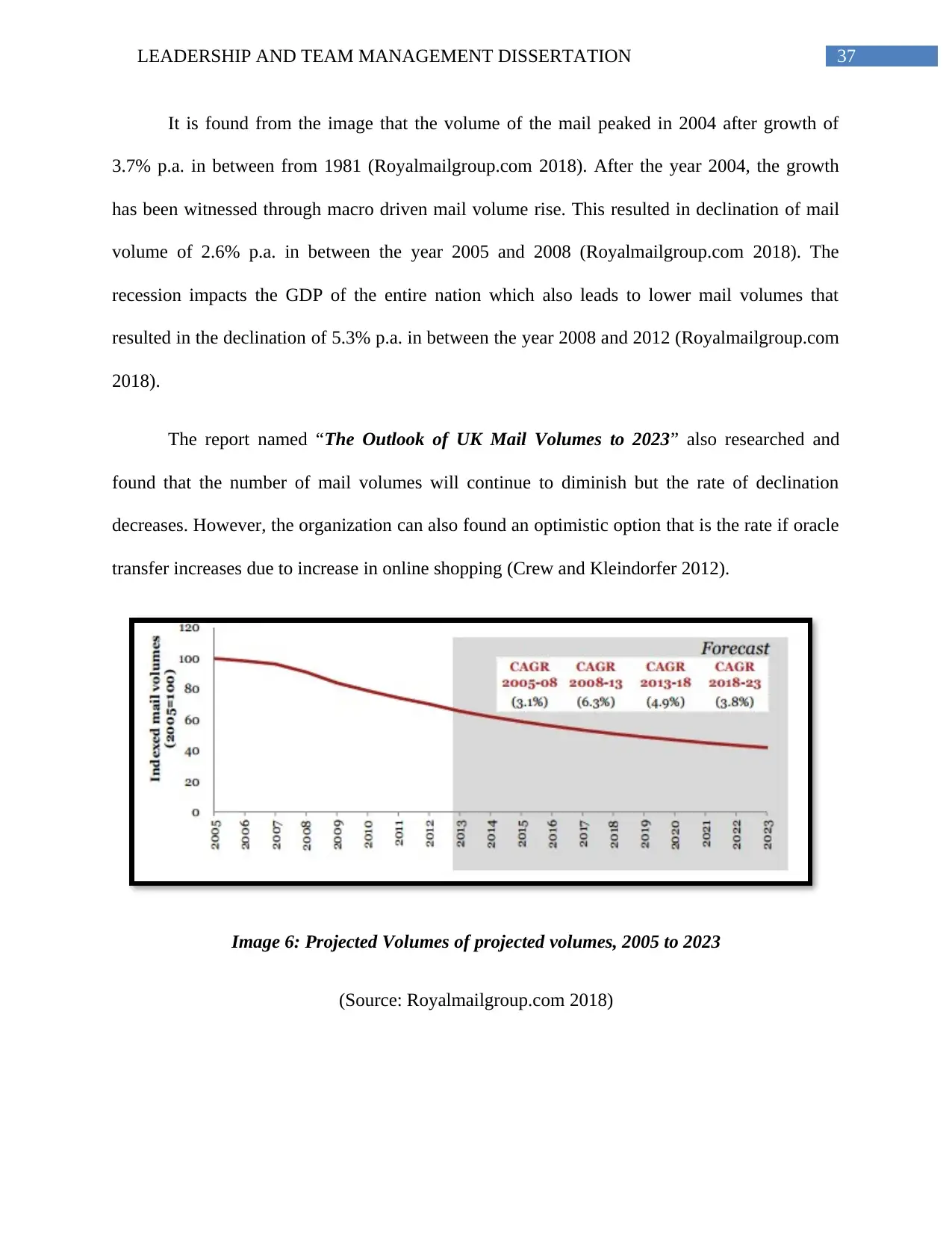
37LEADERSHIP AND TEAM MANAGEMENT DISSERTATION
It is found from the image that the volume of the mail peaked in 2004 after growth of
3.7% p.a. in between from 1981 (Royalmailgroup.com 2018). After the year 2004, the growth
has been witnessed through macro driven mail volume rise. This resulted in declination of mail
volume of 2.6% p.a. in between the year 2005 and 2008 (Royalmailgroup.com 2018). The
recession impacts the GDP of the entire nation which also leads to lower mail volumes that
resulted in the declination of 5.3% p.a. in between the year 2008 and 2012 (Royalmailgroup.com
2018).
The report named “The Outlook of UK Mail Volumes to 2023” also researched and
found that the number of mail volumes will continue to diminish but the rate of declination
decreases. However, the organization can also found an optimistic option that is the rate if oracle
transfer increases due to increase in online shopping (Crew and Kleindorfer 2012).
Image 6: Projected Volumes of projected volumes, 2005 to 2023
(Source: Royalmailgroup.com 2018)
It is found from the image that the volume of the mail peaked in 2004 after growth of
3.7% p.a. in between from 1981 (Royalmailgroup.com 2018). After the year 2004, the growth
has been witnessed through macro driven mail volume rise. This resulted in declination of mail
volume of 2.6% p.a. in between the year 2005 and 2008 (Royalmailgroup.com 2018). The
recession impacts the GDP of the entire nation which also leads to lower mail volumes that
resulted in the declination of 5.3% p.a. in between the year 2008 and 2012 (Royalmailgroup.com
2018).
The report named “The Outlook of UK Mail Volumes to 2023” also researched and
found that the number of mail volumes will continue to diminish but the rate of declination
decreases. However, the organization can also found an optimistic option that is the rate if oracle
transfer increases due to increase in online shopping (Crew and Kleindorfer 2012).
Image 6: Projected Volumes of projected volumes, 2005 to 2023
(Source: Royalmailgroup.com 2018)
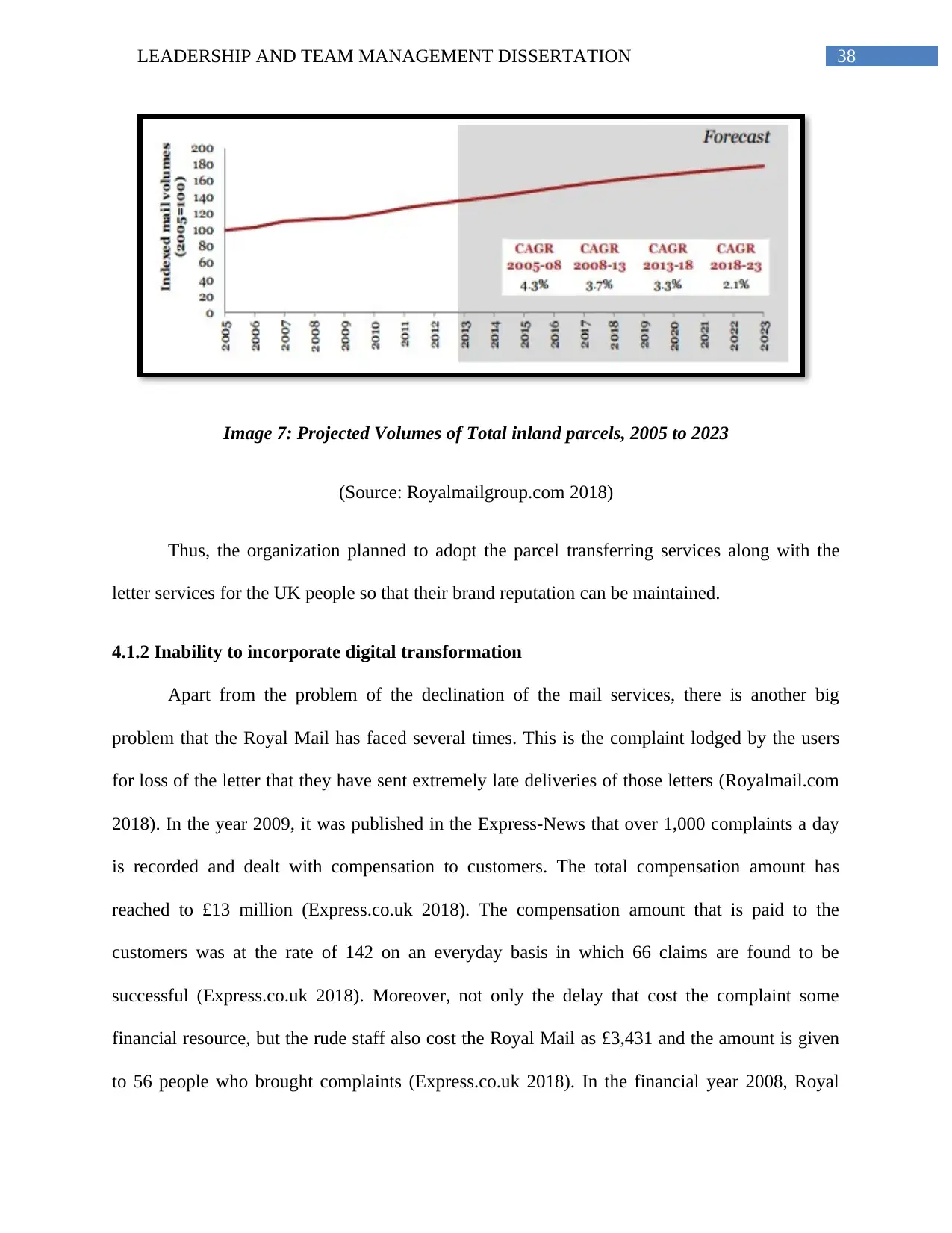
38LEADERSHIP AND TEAM MANAGEMENT DISSERTATION
Image 7: Projected Volumes of Total inland parcels, 2005 to 2023
(Source: Royalmailgroup.com 2018)
Thus, the organization planned to adopt the parcel transferring services along with the
letter services for the UK people so that their brand reputation can be maintained.
4.1.2 Inability to incorporate digital transformation
Apart from the problem of the declination of the mail services, there is another big
problem that the Royal Mail has faced several times. This is the complaint lodged by the users
for loss of the letter that they have sent extremely late deliveries of those letters (Royalmail.com
2018). In the year 2009, it was published in the Express-News that over 1,000 complaints a day
is recorded and dealt with compensation to customers. The total compensation amount has
reached to £13 million (Express.co.uk 2018). The compensation amount that is paid to the
customers was at the rate of 142 on an everyday basis in which 66 claims are found to be
successful (Express.co.uk 2018). Moreover, not only the delay that cost the complaint some
financial resource, but the rude staff also cost the Royal Mail as £3,431 and the amount is given
to 56 people who brought complaints (Express.co.uk 2018). In the financial year 2008, Royal
Image 7: Projected Volumes of Total inland parcels, 2005 to 2023
(Source: Royalmailgroup.com 2018)
Thus, the organization planned to adopt the parcel transferring services along with the
letter services for the UK people so that their brand reputation can be maintained.
4.1.2 Inability to incorporate digital transformation
Apart from the problem of the declination of the mail services, there is another big
problem that the Royal Mail has faced several times. This is the complaint lodged by the users
for loss of the letter that they have sent extremely late deliveries of those letters (Royalmail.com
2018). In the year 2009, it was published in the Express-News that over 1,000 complaints a day
is recorded and dealt with compensation to customers. The total compensation amount has
reached to £13 million (Express.co.uk 2018). The compensation amount that is paid to the
customers was at the rate of 142 on an everyday basis in which 66 claims are found to be
successful (Express.co.uk 2018). Moreover, not only the delay that cost the complaint some
financial resource, but the rude staff also cost the Royal Mail as £3,431 and the amount is given
to 56 people who brought complaints (Express.co.uk 2018). In the financial year 2008, Royal
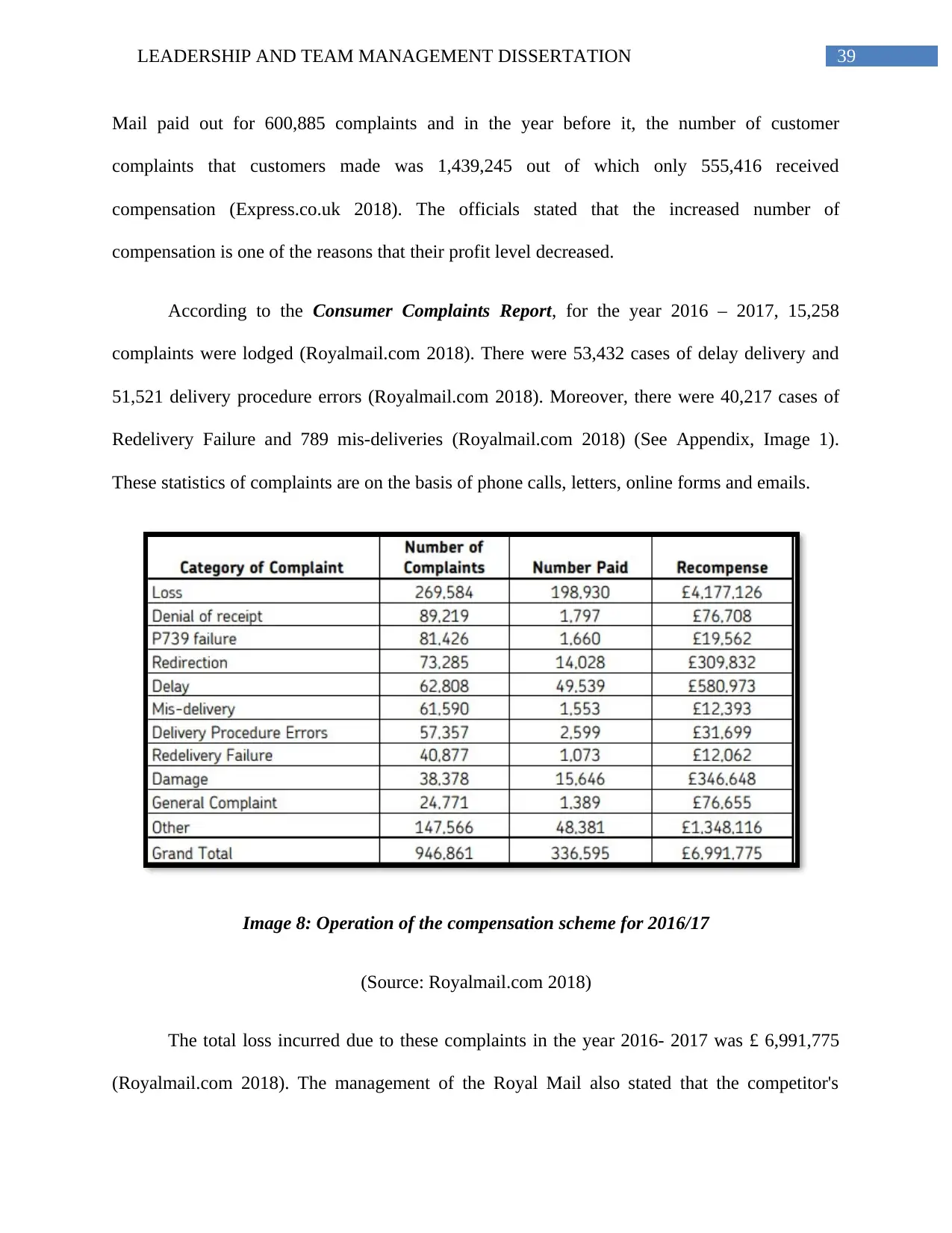
39LEADERSHIP AND TEAM MANAGEMENT DISSERTATION
Mail paid out for 600,885 complaints and in the year before it, the number of customer
complaints that customers made was 1,439,245 out of which only 555,416 received
compensation (Express.co.uk 2018). The officials stated that the increased number of
compensation is one of the reasons that their profit level decreased.
According to the Consumer Complaints Report, for the year 2016 – 2017, 15,258
complaints were lodged (Royalmail.com 2018). There were 53,432 cases of delay delivery and
51,521 delivery procedure errors (Royalmail.com 2018). Moreover, there were 40,217 cases of
Redelivery Failure and 789 mis-deliveries (Royalmail.com 2018) (See Appendix, Image 1).
These statistics of complaints are on the basis of phone calls, letters, online forms and emails.
Image 8: Operation of the compensation scheme for 2016/17
(Source: Royalmail.com 2018)
The total loss incurred due to these complaints in the year 2016- 2017 was £ 6,991,775
(Royalmail.com 2018). The management of the Royal Mail also stated that the competitor's
Mail paid out for 600,885 complaints and in the year before it, the number of customer
complaints that customers made was 1,439,245 out of which only 555,416 received
compensation (Express.co.uk 2018). The officials stated that the increased number of
compensation is one of the reasons that their profit level decreased.
According to the Consumer Complaints Report, for the year 2016 – 2017, 15,258
complaints were lodged (Royalmail.com 2018). There were 53,432 cases of delay delivery and
51,521 delivery procedure errors (Royalmail.com 2018). Moreover, there were 40,217 cases of
Redelivery Failure and 789 mis-deliveries (Royalmail.com 2018) (See Appendix, Image 1).
These statistics of complaints are on the basis of phone calls, letters, online forms and emails.
Image 8: Operation of the compensation scheme for 2016/17
(Source: Royalmail.com 2018)
The total loss incurred due to these complaints in the year 2016- 2017 was £ 6,991,775
(Royalmail.com 2018). The management of the Royal Mail also stated that the competitor's
Secure Best Marks with AI Grader
Need help grading? Try our AI Grader for instant feedback on your assignments.
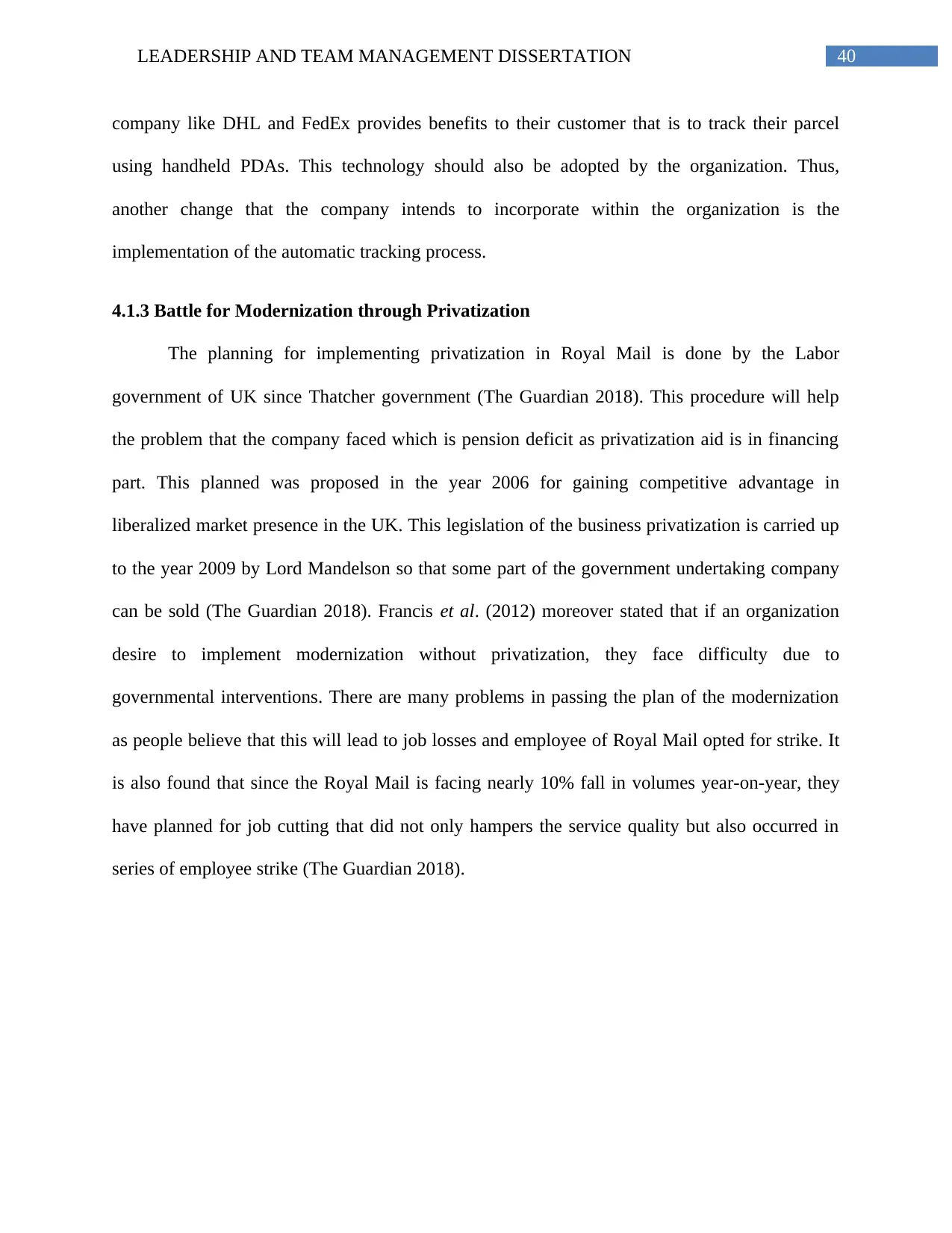
40LEADERSHIP AND TEAM MANAGEMENT DISSERTATION
company like DHL and FedEx provides benefits to their customer that is to track their parcel
using handheld PDAs. This technology should also be adopted by the organization. Thus,
another change that the company intends to incorporate within the organization is the
implementation of the automatic tracking process.
4.1.3 Battle for Modernization through Privatization
The planning for implementing privatization in Royal Mail is done by the Labor
government of UK since Thatcher government (The Guardian 2018). This procedure will help
the problem that the company faced which is pension deficit as privatization aid is in financing
part. This planned was proposed in the year 2006 for gaining competitive advantage in
liberalized market presence in the UK. This legislation of the business privatization is carried up
to the year 2009 by Lord Mandelson so that some part of the government undertaking company
can be sold (The Guardian 2018). Francis et al. (2012) moreover stated that if an organization
desire to implement modernization without privatization, they face difficulty due to
governmental interventions. There are many problems in passing the plan of the modernization
as people believe that this will lead to job losses and employee of Royal Mail opted for strike. It
is also found that since the Royal Mail is facing nearly 10% fall in volumes year-on-year, they
have planned for job cutting that did not only hampers the service quality but also occurred in
series of employee strike (The Guardian 2018).
company like DHL and FedEx provides benefits to their customer that is to track their parcel
using handheld PDAs. This technology should also be adopted by the organization. Thus,
another change that the company intends to incorporate within the organization is the
implementation of the automatic tracking process.
4.1.3 Battle for Modernization through Privatization
The planning for implementing privatization in Royal Mail is done by the Labor
government of UK since Thatcher government (The Guardian 2018). This procedure will help
the problem that the company faced which is pension deficit as privatization aid is in financing
part. This planned was proposed in the year 2006 for gaining competitive advantage in
liberalized market presence in the UK. This legislation of the business privatization is carried up
to the year 2009 by Lord Mandelson so that some part of the government undertaking company
can be sold (The Guardian 2018). Francis et al. (2012) moreover stated that if an organization
desire to implement modernization without privatization, they face difficulty due to
governmental interventions. There are many problems in passing the plan of the modernization
as people believe that this will lead to job losses and employee of Royal Mail opted for strike. It
is also found that since the Royal Mail is facing nearly 10% fall in volumes year-on-year, they
have planned for job cutting that did not only hampers the service quality but also occurred in
series of employee strike (The Guardian 2018).
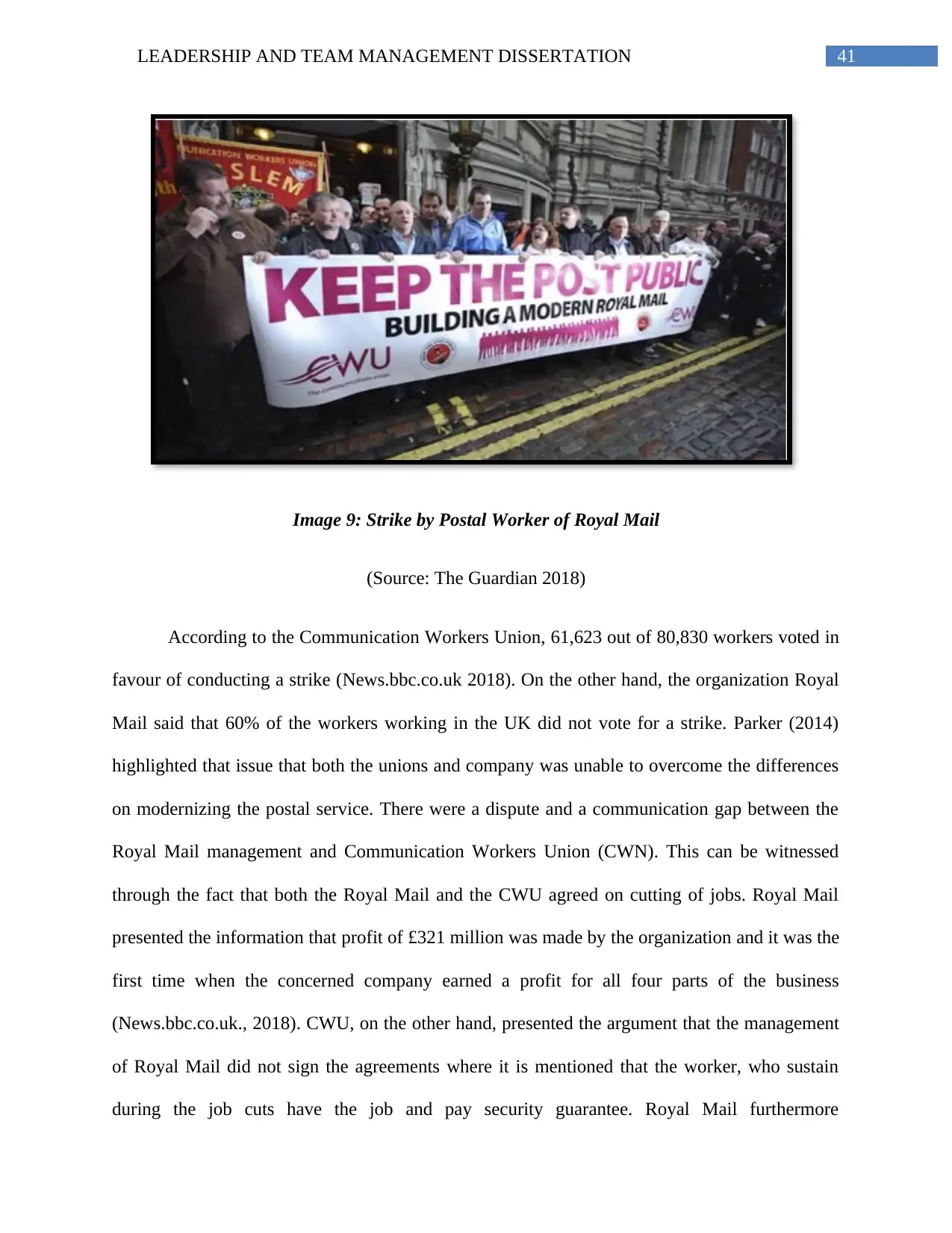
41LEADERSHIP AND TEAM MANAGEMENT DISSERTATION
Image 9: Strike by Postal Worker of Royal Mail
(Source: The Guardian 2018)
According to the Communication Workers Union, 61,623 out of 80,830 workers voted in
favour of conducting a strike (News.bbc.co.uk 2018). On the other hand, the organization Royal
Mail said that 60% of the workers working in the UK did not vote for a strike. Parker (2014)
highlighted that issue that both the unions and company was unable to overcome the differences
on modernizing the postal service. There were a dispute and a communication gap between the
Royal Mail management and Communication Workers Union (CWN). This can be witnessed
through the fact that both the Royal Mail and the CWU agreed on cutting of jobs. Royal Mail
presented the information that profit of £321 million was made by the organization and it was the
first time when the concerned company earned a profit for all four parts of the business
(News.bbc.co.uk., 2018). CWU, on the other hand, presented the argument that the management
of Royal Mail did not sign the agreements where it is mentioned that the worker, who sustain
during the job cuts have the job and pay security guarantee. Royal Mail furthermore
Image 9: Strike by Postal Worker of Royal Mail
(Source: The Guardian 2018)
According to the Communication Workers Union, 61,623 out of 80,830 workers voted in
favour of conducting a strike (News.bbc.co.uk 2018). On the other hand, the organization Royal
Mail said that 60% of the workers working in the UK did not vote for a strike. Parker (2014)
highlighted that issue that both the unions and company was unable to overcome the differences
on modernizing the postal service. There were a dispute and a communication gap between the
Royal Mail management and Communication Workers Union (CWN). This can be witnessed
through the fact that both the Royal Mail and the CWU agreed on cutting of jobs. Royal Mail
presented the information that profit of £321 million was made by the organization and it was the
first time when the concerned company earned a profit for all four parts of the business
(News.bbc.co.uk., 2018). CWU, on the other hand, presented the argument that the management
of Royal Mail did not sign the agreements where it is mentioned that the worker, who sustain
during the job cuts have the job and pay security guarantee. Royal Mail furthermore
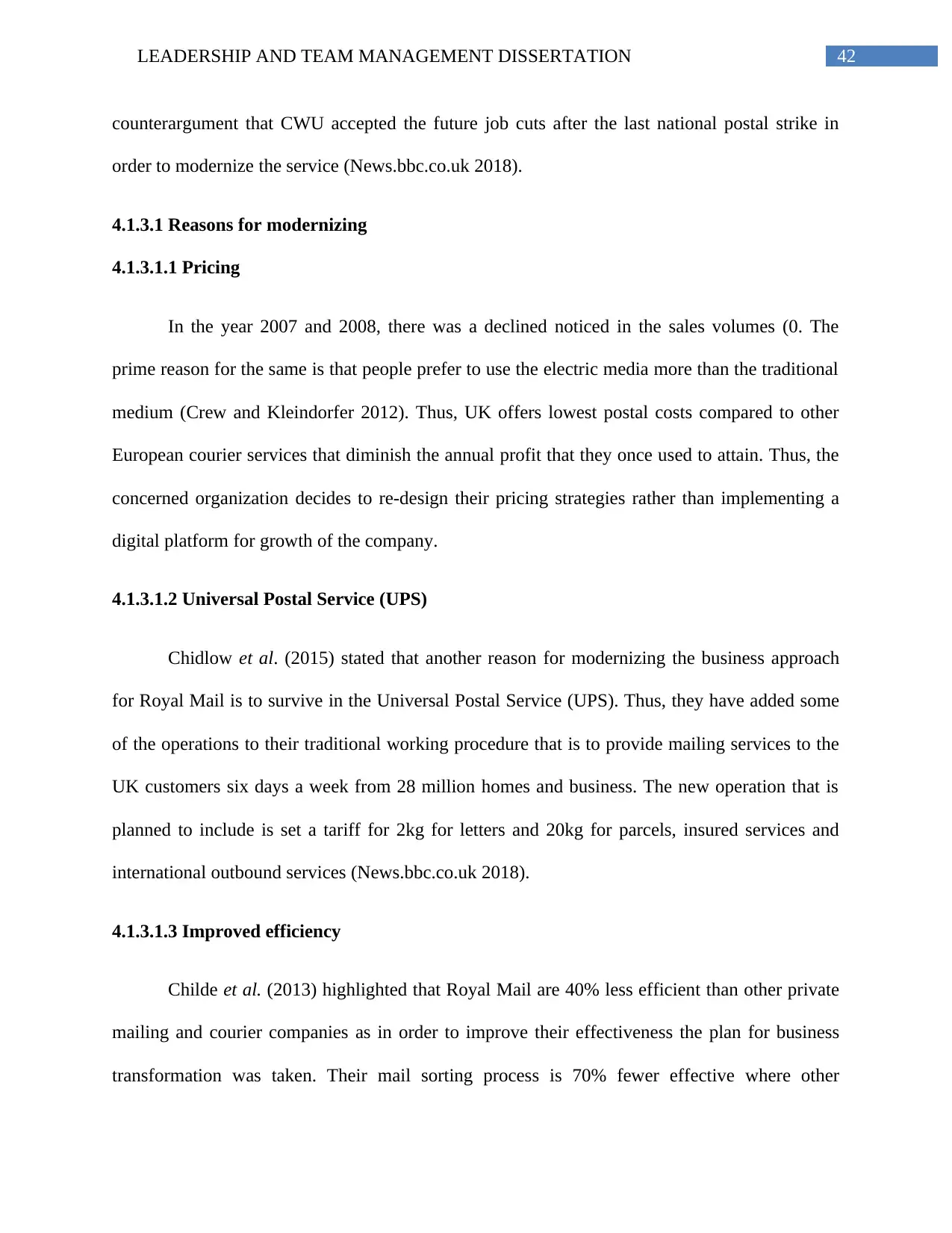
42LEADERSHIP AND TEAM MANAGEMENT DISSERTATION
counterargument that CWU accepted the future job cuts after the last national postal strike in
order to modernize the service (News.bbc.co.uk 2018).
4.1.3.1 Reasons for modernizing
4.1.3.1.1 Pricing
In the year 2007 and 2008, there was a declined noticed in the sales volumes (0. The
prime reason for the same is that people prefer to use the electric media more than the traditional
medium (Crew and Kleindorfer 2012). Thus, UK offers lowest postal costs compared to other
European courier services that diminish the annual profit that they once used to attain. Thus, the
concerned organization decides to re-design their pricing strategies rather than implementing a
digital platform for growth of the company.
4.1.3.1.2 Universal Postal Service (UPS)
Chidlow et al. (2015) stated that another reason for modernizing the business approach
for Royal Mail is to survive in the Universal Postal Service (UPS). Thus, they have added some
of the operations to their traditional working procedure that is to provide mailing services to the
UK customers six days a week from 28 million homes and business. The new operation that is
planned to include is set a tariff for 2kg for letters and 20kg for parcels, insured services and
international outbound services (News.bbc.co.uk 2018).
4.1.3.1.3 Improved efficiency
Childe et al. (2013) highlighted that Royal Mail are 40% less efficient than other private
mailing and courier companies as in order to improve their effectiveness the plan for business
transformation was taken. Their mail sorting process is 70% fewer effective where other
counterargument that CWU accepted the future job cuts after the last national postal strike in
order to modernize the service (News.bbc.co.uk 2018).
4.1.3.1 Reasons for modernizing
4.1.3.1.1 Pricing
In the year 2007 and 2008, there was a declined noticed in the sales volumes (0. The
prime reason for the same is that people prefer to use the electric media more than the traditional
medium (Crew and Kleindorfer 2012). Thus, UK offers lowest postal costs compared to other
European courier services that diminish the annual profit that they once used to attain. Thus, the
concerned organization decides to re-design their pricing strategies rather than implementing a
digital platform for growth of the company.
4.1.3.1.2 Universal Postal Service (UPS)
Chidlow et al. (2015) stated that another reason for modernizing the business approach
for Royal Mail is to survive in the Universal Postal Service (UPS). Thus, they have added some
of the operations to their traditional working procedure that is to provide mailing services to the
UK customers six days a week from 28 million homes and business. The new operation that is
planned to include is set a tariff for 2kg for letters and 20kg for parcels, insured services and
international outbound services (News.bbc.co.uk 2018).
4.1.3.1.3 Improved efficiency
Childe et al. (2013) highlighted that Royal Mail are 40% less efficient than other private
mailing and courier companies as in order to improve their effectiveness the plan for business
transformation was taken. Their mail sorting process is 70% fewer effective where other
Paraphrase This Document
Need a fresh take? Get an instant paraphrase of this document with our AI Paraphraser
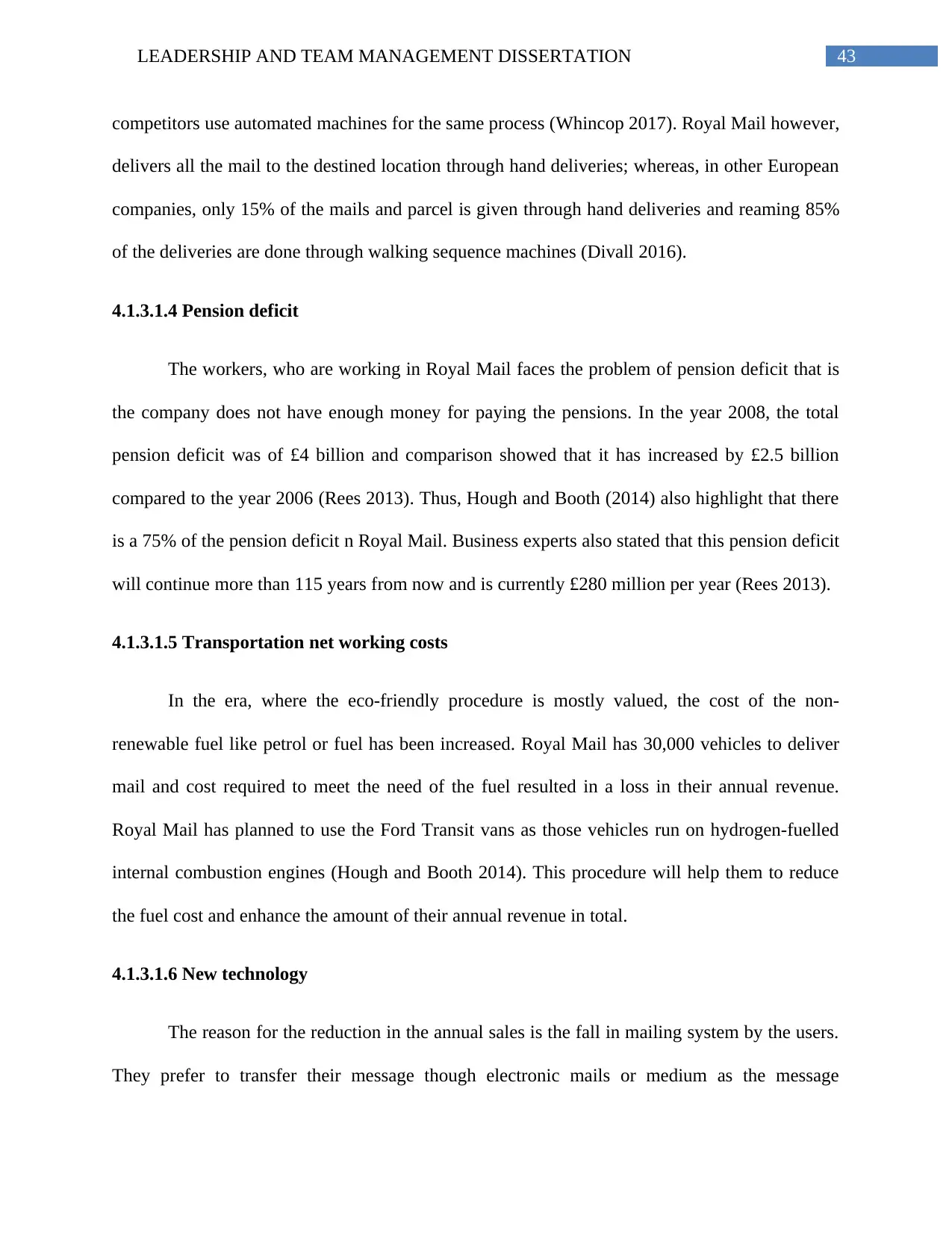
43LEADERSHIP AND TEAM MANAGEMENT DISSERTATION
competitors use automated machines for the same process (Whincop 2017). Royal Mail however,
delivers all the mail to the destined location through hand deliveries; whereas, in other European
companies, only 15% of the mails and parcel is given through hand deliveries and reaming 85%
of the deliveries are done through walking sequence machines (Divall 2016).
4.1.3.1.4 Pension deficit
The workers, who are working in Royal Mail faces the problem of pension deficit that is
the company does not have enough money for paying the pensions. In the year 2008, the total
pension deficit was of £4 billion and comparison showed that it has increased by £2.5 billion
compared to the year 2006 (Rees 2013). Thus, Hough and Booth (2014) also highlight that there
is a 75% of the pension deficit n Royal Mail. Business experts also stated that this pension deficit
will continue more than 115 years from now and is currently £280 million per year (Rees 2013).
4.1.3.1.5 Transportation net working costs
In the era, where the eco-friendly procedure is mostly valued, the cost of the non-
renewable fuel like petrol or fuel has been increased. Royal Mail has 30,000 vehicles to deliver
mail and cost required to meet the need of the fuel resulted in a loss in their annual revenue.
Royal Mail has planned to use the Ford Transit vans as those vehicles run on hydrogen-fuelled
internal combustion engines (Hough and Booth 2014). This procedure will help them to reduce
the fuel cost and enhance the amount of their annual revenue in total.
4.1.3.1.6 New technology
The reason for the reduction in the annual sales is the fall in mailing system by the users.
They prefer to transfer their message though electronic mails or medium as the message
competitors use automated machines for the same process (Whincop 2017). Royal Mail however,
delivers all the mail to the destined location through hand deliveries; whereas, in other European
companies, only 15% of the mails and parcel is given through hand deliveries and reaming 85%
of the deliveries are done through walking sequence machines (Divall 2016).
4.1.3.1.4 Pension deficit
The workers, who are working in Royal Mail faces the problem of pension deficit that is
the company does not have enough money for paying the pensions. In the year 2008, the total
pension deficit was of £4 billion and comparison showed that it has increased by £2.5 billion
compared to the year 2006 (Rees 2013). Thus, Hough and Booth (2014) also highlight that there
is a 75% of the pension deficit n Royal Mail. Business experts also stated that this pension deficit
will continue more than 115 years from now and is currently £280 million per year (Rees 2013).
4.1.3.1.5 Transportation net working costs
In the era, where the eco-friendly procedure is mostly valued, the cost of the non-
renewable fuel like petrol or fuel has been increased. Royal Mail has 30,000 vehicles to deliver
mail and cost required to meet the need of the fuel resulted in a loss in their annual revenue.
Royal Mail has planned to use the Ford Transit vans as those vehicles run on hydrogen-fuelled
internal combustion engines (Hough and Booth 2014). This procedure will help them to reduce
the fuel cost and enhance the amount of their annual revenue in total.
4.1.3.1.6 New technology
The reason for the reduction in the annual sales is the fall in mailing system by the users.
They prefer to transfer their message though electronic mails or medium as the message
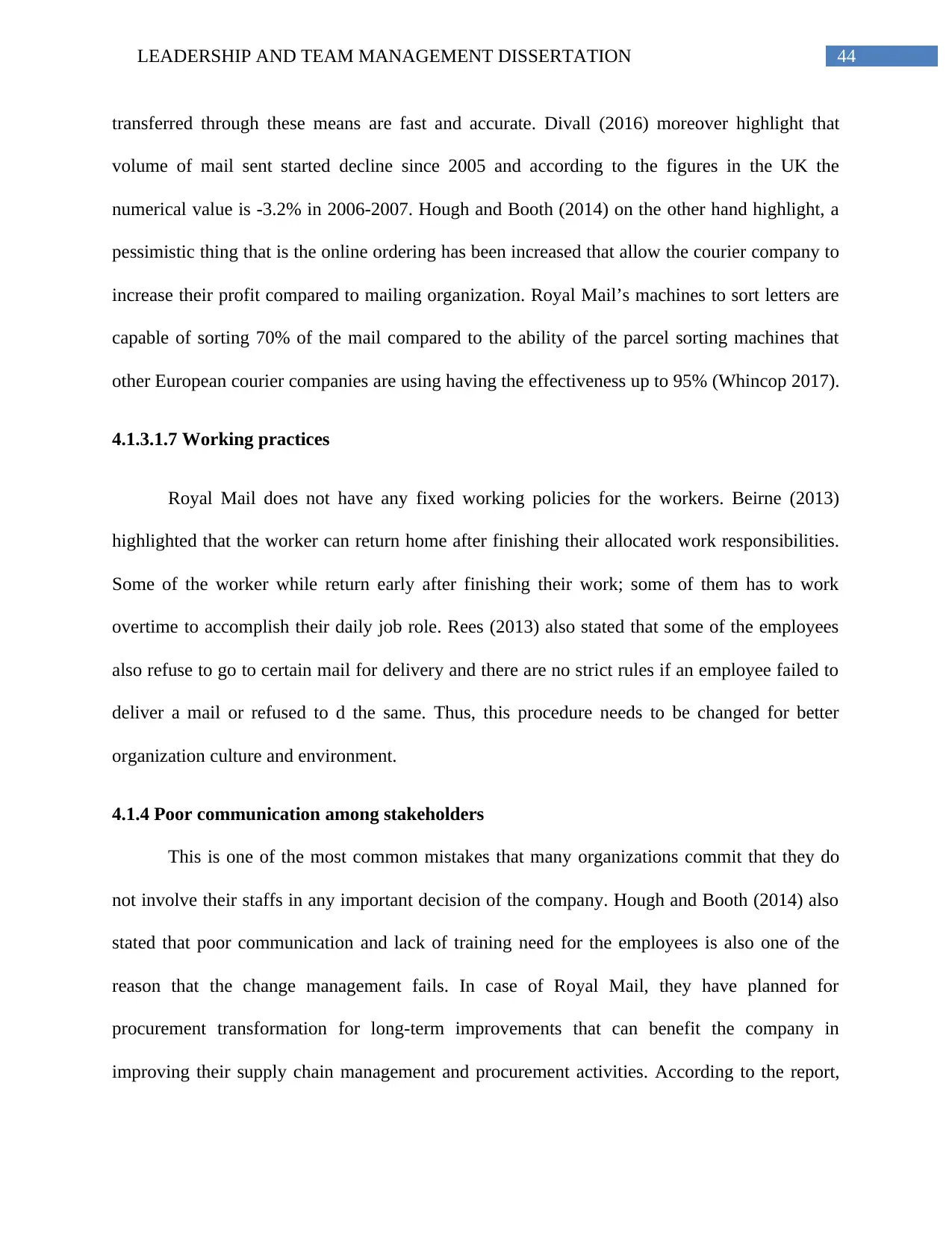
44LEADERSHIP AND TEAM MANAGEMENT DISSERTATION
transferred through these means are fast and accurate. Divall (2016) moreover highlight that
volume of mail sent started decline since 2005 and according to the figures in the UK the
numerical value is -3.2% in 2006-2007. Hough and Booth (2014) on the other hand highlight, a
pessimistic thing that is the online ordering has been increased that allow the courier company to
increase their profit compared to mailing organization. Royal Mail’s machines to sort letters are
capable of sorting 70% of the mail compared to the ability of the parcel sorting machines that
other European courier companies are using having the effectiveness up to 95% (Whincop 2017).
4.1.3.1.7 Working practices
Royal Mail does not have any fixed working policies for the workers. Beirne (2013)
highlighted that the worker can return home after finishing their allocated work responsibilities.
Some of the worker while return early after finishing their work; some of them has to work
overtime to accomplish their daily job role. Rees (2013) also stated that some of the employees
also refuse to go to certain mail for delivery and there are no strict rules if an employee failed to
deliver a mail or refused to d the same. Thus, this procedure needs to be changed for better
organization culture and environment.
4.1.4 Poor communication among stakeholders
This is one of the most common mistakes that many organizations commit that they do
not involve their staffs in any important decision of the company. Hough and Booth (2014) also
stated that poor communication and lack of training need for the employees is also one of the
reason that the change management fails. In case of Royal Mail, they have planned for
procurement transformation for long-term improvements that can benefit the company in
improving their supply chain management and procurement activities. According to the report,
transferred through these means are fast and accurate. Divall (2016) moreover highlight that
volume of mail sent started decline since 2005 and according to the figures in the UK the
numerical value is -3.2% in 2006-2007. Hough and Booth (2014) on the other hand highlight, a
pessimistic thing that is the online ordering has been increased that allow the courier company to
increase their profit compared to mailing organization. Royal Mail’s machines to sort letters are
capable of sorting 70% of the mail compared to the ability of the parcel sorting machines that
other European courier companies are using having the effectiveness up to 95% (Whincop 2017).
4.1.3.1.7 Working practices
Royal Mail does not have any fixed working policies for the workers. Beirne (2013)
highlighted that the worker can return home after finishing their allocated work responsibilities.
Some of the worker while return early after finishing their work; some of them has to work
overtime to accomplish their daily job role. Rees (2013) also stated that some of the employees
also refuse to go to certain mail for delivery and there are no strict rules if an employee failed to
deliver a mail or refused to d the same. Thus, this procedure needs to be changed for better
organization culture and environment.
4.1.4 Poor communication among stakeholders
This is one of the most common mistakes that many organizations commit that they do
not involve their staffs in any important decision of the company. Hough and Booth (2014) also
stated that poor communication and lack of training need for the employees is also one of the
reason that the change management fails. In case of Royal Mail, they have planned for
procurement transformation for long-term improvements that can benefit the company in
improving their supply chain management and procurement activities. According to the report,
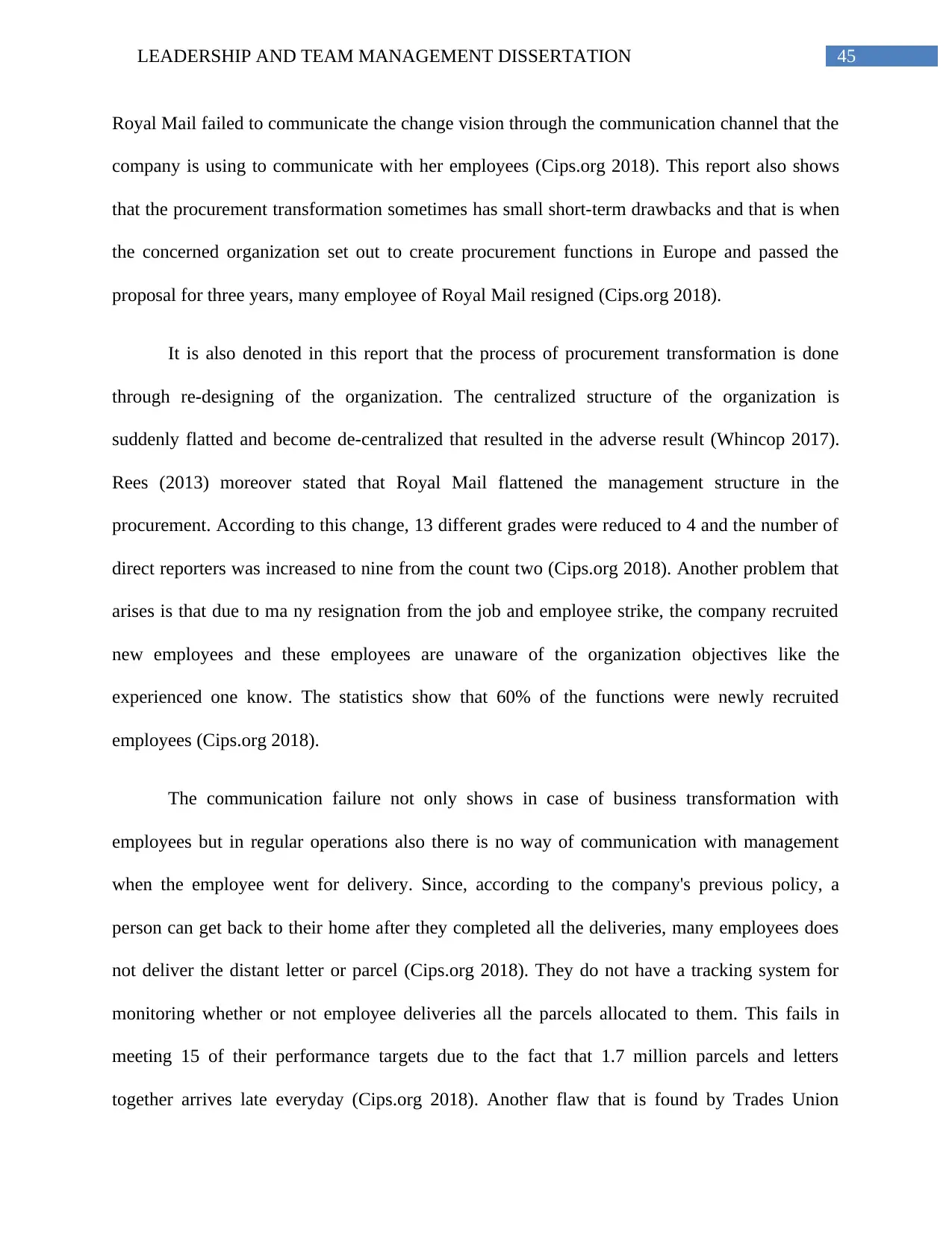
45LEADERSHIP AND TEAM MANAGEMENT DISSERTATION
Royal Mail failed to communicate the change vision through the communication channel that the
company is using to communicate with her employees (Cips.org 2018). This report also shows
that the procurement transformation sometimes has small short-term drawbacks and that is when
the concerned organization set out to create procurement functions in Europe and passed the
proposal for three years, many employee of Royal Mail resigned (Cips.org 2018).
It is also denoted in this report that the process of procurement transformation is done
through re-designing of the organization. The centralized structure of the organization is
suddenly flatted and become de-centralized that resulted in the adverse result (Whincop 2017).
Rees (2013) moreover stated that Royal Mail flattened the management structure in the
procurement. According to this change, 13 different grades were reduced to 4 and the number of
direct reporters was increased to nine from the count two (Cips.org 2018). Another problem that
arises is that due to ma ny resignation from the job and employee strike, the company recruited
new employees and these employees are unaware of the organization objectives like the
experienced one know. The statistics show that 60% of the functions were newly recruited
employees (Cips.org 2018).
The communication failure not only shows in case of business transformation with
employees but in regular operations also there is no way of communication with management
when the employee went for delivery. Since, according to the company's previous policy, a
person can get back to their home after they completed all the deliveries, many employees does
not deliver the distant letter or parcel (Cips.org 2018). They do not have a tracking system for
monitoring whether or not employee deliveries all the parcels allocated to them. This fails in
meeting 15 of their performance targets due to the fact that 1.7 million parcels and letters
together arrives late everyday (Cips.org 2018). Another flaw that is found by Trades Union
Royal Mail failed to communicate the change vision through the communication channel that the
company is using to communicate with her employees (Cips.org 2018). This report also shows
that the procurement transformation sometimes has small short-term drawbacks and that is when
the concerned organization set out to create procurement functions in Europe and passed the
proposal for three years, many employee of Royal Mail resigned (Cips.org 2018).
It is also denoted in this report that the process of procurement transformation is done
through re-designing of the organization. The centralized structure of the organization is
suddenly flatted and become de-centralized that resulted in the adverse result (Whincop 2017).
Rees (2013) moreover stated that Royal Mail flattened the management structure in the
procurement. According to this change, 13 different grades were reduced to 4 and the number of
direct reporters was increased to nine from the count two (Cips.org 2018). Another problem that
arises is that due to ma ny resignation from the job and employee strike, the company recruited
new employees and these employees are unaware of the organization objectives like the
experienced one know. The statistics show that 60% of the functions were newly recruited
employees (Cips.org 2018).
The communication failure not only shows in case of business transformation with
employees but in regular operations also there is no way of communication with management
when the employee went for delivery. Since, according to the company's previous policy, a
person can get back to their home after they completed all the deliveries, many employees does
not deliver the distant letter or parcel (Cips.org 2018). They do not have a tracking system for
monitoring whether or not employee deliveries all the parcels allocated to them. This fails in
meeting 15 of their performance targets due to the fact that 1.7 million parcels and letters
together arrives late everyday (Cips.org 2018). Another flaw that is found by Trades Union
Secure Best Marks with AI Grader
Need help grading? Try our AI Grader for instant feedback on your assignments.
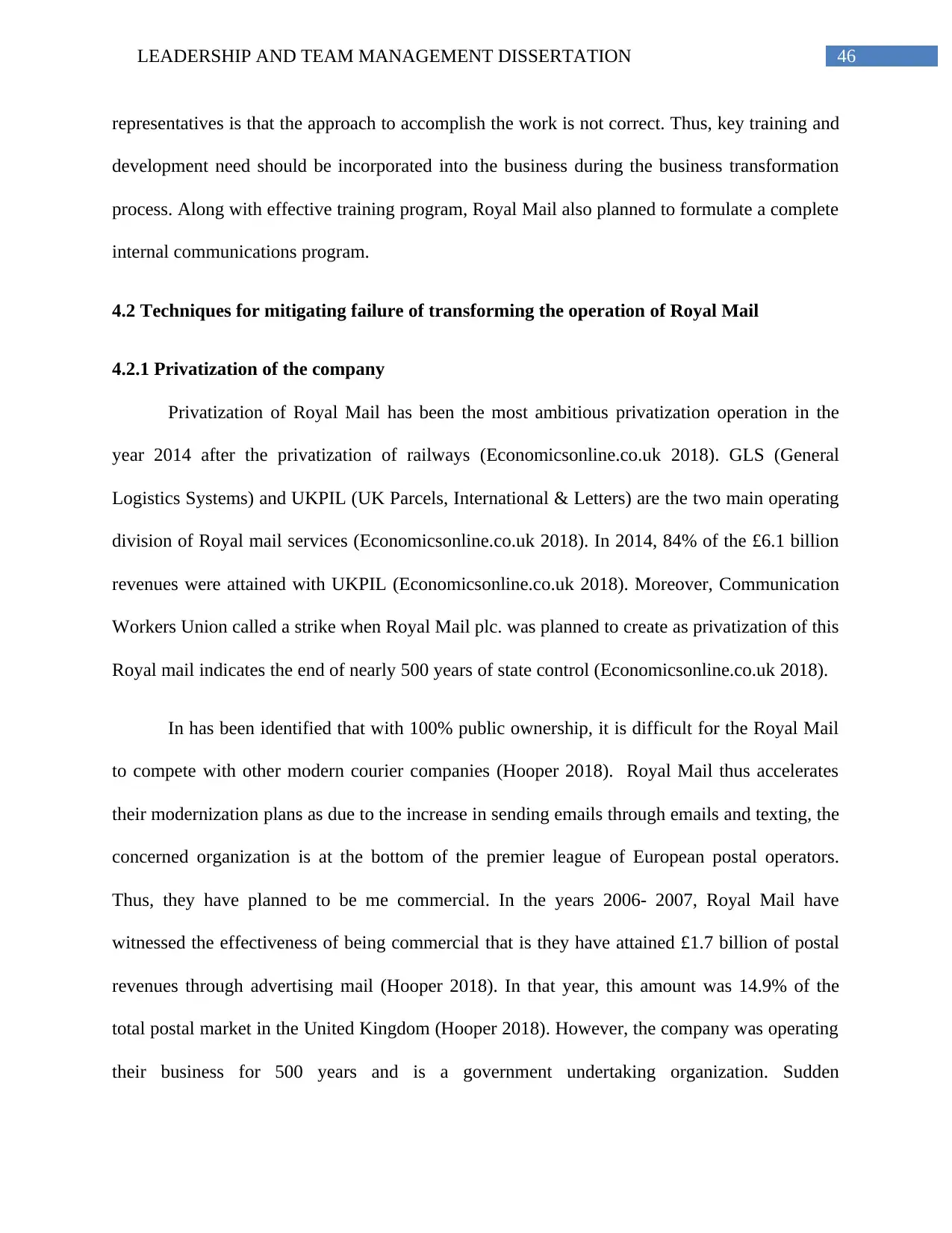
46LEADERSHIP AND TEAM MANAGEMENT DISSERTATION
representatives is that the approach to accomplish the work is not correct. Thus, key training and
development need should be incorporated into the business during the business transformation
process. Along with effective training program, Royal Mail also planned to formulate a complete
internal communications program.
4.2 Techniques for mitigating failure of transforming the operation of Royal Mail
4.2.1 Privatization of the company
Privatization of Royal Mail has been the most ambitious privatization operation in the
year 2014 after the privatization of railways (Economicsonline.co.uk 2018). GLS (General
Logistics Systems) and UKPIL (UK Parcels, International & Letters) are the two main operating
division of Royal mail services (Economicsonline.co.uk 2018). In 2014, 84% of the £6.1 billion
revenues were attained with UKPIL (Economicsonline.co.uk 2018). Moreover, Communication
Workers Union called a strike when Royal Mail plc. was planned to create as privatization of this
Royal mail indicates the end of nearly 500 years of state control (Economicsonline.co.uk 2018).
In has been identified that with 100% public ownership, it is difficult for the Royal Mail
to compete with other modern courier companies (Hooper 2018). Royal Mail thus accelerates
their modernization plans as due to the increase in sending emails through emails and texting, the
concerned organization is at the bottom of the premier league of European postal operators.
Thus, they have planned to be me commercial. In the years 2006- 2007, Royal Mail have
witnessed the effectiveness of being commercial that is they have attained £1.7 billion of postal
revenues through advertising mail (Hooper 2018). In that year, this amount was 14.9% of the
total postal market in the United Kingdom (Hooper 2018). However, the company was operating
their business for 500 years and is a government undertaking organization. Sudden
representatives is that the approach to accomplish the work is not correct. Thus, key training and
development need should be incorporated into the business during the business transformation
process. Along with effective training program, Royal Mail also planned to formulate a complete
internal communications program.
4.2 Techniques for mitigating failure of transforming the operation of Royal Mail
4.2.1 Privatization of the company
Privatization of Royal Mail has been the most ambitious privatization operation in the
year 2014 after the privatization of railways (Economicsonline.co.uk 2018). GLS (General
Logistics Systems) and UKPIL (UK Parcels, International & Letters) are the two main operating
division of Royal mail services (Economicsonline.co.uk 2018). In 2014, 84% of the £6.1 billion
revenues were attained with UKPIL (Economicsonline.co.uk 2018). Moreover, Communication
Workers Union called a strike when Royal Mail plc. was planned to create as privatization of this
Royal mail indicates the end of nearly 500 years of state control (Economicsonline.co.uk 2018).
In has been identified that with 100% public ownership, it is difficult for the Royal Mail
to compete with other modern courier companies (Hooper 2018). Royal Mail thus accelerates
their modernization plans as due to the increase in sending emails through emails and texting, the
concerned organization is at the bottom of the premier league of European postal operators.
Thus, they have planned to be me commercial. In the years 2006- 2007, Royal Mail have
witnessed the effectiveness of being commercial that is they have attained £1.7 billion of postal
revenues through advertising mail (Hooper 2018). In that year, this amount was 14.9% of the
total postal market in the United Kingdom (Hooper 2018). However, the company was operating
their business for 500 years and is a government undertaking organization. Sudden
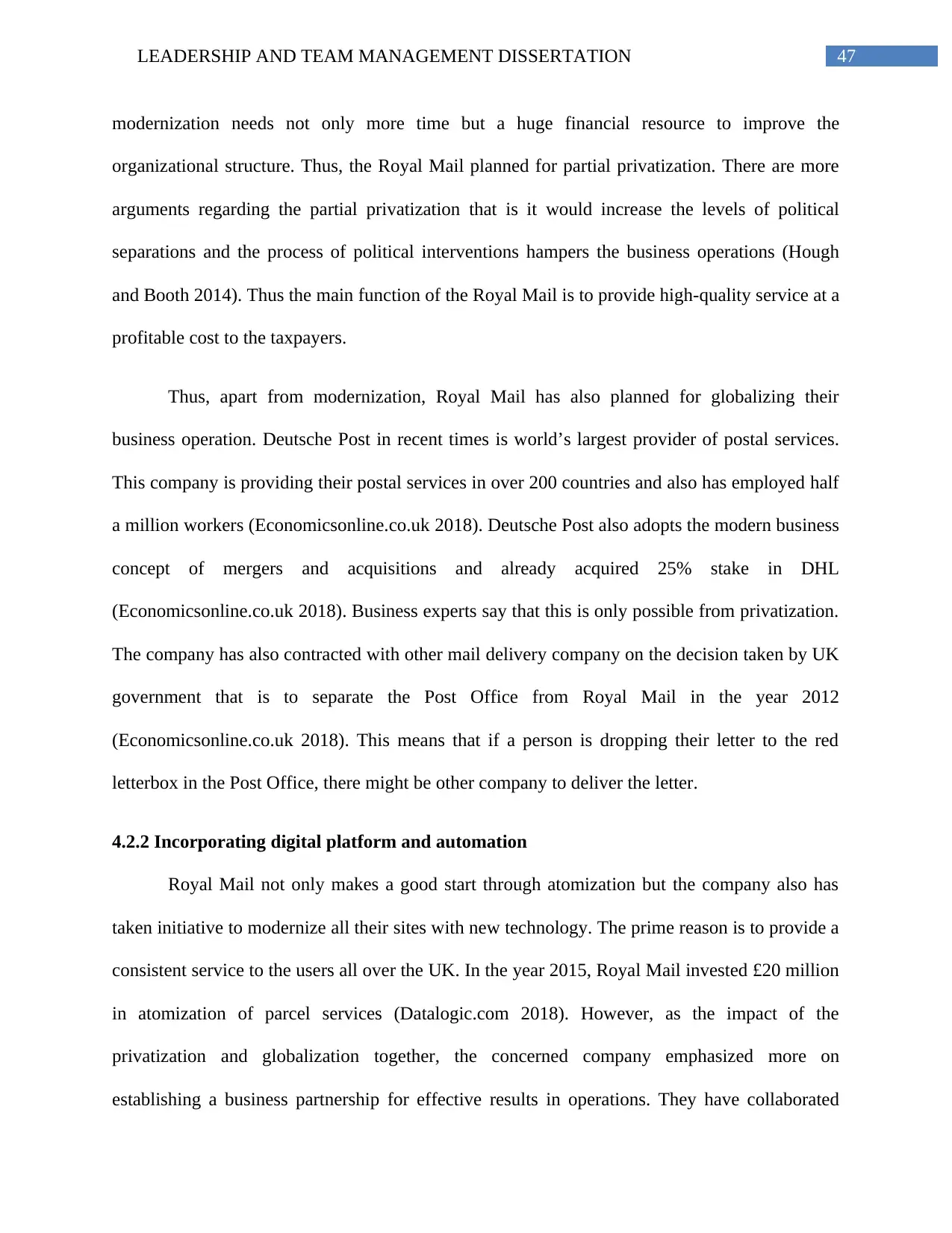
47LEADERSHIP AND TEAM MANAGEMENT DISSERTATION
modernization needs not only more time but a huge financial resource to improve the
organizational structure. Thus, the Royal Mail planned for partial privatization. There are more
arguments regarding the partial privatization that is it would increase the levels of political
separations and the process of political interventions hampers the business operations (Hough
and Booth 2014). Thus the main function of the Royal Mail is to provide high-quality service at a
profitable cost to the taxpayers.
Thus, apart from modernization, Royal Mail has also planned for globalizing their
business operation. Deutsche Post in recent times is world’s largest provider of postal services.
This company is providing their postal services in over 200 countries and also has employed half
a million workers (Economicsonline.co.uk 2018). Deutsche Post also adopts the modern business
concept of mergers and acquisitions and already acquired 25% stake in DHL
(Economicsonline.co.uk 2018). Business experts say that this is only possible from privatization.
The company has also contracted with other mail delivery company on the decision taken by UK
government that is to separate the Post Office from Royal Mail in the year 2012
(Economicsonline.co.uk 2018). This means that if a person is dropping their letter to the red
letterbox in the Post Office, there might be other company to deliver the letter.
4.2.2 Incorporating digital platform and automation
Royal Mail not only makes a good start through atomization but the company also has
taken initiative to modernize all their sites with new technology. The prime reason is to provide a
consistent service to the users all over the UK. In the year 2015, Royal Mail invested £20 million
in atomization of parcel services (Datalogic.com 2018). However, as the impact of the
privatization and globalization together, the concerned company emphasized more on
establishing a business partnership for effective results in operations. They have collaborated
modernization needs not only more time but a huge financial resource to improve the
organizational structure. Thus, the Royal Mail planned for partial privatization. There are more
arguments regarding the partial privatization that is it would increase the levels of political
separations and the process of political interventions hampers the business operations (Hough
and Booth 2014). Thus the main function of the Royal Mail is to provide high-quality service at a
profitable cost to the taxpayers.
Thus, apart from modernization, Royal Mail has also planned for globalizing their
business operation. Deutsche Post in recent times is world’s largest provider of postal services.
This company is providing their postal services in over 200 countries and also has employed half
a million workers (Economicsonline.co.uk 2018). Deutsche Post also adopts the modern business
concept of mergers and acquisitions and already acquired 25% stake in DHL
(Economicsonline.co.uk 2018). Business experts say that this is only possible from privatization.
The company has also contracted with other mail delivery company on the decision taken by UK
government that is to separate the Post Office from Royal Mail in the year 2012
(Economicsonline.co.uk 2018). This means that if a person is dropping their letter to the red
letterbox in the Post Office, there might be other company to deliver the letter.
4.2.2 Incorporating digital platform and automation
Royal Mail not only makes a good start through atomization but the company also has
taken initiative to modernize all their sites with new technology. The prime reason is to provide a
consistent service to the users all over the UK. In the year 2015, Royal Mail invested £20 million
in atomization of parcel services (Datalogic.com 2018). However, as the impact of the
privatization and globalization together, the concerned company emphasized more on
establishing a business partnership for effective results in operations. They have collaborated
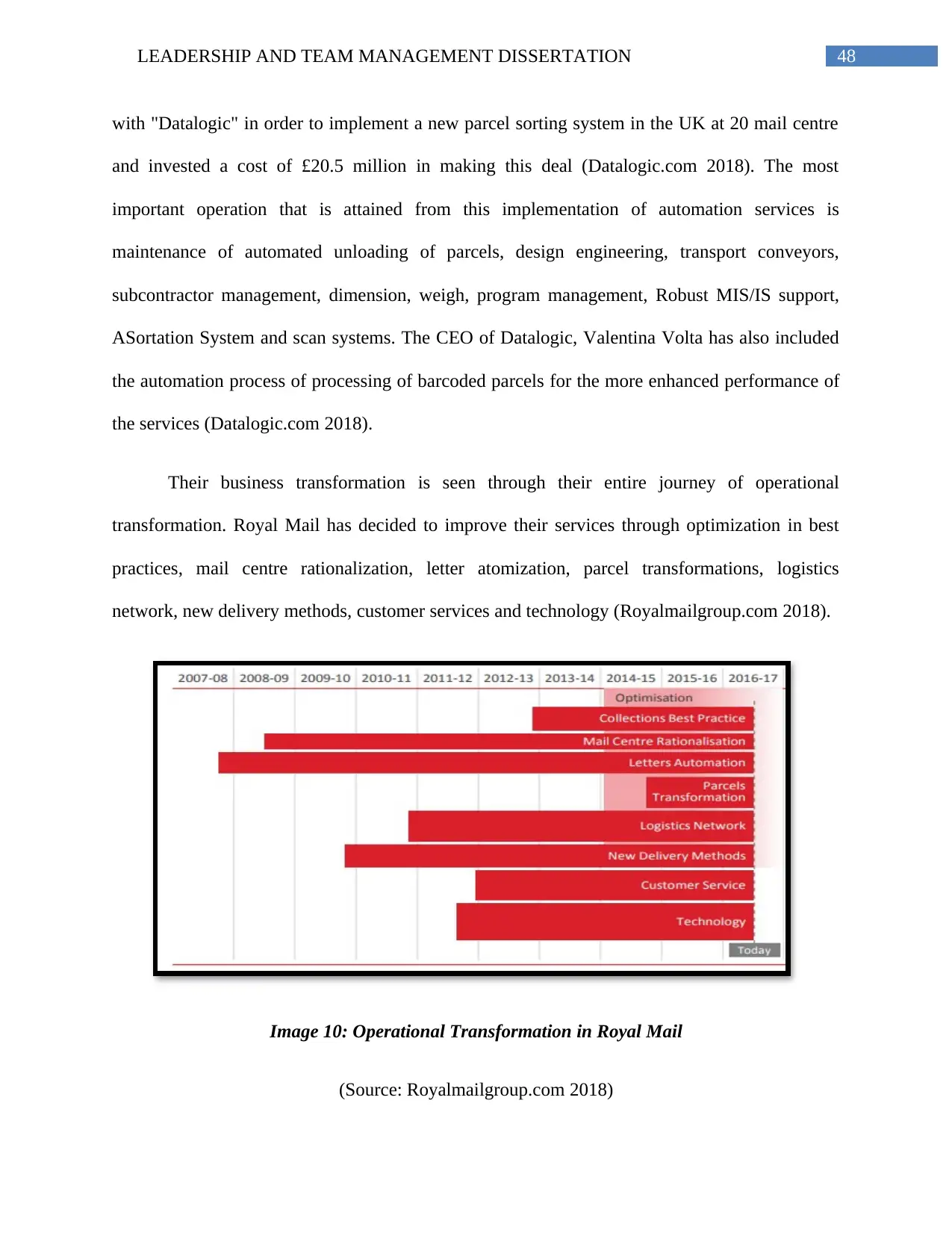
48LEADERSHIP AND TEAM MANAGEMENT DISSERTATION
with "Datalogic" in order to implement a new parcel sorting system in the UK at 20 mail centre
and invested a cost of £20.5 million in making this deal (Datalogic.com 2018). The most
important operation that is attained from this implementation of automation services is
maintenance of automated unloading of parcels, design engineering, transport conveyors,
subcontractor management, dimension, weigh, program management, Robust MIS/IS support,
ASortation System and scan systems. The CEO of Datalogic, Valentina Volta has also included
the automation process of processing of barcoded parcels for the more enhanced performance of
the services (Datalogic.com 2018).
Their business transformation is seen through their entire journey of operational
transformation. Royal Mail has decided to improve their services through optimization in best
practices, mail centre rationalization, letter atomization, parcel transformations, logistics
network, new delivery methods, customer services and technology (Royalmailgroup.com 2018).
Image 10: Operational Transformation in Royal Mail
(Source: Royalmailgroup.com 2018)
with "Datalogic" in order to implement a new parcel sorting system in the UK at 20 mail centre
and invested a cost of £20.5 million in making this deal (Datalogic.com 2018). The most
important operation that is attained from this implementation of automation services is
maintenance of automated unloading of parcels, design engineering, transport conveyors,
subcontractor management, dimension, weigh, program management, Robust MIS/IS support,
ASortation System and scan systems. The CEO of Datalogic, Valentina Volta has also included
the automation process of processing of barcoded parcels for the more enhanced performance of
the services (Datalogic.com 2018).
Their business transformation is seen through their entire journey of operational
transformation. Royal Mail has decided to improve their services through optimization in best
practices, mail centre rationalization, letter atomization, parcel transformations, logistics
network, new delivery methods, customer services and technology (Royalmailgroup.com 2018).
Image 10: Operational Transformation in Royal Mail
(Source: Royalmailgroup.com 2018)
Paraphrase This Document
Need a fresh take? Get an instant paraphrase of this document with our AI Paraphraser
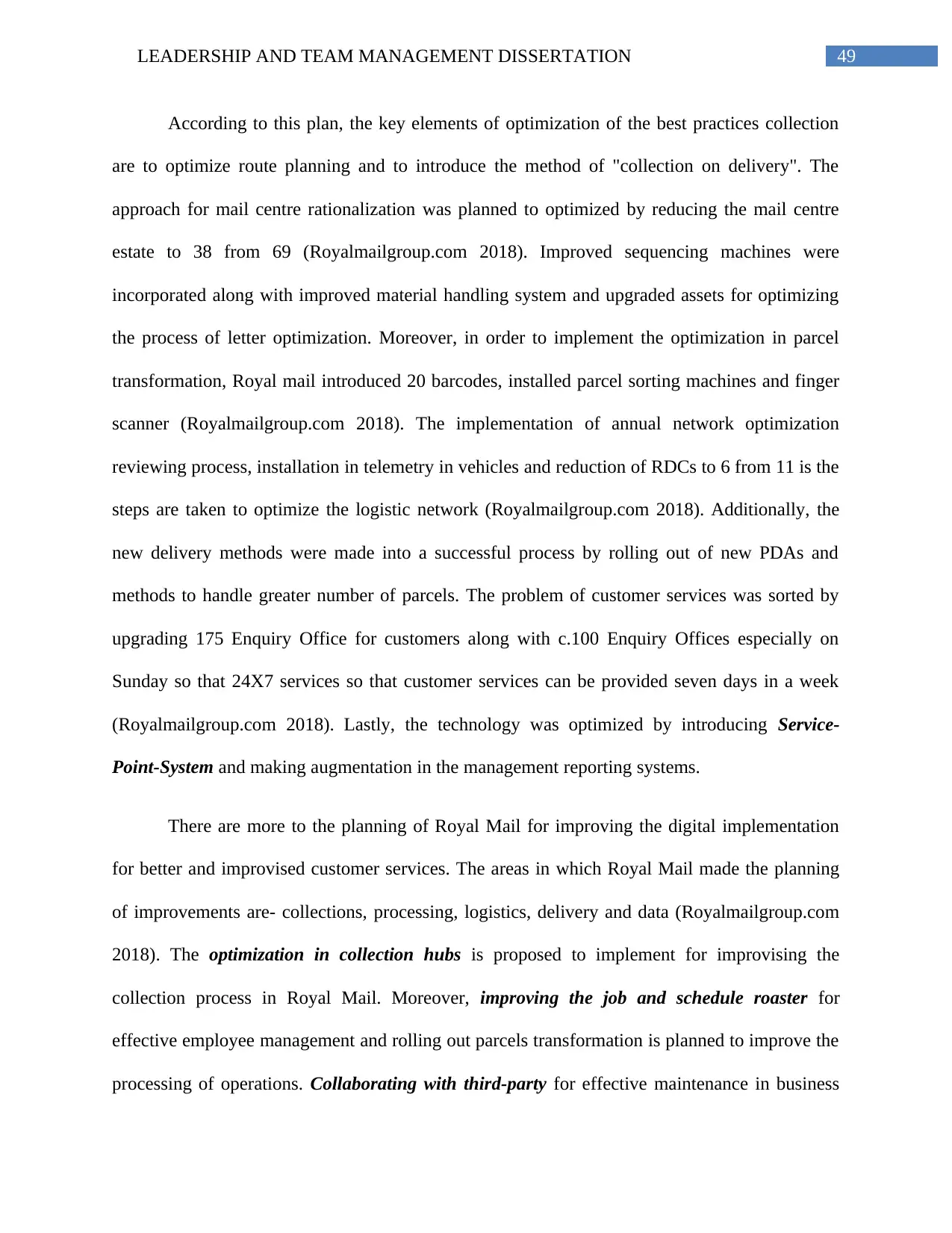
49LEADERSHIP AND TEAM MANAGEMENT DISSERTATION
According to this plan, the key elements of optimization of the best practices collection
are to optimize route planning and to introduce the method of "collection on delivery". The
approach for mail centre rationalization was planned to optimized by reducing the mail centre
estate to 38 from 69 (Royalmailgroup.com 2018). Improved sequencing machines were
incorporated along with improved material handling system and upgraded assets for optimizing
the process of letter optimization. Moreover, in order to implement the optimization in parcel
transformation, Royal mail introduced 20 barcodes, installed parcel sorting machines and finger
scanner (Royalmailgroup.com 2018). The implementation of annual network optimization
reviewing process, installation in telemetry in vehicles and reduction of RDCs to 6 from 11 is the
steps are taken to optimize the logistic network (Royalmailgroup.com 2018). Additionally, the
new delivery methods were made into a successful process by rolling out of new PDAs and
methods to handle greater number of parcels. The problem of customer services was sorted by
upgrading 175 Enquiry Office for customers along with c.100 Enquiry Offices especially on
Sunday so that 24X7 services so that customer services can be provided seven days in a week
(Royalmailgroup.com 2018). Lastly, the technology was optimized by introducing Service-
Point-System and making augmentation in the management reporting systems.
There are more to the planning of Royal Mail for improving the digital implementation
for better and improvised customer services. The areas in which Royal Mail made the planning
of improvements are- collections, processing, logistics, delivery and data (Royalmailgroup.com
2018). The optimization in collection hubs is proposed to implement for improvising the
collection process in Royal Mail. Moreover, improving the job and schedule roaster for
effective employee management and rolling out parcels transformation is planned to improve the
processing of operations. Collaborating with third-party for effective maintenance in business
According to this plan, the key elements of optimization of the best practices collection
are to optimize route planning and to introduce the method of "collection on delivery". The
approach for mail centre rationalization was planned to optimized by reducing the mail centre
estate to 38 from 69 (Royalmailgroup.com 2018). Improved sequencing machines were
incorporated along with improved material handling system and upgraded assets for optimizing
the process of letter optimization. Moreover, in order to implement the optimization in parcel
transformation, Royal mail introduced 20 barcodes, installed parcel sorting machines and finger
scanner (Royalmailgroup.com 2018). The implementation of annual network optimization
reviewing process, installation in telemetry in vehicles and reduction of RDCs to 6 from 11 is the
steps are taken to optimize the logistic network (Royalmailgroup.com 2018). Additionally, the
new delivery methods were made into a successful process by rolling out of new PDAs and
methods to handle greater number of parcels. The problem of customer services was sorted by
upgrading 175 Enquiry Office for customers along with c.100 Enquiry Offices especially on
Sunday so that 24X7 services so that customer services can be provided seven days in a week
(Royalmailgroup.com 2018). Lastly, the technology was optimized by introducing Service-
Point-System and making augmentation in the management reporting systems.
There are more to the planning of Royal Mail for improving the digital implementation
for better and improvised customer services. The areas in which Royal Mail made the planning
of improvements are- collections, processing, logistics, delivery and data (Royalmailgroup.com
2018). The optimization in collection hubs is proposed to implement for improvising the
collection process in Royal Mail. Moreover, improving the job and schedule roaster for
effective employee management and rolling out parcels transformation is planned to improve the
processing of operations. Collaborating with third-party for effective maintenance in business
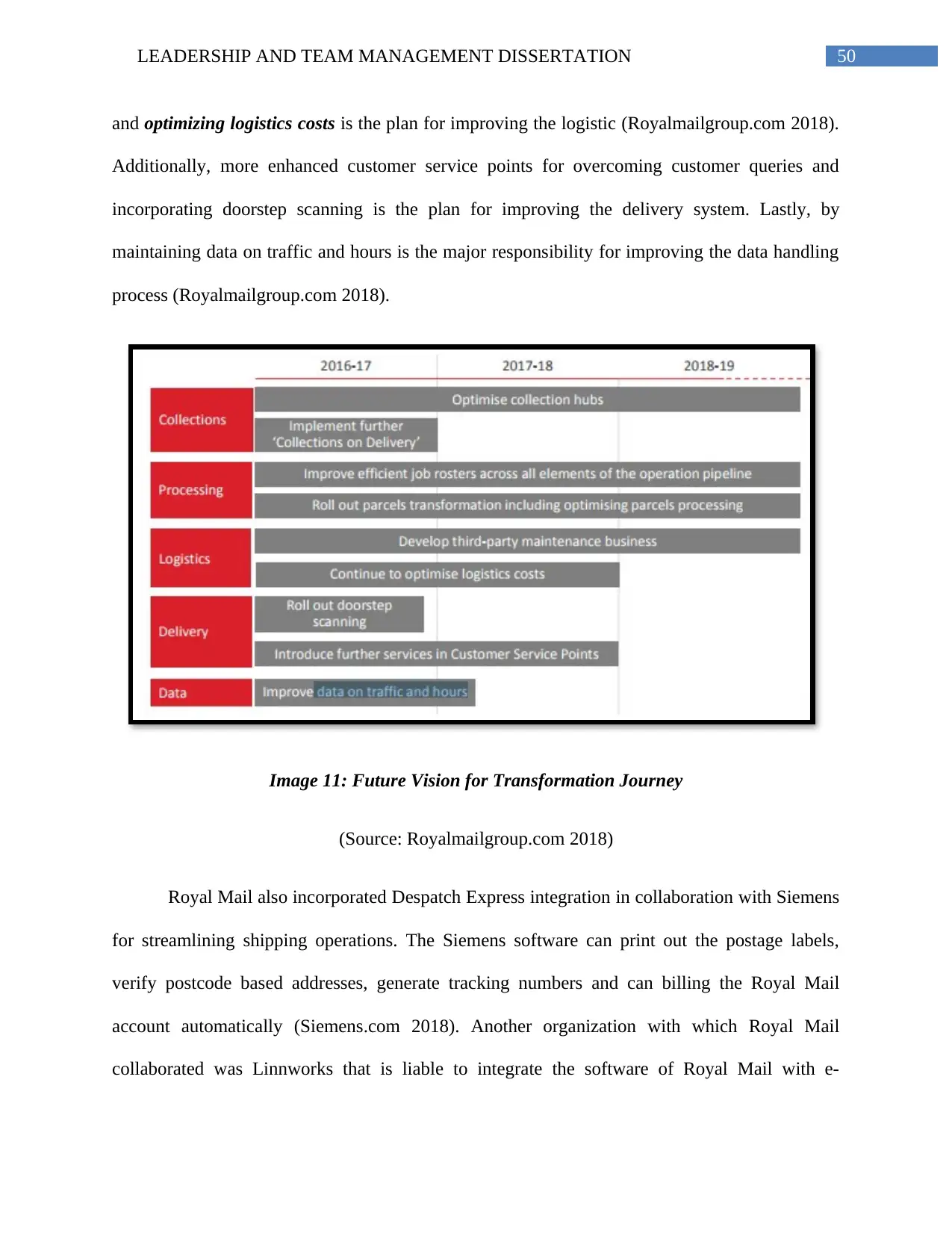
50LEADERSHIP AND TEAM MANAGEMENT DISSERTATION
and optimizing logistics costs is the plan for improving the logistic (Royalmailgroup.com 2018).
Additionally, more enhanced customer service points for overcoming customer queries and
incorporating doorstep scanning is the plan for improving the delivery system. Lastly, by
maintaining data on traffic and hours is the major responsibility for improving the data handling
process (Royalmailgroup.com 2018).
Image 11: Future Vision for Transformation Journey
(Source: Royalmailgroup.com 2018)
Royal Mail also incorporated Despatch Express integration in collaboration with Siemens
for streamlining shipping operations. The Siemens software can print out the postage labels,
verify postcode based addresses, generate tracking numbers and can billing the Royal Mail
account automatically (Siemens.com 2018). Another organization with which Royal Mail
collaborated was Linnworks that is liable to integrate the software of Royal Mail with e-
and optimizing logistics costs is the plan for improving the logistic (Royalmailgroup.com 2018).
Additionally, more enhanced customer service points for overcoming customer queries and
incorporating doorstep scanning is the plan for improving the delivery system. Lastly, by
maintaining data on traffic and hours is the major responsibility for improving the data handling
process (Royalmailgroup.com 2018).
Image 11: Future Vision for Transformation Journey
(Source: Royalmailgroup.com 2018)
Royal Mail also incorporated Despatch Express integration in collaboration with Siemens
for streamlining shipping operations. The Siemens software can print out the postage labels,
verify postcode based addresses, generate tracking numbers and can billing the Royal Mail
account automatically (Siemens.com 2018). Another organization with which Royal Mail
collaborated was Linnworks that is liable to integrate the software of Royal Mail with e-
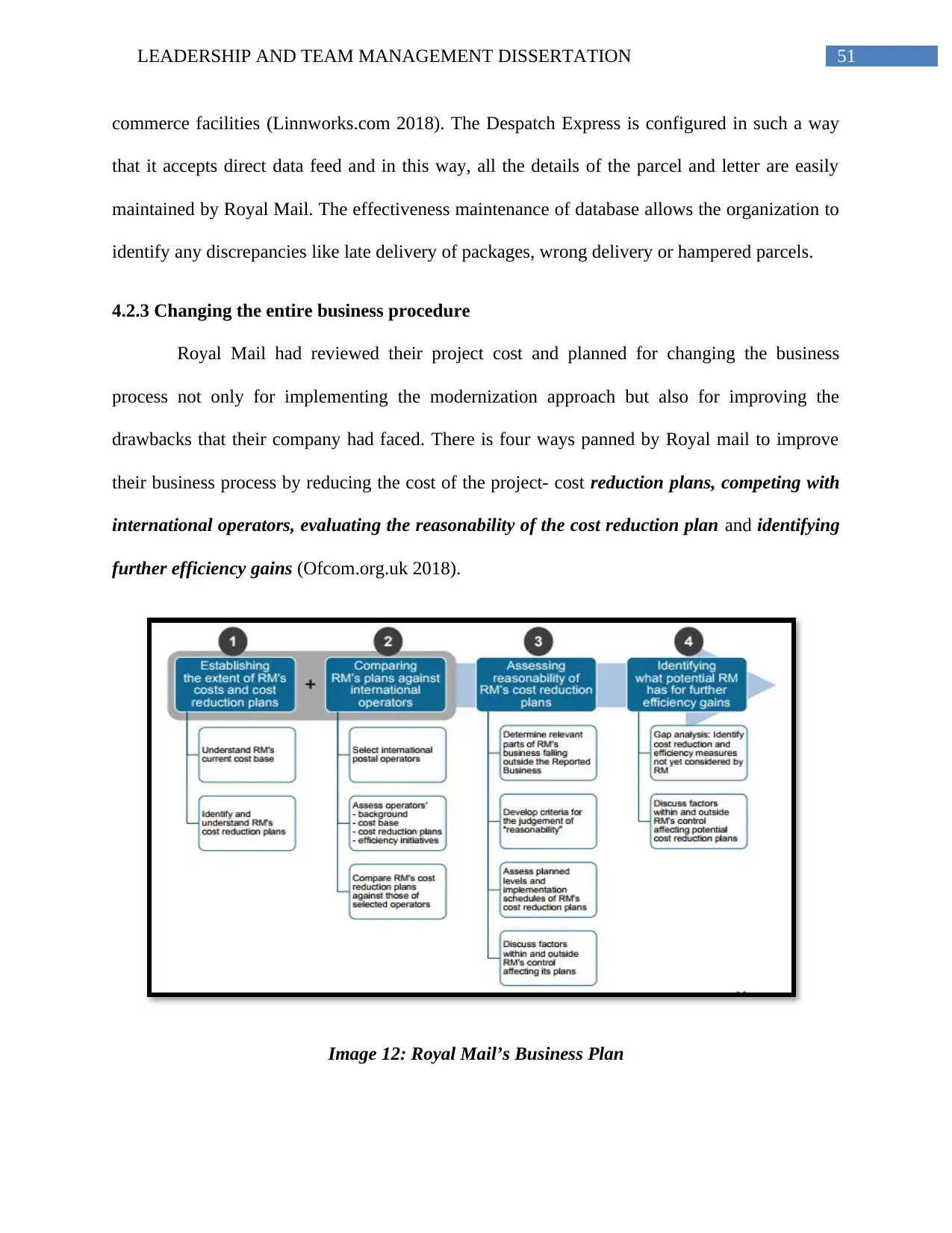
51LEADERSHIP AND TEAM MANAGEMENT DISSERTATION
commerce facilities (Linnworks.com 2018). The Despatch Express is configured in such a way
that it accepts direct data feed and in this way, all the details of the parcel and letter are easily
maintained by Royal Mail. The effectiveness maintenance of database allows the organization to
identify any discrepancies like late delivery of packages, wrong delivery or hampered parcels.
4.2.3 Changing the entire business procedure
Royal Mail had reviewed their project cost and planned for changing the business
process not only for implementing the modernization approach but also for improving the
drawbacks that their company had faced. There is four ways panned by Royal mail to improve
their business process by reducing the cost of the project- cost reduction plans, competing with
international operators, evaluating the reasonability of the cost reduction plan and identifying
further efficiency gains (Ofcom.org.uk 2018).
Image 12: Royal Mail’s Business Plan
commerce facilities (Linnworks.com 2018). The Despatch Express is configured in such a way
that it accepts direct data feed and in this way, all the details of the parcel and letter are easily
maintained by Royal Mail. The effectiveness maintenance of database allows the organization to
identify any discrepancies like late delivery of packages, wrong delivery or hampered parcels.
4.2.3 Changing the entire business procedure
Royal Mail had reviewed their project cost and planned for changing the business
process not only for implementing the modernization approach but also for improving the
drawbacks that their company had faced. There is four ways panned by Royal mail to improve
their business process by reducing the cost of the project- cost reduction plans, competing with
international operators, evaluating the reasonability of the cost reduction plan and identifying
further efficiency gains (Ofcom.org.uk 2018).
Image 12: Royal Mail’s Business Plan
Secure Best Marks with AI Grader
Need help grading? Try our AI Grader for instant feedback on your assignments.
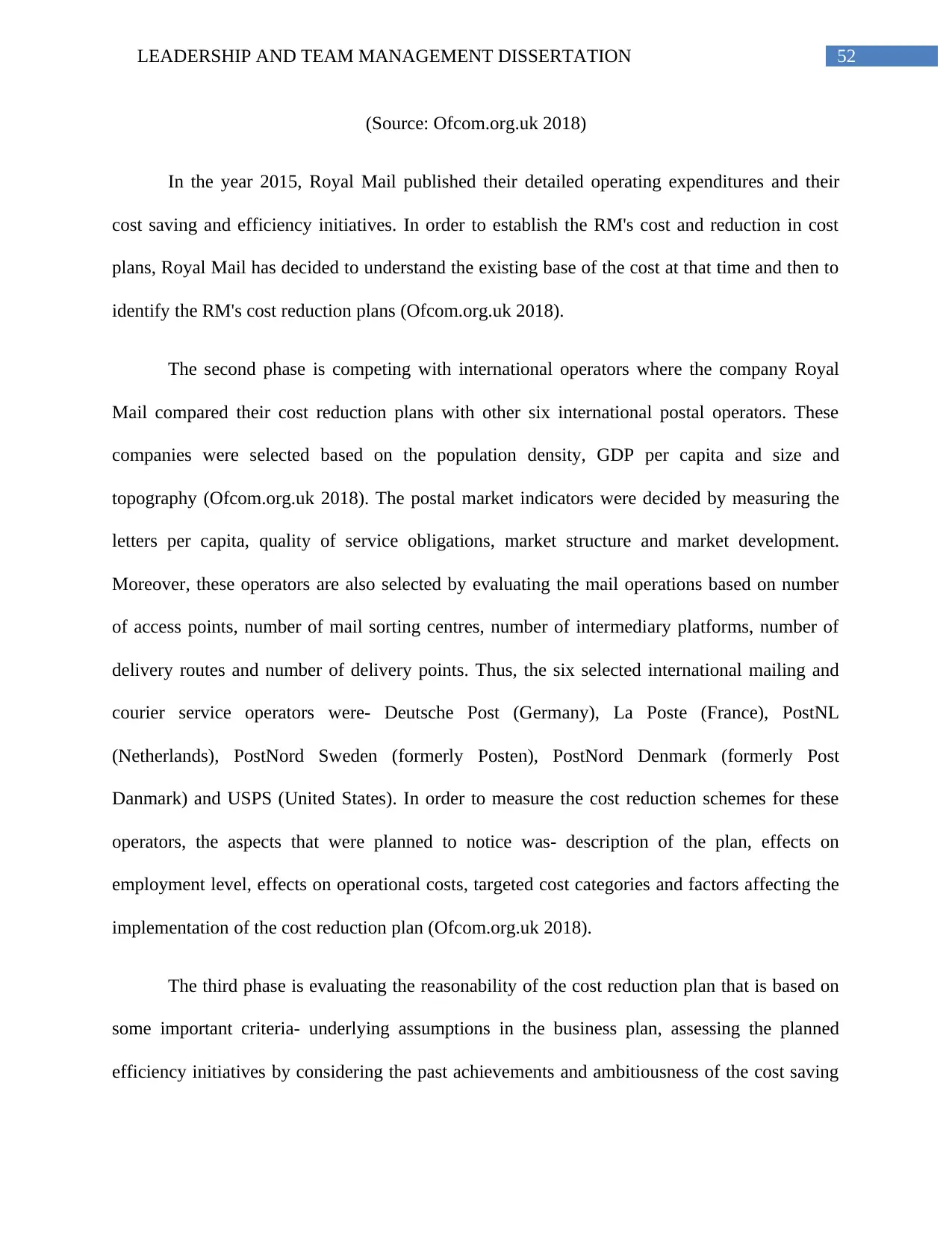
52LEADERSHIP AND TEAM MANAGEMENT DISSERTATION
(Source: Ofcom.org.uk 2018)
In the year 2015, Royal Mail published their detailed operating expenditures and their
cost saving and efficiency initiatives. In order to establish the RM's cost and reduction in cost
plans, Royal Mail has decided to understand the existing base of the cost at that time and then to
identify the RM's cost reduction plans (Ofcom.org.uk 2018).
The second phase is competing with international operators where the company Royal
Mail compared their cost reduction plans with other six international postal operators. These
companies were selected based on the population density, GDP per capita and size and
topography (Ofcom.org.uk 2018). The postal market indicators were decided by measuring the
letters per capita, quality of service obligations, market structure and market development.
Moreover, these operators are also selected by evaluating the mail operations based on number
of access points, number of mail sorting centres, number of intermediary platforms, number of
delivery routes and number of delivery points. Thus, the six selected international mailing and
courier service operators were- Deutsche Post (Germany), La Poste (France), PostNL
(Netherlands), PostNord Sweden (formerly Posten), PostNord Denmark (formerly Post
Danmark) and USPS (United States). In order to measure the cost reduction schemes for these
operators, the aspects that were planned to notice was- description of the plan, effects on
employment level, effects on operational costs, targeted cost categories and factors affecting the
implementation of the cost reduction plan (Ofcom.org.uk 2018).
The third phase is evaluating the reasonability of the cost reduction plan that is based on
some important criteria- underlying assumptions in the business plan, assessing the planned
efficiency initiatives by considering the past achievements and ambitiousness of the cost saving
(Source: Ofcom.org.uk 2018)
In the year 2015, Royal Mail published their detailed operating expenditures and their
cost saving and efficiency initiatives. In order to establish the RM's cost and reduction in cost
plans, Royal Mail has decided to understand the existing base of the cost at that time and then to
identify the RM's cost reduction plans (Ofcom.org.uk 2018).
The second phase is competing with international operators where the company Royal
Mail compared their cost reduction plans with other six international postal operators. These
companies were selected based on the population density, GDP per capita and size and
topography (Ofcom.org.uk 2018). The postal market indicators were decided by measuring the
letters per capita, quality of service obligations, market structure and market development.
Moreover, these operators are also selected by evaluating the mail operations based on number
of access points, number of mail sorting centres, number of intermediary platforms, number of
delivery routes and number of delivery points. Thus, the six selected international mailing and
courier service operators were- Deutsche Post (Germany), La Poste (France), PostNL
(Netherlands), PostNord Sweden (formerly Posten), PostNord Denmark (formerly Post
Danmark) and USPS (United States). In order to measure the cost reduction schemes for these
operators, the aspects that were planned to notice was- description of the plan, effects on
employment level, effects on operational costs, targeted cost categories and factors affecting the
implementation of the cost reduction plan (Ofcom.org.uk 2018).
The third phase is evaluating the reasonability of the cost reduction plan that is based on
some important criteria- underlying assumptions in the business plan, assessing the planned
efficiency initiatives by considering the past achievements and ambitiousness of the cost saving
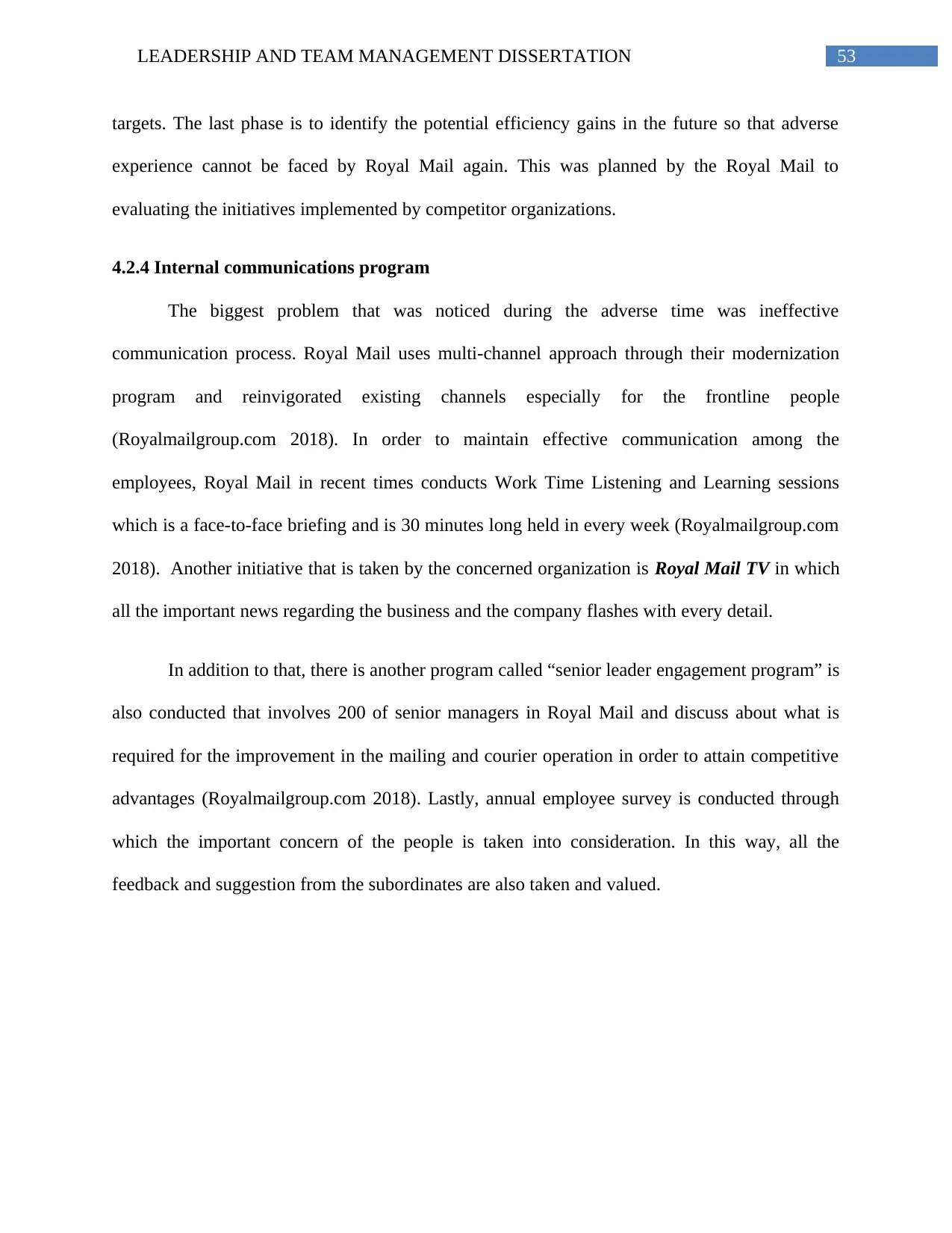
53LEADERSHIP AND TEAM MANAGEMENT DISSERTATION
targets. The last phase is to identify the potential efficiency gains in the future so that adverse
experience cannot be faced by Royal Mail again. This was planned by the Royal Mail to
evaluating the initiatives implemented by competitor organizations.
4.2.4 Internal communications program
The biggest problem that was noticed during the adverse time was ineffective
communication process. Royal Mail uses multi-channel approach through their modernization
program and reinvigorated existing channels especially for the frontline people
(Royalmailgroup.com 2018). In order to maintain effective communication among the
employees, Royal Mail in recent times conducts Work Time Listening and Learning sessions
which is a face-to-face briefing and is 30 minutes long held in every week (Royalmailgroup.com
2018). Another initiative that is taken by the concerned organization is Royal Mail TV in which
all the important news regarding the business and the company flashes with every detail.
In addition to that, there is another program called “senior leader engagement program” is
also conducted that involves 200 of senior managers in Royal Mail and discuss about what is
required for the improvement in the mailing and courier operation in order to attain competitive
advantages (Royalmailgroup.com 2018). Lastly, annual employee survey is conducted through
which the important concern of the people is taken into consideration. In this way, all the
feedback and suggestion from the subordinates are also taken and valued.
targets. The last phase is to identify the potential efficiency gains in the future so that adverse
experience cannot be faced by Royal Mail again. This was planned by the Royal Mail to
evaluating the initiatives implemented by competitor organizations.
4.2.4 Internal communications program
The biggest problem that was noticed during the adverse time was ineffective
communication process. Royal Mail uses multi-channel approach through their modernization
program and reinvigorated existing channels especially for the frontline people
(Royalmailgroup.com 2018). In order to maintain effective communication among the
employees, Royal Mail in recent times conducts Work Time Listening and Learning sessions
which is a face-to-face briefing and is 30 minutes long held in every week (Royalmailgroup.com
2018). Another initiative that is taken by the concerned organization is Royal Mail TV in which
all the important news regarding the business and the company flashes with every detail.
In addition to that, there is another program called “senior leader engagement program” is
also conducted that involves 200 of senior managers in Royal Mail and discuss about what is
required for the improvement in the mailing and courier operation in order to attain competitive
advantages (Royalmailgroup.com 2018). Lastly, annual employee survey is conducted through
which the important concern of the people is taken into consideration. In this way, all the
feedback and suggestion from the subordinates are also taken and valued.
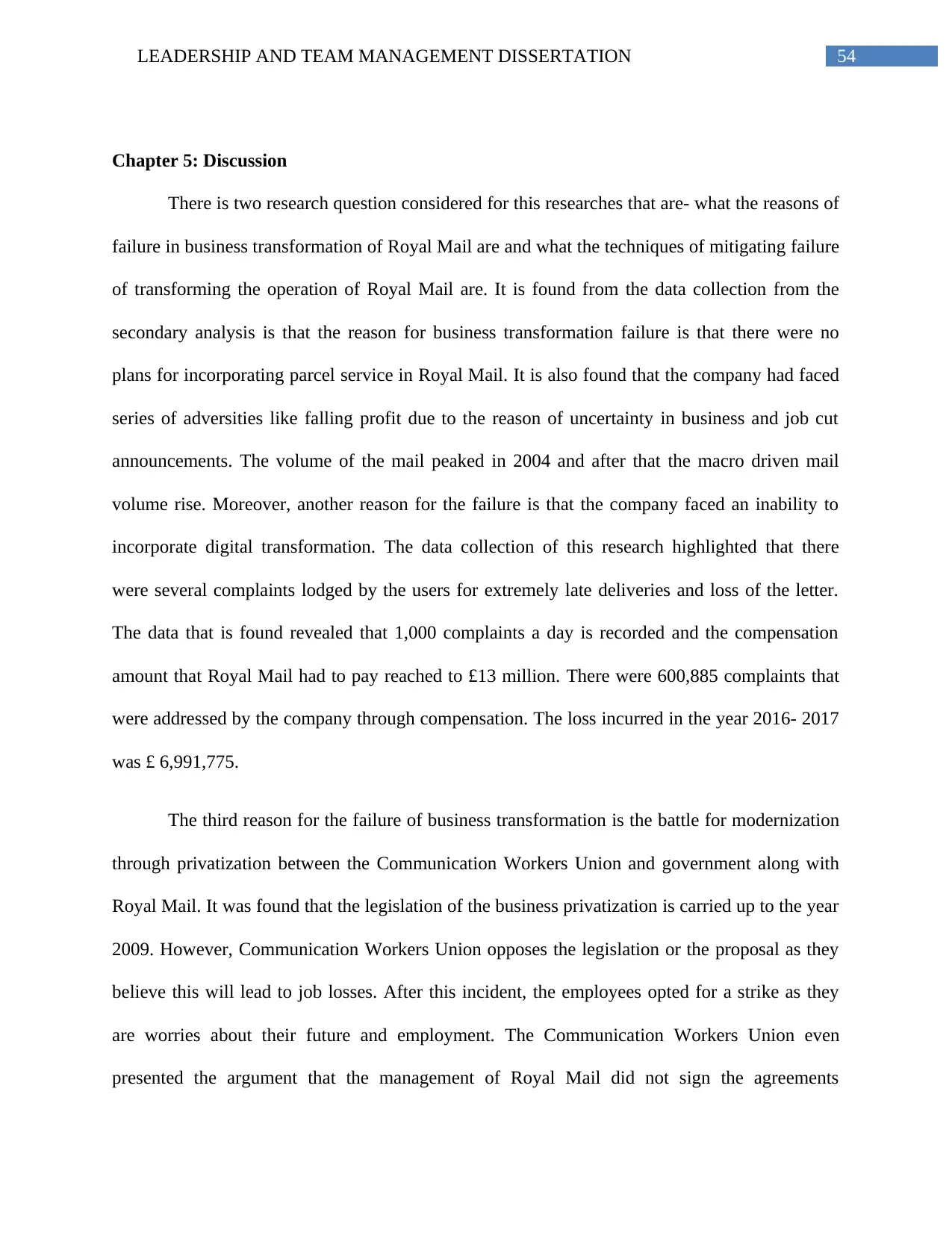
54LEADERSHIP AND TEAM MANAGEMENT DISSERTATION
Chapter 5: Discussion
There is two research question considered for this researches that are- what the reasons of
failure in business transformation of Royal Mail are and what the techniques of mitigating failure
of transforming the operation of Royal Mail are. It is found from the data collection from the
secondary analysis is that the reason for business transformation failure is that there were no
plans for incorporating parcel service in Royal Mail. It is also found that the company had faced
series of adversities like falling profit due to the reason of uncertainty in business and job cut
announcements. The volume of the mail peaked in 2004 and after that the macro driven mail
volume rise. Moreover, another reason for the failure is that the company faced an inability to
incorporate digital transformation. The data collection of this research highlighted that there
were several complaints lodged by the users for extremely late deliveries and loss of the letter.
The data that is found revealed that 1,000 complaints a day is recorded and the compensation
amount that Royal Mail had to pay reached to £13 million. There were 600,885 complaints that
were addressed by the company through compensation. The loss incurred in the year 2016- 2017
was £ 6,991,775.
The third reason for the failure of business transformation is the battle for modernization
through privatization between the Communication Workers Union and government along with
Royal Mail. It was found that the legislation of the business privatization is carried up to the year
2009. However, Communication Workers Union opposes the legislation or the proposal as they
believe this will lead to job losses. After this incident, the employees opted for a strike as they
are worries about their future and employment. The Communication Workers Union even
presented the argument that the management of Royal Mail did not sign the agreements
Chapter 5: Discussion
There is two research question considered for this researches that are- what the reasons of
failure in business transformation of Royal Mail are and what the techniques of mitigating failure
of transforming the operation of Royal Mail are. It is found from the data collection from the
secondary analysis is that the reason for business transformation failure is that there were no
plans for incorporating parcel service in Royal Mail. It is also found that the company had faced
series of adversities like falling profit due to the reason of uncertainty in business and job cut
announcements. The volume of the mail peaked in 2004 and after that the macro driven mail
volume rise. Moreover, another reason for the failure is that the company faced an inability to
incorporate digital transformation. The data collection of this research highlighted that there
were several complaints lodged by the users for extremely late deliveries and loss of the letter.
The data that is found revealed that 1,000 complaints a day is recorded and the compensation
amount that Royal Mail had to pay reached to £13 million. There were 600,885 complaints that
were addressed by the company through compensation. The loss incurred in the year 2016- 2017
was £ 6,991,775.
The third reason for the failure of business transformation is the battle for modernization
through privatization between the Communication Workers Union and government along with
Royal Mail. It was found that the legislation of the business privatization is carried up to the year
2009. However, Communication Workers Union opposes the legislation or the proposal as they
believe this will lead to job losses. After this incident, the employees opted for a strike as they
are worries about their future and employment. The Communication Workers Union even
presented the argument that the management of Royal Mail did not sign the agreements
Paraphrase This Document
Need a fresh take? Get an instant paraphrase of this document with our AI Paraphraser
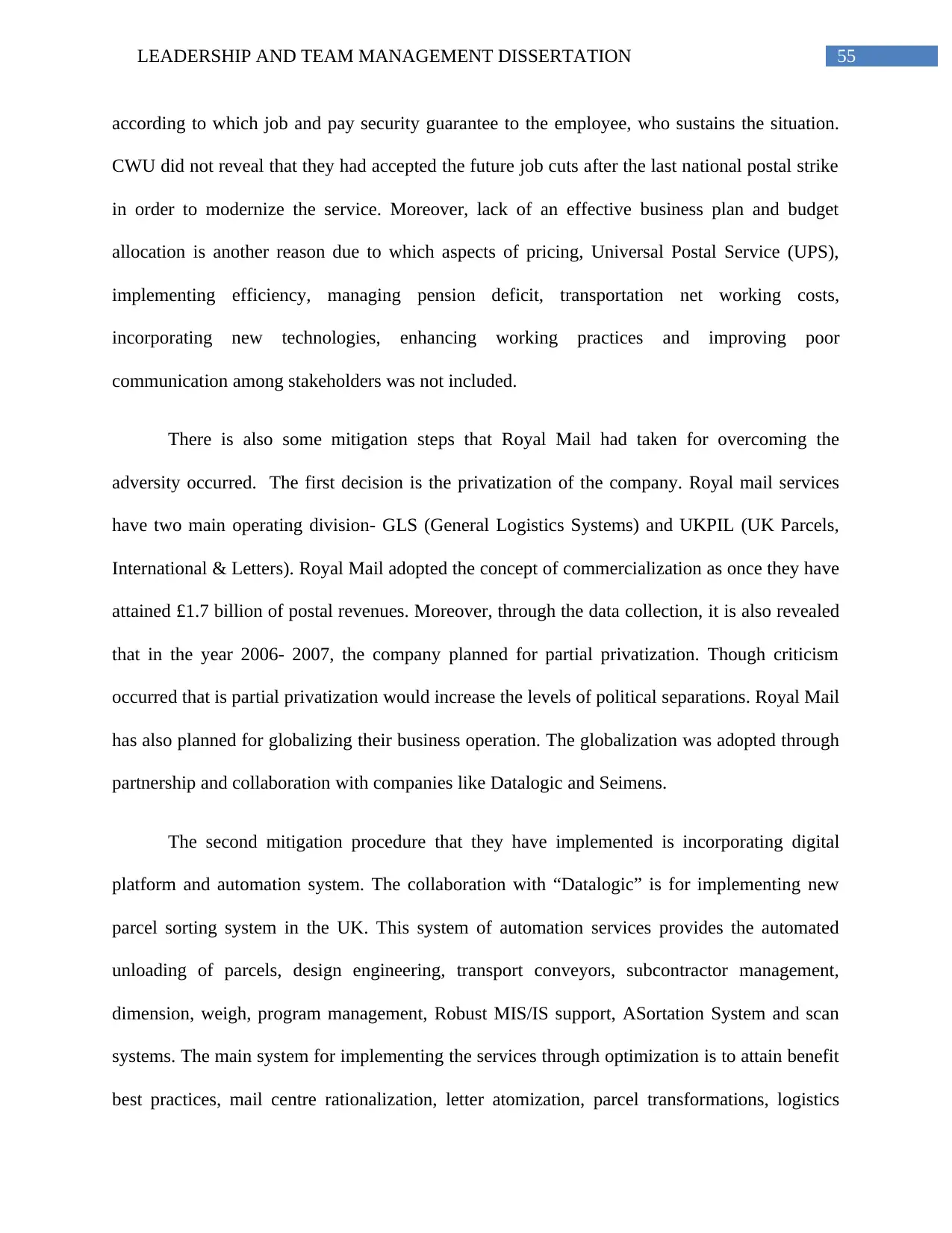
55LEADERSHIP AND TEAM MANAGEMENT DISSERTATION
according to which job and pay security guarantee to the employee, who sustains the situation.
CWU did not reveal that they had accepted the future job cuts after the last national postal strike
in order to modernize the service. Moreover, lack of an effective business plan and budget
allocation is another reason due to which aspects of pricing, Universal Postal Service (UPS),
implementing efficiency, managing pension deficit, transportation net working costs,
incorporating new technologies, enhancing working practices and improving poor
communication among stakeholders was not included.
There is also some mitigation steps that Royal Mail had taken for overcoming the
adversity occurred. The first decision is the privatization of the company. Royal mail services
have two main operating division- GLS (General Logistics Systems) and UKPIL (UK Parcels,
International & Letters). Royal Mail adopted the concept of commercialization as once they have
attained £1.7 billion of postal revenues. Moreover, through the data collection, it is also revealed
that in the year 2006- 2007, the company planned for partial privatization. Though criticism
occurred that is partial privatization would increase the levels of political separations. Royal Mail
has also planned for globalizing their business operation. The globalization was adopted through
partnership and collaboration with companies like Datalogic and Seimens.
The second mitigation procedure that they have implemented is incorporating digital
platform and automation system. The collaboration with “Datalogic” is for implementing new
parcel sorting system in the UK. This system of automation services provides the automated
unloading of parcels, design engineering, transport conveyors, subcontractor management,
dimension, weigh, program management, Robust MIS/IS support, ASortation System and scan
systems. The main system for implementing the services through optimization is to attain benefit
best practices, mail centre rationalization, letter atomization, parcel transformations, logistics
according to which job and pay security guarantee to the employee, who sustains the situation.
CWU did not reveal that they had accepted the future job cuts after the last national postal strike
in order to modernize the service. Moreover, lack of an effective business plan and budget
allocation is another reason due to which aspects of pricing, Universal Postal Service (UPS),
implementing efficiency, managing pension deficit, transportation net working costs,
incorporating new technologies, enhancing working practices and improving poor
communication among stakeholders was not included.
There is also some mitigation steps that Royal Mail had taken for overcoming the
adversity occurred. The first decision is the privatization of the company. Royal mail services
have two main operating division- GLS (General Logistics Systems) and UKPIL (UK Parcels,
International & Letters). Royal Mail adopted the concept of commercialization as once they have
attained £1.7 billion of postal revenues. Moreover, through the data collection, it is also revealed
that in the year 2006- 2007, the company planned for partial privatization. Though criticism
occurred that is partial privatization would increase the levels of political separations. Royal Mail
has also planned for globalizing their business operation. The globalization was adopted through
partnership and collaboration with companies like Datalogic and Seimens.
The second mitigation procedure that they have implemented is incorporating digital
platform and automation system. The collaboration with “Datalogic” is for implementing new
parcel sorting system in the UK. This system of automation services provides the automated
unloading of parcels, design engineering, transport conveyors, subcontractor management,
dimension, weigh, program management, Robust MIS/IS support, ASortation System and scan
systems. The main system for implementing the services through optimization is to attain benefit
best practices, mail centre rationalization, letter atomization, parcel transformations, logistics
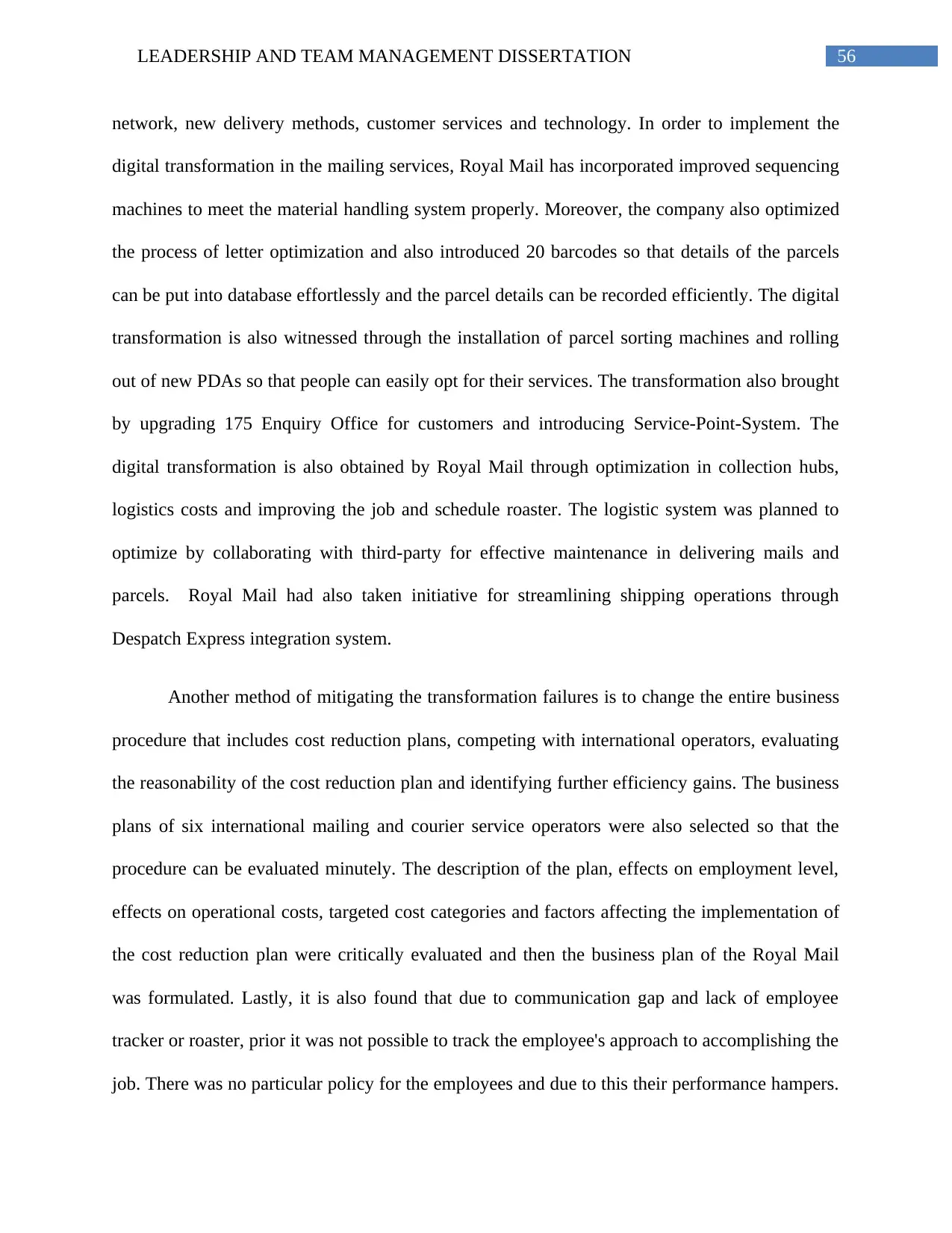
56LEADERSHIP AND TEAM MANAGEMENT DISSERTATION
network, new delivery methods, customer services and technology. In order to implement the
digital transformation in the mailing services, Royal Mail has incorporated improved sequencing
machines to meet the material handling system properly. Moreover, the company also optimized
the process of letter optimization and also introduced 20 barcodes so that details of the parcels
can be put into database effortlessly and the parcel details can be recorded efficiently. The digital
transformation is also witnessed through the installation of parcel sorting machines and rolling
out of new PDAs so that people can easily opt for their services. The transformation also brought
by upgrading 175 Enquiry Office for customers and introducing Service-Point-System. The
digital transformation is also obtained by Royal Mail through optimization in collection hubs,
logistics costs and improving the job and schedule roaster. The logistic system was planned to
optimize by collaborating with third-party for effective maintenance in delivering mails and
parcels. Royal Mail had also taken initiative for streamlining shipping operations through
Despatch Express integration system.
Another method of mitigating the transformation failures is to change the entire business
procedure that includes cost reduction plans, competing with international operators, evaluating
the reasonability of the cost reduction plan and identifying further efficiency gains. The business
plans of six international mailing and courier service operators were also selected so that the
procedure can be evaluated minutely. The description of the plan, effects on employment level,
effects on operational costs, targeted cost categories and factors affecting the implementation of
the cost reduction plan were critically evaluated and then the business plan of the Royal Mail
was formulated. Lastly, it is also found that due to communication gap and lack of employee
tracker or roaster, prior it was not possible to track the employee's approach to accomplishing the
job. There was no particular policy for the employees and due to this their performance hampers.
network, new delivery methods, customer services and technology. In order to implement the
digital transformation in the mailing services, Royal Mail has incorporated improved sequencing
machines to meet the material handling system properly. Moreover, the company also optimized
the process of letter optimization and also introduced 20 barcodes so that details of the parcels
can be put into database effortlessly and the parcel details can be recorded efficiently. The digital
transformation is also witnessed through the installation of parcel sorting machines and rolling
out of new PDAs so that people can easily opt for their services. The transformation also brought
by upgrading 175 Enquiry Office for customers and introducing Service-Point-System. The
digital transformation is also obtained by Royal Mail through optimization in collection hubs,
logistics costs and improving the job and schedule roaster. The logistic system was planned to
optimize by collaborating with third-party for effective maintenance in delivering mails and
parcels. Royal Mail had also taken initiative for streamlining shipping operations through
Despatch Express integration system.
Another method of mitigating the transformation failures is to change the entire business
procedure that includes cost reduction plans, competing with international operators, evaluating
the reasonability of the cost reduction plan and identifying further efficiency gains. The business
plans of six international mailing and courier service operators were also selected so that the
procedure can be evaluated minutely. The description of the plan, effects on employment level,
effects on operational costs, targeted cost categories and factors affecting the implementation of
the cost reduction plan were critically evaluated and then the business plan of the Royal Mail
was formulated. Lastly, it is also found that due to communication gap and lack of employee
tracker or roaster, prior it was not possible to track the employee's approach to accomplishing the
job. There was no particular policy for the employees and due to this their performance hampers.
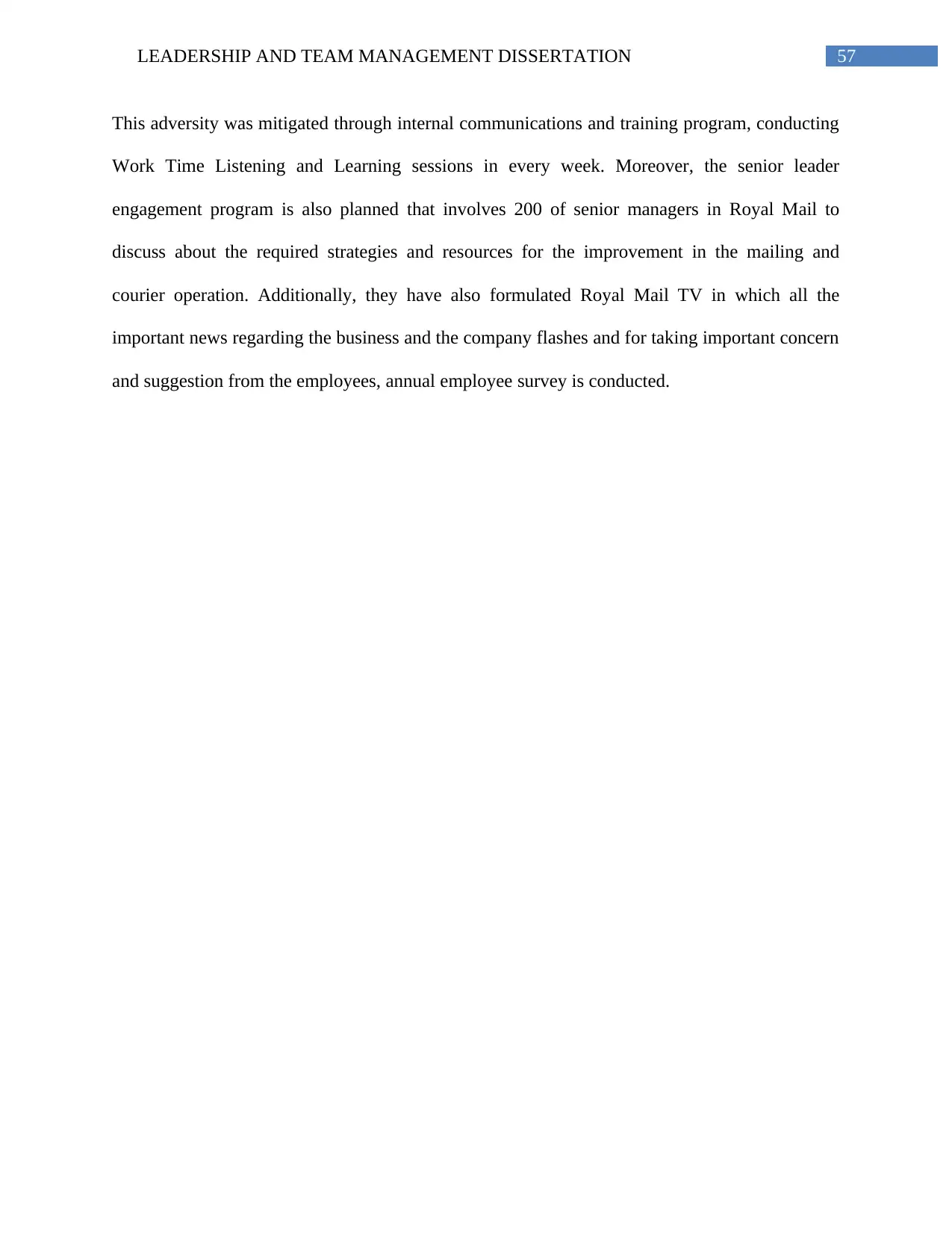
57LEADERSHIP AND TEAM MANAGEMENT DISSERTATION
This adversity was mitigated through internal communications and training program, conducting
Work Time Listening and Learning sessions in every week. Moreover, the senior leader
engagement program is also planned that involves 200 of senior managers in Royal Mail to
discuss about the required strategies and resources for the improvement in the mailing and
courier operation. Additionally, they have also formulated Royal Mail TV in which all the
important news regarding the business and the company flashes and for taking important concern
and suggestion from the employees, annual employee survey is conducted.
This adversity was mitigated through internal communications and training program, conducting
Work Time Listening and Learning sessions in every week. Moreover, the senior leader
engagement program is also planned that involves 200 of senior managers in Royal Mail to
discuss about the required strategies and resources for the improvement in the mailing and
courier operation. Additionally, they have also formulated Royal Mail TV in which all the
important news regarding the business and the company flashes and for taking important concern
and suggestion from the employees, annual employee survey is conducted.
Secure Best Marks with AI Grader
Need help grading? Try our AI Grader for instant feedback on your assignments.
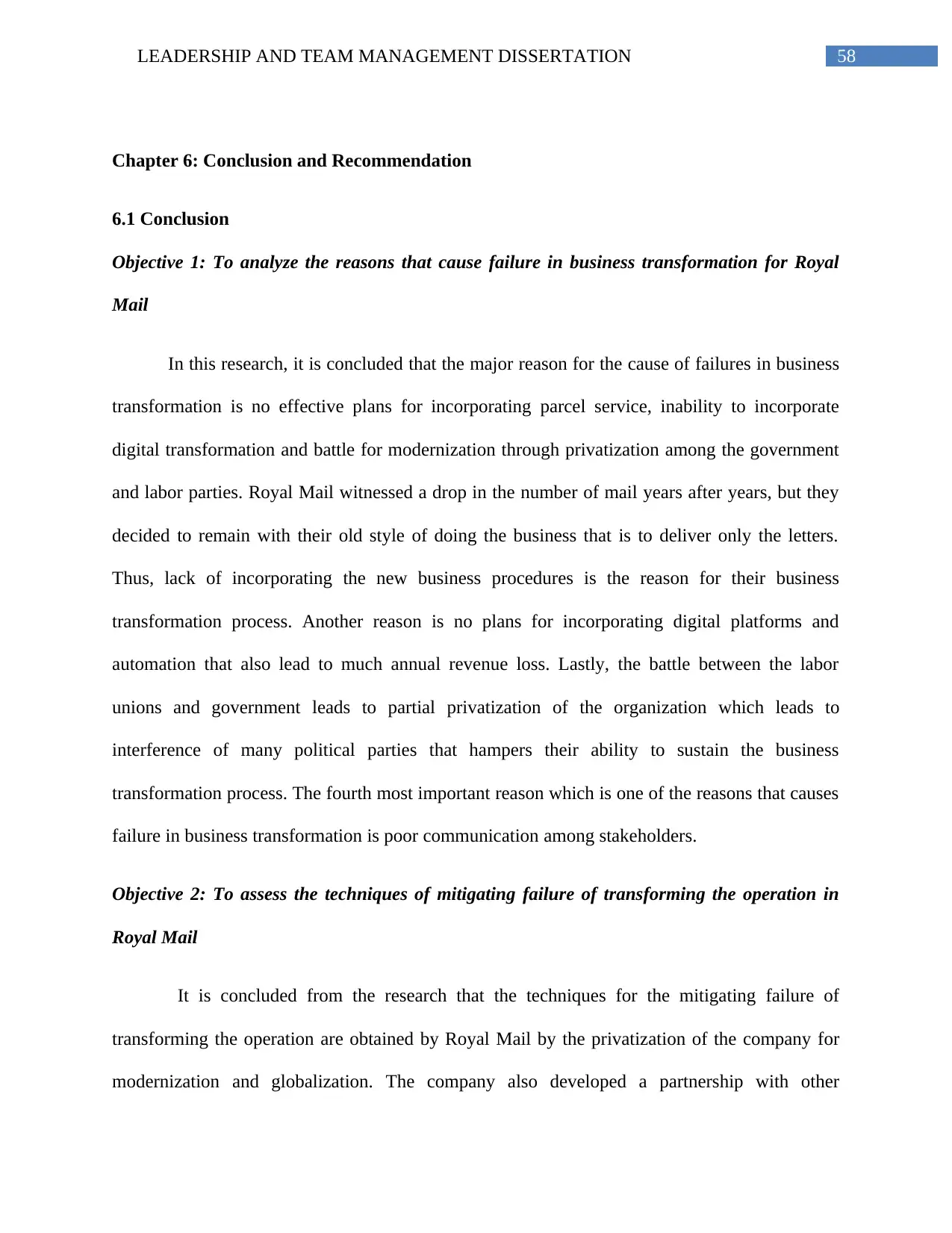
58LEADERSHIP AND TEAM MANAGEMENT DISSERTATION
Chapter 6: Conclusion and Recommendation
6.1 Conclusion
Objective 1: To analyze the reasons that cause failure in business transformation for Royal
Mail
In this research, it is concluded that the major reason for the cause of failures in business
transformation is no effective plans for incorporating parcel service, inability to incorporate
digital transformation and battle for modernization through privatization among the government
and labor parties. Royal Mail witnessed a drop in the number of mail years after years, but they
decided to remain with their old style of doing the business that is to deliver only the letters.
Thus, lack of incorporating the new business procedures is the reason for their business
transformation process. Another reason is no plans for incorporating digital platforms and
automation that also lead to much annual revenue loss. Lastly, the battle between the labor
unions and government leads to partial privatization of the organization which leads to
interference of many political parties that hampers their ability to sustain the business
transformation process. The fourth most important reason which is one of the reasons that causes
failure in business transformation is poor communication among stakeholders.
Objective 2: To assess the techniques of mitigating failure of transforming the operation in
Royal Mail
It is concluded from the research that the techniques for the mitigating failure of
transforming the operation are obtained by Royal Mail by the privatization of the company for
modernization and globalization. The company also developed a partnership with other
Chapter 6: Conclusion and Recommendation
6.1 Conclusion
Objective 1: To analyze the reasons that cause failure in business transformation for Royal
In this research, it is concluded that the major reason for the cause of failures in business
transformation is no effective plans for incorporating parcel service, inability to incorporate
digital transformation and battle for modernization through privatization among the government
and labor parties. Royal Mail witnessed a drop in the number of mail years after years, but they
decided to remain with their old style of doing the business that is to deliver only the letters.
Thus, lack of incorporating the new business procedures is the reason for their business
transformation process. Another reason is no plans for incorporating digital platforms and
automation that also lead to much annual revenue loss. Lastly, the battle between the labor
unions and government leads to partial privatization of the organization which leads to
interference of many political parties that hampers their ability to sustain the business
transformation process. The fourth most important reason which is one of the reasons that causes
failure in business transformation is poor communication among stakeholders.
Objective 2: To assess the techniques of mitigating failure of transforming the operation in
Royal Mail
It is concluded from the research that the techniques for the mitigating failure of
transforming the operation are obtained by Royal Mail by the privatization of the company for
modernization and globalization. The company also developed a partnership with other
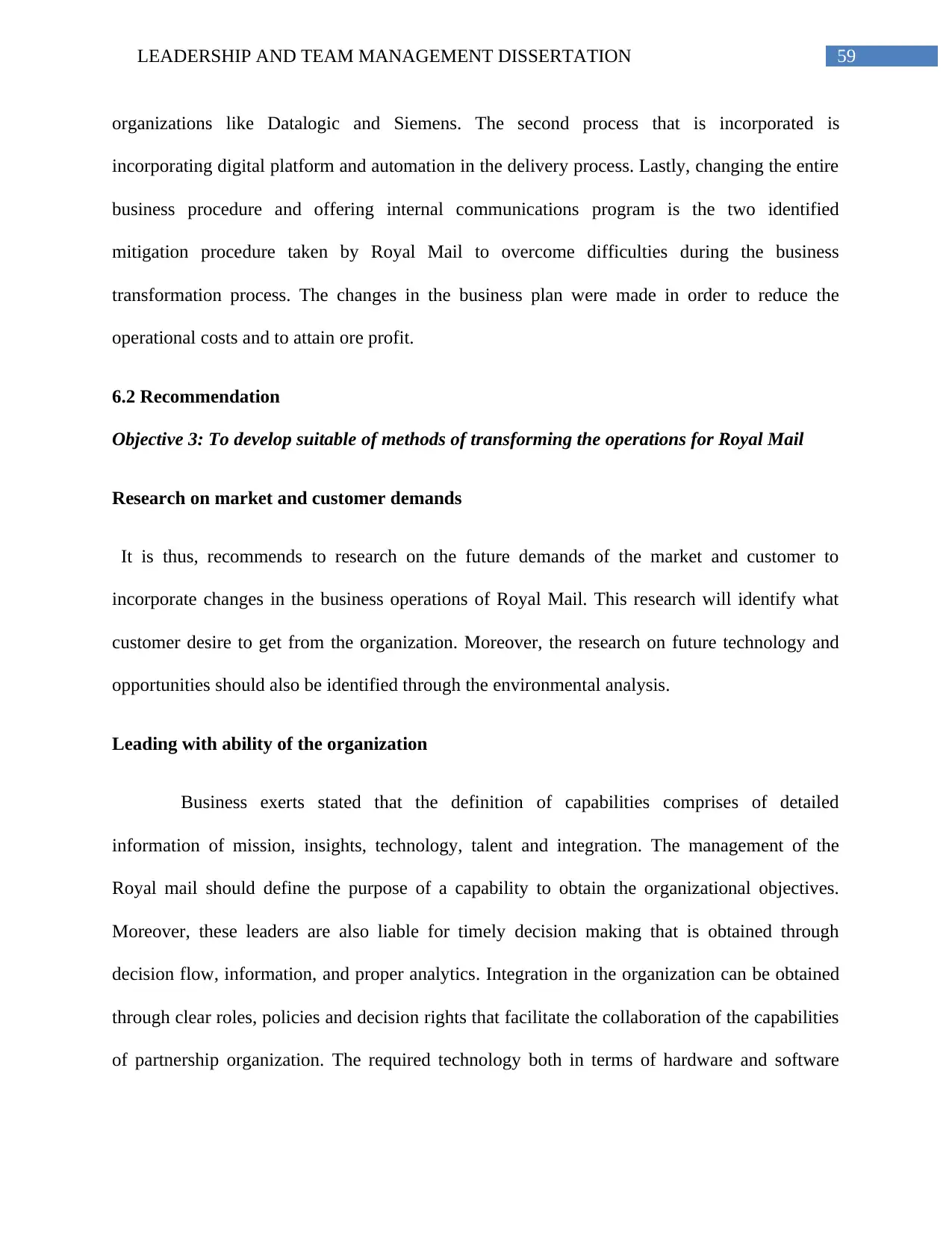
59LEADERSHIP AND TEAM MANAGEMENT DISSERTATION
organizations like Datalogic and Siemens. The second process that is incorporated is
incorporating digital platform and automation in the delivery process. Lastly, changing the entire
business procedure and offering internal communications program is the two identified
mitigation procedure taken by Royal Mail to overcome difficulties during the business
transformation process. The changes in the business plan were made in order to reduce the
operational costs and to attain ore profit.
6.2 Recommendation
Objective 3: To develop suitable of methods of transforming the operations for Royal Mail
Research on market and customer demands
It is thus, recommends to research on the future demands of the market and customer to
incorporate changes in the business operations of Royal Mail. This research will identify what
customer desire to get from the organization. Moreover, the research on future technology and
opportunities should also be identified through the environmental analysis.
Leading with ability of the organization
Business exerts stated that the definition of capabilities comprises of detailed
information of mission, insights, technology, talent and integration. The management of the
Royal mail should define the purpose of a capability to obtain the organizational objectives.
Moreover, these leaders are also liable for timely decision making that is obtained through
decision flow, information, and proper analytics. Integration in the organization can be obtained
through clear roles, policies and decision rights that facilitate the collaboration of the capabilities
of partnership organization. The required technology both in terms of hardware and software
organizations like Datalogic and Siemens. The second process that is incorporated is
incorporating digital platform and automation in the delivery process. Lastly, changing the entire
business procedure and offering internal communications program is the two identified
mitigation procedure taken by Royal Mail to overcome difficulties during the business
transformation process. The changes in the business plan were made in order to reduce the
operational costs and to attain ore profit.
6.2 Recommendation
Objective 3: To develop suitable of methods of transforming the operations for Royal Mail
Research on market and customer demands
It is thus, recommends to research on the future demands of the market and customer to
incorporate changes in the business operations of Royal Mail. This research will identify what
customer desire to get from the organization. Moreover, the research on future technology and
opportunities should also be identified through the environmental analysis.
Leading with ability of the organization
Business exerts stated that the definition of capabilities comprises of detailed
information of mission, insights, technology, talent and integration. The management of the
Royal mail should define the purpose of a capability to obtain the organizational objectives.
Moreover, these leaders are also liable for timely decision making that is obtained through
decision flow, information, and proper analytics. Integration in the organization can be obtained
through clear roles, policies and decision rights that facilitate the collaboration of the capabilities
of partnership organization. The required technology both in terms of hardware and software
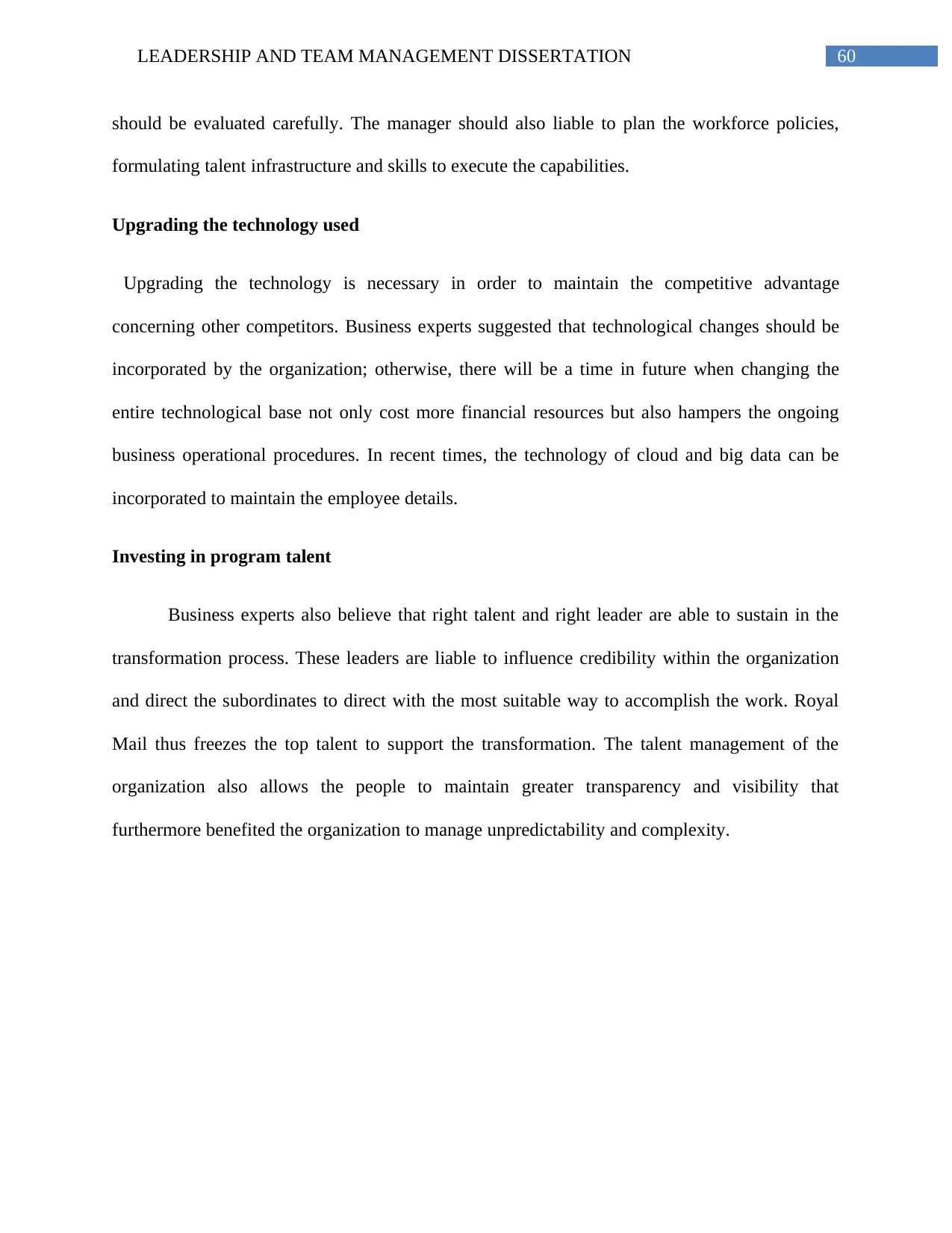
60LEADERSHIP AND TEAM MANAGEMENT DISSERTATION
should be evaluated carefully. The manager should also liable to plan the workforce policies,
formulating talent infrastructure and skills to execute the capabilities.
Upgrading the technology used
Upgrading the technology is necessary in order to maintain the competitive advantage
concerning other competitors. Business experts suggested that technological changes should be
incorporated by the organization; otherwise, there will be a time in future when changing the
entire technological base not only cost more financial resources but also hampers the ongoing
business operational procedures. In recent times, the technology of cloud and big data can be
incorporated to maintain the employee details.
Investing in program talent
Business experts also believe that right talent and right leader are able to sustain in the
transformation process. These leaders are liable to influence credibility within the organization
and direct the subordinates to direct with the most suitable way to accomplish the work. Royal
Mail thus freezes the top talent to support the transformation. The talent management of the
organization also allows the people to maintain greater transparency and visibility that
furthermore benefited the organization to manage unpredictability and complexity.
should be evaluated carefully. The manager should also liable to plan the workforce policies,
formulating talent infrastructure and skills to execute the capabilities.
Upgrading the technology used
Upgrading the technology is necessary in order to maintain the competitive advantage
concerning other competitors. Business experts suggested that technological changes should be
incorporated by the organization; otherwise, there will be a time in future when changing the
entire technological base not only cost more financial resources but also hampers the ongoing
business operational procedures. In recent times, the technology of cloud and big data can be
incorporated to maintain the employee details.
Investing in program talent
Business experts also believe that right talent and right leader are able to sustain in the
transformation process. These leaders are liable to influence credibility within the organization
and direct the subordinates to direct with the most suitable way to accomplish the work. Royal
Mail thus freezes the top talent to support the transformation. The talent management of the
organization also allows the people to maintain greater transparency and visibility that
furthermore benefited the organization to manage unpredictability and complexity.
Paraphrase This Document
Need a fresh take? Get an instant paraphrase of this document with our AI Paraphraser
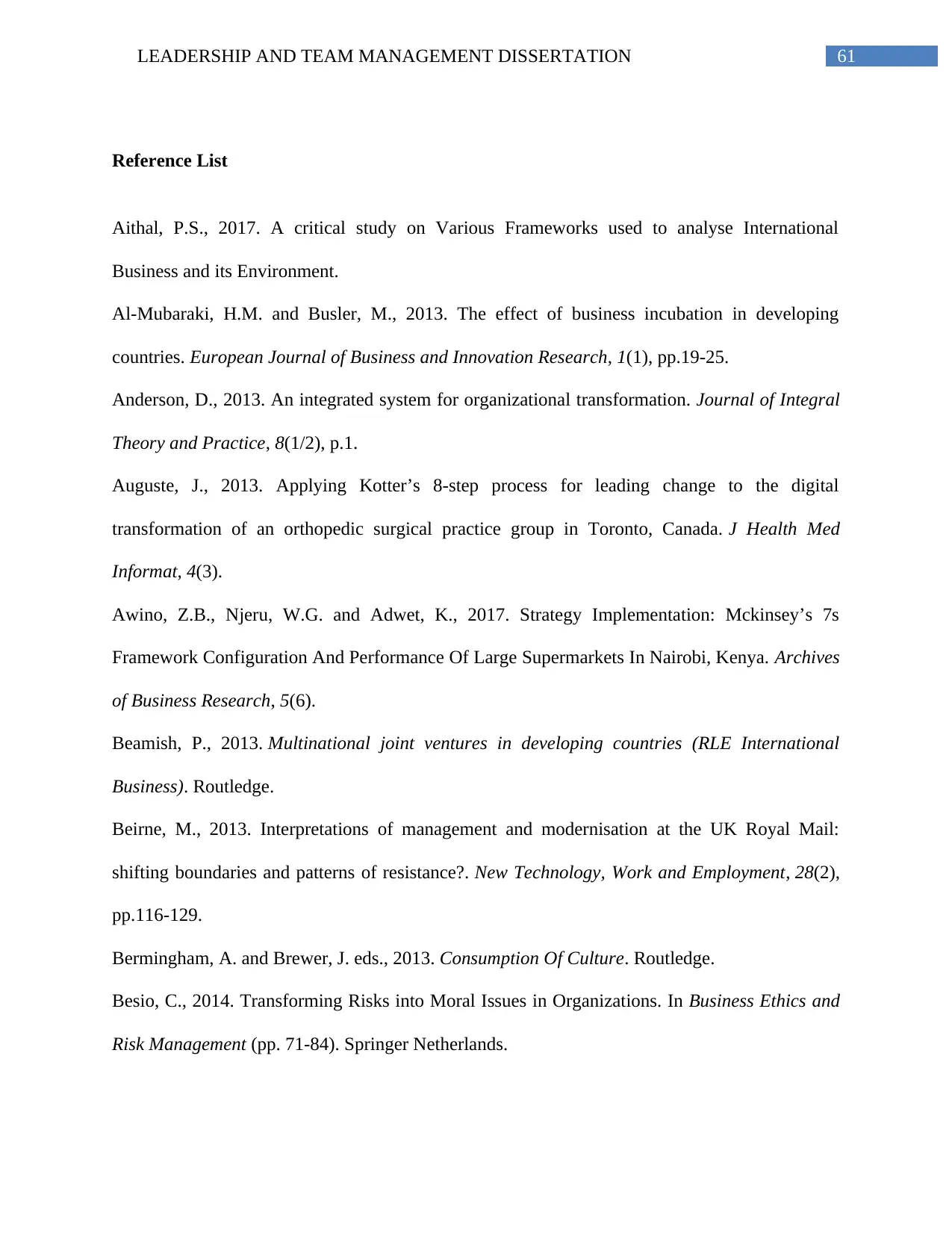
61LEADERSHIP AND TEAM MANAGEMENT DISSERTATION
Reference List
Aithal, P.S., 2017. A critical study on Various Frameworks used to analyse International
Business and its Environment.
Al-Mubaraki, H.M. and Busler, M., 2013. The effect of business incubation in developing
countries. European Journal of Business and Innovation Research, 1(1), pp.19-25.
Anderson, D., 2013. An integrated system for organizational transformation. Journal of Integral
Theory and Practice, 8(1/2), p.1.
Auguste, J., 2013. Applying Kotter’s 8-step process for leading change to the digital
transformation of an orthopedic surgical practice group in Toronto, Canada. J Health Med
Informat, 4(3).
Awino, Z.B., Njeru, W.G. and Adwet, K., 2017. Strategy Implementation: Mckinsey’s 7s
Framework Configuration And Performance Of Large Supermarkets In Nairobi, Kenya. Archives
of Business Research, 5(6).
Beamish, P., 2013. Multinational joint ventures in developing countries (RLE International
Business). Routledge.
Beirne, M., 2013. Interpretations of management and modernisation at the UK Royal Mail:
shifting boundaries and patterns of resistance?. New Technology, Work and Employment, 28(2),
pp.116-129.
Bermingham, A. and Brewer, J. eds., 2013. Consumption Of Culture. Routledge.
Besio, C., 2014. Transforming Risks into Moral Issues in Organizations. In Business Ethics and
Risk Management (pp. 71-84). Springer Netherlands.
Reference List
Aithal, P.S., 2017. A critical study on Various Frameworks used to analyse International
Business and its Environment.
Al-Mubaraki, H.M. and Busler, M., 2013. The effect of business incubation in developing
countries. European Journal of Business and Innovation Research, 1(1), pp.19-25.
Anderson, D., 2013. An integrated system for organizational transformation. Journal of Integral
Theory and Practice, 8(1/2), p.1.
Auguste, J., 2013. Applying Kotter’s 8-step process for leading change to the digital
transformation of an orthopedic surgical practice group in Toronto, Canada. J Health Med
Informat, 4(3).
Awino, Z.B., Njeru, W.G. and Adwet, K., 2017. Strategy Implementation: Mckinsey’s 7s
Framework Configuration And Performance Of Large Supermarkets In Nairobi, Kenya. Archives
of Business Research, 5(6).
Beamish, P., 2013. Multinational joint ventures in developing countries (RLE International
Business). Routledge.
Beirne, M., 2013. Interpretations of management and modernisation at the UK Royal Mail:
shifting boundaries and patterns of resistance?. New Technology, Work and Employment, 28(2),
pp.116-129.
Bermingham, A. and Brewer, J. eds., 2013. Consumption Of Culture. Routledge.
Besio, C., 2014. Transforming Risks into Moral Issues in Organizations. In Business Ethics and
Risk Management (pp. 71-84). Springer Netherlands.
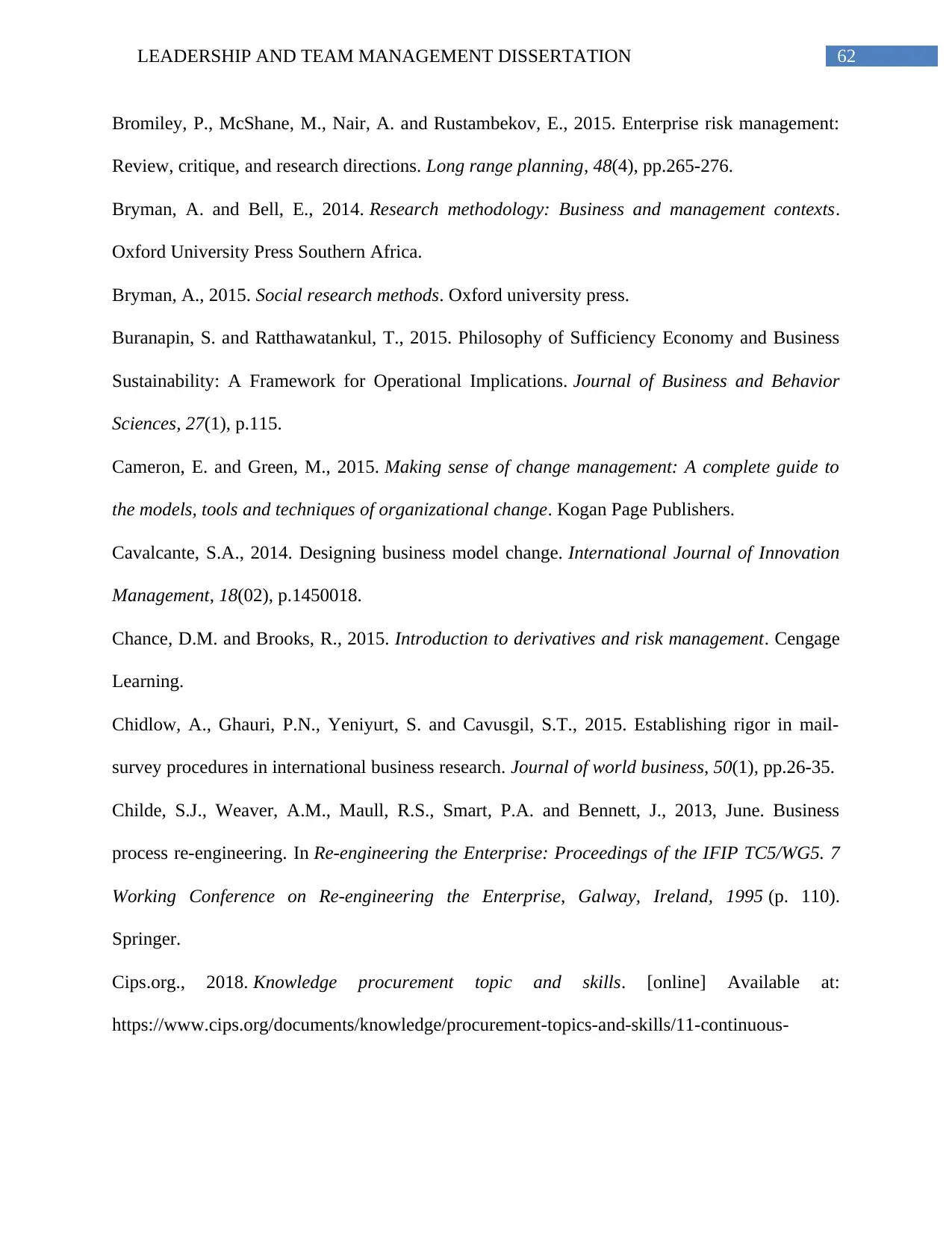
62LEADERSHIP AND TEAM MANAGEMENT DISSERTATION
Bromiley, P., McShane, M., Nair, A. and Rustambekov, E., 2015. Enterprise risk management:
Review, critique, and research directions. Long range planning, 48(4), pp.265-276.
Bryman, A. and Bell, E., 2014. Research methodology: Business and management contexts.
Oxford University Press Southern Africa.
Bryman, A., 2015. Social research methods. Oxford university press.
Buranapin, S. and Ratthawatankul, T., 2015. Philosophy of Sufficiency Economy and Business
Sustainability: A Framework for Operational Implications. Journal of Business and Behavior
Sciences, 27(1), p.115.
Cameron, E. and Green, M., 2015. Making sense of change management: A complete guide to
the models, tools and techniques of organizational change. Kogan Page Publishers.
Cavalcante, S.A., 2014. Designing business model change. International Journal of Innovation
Management, 18(02), p.1450018.
Chance, D.M. and Brooks, R., 2015. Introduction to derivatives and risk management. Cengage
Learning.
Chidlow, A., Ghauri, P.N., Yeniyurt, S. and Cavusgil, S.T., 2015. Establishing rigor in mail-
survey procedures in international business research. Journal of world business, 50(1), pp.26-35.
Childe, S.J., Weaver, A.M., Maull, R.S., Smart, P.A. and Bennett, J., 2013, June. Business
process re-engineering. In Re-engineering the Enterprise: Proceedings of the IFIP TC5/WG5. 7
Working Conference on Re-engineering the Enterprise, Galway, Ireland, 1995 (p. 110).
Springer.
Cips.org., 2018. Knowledge procurement topic and skills. [online] Available at:
https://www.cips.org/documents/knowledge/procurement-topics-and-skills/11-continuous-
Bromiley, P., McShane, M., Nair, A. and Rustambekov, E., 2015. Enterprise risk management:
Review, critique, and research directions. Long range planning, 48(4), pp.265-276.
Bryman, A. and Bell, E., 2014. Research methodology: Business and management contexts.
Oxford University Press Southern Africa.
Bryman, A., 2015. Social research methods. Oxford university press.
Buranapin, S. and Ratthawatankul, T., 2015. Philosophy of Sufficiency Economy and Business
Sustainability: A Framework for Operational Implications. Journal of Business and Behavior
Sciences, 27(1), p.115.
Cameron, E. and Green, M., 2015. Making sense of change management: A complete guide to
the models, tools and techniques of organizational change. Kogan Page Publishers.
Cavalcante, S.A., 2014. Designing business model change. International Journal of Innovation
Management, 18(02), p.1450018.
Chance, D.M. and Brooks, R., 2015. Introduction to derivatives and risk management. Cengage
Learning.
Chidlow, A., Ghauri, P.N., Yeniyurt, S. and Cavusgil, S.T., 2015. Establishing rigor in mail-
survey procedures in international business research. Journal of world business, 50(1), pp.26-35.
Childe, S.J., Weaver, A.M., Maull, R.S., Smart, P.A. and Bennett, J., 2013, June. Business
process re-engineering. In Re-engineering the Enterprise: Proceedings of the IFIP TC5/WG5. 7
Working Conference on Re-engineering the Enterprise, Galway, Ireland, 1995 (p. 110).
Springer.
Cips.org., 2018. Knowledge procurement topic and skills. [online] Available at:
https://www.cips.org/documents/knowledge/procurement-topics-and-skills/11-continuous-
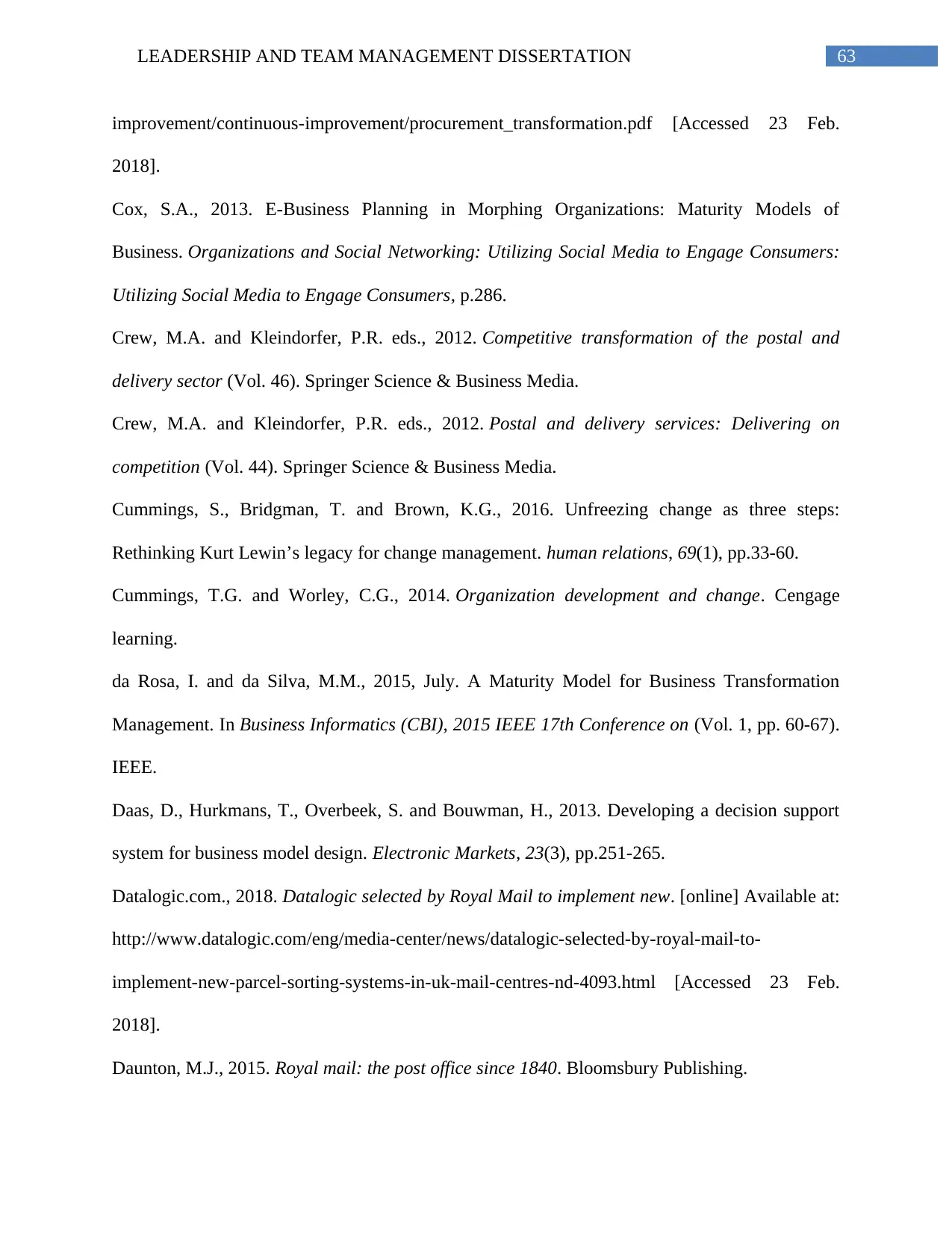
63LEADERSHIP AND TEAM MANAGEMENT DISSERTATION
improvement/continuous-improvement/procurement_transformation.pdf [Accessed 23 Feb.
2018].
Cox, S.A., 2013. E-Business Planning in Morphing Organizations: Maturity Models of
Business. Organizations and Social Networking: Utilizing Social Media to Engage Consumers:
Utilizing Social Media to Engage Consumers, p.286.
Crew, M.A. and Kleindorfer, P.R. eds., 2012. Competitive transformation of the postal and
delivery sector (Vol. 46). Springer Science & Business Media.
Crew, M.A. and Kleindorfer, P.R. eds., 2012. Postal and delivery services: Delivering on
competition (Vol. 44). Springer Science & Business Media.
Cummings, S., Bridgman, T. and Brown, K.G., 2016. Unfreezing change as three steps:
Rethinking Kurt Lewin’s legacy for change management. human relations, 69(1), pp.33-60.
Cummings, T.G. and Worley, C.G., 2014. Organization development and change. Cengage
learning.
da Rosa, I. and da Silva, M.M., 2015, July. A Maturity Model for Business Transformation
Management. In Business Informatics (CBI), 2015 IEEE 17th Conference on (Vol. 1, pp. 60-67).
IEEE.
Daas, D., Hurkmans, T., Overbeek, S. and Bouwman, H., 2013. Developing a decision support
system for business model design. Electronic Markets, 23(3), pp.251-265.
Datalogic.com., 2018. Datalogic selected by Royal Mail to implement new. [online] Available at:
http://www.datalogic.com/eng/media-center/news/datalogic-selected-by-royal-mail-to-
implement-new-parcel-sorting-systems-in-uk-mail-centres-nd-4093.html [Accessed 23 Feb.
2018].
Daunton, M.J., 2015. Royal mail: the post office since 1840. Bloomsbury Publishing.
improvement/continuous-improvement/procurement_transformation.pdf [Accessed 23 Feb.
2018].
Cox, S.A., 2013. E-Business Planning in Morphing Organizations: Maturity Models of
Business. Organizations and Social Networking: Utilizing Social Media to Engage Consumers:
Utilizing Social Media to Engage Consumers, p.286.
Crew, M.A. and Kleindorfer, P.R. eds., 2012. Competitive transformation of the postal and
delivery sector (Vol. 46). Springer Science & Business Media.
Crew, M.A. and Kleindorfer, P.R. eds., 2012. Postal and delivery services: Delivering on
competition (Vol. 44). Springer Science & Business Media.
Cummings, S., Bridgman, T. and Brown, K.G., 2016. Unfreezing change as three steps:
Rethinking Kurt Lewin’s legacy for change management. human relations, 69(1), pp.33-60.
Cummings, T.G. and Worley, C.G., 2014. Organization development and change. Cengage
learning.
da Rosa, I. and da Silva, M.M., 2015, July. A Maturity Model for Business Transformation
Management. In Business Informatics (CBI), 2015 IEEE 17th Conference on (Vol. 1, pp. 60-67).
IEEE.
Daas, D., Hurkmans, T., Overbeek, S. and Bouwman, H., 2013. Developing a decision support
system for business model design. Electronic Markets, 23(3), pp.251-265.
Datalogic.com., 2018. Datalogic selected by Royal Mail to implement new. [online] Available at:
http://www.datalogic.com/eng/media-center/news/datalogic-selected-by-royal-mail-to-
implement-new-parcel-sorting-systems-in-uk-mail-centres-nd-4093.html [Accessed 23 Feb.
2018].
Daunton, M.J., 2015. Royal mail: the post office since 1840. Bloomsbury Publishing.
Secure Best Marks with AI Grader
Need help grading? Try our AI Grader for instant feedback on your assignments.
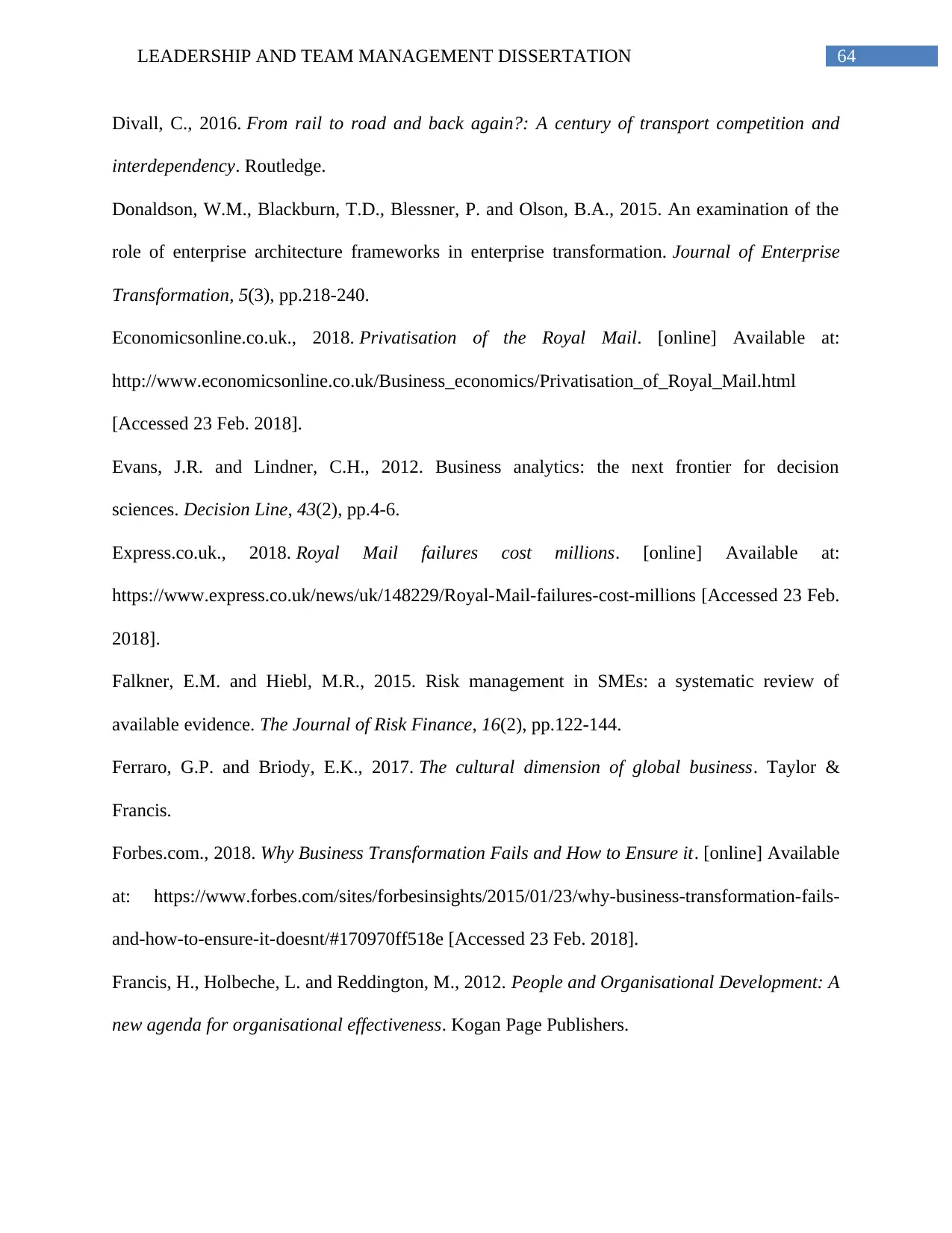
64LEADERSHIP AND TEAM MANAGEMENT DISSERTATION
Divall, C., 2016. From rail to road and back again?: A century of transport competition and
interdependency. Routledge.
Donaldson, W.M., Blackburn, T.D., Blessner, P. and Olson, B.A., 2015. An examination of the
role of enterprise architecture frameworks in enterprise transformation. Journal of Enterprise
Transformation, 5(3), pp.218-240.
Economicsonline.co.uk., 2018. Privatisation of the Royal Mail. [online] Available at:
http://www.economicsonline.co.uk/Business_economics/Privatisation_of_Royal_Mail.html
[Accessed 23 Feb. 2018].
Evans, J.R. and Lindner, C.H., 2012. Business analytics: the next frontier for decision
sciences. Decision Line, 43(2), pp.4-6.
Express.co.uk., 2018. Royal Mail failures cost millions. [online] Available at:
https://www.express.co.uk/news/uk/148229/Royal-Mail-failures-cost-millions [Accessed 23 Feb.
2018].
Falkner, E.M. and Hiebl, M.R., 2015. Risk management in SMEs: a systematic review of
available evidence. The Journal of Risk Finance, 16(2), pp.122-144.
Ferraro, G.P. and Briody, E.K., 2017. The cultural dimension of global business. Taylor &
Francis.
Forbes.com., 2018. Why Business Transformation Fails and How to Ensure it. [online] Available
at: https://www.forbes.com/sites/forbesinsights/2015/01/23/why-business-transformation-fails-
and-how-to-ensure-it-doesnt/#170970ff518e [Accessed 23 Feb. 2018].
Francis, H., Holbeche, L. and Reddington, M., 2012. People and Organisational Development: A
new agenda for organisational effectiveness. Kogan Page Publishers.
Divall, C., 2016. From rail to road and back again?: A century of transport competition and
interdependency. Routledge.
Donaldson, W.M., Blackburn, T.D., Blessner, P. and Olson, B.A., 2015. An examination of the
role of enterprise architecture frameworks in enterprise transformation. Journal of Enterprise
Transformation, 5(3), pp.218-240.
Economicsonline.co.uk., 2018. Privatisation of the Royal Mail. [online] Available at:
http://www.economicsonline.co.uk/Business_economics/Privatisation_of_Royal_Mail.html
[Accessed 23 Feb. 2018].
Evans, J.R. and Lindner, C.H., 2012. Business analytics: the next frontier for decision
sciences. Decision Line, 43(2), pp.4-6.
Express.co.uk., 2018. Royal Mail failures cost millions. [online] Available at:
https://www.express.co.uk/news/uk/148229/Royal-Mail-failures-cost-millions [Accessed 23 Feb.
2018].
Falkner, E.M. and Hiebl, M.R., 2015. Risk management in SMEs: a systematic review of
available evidence. The Journal of Risk Finance, 16(2), pp.122-144.
Ferraro, G.P. and Briody, E.K., 2017. The cultural dimension of global business. Taylor &
Francis.
Forbes.com., 2018. Why Business Transformation Fails and How to Ensure it. [online] Available
at: https://www.forbes.com/sites/forbesinsights/2015/01/23/why-business-transformation-fails-
and-how-to-ensure-it-doesnt/#170970ff518e [Accessed 23 Feb. 2018].
Francis, H., Holbeche, L. and Reddington, M., 2012. People and Organisational Development: A
new agenda for organisational effectiveness. Kogan Page Publishers.
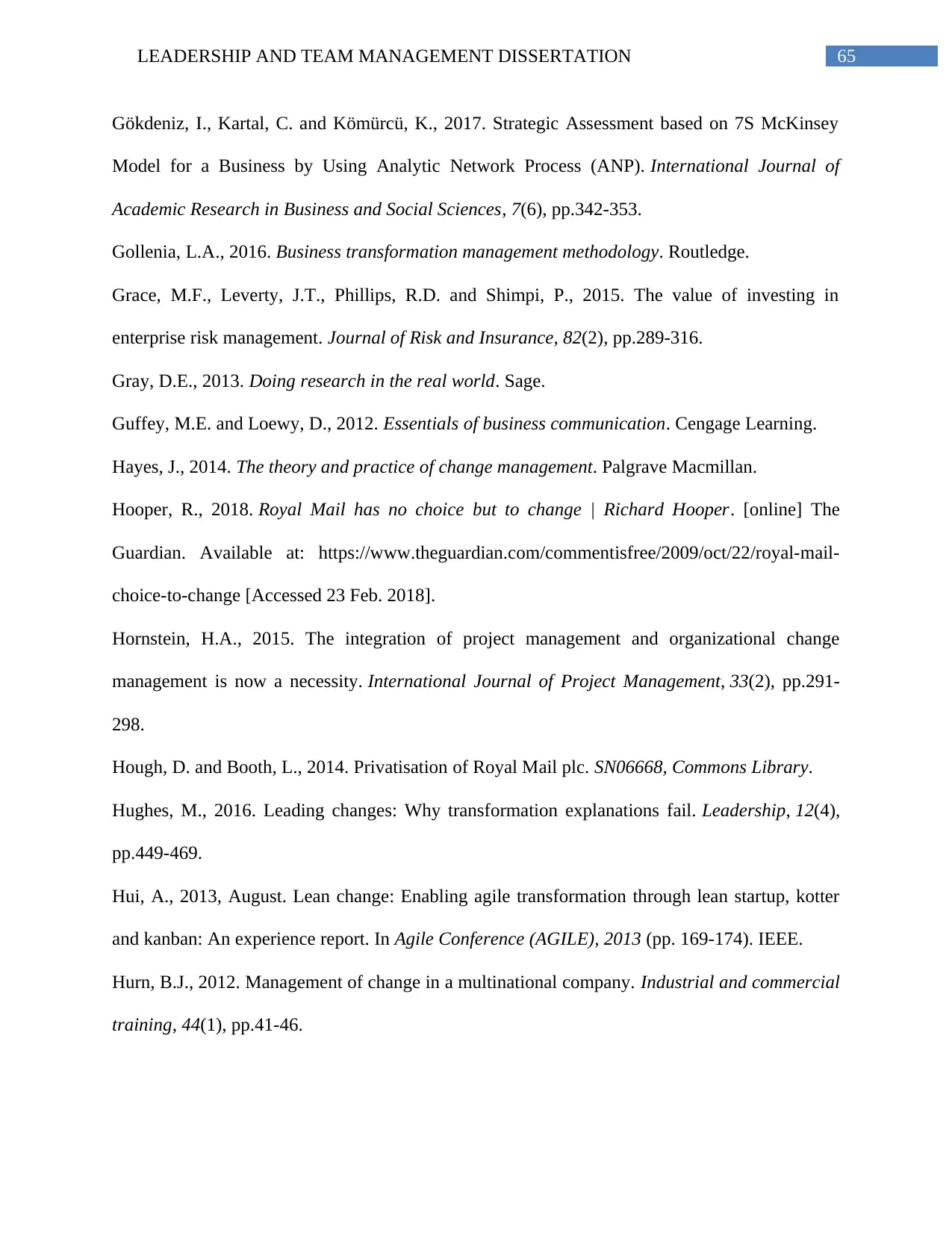
65LEADERSHIP AND TEAM MANAGEMENT DISSERTATION
Gökdeniz, I., Kartal, C. and Kömürcü, K., 2017. Strategic Assessment based on 7S McKinsey
Model for a Business by Using Analytic Network Process (ANP). International Journal of
Academic Research in Business and Social Sciences, 7(6), pp.342-353.
Gollenia, L.A., 2016. Business transformation management methodology. Routledge.
Grace, M.F., Leverty, J.T., Phillips, R.D. and Shimpi, P., 2015. The value of investing in
enterprise risk management. Journal of Risk and Insurance, 82(2), pp.289-316.
Gray, D.E., 2013. Doing research in the real world. Sage.
Guffey, M.E. and Loewy, D., 2012. Essentials of business communication. Cengage Learning.
Hayes, J., 2014. The theory and practice of change management. Palgrave Macmillan.
Hooper, R., 2018. Royal Mail has no choice but to change | Richard Hooper. [online] The
Guardian. Available at: https://www.theguardian.com/commentisfree/2009/oct/22/royal-mail-
choice-to-change [Accessed 23 Feb. 2018].
Hornstein, H.A., 2015. The integration of project management and organizational change
management is now a necessity. International Journal of Project Management, 33(2), pp.291-
298.
Hough, D. and Booth, L., 2014. Privatisation of Royal Mail plc. SN06668, Commons Library.
Hughes, M., 2016. Leading changes: Why transformation explanations fail. Leadership, 12(4),
pp.449-469.
Hui, A., 2013, August. Lean change: Enabling agile transformation through lean startup, kotter
and kanban: An experience report. In Agile Conference (AGILE), 2013 (pp. 169-174). IEEE.
Hurn, B.J., 2012. Management of change in a multinational company. Industrial and commercial
training, 44(1), pp.41-46.
Gökdeniz, I., Kartal, C. and Kömürcü, K., 2017. Strategic Assessment based on 7S McKinsey
Model for a Business by Using Analytic Network Process (ANP). International Journal of
Academic Research in Business and Social Sciences, 7(6), pp.342-353.
Gollenia, L.A., 2016. Business transformation management methodology. Routledge.
Grace, M.F., Leverty, J.T., Phillips, R.D. and Shimpi, P., 2015. The value of investing in
enterprise risk management. Journal of Risk and Insurance, 82(2), pp.289-316.
Gray, D.E., 2013. Doing research in the real world. Sage.
Guffey, M.E. and Loewy, D., 2012. Essentials of business communication. Cengage Learning.
Hayes, J., 2014. The theory and practice of change management. Palgrave Macmillan.
Hooper, R., 2018. Royal Mail has no choice but to change | Richard Hooper. [online] The
Guardian. Available at: https://www.theguardian.com/commentisfree/2009/oct/22/royal-mail-
choice-to-change [Accessed 23 Feb. 2018].
Hornstein, H.A., 2015. The integration of project management and organizational change
management is now a necessity. International Journal of Project Management, 33(2), pp.291-
298.
Hough, D. and Booth, L., 2014. Privatisation of Royal Mail plc. SN06668, Commons Library.
Hughes, M., 2016. Leading changes: Why transformation explanations fail. Leadership, 12(4),
pp.449-469.
Hui, A., 2013, August. Lean change: Enabling agile transformation through lean startup, kotter
and kanban: An experience report. In Agile Conference (AGILE), 2013 (pp. 169-174). IEEE.
Hurn, B.J., 2012. Management of change in a multinational company. Industrial and commercial
training, 44(1), pp.41-46.
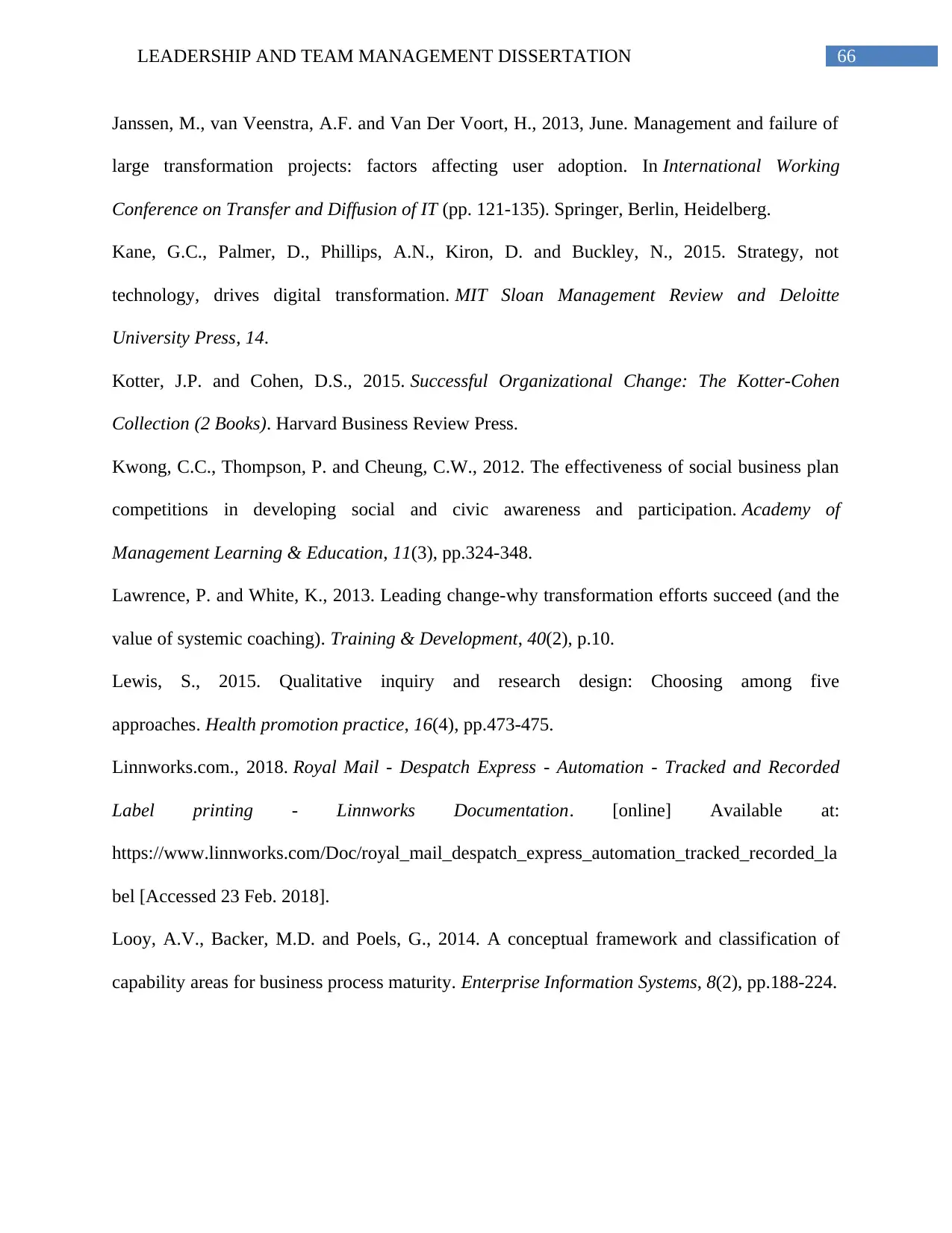
66LEADERSHIP AND TEAM MANAGEMENT DISSERTATION
Janssen, M., van Veenstra, A.F. and Van Der Voort, H., 2013, June. Management and failure of
large transformation projects: factors affecting user adoption. In International Working
Conference on Transfer and Diffusion of IT (pp. 121-135). Springer, Berlin, Heidelberg.
Kane, G.C., Palmer, D., Phillips, A.N., Kiron, D. and Buckley, N., 2015. Strategy, not
technology, drives digital transformation. MIT Sloan Management Review and Deloitte
University Press, 14.
Kotter, J.P. and Cohen, D.S., 2015. Successful Organizational Change: The Kotter-Cohen
Collection (2 Books). Harvard Business Review Press.
Kwong, C.C., Thompson, P. and Cheung, C.W., 2012. The effectiveness of social business plan
competitions in developing social and civic awareness and participation. Academy of
Management Learning & Education, 11(3), pp.324-348.
Lawrence, P. and White, K., 2013. Leading change-why transformation efforts succeed (and the
value of systemic coaching). Training & Development, 40(2), p.10.
Lewis, S., 2015. Qualitative inquiry and research design: Choosing among five
approaches. Health promotion practice, 16(4), pp.473-475.
Linnworks.com., 2018. Royal Mail - Despatch Express - Automation - Tracked and Recorded
Label printing - Linnworks Documentation. [online] Available at:
https://www.linnworks.com/Doc/royal_mail_despatch_express_automation_tracked_recorded_la
bel [Accessed 23 Feb. 2018].
Looy, A.V., Backer, M.D. and Poels, G., 2014. A conceptual framework and classification of
capability areas for business process maturity. Enterprise Information Systems, 8(2), pp.188-224.
Janssen, M., van Veenstra, A.F. and Van Der Voort, H., 2013, June. Management and failure of
large transformation projects: factors affecting user adoption. In International Working
Conference on Transfer and Diffusion of IT (pp. 121-135). Springer, Berlin, Heidelberg.
Kane, G.C., Palmer, D., Phillips, A.N., Kiron, D. and Buckley, N., 2015. Strategy, not
technology, drives digital transformation. MIT Sloan Management Review and Deloitte
University Press, 14.
Kotter, J.P. and Cohen, D.S., 2015. Successful Organizational Change: The Kotter-Cohen
Collection (2 Books). Harvard Business Review Press.
Kwong, C.C., Thompson, P. and Cheung, C.W., 2012. The effectiveness of social business plan
competitions in developing social and civic awareness and participation. Academy of
Management Learning & Education, 11(3), pp.324-348.
Lawrence, P. and White, K., 2013. Leading change-why transformation efforts succeed (and the
value of systemic coaching). Training & Development, 40(2), p.10.
Lewis, S., 2015. Qualitative inquiry and research design: Choosing among five
approaches. Health promotion practice, 16(4), pp.473-475.
Linnworks.com., 2018. Royal Mail - Despatch Express - Automation - Tracked and Recorded
Label printing - Linnworks Documentation. [online] Available at:
https://www.linnworks.com/Doc/royal_mail_despatch_express_automation_tracked_recorded_la
bel [Accessed 23 Feb. 2018].
Looy, A.V., Backer, M.D. and Poels, G., 2014. A conceptual framework and classification of
capability areas for business process maturity. Enterprise Information Systems, 8(2), pp.188-224.
Paraphrase This Document
Need a fresh take? Get an instant paraphrase of this document with our AI Paraphraser
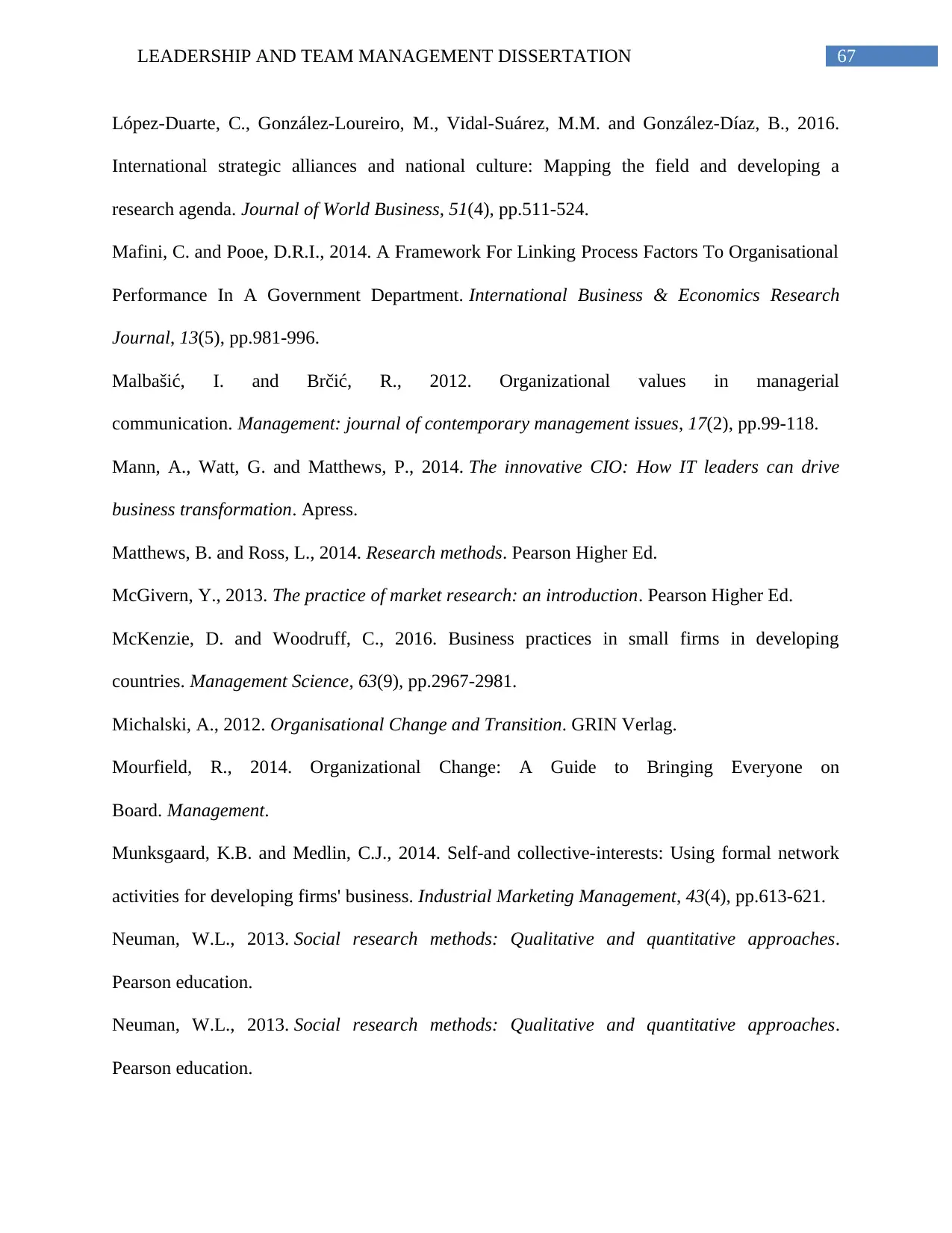
67LEADERSHIP AND TEAM MANAGEMENT DISSERTATION
López-Duarte, C., González-Loureiro, M., Vidal-Suárez, M.M. and González-Díaz, B., 2016.
International strategic alliances and national culture: Mapping the field and developing a
research agenda. Journal of World Business, 51(4), pp.511-524.
Mafini, C. and Pooe, D.R.I., 2014. A Framework For Linking Process Factors To Organisational
Performance In A Government Department. International Business & Economics Research
Journal, 13(5), pp.981-996.
Malbašić, I. and Brčić, R., 2012. Organizational values in managerial
communication. Management: journal of contemporary management issues, 17(2), pp.99-118.
Mann, A., Watt, G. and Matthews, P., 2014. The innovative CIO: How IT leaders can drive
business transformation. Apress.
Matthews, B. and Ross, L., 2014. Research methods. Pearson Higher Ed.
McGivern, Y., 2013. The practice of market research: an introduction. Pearson Higher Ed.
McKenzie, D. and Woodruff, C., 2016. Business practices in small firms in developing
countries. Management Science, 63(9), pp.2967-2981.
Michalski, A., 2012. Organisational Change and Transition. GRIN Verlag.
Mourfield, R., 2014. Organizational Change: A Guide to Bringing Everyone on
Board. Management.
Munksgaard, K.B. and Medlin, C.J., 2014. Self-and collective-interests: Using formal network
activities for developing firms' business. Industrial Marketing Management, 43(4), pp.613-621.
Neuman, W.L., 2013. Social research methods: Qualitative and quantitative approaches.
Pearson education.
Neuman, W.L., 2013. Social research methods: Qualitative and quantitative approaches.
Pearson education.
López-Duarte, C., González-Loureiro, M., Vidal-Suárez, M.M. and González-Díaz, B., 2016.
International strategic alliances and national culture: Mapping the field and developing a
research agenda. Journal of World Business, 51(4), pp.511-524.
Mafini, C. and Pooe, D.R.I., 2014. A Framework For Linking Process Factors To Organisational
Performance In A Government Department. International Business & Economics Research
Journal, 13(5), pp.981-996.
Malbašić, I. and Brčić, R., 2012. Organizational values in managerial
communication. Management: journal of contemporary management issues, 17(2), pp.99-118.
Mann, A., Watt, G. and Matthews, P., 2014. The innovative CIO: How IT leaders can drive
business transformation. Apress.
Matthews, B. and Ross, L., 2014. Research methods. Pearson Higher Ed.
McGivern, Y., 2013. The practice of market research: an introduction. Pearson Higher Ed.
McKenzie, D. and Woodruff, C., 2016. Business practices in small firms in developing
countries. Management Science, 63(9), pp.2967-2981.
Michalski, A., 2012. Organisational Change and Transition. GRIN Verlag.
Mourfield, R., 2014. Organizational Change: A Guide to Bringing Everyone on
Board. Management.
Munksgaard, K.B. and Medlin, C.J., 2014. Self-and collective-interests: Using formal network
activities for developing firms' business. Industrial Marketing Management, 43(4), pp.613-621.
Neuman, W.L., 2013. Social research methods: Qualitative and quantitative approaches.
Pearson education.
Neuman, W.L., 2013. Social research methods: Qualitative and quantitative approaches.
Pearson education.
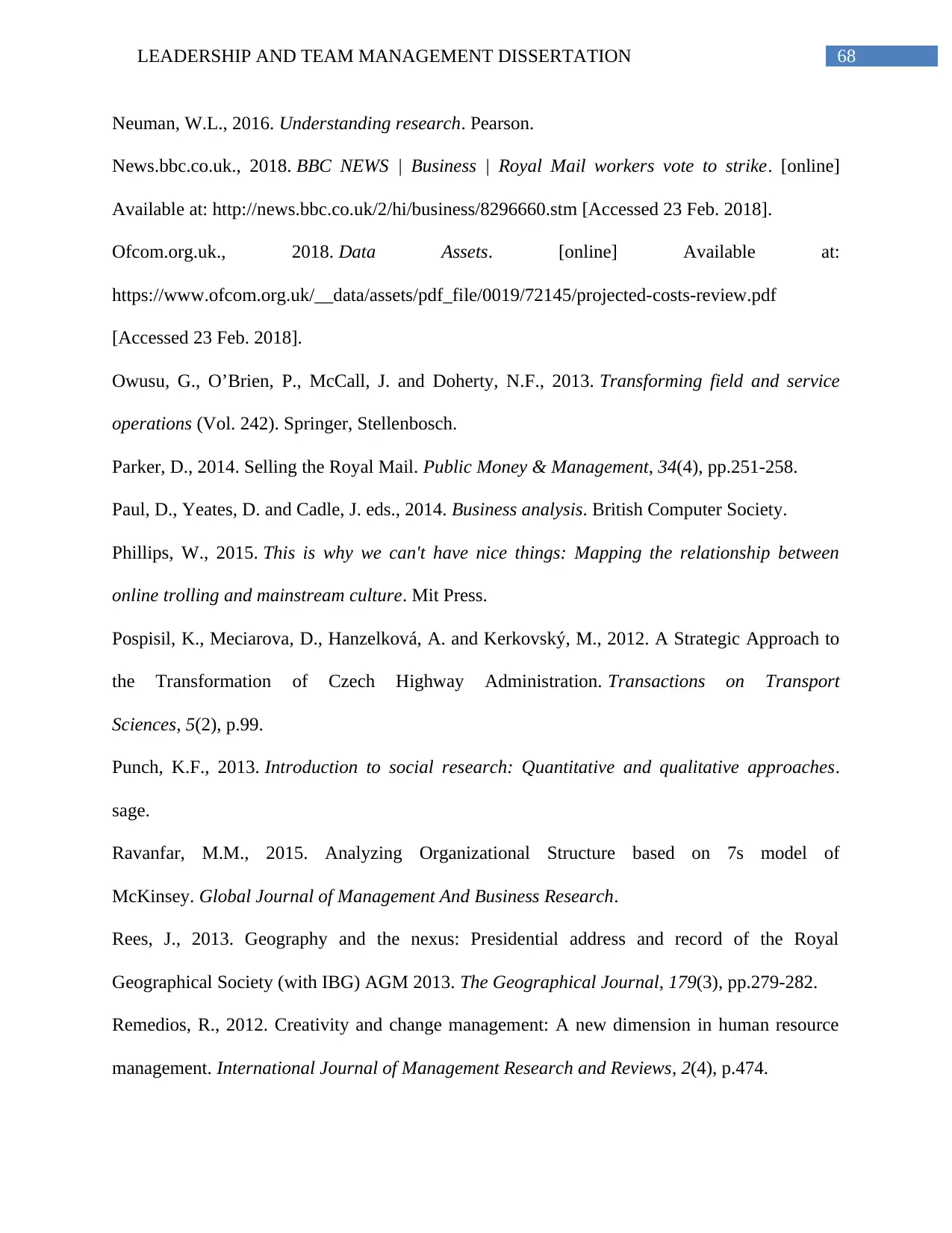
68LEADERSHIP AND TEAM MANAGEMENT DISSERTATION
Neuman, W.L., 2016. Understanding research. Pearson.
News.bbc.co.uk., 2018. BBC NEWS | Business | Royal Mail workers vote to strike. [online]
Available at: http://news.bbc.co.uk/2/hi/business/8296660.stm [Accessed 23 Feb. 2018].
Ofcom.org.uk., 2018. Data Assets. [online] Available at:
https://www.ofcom.org.uk/__data/assets/pdf_file/0019/72145/projected-costs-review.pdf
[Accessed 23 Feb. 2018].
Owusu, G., O’Brien, P., McCall, J. and Doherty, N.F., 2013. Transforming field and service
operations (Vol. 242). Springer, Stellenbosch.
Parker, D., 2014. Selling the Royal Mail. Public Money & Management, 34(4), pp.251-258.
Paul, D., Yeates, D. and Cadle, J. eds., 2014. Business analysis. British Computer Society.
Phillips, W., 2015. This is why we can't have nice things: Mapping the relationship between
online trolling and mainstream culture. Mit Press.
Pospisil, K., Meciarova, D., Hanzelková, A. and Kerkovský, M., 2012. A Strategic Approach to
the Transformation of Czech Highway Administration. Transactions on Transport
Sciences, 5(2), p.99.
Punch, K.F., 2013. Introduction to social research: Quantitative and qualitative approaches.
sage.
Ravanfar, M.M., 2015. Analyzing Organizational Structure based on 7s model of
McKinsey. Global Journal of Management And Business Research.
Rees, J., 2013. Geography and the nexus: Presidential address and record of the Royal
Geographical Society (with IBG) AGM 2013. The Geographical Journal, 179(3), pp.279-282.
Remedios, R., 2012. Creativity and change management: A new dimension in human resource
management. International Journal of Management Research and Reviews, 2(4), p.474.
Neuman, W.L., 2016. Understanding research. Pearson.
News.bbc.co.uk., 2018. BBC NEWS | Business | Royal Mail workers vote to strike. [online]
Available at: http://news.bbc.co.uk/2/hi/business/8296660.stm [Accessed 23 Feb. 2018].
Ofcom.org.uk., 2018. Data Assets. [online] Available at:
https://www.ofcom.org.uk/__data/assets/pdf_file/0019/72145/projected-costs-review.pdf
[Accessed 23 Feb. 2018].
Owusu, G., O’Brien, P., McCall, J. and Doherty, N.F., 2013. Transforming field and service
operations (Vol. 242). Springer, Stellenbosch.
Parker, D., 2014. Selling the Royal Mail. Public Money & Management, 34(4), pp.251-258.
Paul, D., Yeates, D. and Cadle, J. eds., 2014. Business analysis. British Computer Society.
Phillips, W., 2015. This is why we can't have nice things: Mapping the relationship between
online trolling and mainstream culture. Mit Press.
Pospisil, K., Meciarova, D., Hanzelková, A. and Kerkovský, M., 2012. A Strategic Approach to
the Transformation of Czech Highway Administration. Transactions on Transport
Sciences, 5(2), p.99.
Punch, K.F., 2013. Introduction to social research: Quantitative and qualitative approaches.
sage.
Ravanfar, M.M., 2015. Analyzing Organizational Structure based on 7s model of
McKinsey. Global Journal of Management And Business Research.
Rees, J., 2013. Geography and the nexus: Presidential address and record of the Royal
Geographical Society (with IBG) AGM 2013. The Geographical Journal, 179(3), pp.279-282.
Remedios, R., 2012. Creativity and change management: A new dimension in human resource
management. International Journal of Management Research and Reviews, 2(4), p.474.
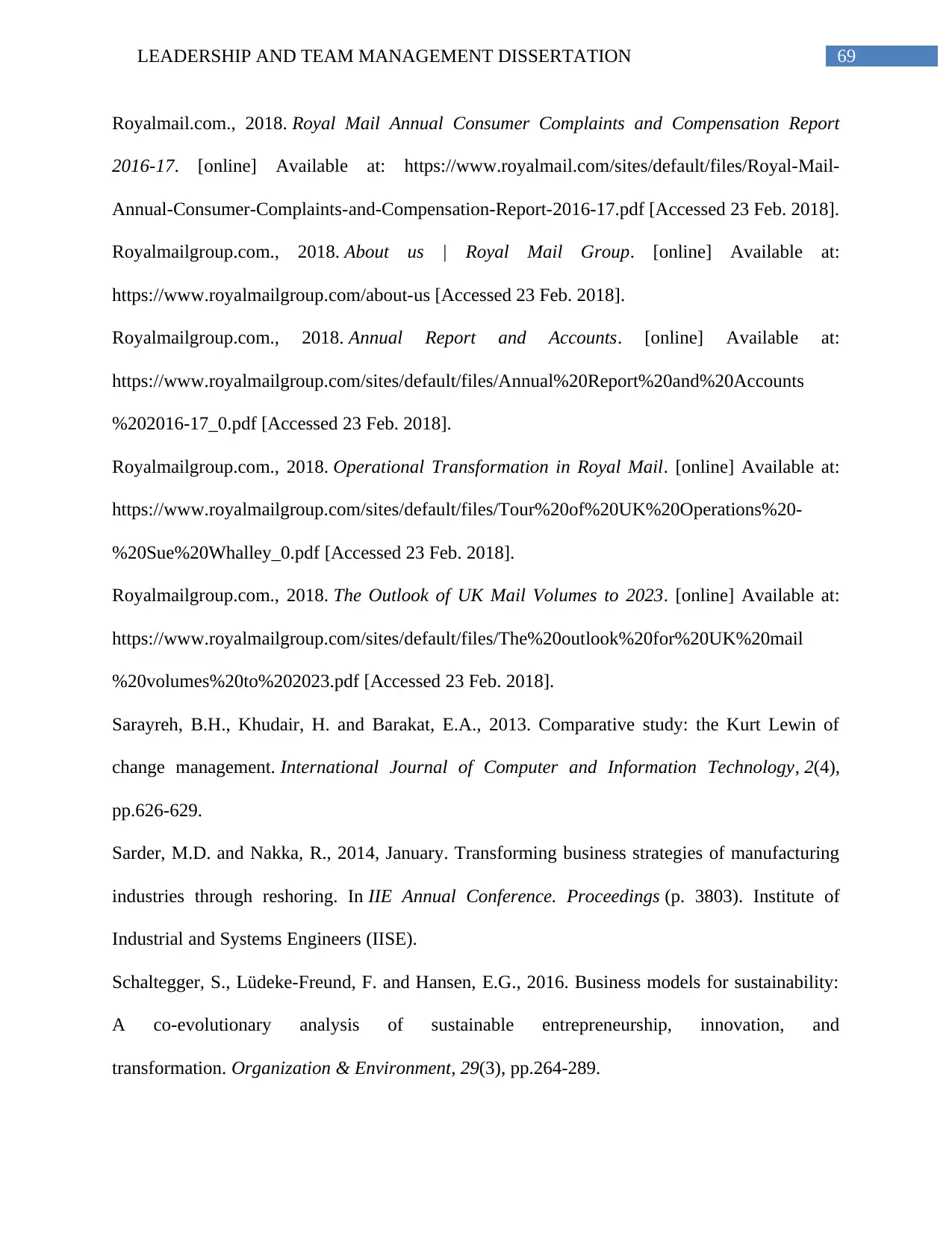
69LEADERSHIP AND TEAM MANAGEMENT DISSERTATION
Royalmail.com., 2018. Royal Mail Annual Consumer Complaints and Compensation Report
2016-17. [online] Available at: https://www.royalmail.com/sites/default/files/Royal-Mail-
Annual-Consumer-Complaints-and-Compensation-Report-2016-17.pdf [Accessed 23 Feb. 2018].
Royalmailgroup.com., 2018. About us | Royal Mail Group. [online] Available at:
https://www.royalmailgroup.com/about-us [Accessed 23 Feb. 2018].
Royalmailgroup.com., 2018. Annual Report and Accounts. [online] Available at:
https://www.royalmailgroup.com/sites/default/files/Annual%20Report%20and%20Accounts
%202016-17_0.pdf [Accessed 23 Feb. 2018].
Royalmailgroup.com., 2018. Operational Transformation in Royal Mail. [online] Available at:
https://www.royalmailgroup.com/sites/default/files/Tour%20of%20UK%20Operations%20-
%20Sue%20Whalley_0.pdf [Accessed 23 Feb. 2018].
Royalmailgroup.com., 2018. The Outlook of UK Mail Volumes to 2023. [online] Available at:
https://www.royalmailgroup.com/sites/default/files/The%20outlook%20for%20UK%20mail
%20volumes%20to%202023.pdf [Accessed 23 Feb. 2018].
Sarayreh, B.H., Khudair, H. and Barakat, E.A., 2013. Comparative study: the Kurt Lewin of
change management. International Journal of Computer and Information Technology, 2(4),
pp.626-629.
Sarder, M.D. and Nakka, R., 2014, January. Transforming business strategies of manufacturing
industries through reshoring. In IIE Annual Conference. Proceedings (p. 3803). Institute of
Industrial and Systems Engineers (IISE).
Schaltegger, S., Lüdeke-Freund, F. and Hansen, E.G., 2016. Business models for sustainability:
A co-evolutionary analysis of sustainable entrepreneurship, innovation, and
transformation. Organization & Environment, 29(3), pp.264-289.
Royalmail.com., 2018. Royal Mail Annual Consumer Complaints and Compensation Report
2016-17. [online] Available at: https://www.royalmail.com/sites/default/files/Royal-Mail-
Annual-Consumer-Complaints-and-Compensation-Report-2016-17.pdf [Accessed 23 Feb. 2018].
Royalmailgroup.com., 2018. About us | Royal Mail Group. [online] Available at:
https://www.royalmailgroup.com/about-us [Accessed 23 Feb. 2018].
Royalmailgroup.com., 2018. Annual Report and Accounts. [online] Available at:
https://www.royalmailgroup.com/sites/default/files/Annual%20Report%20and%20Accounts
%202016-17_0.pdf [Accessed 23 Feb. 2018].
Royalmailgroup.com., 2018. Operational Transformation in Royal Mail. [online] Available at:
https://www.royalmailgroup.com/sites/default/files/Tour%20of%20UK%20Operations%20-
%20Sue%20Whalley_0.pdf [Accessed 23 Feb. 2018].
Royalmailgroup.com., 2018. The Outlook of UK Mail Volumes to 2023. [online] Available at:
https://www.royalmailgroup.com/sites/default/files/The%20outlook%20for%20UK%20mail
%20volumes%20to%202023.pdf [Accessed 23 Feb. 2018].
Sarayreh, B.H., Khudair, H. and Barakat, E.A., 2013. Comparative study: the Kurt Lewin of
change management. International Journal of Computer and Information Technology, 2(4),
pp.626-629.
Sarder, M.D. and Nakka, R., 2014, January. Transforming business strategies of manufacturing
industries through reshoring. In IIE Annual Conference. Proceedings (p. 3803). Institute of
Industrial and Systems Engineers (IISE).
Schaltegger, S., Lüdeke-Freund, F. and Hansen, E.G., 2016. Business models for sustainability:
A co-evolutionary analysis of sustainable entrepreneurship, innovation, and
transformation. Organization & Environment, 29(3), pp.264-289.
Secure Best Marks with AI Grader
Need help grading? Try our AI Grader for instant feedback on your assignments.
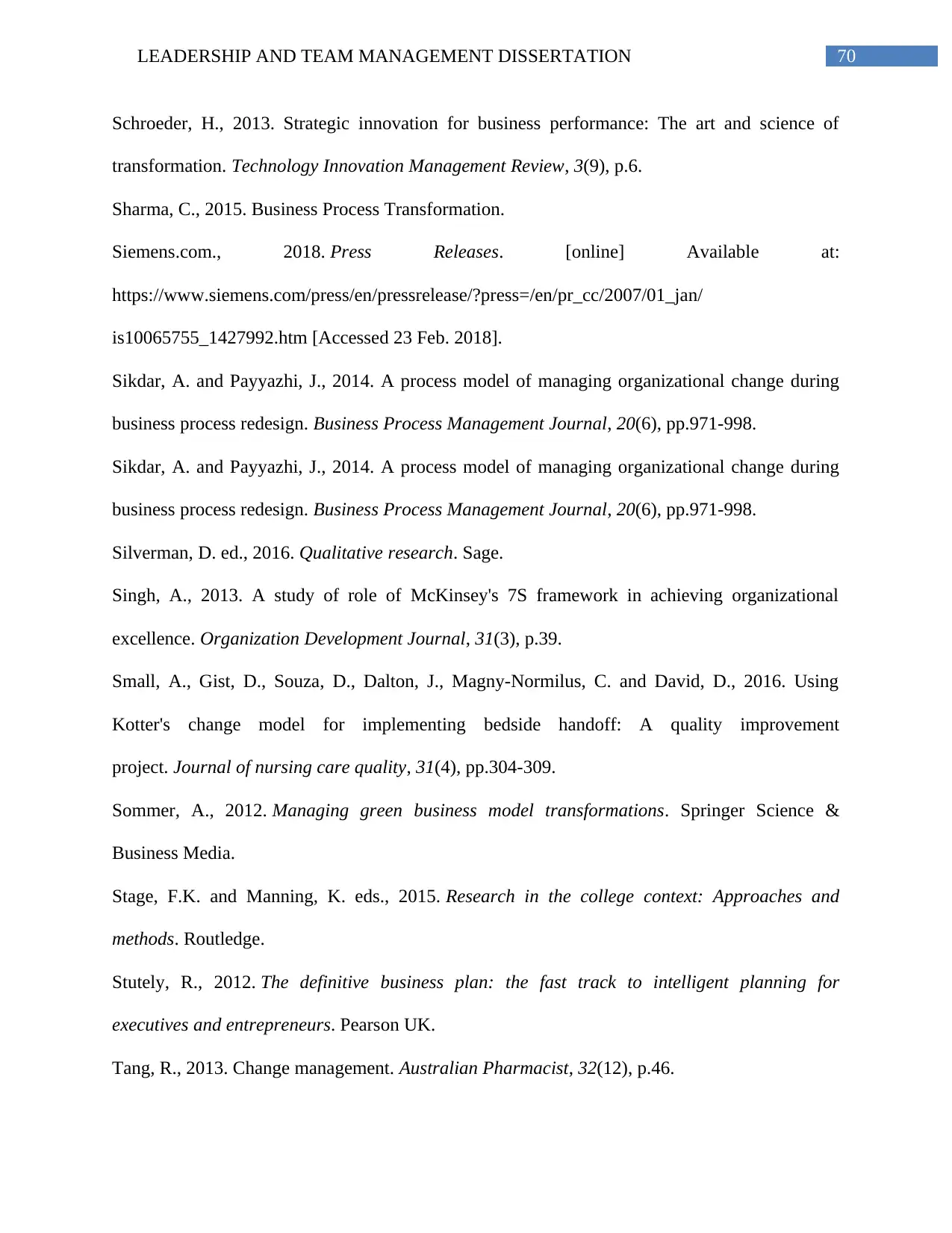
70LEADERSHIP AND TEAM MANAGEMENT DISSERTATION
Schroeder, H., 2013. Strategic innovation for business performance: The art and science of
transformation. Technology Innovation Management Review, 3(9), p.6.
Sharma, C., 2015. Business Process Transformation.
Siemens.com., 2018. Press Releases. [online] Available at:
https://www.siemens.com/press/en/pressrelease/?press=/en/pr_cc/2007/01_jan/
is10065755_1427992.htm [Accessed 23 Feb. 2018].
Sikdar, A. and Payyazhi, J., 2014. A process model of managing organizational change during
business process redesign. Business Process Management Journal, 20(6), pp.971-998.
Sikdar, A. and Payyazhi, J., 2014. A process model of managing organizational change during
business process redesign. Business Process Management Journal, 20(6), pp.971-998.
Silverman, D. ed., 2016. Qualitative research. Sage.
Singh, A., 2013. A study of role of McKinsey's 7S framework in achieving organizational
excellence. Organization Development Journal, 31(3), p.39.
Small, A., Gist, D., Souza, D., Dalton, J., Magny-Normilus, C. and David, D., 2016. Using
Kotter's change model for implementing bedside handoff: A quality improvement
project. Journal of nursing care quality, 31(4), pp.304-309.
Sommer, A., 2012. Managing green business model transformations. Springer Science &
Business Media.
Stage, F.K. and Manning, K. eds., 2015. Research in the college context: Approaches and
methods. Routledge.
Stutely, R., 2012. The definitive business plan: the fast track to intelligent planning for
executives and entrepreneurs. Pearson UK.
Tang, R., 2013. Change management. Australian Pharmacist, 32(12), p.46.
Schroeder, H., 2013. Strategic innovation for business performance: The art and science of
transformation. Technology Innovation Management Review, 3(9), p.6.
Sharma, C., 2015. Business Process Transformation.
Siemens.com., 2018. Press Releases. [online] Available at:
https://www.siemens.com/press/en/pressrelease/?press=/en/pr_cc/2007/01_jan/
is10065755_1427992.htm [Accessed 23 Feb. 2018].
Sikdar, A. and Payyazhi, J., 2014. A process model of managing organizational change during
business process redesign. Business Process Management Journal, 20(6), pp.971-998.
Sikdar, A. and Payyazhi, J., 2014. A process model of managing organizational change during
business process redesign. Business Process Management Journal, 20(6), pp.971-998.
Silverman, D. ed., 2016. Qualitative research. Sage.
Singh, A., 2013. A study of role of McKinsey's 7S framework in achieving organizational
excellence. Organization Development Journal, 31(3), p.39.
Small, A., Gist, D., Souza, D., Dalton, J., Magny-Normilus, C. and David, D., 2016. Using
Kotter's change model for implementing bedside handoff: A quality improvement
project. Journal of nursing care quality, 31(4), pp.304-309.
Sommer, A., 2012. Managing green business model transformations. Springer Science &
Business Media.
Stage, F.K. and Manning, K. eds., 2015. Research in the college context: Approaches and
methods. Routledge.
Stutely, R., 2012. The definitive business plan: the fast track to intelligent planning for
executives and entrepreneurs. Pearson UK.
Tang, R., 2013. Change management. Australian Pharmacist, 32(12), p.46.
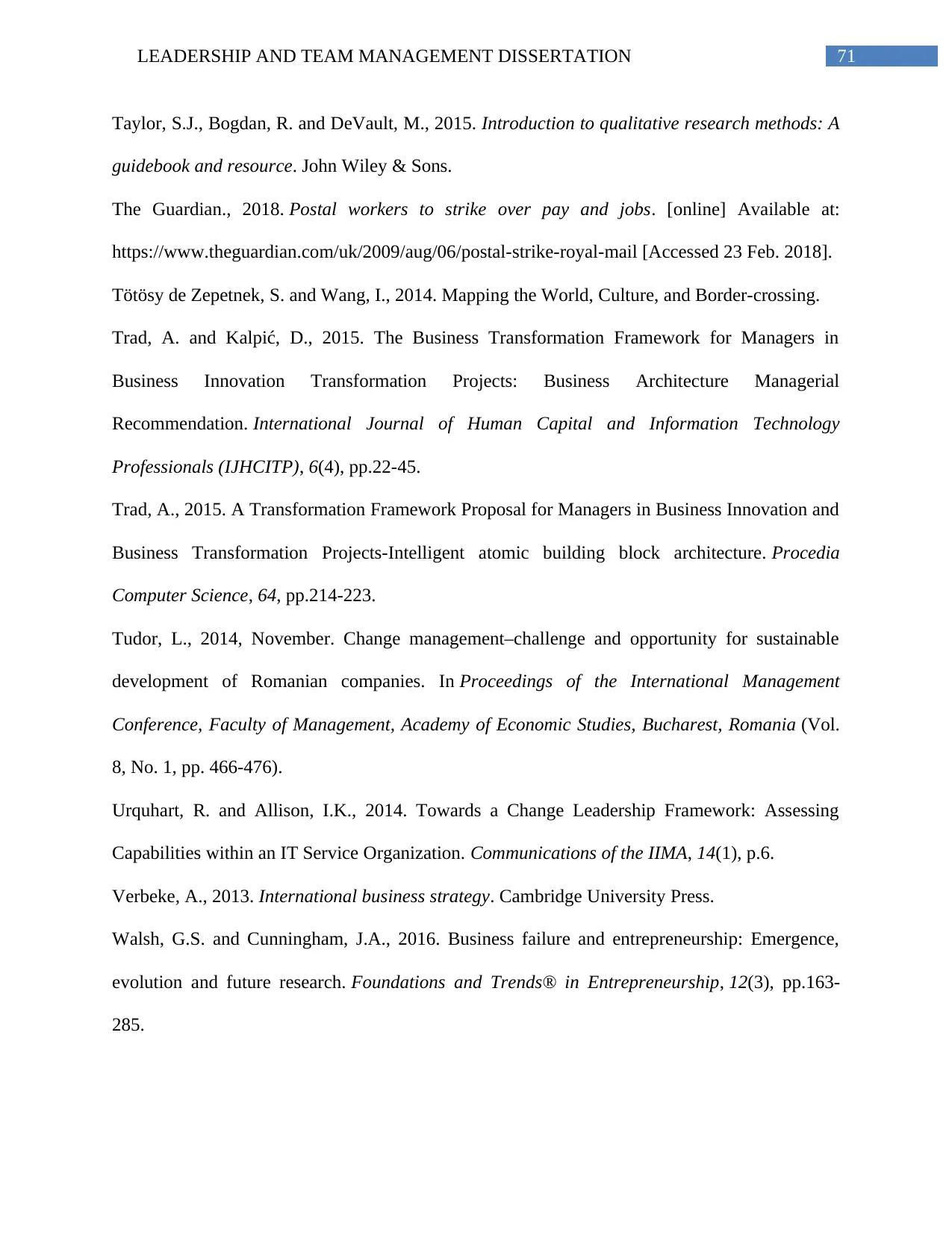
71LEADERSHIP AND TEAM MANAGEMENT DISSERTATION
Taylor, S.J., Bogdan, R. and DeVault, M., 2015. Introduction to qualitative research methods: A
guidebook and resource. John Wiley & Sons.
The Guardian., 2018. Postal workers to strike over pay and jobs. [online] Available at:
https://www.theguardian.com/uk/2009/aug/06/postal-strike-royal-mail [Accessed 23 Feb. 2018].
Tötösy de Zepetnek, S. and Wang, I., 2014. Mapping the World, Culture, and Border-crossing.
Trad, A. and Kalpić, D., 2015. The Business Transformation Framework for Managers in
Business Innovation Transformation Projects: Business Architecture Managerial
Recommendation. International Journal of Human Capital and Information Technology
Professionals (IJHCITP), 6(4), pp.22-45.
Trad, A., 2015. A Transformation Framework Proposal for Managers in Business Innovation and
Business Transformation Projects-Intelligent atomic building block architecture. Procedia
Computer Science, 64, pp.214-223.
Tudor, L., 2014, November. Change management–challenge and opportunity for sustainable
development of Romanian companies. In Proceedings of the International Management
Conference, Faculty of Management, Academy of Economic Studies, Bucharest, Romania (Vol.
8, No. 1, pp. 466-476).
Urquhart, R. and Allison, I.K., 2014. Towards a Change Leadership Framework: Assessing
Capabilities within an IT Service Organization. Communications of the IIMA, 14(1), p.6.
Verbeke, A., 2013. International business strategy. Cambridge University Press.
Walsh, G.S. and Cunningham, J.A., 2016. Business failure and entrepreneurship: Emergence,
evolution and future research. Foundations and Trends® in Entrepreneurship, 12(3), pp.163-
285.
Taylor, S.J., Bogdan, R. and DeVault, M., 2015. Introduction to qualitative research methods: A
guidebook and resource. John Wiley & Sons.
The Guardian., 2018. Postal workers to strike over pay and jobs. [online] Available at:
https://www.theguardian.com/uk/2009/aug/06/postal-strike-royal-mail [Accessed 23 Feb. 2018].
Tötösy de Zepetnek, S. and Wang, I., 2014. Mapping the World, Culture, and Border-crossing.
Trad, A. and Kalpić, D., 2015. The Business Transformation Framework for Managers in
Business Innovation Transformation Projects: Business Architecture Managerial
Recommendation. International Journal of Human Capital and Information Technology
Professionals (IJHCITP), 6(4), pp.22-45.
Trad, A., 2015. A Transformation Framework Proposal for Managers in Business Innovation and
Business Transformation Projects-Intelligent atomic building block architecture. Procedia
Computer Science, 64, pp.214-223.
Tudor, L., 2014, November. Change management–challenge and opportunity for sustainable
development of Romanian companies. In Proceedings of the International Management
Conference, Faculty of Management, Academy of Economic Studies, Bucharest, Romania (Vol.
8, No. 1, pp. 466-476).
Urquhart, R. and Allison, I.K., 2014. Towards a Change Leadership Framework: Assessing
Capabilities within an IT Service Organization. Communications of the IIMA, 14(1), p.6.
Verbeke, A., 2013. International business strategy. Cambridge University Press.
Walsh, G.S. and Cunningham, J.A., 2016. Business failure and entrepreneurship: Emergence,
evolution and future research. Foundations and Trends® in Entrepreneurship, 12(3), pp.163-
285.
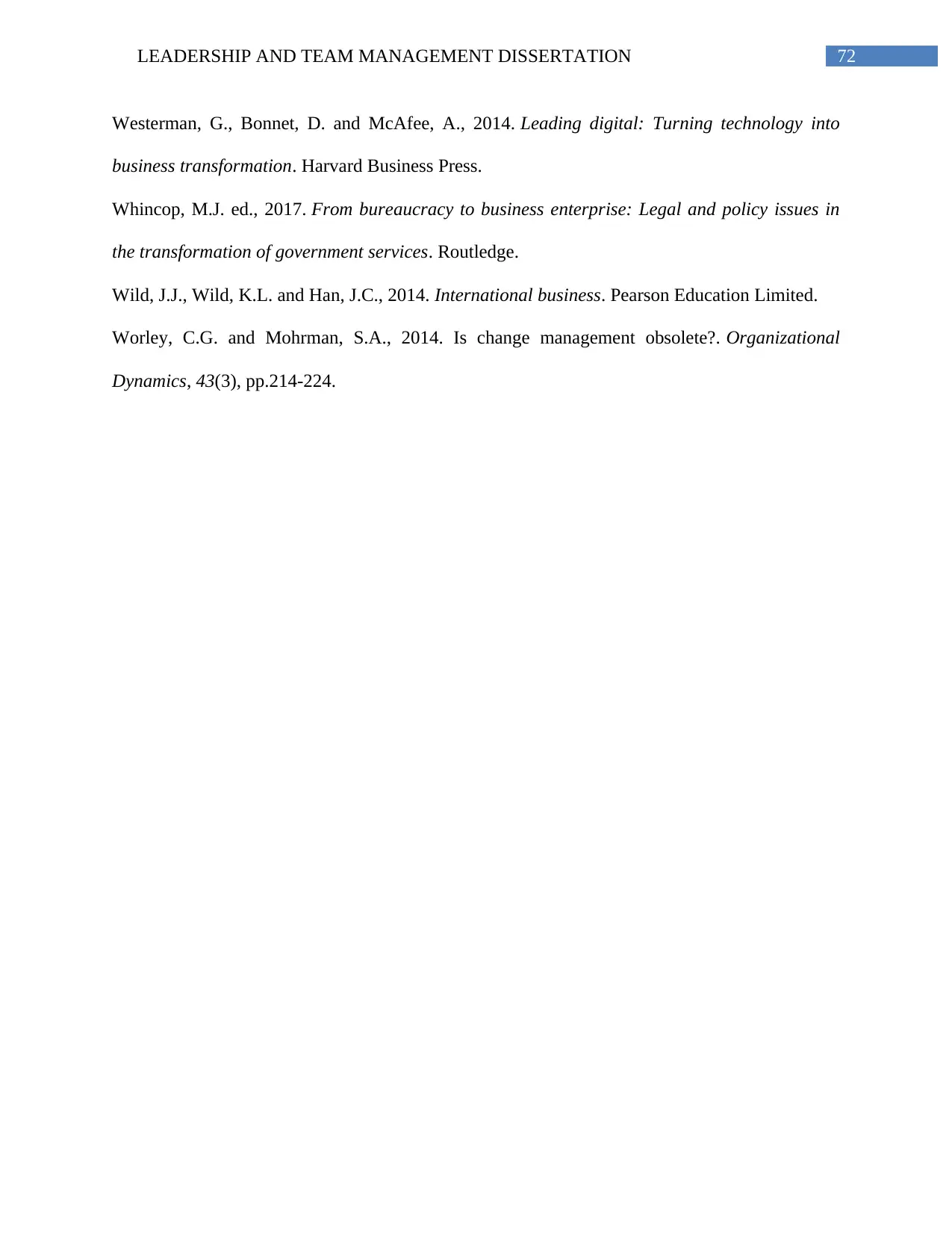
72LEADERSHIP AND TEAM MANAGEMENT DISSERTATION
Westerman, G., Bonnet, D. and McAfee, A., 2014. Leading digital: Turning technology into
business transformation. Harvard Business Press.
Whincop, M.J. ed., 2017. From bureaucracy to business enterprise: Legal and policy issues in
the transformation of government services. Routledge.
Wild, J.J., Wild, K.L. and Han, J.C., 2014. International business. Pearson Education Limited.
Worley, C.G. and Mohrman, S.A., 2014. Is change management obsolete?. Organizational
Dynamics, 43(3), pp.214-224.
Westerman, G., Bonnet, D. and McAfee, A., 2014. Leading digital: Turning technology into
business transformation. Harvard Business Press.
Whincop, M.J. ed., 2017. From bureaucracy to business enterprise: Legal and policy issues in
the transformation of government services. Routledge.
Wild, J.J., Wild, K.L. and Han, J.C., 2014. International business. Pearson Education Limited.
Worley, C.G. and Mohrman, S.A., 2014. Is change management obsolete?. Organizational
Dynamics, 43(3), pp.214-224.
Paraphrase This Document
Need a fresh take? Get an instant paraphrase of this document with our AI Paraphraser
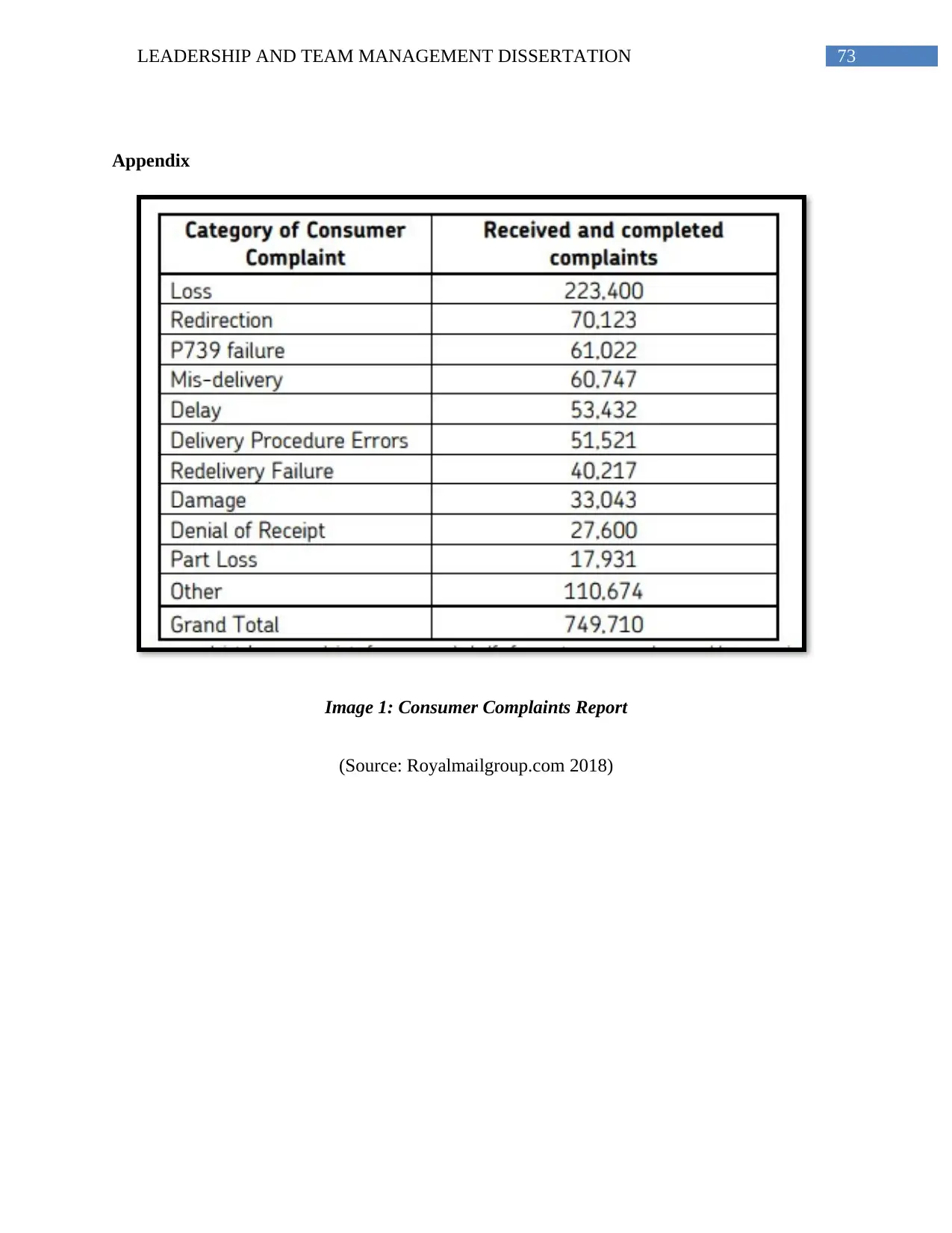
73LEADERSHIP AND TEAM MANAGEMENT DISSERTATION
Appendix
Image 1: Consumer Complaints Report
(Source: Royalmailgroup.com 2018)
Appendix
Image 1: Consumer Complaints Report
(Source: Royalmailgroup.com 2018)
1 out of 74
Related Documents
Your All-in-One AI-Powered Toolkit for Academic Success.
+13062052269
info@desklib.com
Available 24*7 on WhatsApp / Email
![[object Object]](/_next/static/media/star-bottom.7253800d.svg)
Unlock your academic potential
© 2024 | Zucol Services PVT LTD | All rights reserved.





